The Large Aircraft Carrier Midway Myth: is it, fatal?
How Fragile are Aircraft Carriers? Watch how fast the USS Oriskany Sank without fuel or ammo being ignited...
www.youtube.com/watch?v=VUZrUGG29fo
-Vice Admiral Marc A. Mitscher, USN, quoted in Naval Aviation News, October 1945
The statement above by Mitscher is the ultimate arrogant, dishonest, lying aircraft carrier bullshit.
Professor Roger Thompson in his revealing book, Lessons not Learned notes what our former enemy thinks about this aircraft carrier crap:
"If there was any doubt about Soviet intentions...one had only to read the speeches of the Soviet naval commander, Admiral Sergei Gorshkov, who had boasted that the United States had made a strategic miscalculation in relying on large and increasingly vulnerable aircraft carriers to project power in the world. The U.S. strategy would fail in wartime, Gorshkov alleged, because 'the combat potential...of nuclear-powered aircraft carriers is inferior to the strike potentials of submarine and air forces"
--Patrick Tyler
The FACTS are that during the Second World War, United States Submarines operating in the Pacific sank 50% of the Japanese ships:
201 x Japanese warships totaling 540,192 tons
1 x battleship
4 x large carriers
4 x small carriers
3 x heavy cruisers
8 x light cruisers
43 x destroyers
23 x submarines.
Of even greater importance to the war's outcome, the submarines sent to the bottom
1,113 x merchant ships
...of more than 500 tons each, for a total tonnage of 4,779,902, only a million tons less than the entire prewar Japanese merchant fleet.
American Submarines sank 55% percent of all Japanese ships lost in the war, more than the U.S. surface navy, its carrier planes, and the Army Air Corps---combined.
The JANNAC study reports:
Total Japanese ships sunk (and tonnage) 2,728 (9,736,068)
sunk by submarines 1,314 (5,320,094)
sunk by surface craft 123 (321,166)
sunk by direct and indirect air attack 1,232 (3,816,653)
sunk by combined air-sea/other attack 46 (249,727)
sunk by mines laid by ships or subs 7 (22,353)
sunk by shore batteries 2 (2,770)
sunk by unknown causes 4 (3,305)
What is not so readily apparent, but which can be extracted from the data in the JANAC study, is the following: By JANAC's figures, while submarines were responsible for sinking 48% (1,314) of the total ships lost by Japan, aircraft were responsible for sinking by direct attack or with mines 45% (1,232). Further, in concert with other attackers, they sank an additional 2% (46 ships). Therefore, air power forces, directly, indirectly, or partnered with other attackers, was responsible for sinking 47% of Japan's maritime losses, a tonnage value of 4,066,380 tons.
JANAC indicates that of the 1,232 ships (3,816,653 tons) sunk by air attack:
--259 (21%) (587,302 tons) were sunk by aerial mines;
--973 (79%) (3,229,351 tons) were sunk by direct USAAF, USN, or USMC attack;
Of this total:
--688 (56%) (1,592,482 tons) were sunk by land-based aviation forces in direct attack or by air-dropped mines.
--520 (42%) (2,101,477 tons) were sunk by carrier-based aircraft.
Therefore of the other roughly 50% of ships sunk by aircraft, 25% of them were sunk by the U.S. Army Air Force, leaving only 25% due to USN carrier planes. Mitscher is a liar. And what that means is that for the cost of 102 x aircraft carriers they sank only 1/4 of the Japanese ships; this result was ONLY POSSIBLE BY HAVING LOTS OF SMALL AIRCRAFT CARRIERS ALL OVER THE PLACE SO THEIR SHORT-RANGE PLANES COULD FIND AND REACH SHIP TARGETS. Long-range USAAC/AAF planes at far less costs achieved the same results from land bases as their "aircraft carriers". The most efficient and effective ship killer were our small long-range submarines that could remain on patrol for weeks on end to find and kill with Line-Of-Sight HE torpedo attacks surface ships which are in their own medium, the sea. For the modern USN to foist this large aircraft carrier lie began by Mitscher is a dangerous mis-direction of our nation's funds. Big aircraft carriers = Big budgets and the smaller, complimenting systems get squeezed out in a Navy and marines run by greed and ego. Form is killing FUNCTION. If we are to effectively use the CONCEPT of a ship carrying short-ranged airplanes, WE NEED LOTS OF SHIPS CARRYING AIRPLANES not just a dozen large carriers, however ego and budget gratifying.
The American fleet submarine may be TRUTHFULLY called the most successful naval weapon of World War II. However, aircraft carriers got all the publicity by the USN propaganda machine since there's far more money and prestige from Congress and plain fun sailing the seas and coming in to exotic ports from large aircraft carriers as a chest-beating "Samarai" than slinking around like a "Ninja" in a covert submarine. Who gets more chicks, muscular Tom Cruise (Top Gun) or dumpy Tom Clancy (The Hunt for Red October)? What's a bigger ego biscuit, commanding 5, 000 men on a carrier playing "Captain Kirk" or being "Sean Connery" commanding 300 men arm pit-to-arm pit in a submarine? Regardless of form being worshipped over function, it was the submarine fleet that destroyed most of the Japanese merchant cargo ship fleet, isolating the home islands, crippling Japanese industry, and preventing resupply and reinforcement of Japanese island garrisons so our ground forces could evict them with air/land/sea maneuver.
From America's entry into World War II after the Japanese surprise attack on Pearl Harbor on 7 December 1941, until the Japanese surrender was signed on 2 September 1945, American submarines were responsible for sinking more than half (55%) of all Japanese ships. This, despite the fact that the submarine forces comprised less than 2% of the Navy, and spent the first 18 months of the war battling the cheap-skate Navy bureaucracy over defective torpedoes while Japanese Long Lance torpedoes out-ranged ours by a factor of 3 and packed a HE warhead wallop that when it struck, killed our pre-Washington Treaty weight limit ships.
Therefore, what Mitscher said is not only a monstrous and grotesque self-serving lie for the large aircraft carrier "mafia" its a slap-in-the-face against all those thousands of men who died doing vital tasks unrelated to large carriers that actually won us our victory. It displays the large aircraft carrier hubris of the Navy that exists to the present day and threatens us with a naval disaster that could topple us as a nation from being a super power to a has-been. As you will see, this large aircraft carrier "assassination" could come at the hands of a SUB-NATIONAL "terrist" group not just a rival nation-state navy. If the U.S. Navy and dumb marines keep focusing on GWOT land attack badly done and continue to live in a la-la land of denial that their sea-based platforms are at alarming and fatal risks, a strategic defeat at sea will be inevitable; if we want to emulate the Persian fleet at Salamis we are right on track.
The Myth of Midway Being the Turning Point of WW2 and the Large aircraft Carrier Ego Trip
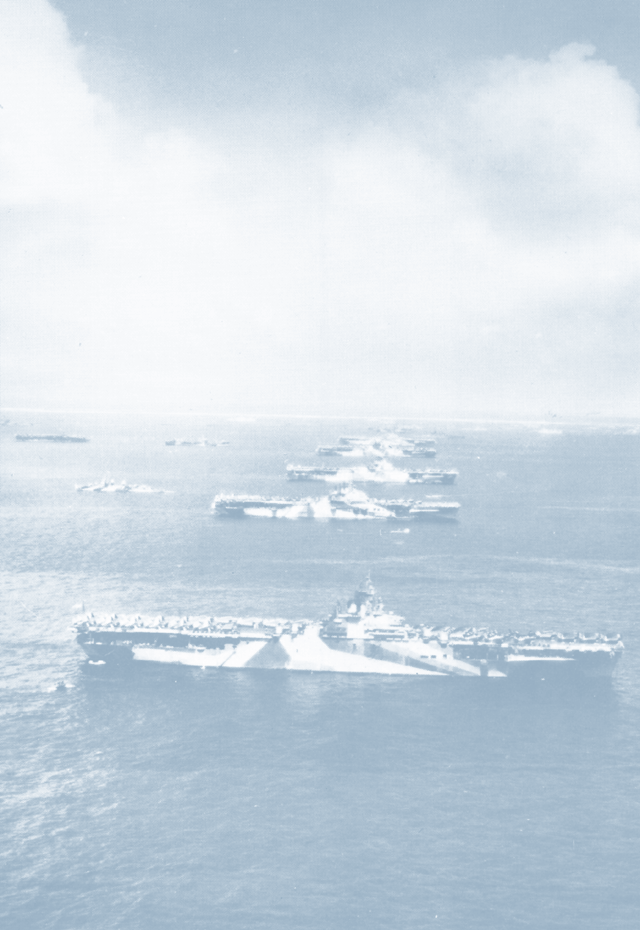
The U.S. Navy mythology goes that the Japanese attacked Pearl Harbor and sank all our capital battleships, leaving us with just large aircraft carriers, cruisers, destroyers, submarines, PT boats, blimps and seaplanes ie; Just about everything there is in a fleet---except battleships with heavy armor and big guns to sink the enemy's battleships and everything lesser. Half a year later, we then met the Japanese fleet at Midway with our fleet still (-) battleships, and our aircraft carriers sank them in a 4-2 exchange ratio. Then from then on it was "all downhill for the Japanese who no longer had the edge in aircraft carriers and couldn't replace them and the needed pilots yadda yadda yadda fucking lying yadda."
Its my recent revelation that this is all a lie.
Its the Germans, Stupid. Who says World War 2 even ended? Germany had the atomic bomb and we over-ran it in the nick-of-time
Here is the shocking, frightening truth about why we fiddled around in the Pacific.
JAPAN WAS NOT MUCH OF A THREAT.
The MORTAL threat to America IS (notice we did not say "was") GERMANY and fascism. Japan was baited to attack at Pearl Harbor so FDR could get Americans who DID NOT WANT TO FIGHT GERMANY would indeed fight our real mortal foe.
The shocking truth is that Germany DID create and use atomic bombs and WE OVER-RAN THEM WITH GROUND MANEUVER NOT ONE SECOND TOO SOON. Not one second. The margin between them nuking New York city with long-range bombers was only a matter of DAYS. When Germany set off its first nuke in a test the German officers against Hitler set off a bomb trying to kill him in desperation, which slowed him down. We are talking critical days here. General Eisenhower said 6 months. 6 months of delay reaching Berlin and we'd all be speaking German now.
German JU-390 long-range 6-engined heavy bomber and a blast map of New York showing the expected devastation
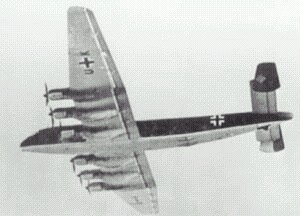
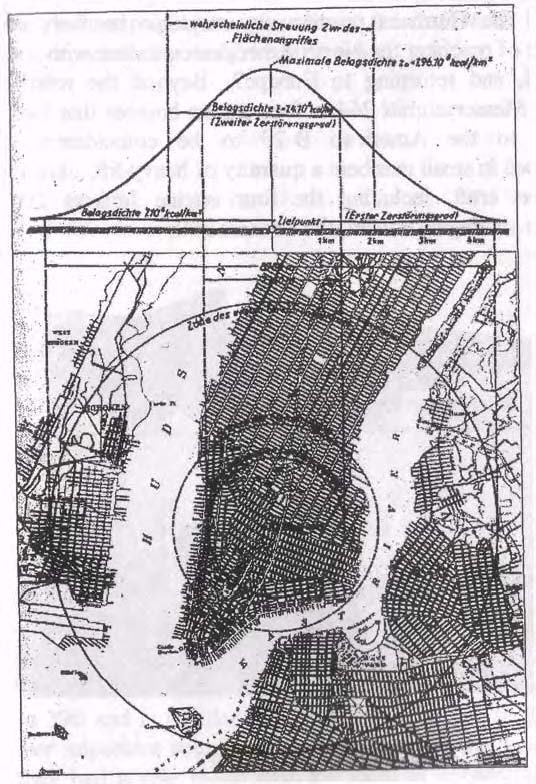
We also forever change our opinion on strategic bombing in WW2 over Germany. The strategic bombing wasn't about making the German people give up to win the war for the glory of air power egotists IT WAS ABOUT STALLING AND INTERFERING WITH THE GERMAN "WONDER" WEAPONS PROGRAMS when EVERY SECOND COUNTED. The final solution is GROUND MANEUVER that destroys the labs and kills or captures the scientists making these weapons of mass destruction (WMD).
Its all covered in Joseph Farrell's important book, "Reich of the Black Sun" below:
So basically the "Midway Myth" large aircraft carrier worship is grotesque. The Pacific theater was a side show. When you study the actual weapons the Germans had and nearly had you, will realize FDR's "Germany First" strategic policy was not just justified IT WAS NOT EVEN ENOUGH. Japan was not the only people who have been nuked, and not just in WW2. U.S. Naval Aviation News of July 1950 even admits that if the German U-boats had snorkels sooner, we probably couldn't have projected a land army onto France to march on Berlin from the west to end the war. In fact, we got a lucky break in that the German U-Boats were NOT much advanced over WW1 types when WW2 began, making it possible for them to be detected and defeated since they needed to surface to recharge their batteries and were actually slow in the water as the BBC documentary below reveals:

German Type XXI U-Boat: world's first actual submarine
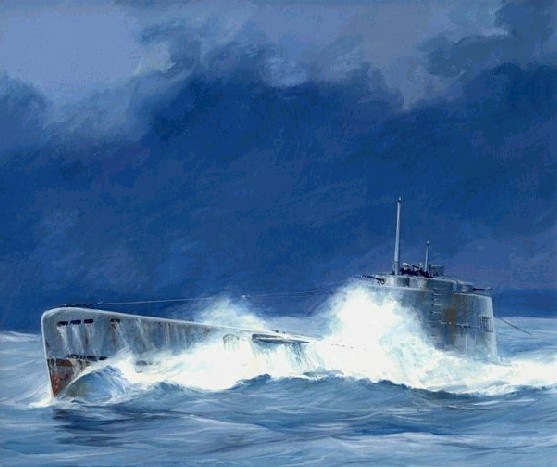
Type XXI XXI U-boats, also known as "Elektroboote", were the first submarines designed to operate entirely submerged, rather than as surface ships that could submerge as a temporary means to escape detection or launch an attack.
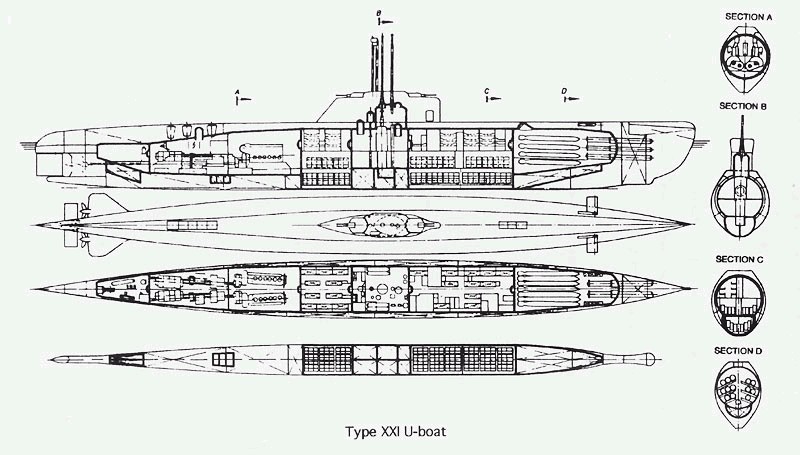
Type XXI submarine diagramThe Type XXIs had much better facilities than previous classes, with a freezer for foodstuffs and minor conveniences for the 57-man crew such as a shower and wash basin. It was much quieter, and enjoyed a hydraulic torpedo reload system that allowed all of its six torpedo tubes, which were in the bow, to be reloaded faster than a Type VIIC could reload a single tube. The Type XXI could fire 18 torpedoes in under 20 minutes. The total warload was 23 torpedoes, or 17 torpedoes and 12 sea mines. Greatly increased battery capacity, roughly three times that of a Type VIIC, gave these boats enormous underwater range. They could travel submerged at about five knots (9 km/h) for two or three days before recharging the batteries, which took less than five hours on the radar-invisible snorkel.
Because of its streamlined hull design, the Type XXI could travel faster underwater than on the surface, albeit only for a limited amount of time. This, combined with longer dive times at reduced speeds, made them much harder to chase and destroy by ASW surface ships. It also gave the boat a 'sprint ability' when positioning the boat for a line-of-sight torpedo attack. Older boats had to surface in order to sprint into position. This often gave the boat away, especially after aircraft became available for convoy escort.
Between 1943 and 1945, 118 boats of this type were built by Blohm & Voss of Hamburg, AG Weser of Bremen, and F. Schichau of Danzig. The boats were built faster than earlier types as the hull was constructed from 8 pre-prepared sections which were assembled after being transported from the various factories they were made in. However, Allied mythology says only one, U-2511, had begun a combat patrol by the end of World War II. This was in part a result of the lengthened training process, as the crews had to be trained to operate the new, sophisticated technology. Most boats were scrapped or scuttled after the war, but eight were taken by the Allies for evaluation and trials. The United States received U-2513 and U-3008, which were commissioned into the United States Navy. U-3017 was commissioned into the Royal Navy as HMS-N41, and U-2518 became French submarine Roland Morillot. U-3515, U-2529, U-3035, and U-3041 were commissioned into the Soviet Navy as B-27, B-28, B-29, and B-30 respectively. Those boats influenced new Soviet submarine classes known by the NATO reporting names Zulu and Whiskey, although the Whiskey class was smaller and less sophisticated.
A ninth XXI also saw service after the war: U-2540, which had been scuttled at the end of the war, was raised in 1957 to become the research vessel Wilhelm Bauer of the Bundesmarine. It is the only XXI remaining.
Specifications
Displacement: 1621 tons/1819 tons, 2100 tons fully loaded
Length: 76.7 meters overall, pressure hull 60.5 meters
Beam: 5.3 meters pressure hull, 8 meters overall
Draft: 6.3 meters
Height: 11.3 meters
Propulsion: 4000 hp (3 MW) surfaced = 15.6 knots (29 km/h), 4400 hp (3.3 MW)
submerged = 17.2 knots (32 km/h)
Range: 25,000 kilometers (15,500 miles) at 10 knots (19 km/h) surfaced, 550 km (340 miles) at 5 knots (9 km/h) submerged
Crew: 57List of Type XXI Submarines
Romeo class submarine: The Soviet Project 633 submarine class derives from the Type XXI boats.
See also Groundbreaking submarines
Drebbel's submarine (1620)
David Bushnell's Turtle (1775)
Plongeur (1863)
Ictineu II (1864)
USS Holland (1897)
Type XXI Elektroboote (1943)
USS Albacore (1953)
USS Nautilus (SSN-571) (1954)
Zulu-class SSB (1955)
USS Narwhal (1967)
Alfa-class SSN (1977)
German Type 212 AIP powered submarine (1998)
As the estimated 250, 000 Germans fled the Allied/Soviet ground maneuver forces closing in, a fleet of Type XXI Air Independant Propulsion (AIP) capable submarines broke out through the Greenland-Iceland-UK (GIUK) gap and annihilated even the U-Boat defeating naval ASW convoy trying to block them. Only 1 man survived this battle, an ASW destroyer Captain and he said he never wanted to ever have to face such deadly submarines ever again. Essentially in WW2 we were using and fighting against SUBMERSIBLE TORPEDO BOATS with limited ability and speed to fight underwater and not actual submarines like we have today. The only reason why we were able to win against the German U-Boats in the Atlantic was because they had to surface or use a snorkel to get air to run diesel engines to recharge their batteries and attain 20 mph speeds. When they did this we could spot them from the air using seaplanes and other ASW aircraft from shore and small escort aircraft carriers. We have never fought an entire war against AIP nuclear or exotic D-E and other drive submarines who can stay submerged and are as fast if not faster than surface ships. It will be a blood bath just like the Type XXI U-Boat break-out battle.
After the 1946-7 Operation HIGH JUMP expedition by Admiral Byrd was fended off by the "4th Reich" Nazis, something drastic had to be done. We went nuclear. In 1958 we, the Russians and British nuked Nazi Germans in their secret bases in Antarctica. Thus,
WORLD WAR 2 NEVER REALLY ENDED.
Notice the allied navies took capture German type XXI U-boats and renamed them as their own but didn't advertise this fact that they needed ideas from the former or actual enemies. Furthermore, the facts will also show the "turning point" in WW2 in the marginally important Pacific War was actually Pearl Harbor when America got off her ass and starting attacking the Japanese with her air-dependant submarines. The next "turning point" was when we and the Australians stopped the Japanese land conquest in NEW GUINEA with land-based ground troops and aircraft. The "Midway Myth" is a pile of lying self-serving Navy aircraft carrier and marine egomaniac bullshit. Don't buy into it.
First, if we were so "desperate" for aircraft carriers and battleships after Pearl Harbor, why did we send the aircraft carrier USS Wasp and battleship Washington with 2 cruisers and 8 destroyers to the Atlantic? If we were so hurting for aircraft carriers, why was the USS Ranger that already was in action in the Atlantic not sent back to the Pacific?
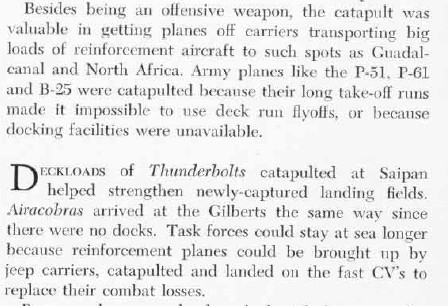
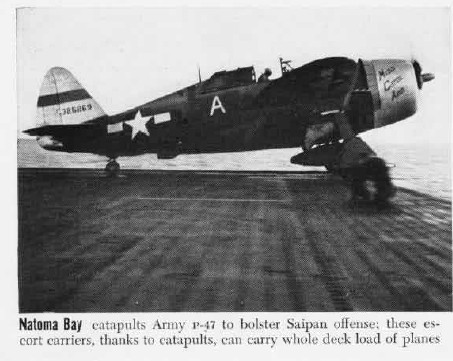
The Ranger was busy launching U.S. ARMY P-38s, P-40s and P-47s off her decks. Oh, we forgot! Army planes can't operate from NAVY carriers only "superior" Navy pilots can do that, you know the ones that take-off and barrel-roll their planes into the ground to "show the Army how its done".
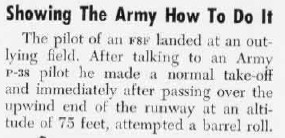
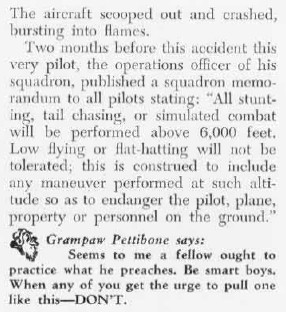
From U.S. Naval Aviation News 1 October 1946
Maybe the REAL REASON why the Ranger was retired was so its HISTORY of operating Army planes in combat could be covered up in the post-war era where such facts would be inconvenient to USN/Mc budget and ego? U.S. Naval Aviation News December 1, 1946 reports on the retirement of the Ranger:
www.history.navy.mil/nan/backissues/1940s/1946/1dec46.pdf
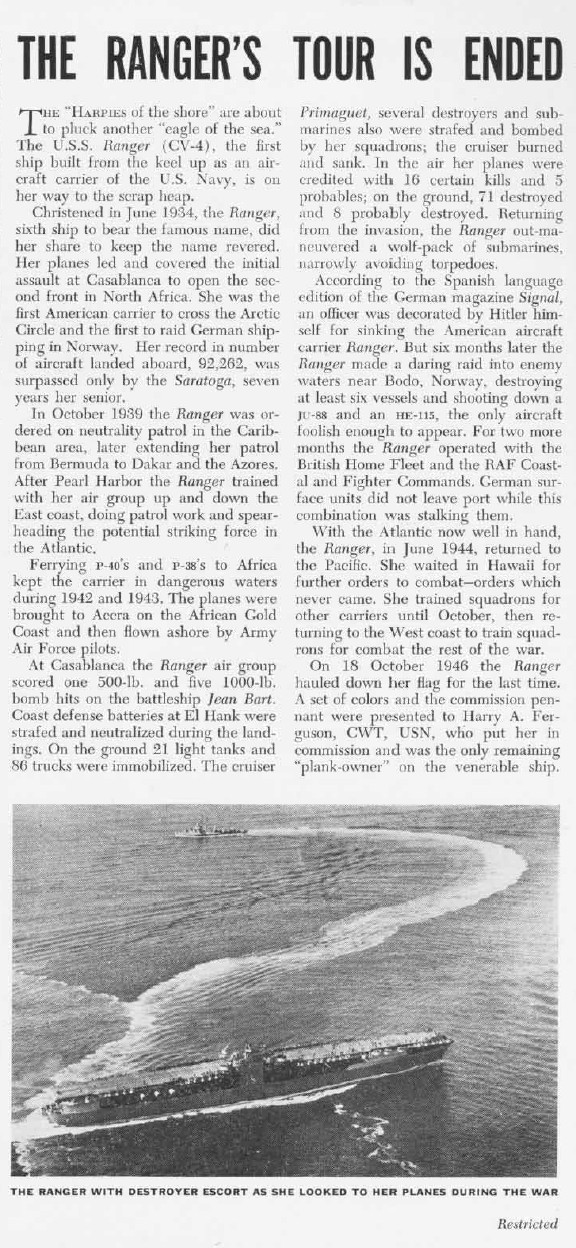
www.ww2pacific.com/42march.html
Mar 26, 1942[<-----notice the date]
Washington (BB-56), Wasp (CV-7), Wichita (CA-45), Tuscaloosa (CA-37), and 8 DD, sail from Portland, Maine to reinforce the British Home Fleet.
A-HEM.
We were NOT "hard up" for aircraft carriers or battleships, EVER in WW2. We built 124 escort carriers for crying out loud. The Navy egomaniacs were "hard up" for RESPECT from the Japanese after we let them ambush us at Pearl Harbor. The Japanese disrespected us so bad after Pearl, their combined fleet SAILED TO THE INDIAN OCEAN to attack the British fleet at Ceylon they were so bored and having nothing to do. We stopped the Japanese ON LAND almost immediately in New Guinea long before there was any "Midway Miracle" in the middle of 1942. And General MacArthur's forces stopped the Japanese WITHOUT ANY AIRCRAFT CARRIERS. U.S. Army troops were on the OFFENSIVE in New Guinea long before the second lie of Guadalcanal being our first offensive action was conjured up.
The best way to expose this Midway large aircraft carrier myth is to lay out events had Midway not occurred and the Japanese kept their 4 large aircraft carriers.
ALL an aircraft carrier is good for, is to launch/recover airplanes.
These airplanes can shoot down other airplanes (AAW).
These airplanes can sink other ships if they can get through these ship's own airplanes and air defenses (AsuW).
These airplanes can bombard land targets but not better than battleships, cruisers and destroyer guns can to sweep off enemies near the shore for ground troops to maneuver, this mission is land attack (LA).
These airplanes can spoil the attacks of submarines and keep them away from the main body of your surface warships and supply ships (ASW) necessary to keep your ground troops functioning.
In summary WW2 aircraft carriers could do the following missions IF they have the aircraft to do them;
AAW = Anti-Air Warfare
AsuW = Anti-Submarine Warfare
LA = Land Attack
ASW = Anti-Submarine Warfare
Former DoD Director of Air Warfare Chuck Myers writes:
"I'd like to try to clarify the primary value of aircraft carriers (long forgotten by my deep-strike oriented Navy/MC and USAF):
(1) establish air superiority (killing enemy pilots in the air) over areas where we are trying to transition from sea-to-land and/or where we have troops in contact with the enemy ground forces
(2) under the cover of our fighters, perform MAS for our grunts. That's primarily it."
So basically, aircraft carriers are TEMPORARY, TRANSITIONAL platforms for temporary AAW and limited LA missions. Their vulnerability does not make them ideal for sinking other enemy fleets...yet that's what the USN was pre-occupied with during WW2 and is now in love with deep-strike strategic bombing (LA). In WW2 we had over 70 small carriers to do ASW and other missions over the VERY LARGE SEAS OF PLANET EARTH, now we have ZERO while still living on THE SAME PLANET EARTH.
Therefore, the actual minimal strategic threat from Japan in 1941 was not from her fleet but from her land troop conquests extending out to cover half the Pacific Ocean meant to gain natural resources to FINISH HER LAND CONQUEST OF CHINA..
From, there more powerful land-based airplanes could be deployed from runways or seaplanes from lagoons to deny commerce from the U.S. to those parts of the world. The Japanese land conquests were primarily done using seaplanes from seaplane tenders, they did not need aircraft carriers to project land power ashore. They had battleships, cruisers and destroyers to bombard beaches just like we had after we repaired our battleships at Pearl Harbor and put them back into service. FYI we had 25 total battleships in WW2, only 2 were lost during the entire war---2....that's 1 and 2. So much for the Peal Harbor wiping-out-our-battleships myth. We gobbled up the Japanese held islands using Army General MacArthur's brilliant bypassing tactics which the arrogant and stubborn Japanese accepted and played right into our hands. We seized the islands we required to interdict Japanese cargo ships by Army ground troop invasions backed by battleship and cruiser fire spport and 5th Air Force aircraft close air support. We were also skilled at rapid land runway construction via matting and pierced steel planking to get superior performing P-38 Lightnings and F-6 Hellcats and F-4U Corsairs on the scene to sweep the skies of the flight performance deficient Japanese planes. Once the Japanese supply lines were interdicted, they should have left their untenable bypassed islands but didn't because of vanity and pride--which we obliged. We let the Japanese stay on the bypassed islands to bleed them as they struggled just to stay alive fighting the battle against the earth (TBATE). As they struggled to just stay fed, we ambushed their cargo ships and planes we knew they needed, running up huge kill score statistics for our mass-produced war machines to have ample targets. The concept of REFUSING BATTLE is just as foreign to today's egotistical U.S. military as it was to the Samarai-mentality Japanese and our own marines of WW2. Not content to bypass, the Navy/Mc constantly gave the Japanese samarai fleshy bodies to kill in needless frontal assaults along a meandering strategic direction taking the long way to the Japanese home islands.
Strategic Mis-Directed Madness: Why Didn't We Attack the Japanese Home Islands DIRECT from Alaska?
As I was watching the history channel's 3D documentary on the Japanese attack on Pearl Harbor they said something about Midway islands "not being that far from Japan" etc.
It lead me to the ultimate question:
WHY DID THE U.S. NAVY AND MARINES DINK AROUND TAKING ISLANDS THOUSANDS OF MILES AWAY FROM JAPAN IN A BLOODBATH OF SELF-VALIDATION (re: Clint Eastwood's latest USMC marine worship flick) WHEN THE JAPANESE HOME ISLANDS FROM ALASKA ARE NOT EVEN THAT FAR AWAY?
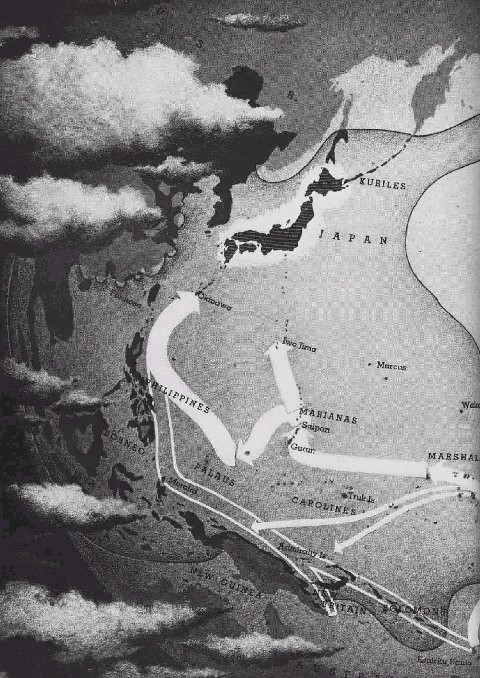
Invade Japan From the North using our island "Land Bridge" and Land-Based Aircraft and Troops
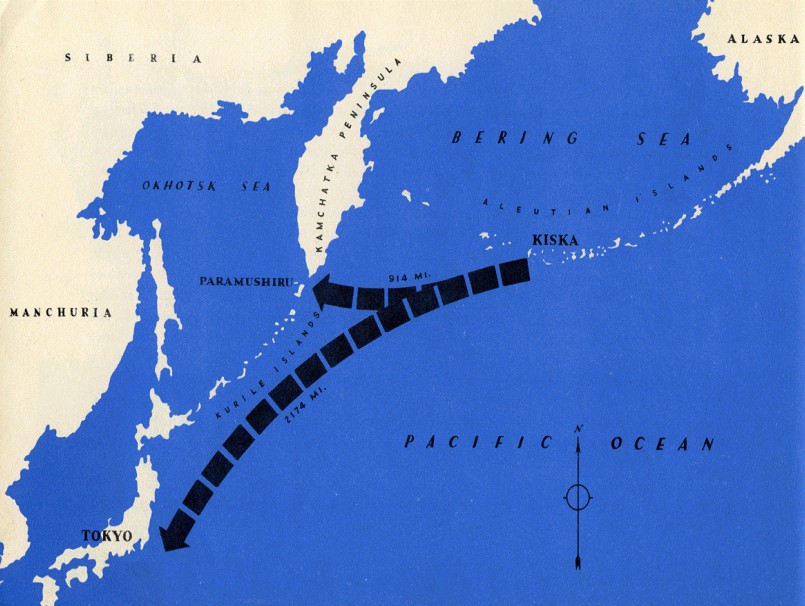
TIME magazine asked this very question at the time in 1942!
www.time.com/time/magazine/printout/0,8816,885895,00.html
What Then?
The U.S. this week faces its bitterest defeat since 1814: the loss of all the southwest Pacific except Australia. And Australia is in peril. If Java falls, if the United Nations lose their last bases within striking distance of the Japanese, what kind of war can the U.S. then wage in the Pacific?
Hit & Run. The Navy and its air service can harass Japanese shipping and outposts by surface, submarine and aircraft-carrier raids, constantly striking and then retiring to the main U.S. base in Pearl Harbor. Such raids cannot win the war. They cannot even protect U.S. shipping routes to the Allied forces in Australia and the Middle East, or supply lines to Russia, India and China.
Attack from the North. Tonguing out from Alaska, 1,150 miles into the north Pacific toward Tokyo, lie the U.S. Aleutian Islands (see map, p. 17). The outermost U.S. base, Dutch Harbor, is 2,550 miles from Tokyo-well beyond effective bomber range. But the Aleutians stretch halfway to Japan's little-known naval base at Paramoshiri in the Kuriles, which means that they could be either targets for Japanese attack or U.S. steppingstones toward Japan. Heavily armed, carefully balanced striking forces might take off from Alaska and the Aleutians, perhaps get the use of Russia's naval base at Petropavlovsk, fight for footholds in the Kuriles, then strike directly at Japan itself. A more immediate possibility for attack in the north is bombing from Vladivostok, only 580 air miles from Tokyo. For that offensive the U.S. must have: 1) Russia's consent; 2) more bombers than have yet been delivered to any front.
Attack from the Center. Given the means and the offensive will, the U.S. can do more than raid from Pearl Harbor. Assault forces of carriers, cruisers, destroyers, submarines and transports with supporting troops can strike to recapture Wake,* then Guam, eventually establish a forward base in Japan's Marianas. Similar forces could fight step by step through Japan's Marshall and Caroline Islands, finishing what the Navy spectacularly began in February with hit-&-run raids.
With this spearpoint in the Marianas and Guam, U.S. forces would still be 1,350 miles from Tokyo, but they would again be in position to threaten Japan's vital supply routes. And the Navy would be in a better position to aim striking forces at Japan. But for all-out attack via the Aleutians and the Marianas, the U.S. must amass more carriers, more shipping, more aircraft. Then it must fight for the bases. All this means that full-scale attacks from the north and center are possibilities for the future. How far in the future depends mainly on how fast the U.S. musters its offensive will and spirit, gets additional aircraft carriers into service, and reconstructs its naval thinking around the assault airplane.
Attack from the South. If Java falls, Australia will thus remain an all-essential base for present operations in the far Pacific. Desolate, vulnerable northern Australia would be hard to defend against determined Japanese attack. But Australia's Prime Minister John Curtin was speaking for as well as to the U.S. last week when he said that southern Australia must be held. There the U.S. can amass land and air forces; there it can base the naval forces necessary for an attempt to recapture the Indies and drive on toward Malaya and Japan from the south.
* Last week Tokyo reported an attack on Wake by a typical task force: two cruisers, an aircraft carrier, six destroyers. The Japanese said they suffered minor damage, minor casualties. Said the Navy Department in Washington: "No information."
www.hlswilliwaw.com/aleutians/Attu/html/battle_for_the_aleutians_format.htm
First thing, it would mean we would have to approach Japan from the Aleution islands in Alaska and take a Kuril island to act as our land-based aircraft "carriers": and start B-17 and B-24 bombing of the Japanese home islands immediately. Might be bad for Boeing B-29 long-range bomber business but that's too damn bad. The FACTS are the can-do WW2 generation DID take the Aleution islands without whatever whining crap anyone says today. They DID build runways. They DID launch bombing raids when the weather cleared.
www.hlswilliwaw.com/aleutians/Attu/ppt/The%20Battle%20of%20the%20Aleutians_3.ppt
AND.......
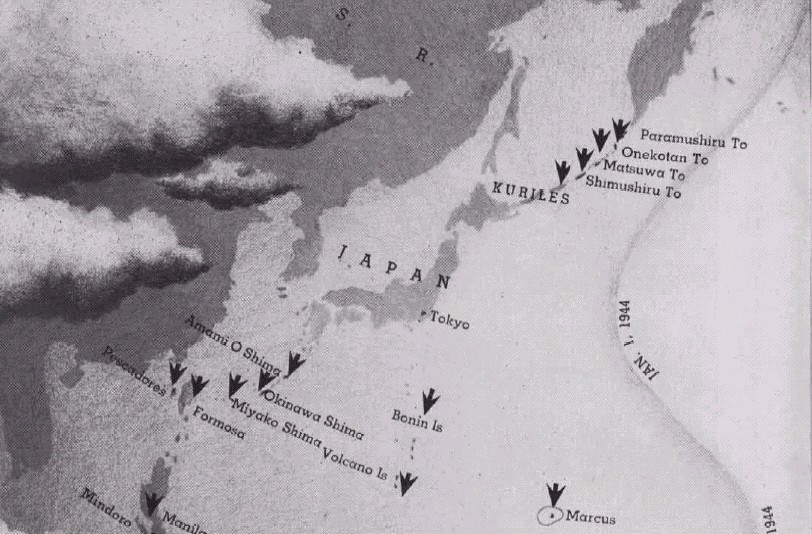
They were raiding the Japs on the island Paramushiru north of the Kurile islands as the presentation from at the time in 1943 shows above.
So the FACTS are we could have placed our emphasis on taking a Kurile island or two and started B-24ing or B-17ing or B-29ing (got to keep Boeing employed) in 1943 or early 1944 without the USMC blood bath in the central pacific.
SIDEBAR: the Russians took the Kuril Islands in 1945 and still hold them today
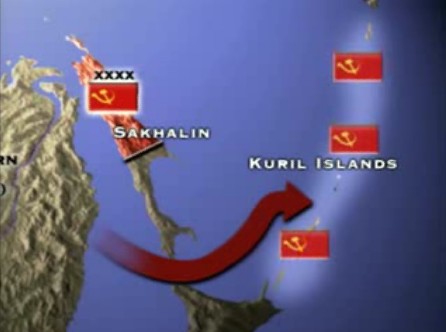
Despite not being "experienced in amphibious warfare" as the marine racketeers always boast to justify their ego club, the Russians in 49 ships land a division and take the Kuril islands in 1945. So there is no excuse why the "amphibious warfare experienced" Americans couldn't have done the same much earlier.
www.youtube.com/watch?v=c7egTzQ8OKs
From Thompson's book on page 80:
"In actuality, the Red Army was responsible for neutralizing approximately 32 percent of Japan's Army, but this fact seldom appears in the typical American discourse on the war. As Admiral Gorshkov suggested, 'victory over Japan demanded a sustained struggle with the enlistment of large land forces, which the allies did not have...that is why the entry of the USSR into the war against Japan was so necessary for the allies, without it, it was not possible to break the determination of the Japanese militarists to continue the war...it is known that in fulfilling their obligations, allies the Soviet army and navy with a powerful blow smashed the Kwangtung army and the Japanese support points on Sahkhalin and the Kurile islands, after which Japan was forced to surrender unconditionally'"
Lessons for Naval Maneuver Air pport (MAS)?
Maritime Patrol planes need to be ARMED to sink whatever it is they find on the spot since with changing weather you may not be able to direct other planes to attack what you find. A burning ship is a great sea marker to find in either case.
Now let's talk about "supply lines". OK?
The continental U.S. is LAND CONNECTED TO ALASKA.
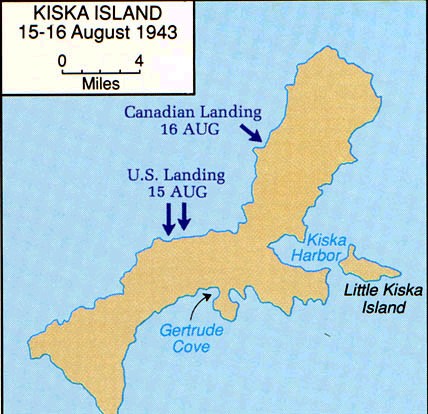
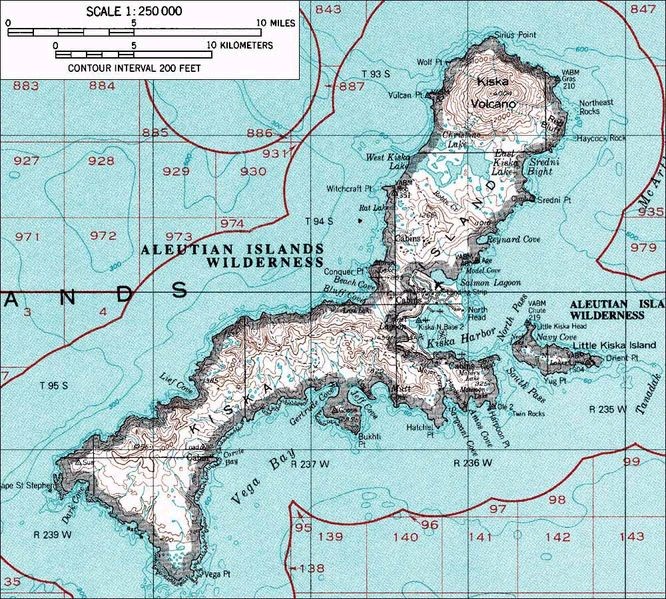
Why didn't we take Kiska/Attu THEN TAKE ONE OF THE KURIL ISLANDS and then have a solid logistics supply line from CONUS to Alaska to Kurile Base (s) air covered by land-based fighters as our "England" and we could have commenced B-17/B-24 strategic firebombing strikes on the wood/paper home dwelling Japanese civilians in 1942-3? Our subs/bombers could have immediately mined ALL the Japanese ports/harbors and helped starve out all the Jap infantry over-extended out there opposing MacArthur. The USAF report towards the end of this web page reveals that air mining of ports and sea lanes is the most effective way to sink cargo ships. We could have been in a position to invade Japan just like we were in Europe against Germany---in 1944. Or just continued to blockade them until the A-Bombs arrived...
Oh the Japanese aircraft carriers! Or our aircraft carriers?
F%^&K AIRCRAFT CARRIERS.
We don't need them to do LAND CONQUEST of Japan--or any place else.
Let the Japanese aircraft carriers come and attack our land-based fighters who have the edge in flight performance and see who is easier to "sink", a few thousand tons of steel held up in the water by Archimedes' trick or A LAND MASS OF PLANET EARTH you can burrow into if you have to?
Land-based "aircraft carrier" beats sea-based aircraft carrier head-on in a duel when the aim is a nation-state's land mass. Once General Kinney's skip-bombing and massed heavy machine gun strafing anti-shipping techniques were put in use by ALL of U.S. land based air forces, the Japanese fleet would be "dead meat" as long-range P-38 fighters provided air cover overhead. If the vaunted U.S. Navy's large aircraft carriers wanted to contribute they could go off into the middle of the sea somewhere and do their feel-good fleet duels and/or they could help protect our supply lines from air and submarine attack with over a 100 supply ship small escort carriers.
What we are saying is this, THE WAR IN THE PACIFIC DID NOT NEED TO BE A "NAVAL WAR" AT ALL! A land-based approach from Alaska direct into the Japanese home islands would have worked far better than the blood bath we had in the central Pacific by the stupid/egotistical Navy/marines.
Its also our conjecture that the REASON why Nimitz & marines emulated MacArthur was because THEY WANTED TO SHOWBOAT. They wanted to showcase their large "fast" aircraft carriers and their marines as rivals to the Army needlessly. They DID NOT WANT what made the most sense, which would have been a land encirclement of Japan from Alaska using land-based aircraft and submarines which would have given their carriers and marines less to do. They didn't want to play "second fiddle". The excuse for the central pacific blood bath to get "bases for B-29s" is a bunch of horseshit when the fact that we could have bombed Japan from the CONUS-Alaska-Kuril land axis of advance. THOUSANDS of men died needlessly for navy/Mc ego. Because we had unemployed marines we sent them in frontally to take air bases thousands of miles away that we did not need.
We built the Ledo road to connect China. We built the ALCAN highway to connect CONUS to Alaska.
We could lay thousands of miles of roads and railroads a lot faster than 4 years of pointless island hopping and ship construction to send thousands of our men to their deaths.
AND IF YOU CAN'T HANDLE THIS TRUTH...
YOU SHIP SAFELY ALONG OUR COASTLINE ALL THE WAY TO ALASKA TO THE KURILS UNDER LAND-BASED FIGHTER COVER.
Ever hear of the inter-costal canal that runs all along our eastern coast?
Its the same effect, running ships hugging our coastline versa sending them out unprotected into the blue ocean.
So what was the establishment's excuse to not use the Alaska-to-Japan axis of land advance and prolong the war for greater profits?
The Weather. Classic Battle against the Earth, its too-hard-for-us-to-do-this crap. Compare the preceding can-do account from 1943 to the post-1945 excuse-mongering account:
www.army.mil/cmh-pg/brochures/aleut/aleut.htm pg2-3
"Protruding in a long, sweeping curve for more than a thousand miles westward from the tip of the Alaskan Peninsula, the Aleutians provided a natural avenue of approach between the two countries. Forbidding weather and desolate terrain, however, made this approach militarily undesirable. While spared the arctic climate of the Alaskan mainland to the north, the Aleutians are constantly swept by cold winds and often engulfed in dense fog. The weather becomes progressively worse in the western part of the chain, but all the islands are marked by craggy mountains and scant vegetation. Despite such inhospitable conditions, neither the United States nor Japan could afford to assume that the other would reject the Aleutians as an impractical invasion route."
Is the terrain made of granite? No. Then we can build runways to fly planes. Is the weather being bad a bad thing? No. It means the enemy can't attack us from the air at those times, either.
We are talking about land to land power projection for the most part to Attu/Kiska. Which by the way, WAS ACCOMPLISHED.
We build up in winter via land transport and short sea and air hops. Which by the way, WAS ACCOMPLISHED.

The big sea leap to take one of the Kurile islands creates the B-17/B-24/B-29 base far more effective than Iwo Jima. Certainly within ranges for P-38 and P-51 fighter escorts. Look on a map or a globe. The weather there isn't a show-stopper. So why was it not done?
No, we think the Navy/Mc "mafia" put the kobosh on the Northern advance lest they get no glory. The Navy/Mc wanted to be lazy in the sun and have it easier to fly their planes from their aircraft carriers but instead made it vastly more difficult costing thousands of ground troop lives needlessly. Kiska to the Kurils (we can promise to give them back to Uncle Joe or he can stop receiving war supplies from us to fight Germany) and we now have the Japs coming to us, as we cut their "jugular vein" to their over-extended island conquests by blockading them in their home islands with sea mines and a land-based "aircraft carrier" right there at their door step.
The best way to play out this scenario would be a war game, but we all know the truth is this was the best way and it wasn't done because of Navy/Mc ego.
So then, what was the purpose of Japanese large aircraft carriers if they were not needed for land power projection (LA)?
To sink our large aircraft carriers! AAW & ASuW. If it sounds like circular reasoning, it is. Notice the mission set being ignored on top of the obvious LA: ASW. When the Japanes AAW & AsuW focused aircraft carriers struck at Pearl Harbor, they found no American carriers and only succeeded at sinking two of our elderly gun battleships and pissing off the American people so much that we entered the war with a vengeance against them and Germany. The Japanese Admiral Yamato had walked right into President Franklin D. Roosevelt's geostrategic trap, and then it began to close on him. If you want to talk about turning points, Pearl Harbor was a strategic blunder that cost both Japan and Germany the war because it caused the entire industrial and creative might of the United States of America to join the war against them when both Britain and Russia were on the ropes. Since we are talking operational art and tactics to improve force structure design, let's move on to Midway where the American triumphalist likes to think we got "revenge" for Pearl Harbor to restore his weak ego.
So let's say Midway in mid-1942 didn't happen. Yamamoto stopped being reckless and obsessed with defeating our fleet with his fleet. If he was smart, he'd have avoided confronting "the sleeping giant" Americans and used his Dutch East Indies seized-oil to continue to gobble up mainland China to get some land for the 200 millions Japs crammed on the home islands. Seize a chunk of defendable territory on the Chinese mainland, colonize it and call it a day. Don't over-extend yourself taking islands easily surrounded and logistically cut off and starved to death. The Japanese didn't need to go east at all in the Pacific, and leads one to wonder if Yamamoto (who had attended school in the U.S.) to ruin the militant fascists in his country attacked America too early to as soon as possible get us to stop them with their delusions of world conquest. Its our firm belief that as long as Japan didn't attack America or England directly they could have kept on doing their Chinese genocide and land grab indefinitely. We didn't declare war on them in 1937 to stop them when they first invaded China.
Its right after Pearl Harbor. Like the fantastic portrayal by Jon Voight of FDR in the otherwise awful Ben Affleck movie "Pearl Harbor", we must strike back at the Japanese immediately. We put Colonel Jimmy Doolittle's U.S. Army Air Corps 16 x B-25 long-range bombers on the USS Hornet and strike directly at the Japanese mainland with our own surprise carrier attack, bursting the Japanese ego balloon. Rather than be smart and continue to do this from Alaska, instead we now want to kick the Japanese off these small land masses called islands that don't belong to them with our own ground maneuver troops thousands of miles away to the south.
We want to start in New Guinea and Guadalcanal.
We sail towards them with our fleet sans battleships...and we have our aircraft carrier planes clash with their carrier planes first at 200 miles away from each other long before we get into any Jap battleship's gun range. Call it the "Battle of the Coral Sea" if you like, but essentially, over the next months we would have had the same Midway aircraft carrier dueling but spread out over several small battles and our 4 large carriers, the Enterprise, Saratoga, Lexington, Yorktown would split sinking evenly with the Japs or not. With our interception/deciphering of the Japanese codes, its probable that we'd still sink 4 out of their 6 large carriers and their 3 small carriers. Even if we had lost all 4 of our large carriers, we could have brought the Wasp and the Ranger back from the Atlantic for sure, or we could have just gotten off our asses and started building large aircraft carriers faster and small ones from merchant ships. But guess who was already thinking ahead on this BEFORE Pearl Harbor in 1940?
www.history.navy.mil/download/car-9.pdf
Earlier, on October 21, 1940, CNO had received a memorandum from the President's Naval Aide advising him that President Roosevelt proposed the Navy acquire a merchant ship and convert it to an aircraft carrier, accommodating 8 to 12 helicopters (not yet operated by the Navy) or airplanes capable of landing or taking off in a small space. The purpose of this type carrier was to "provide quick conversions for carrying small planes which could hover ahead of convoys, detect submarines and drop smoke bombs to indicate their locations to an attacking surface escort craft."
What a brilliant tactical understanding by a civilian leader who thought ahead! Notice he had to ORDER the Navy to do this common sense measure to win.
What if we had had NO AIRCRAFT CARRIERS?
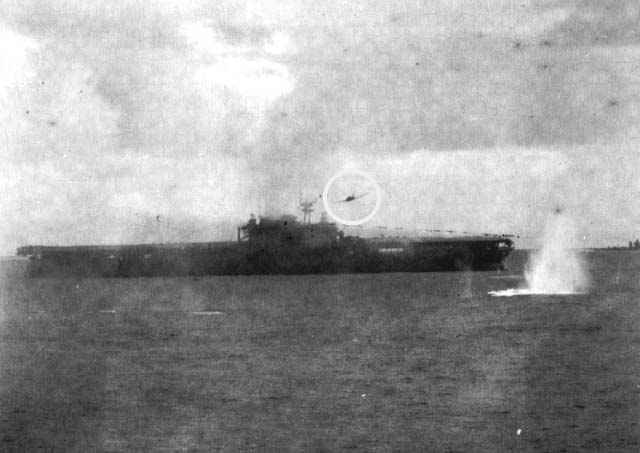
However, let's say we did not have a brilliant President with a capable builder like Henry Kaiser who would build 50, that's 5-0 escort carriers by 1944! Let's say not only Midway didn't happen but a worse-case scenario where every large U.S. aircraft carrier we had were sunk at Pearl Harbor or in later on small battles, leaving us at the "mercy" of the Japanese with all 6 of their large aircraft carriers, their 3 small carriers and all of their seaplane tenders. Let's face this aircraft carrier bullshit head on...and not applied directly to the forehead.
Not having large aircraft carriers would light a fire under our aircraft industry to create a seaplane fighter that could have operated from battleships, cruisers, destroyers and supply ships long before the Curtis SC-1 SeaHawks arrived in 1944. So while we were hurrying to conjure up some seaplane fighters and some aircraft carriers would our land offensives have had to wait? Would we be out of business having to wait for some carriers to materialize?
We say not.
EVEN IF WE STILL WANTED TO ATTACK JAPAN THE LONG ILLOGICAL WAY FROM THE CENTRAL PACIFIC. The U.S. Navy's vaunted large aircraft carriers didn't do a damn thing for our Soldiers on New Guinea (SWPA--General MacArthur had no carriers yet he did better than Navy/marines who did) or our marines on Guadalcanal. Once they were dropped off, they were on their own. Again, aircraft carriers are not need for land attack and strategic maneuver.
www.ww2pacific.com/gc1days.html
The three U.S. [aircraft] carriers [Enterprise, Hornet, Yorktown] withdrew before dawn Sunday as they were no longer needed for close air support of the successful landing unaware that the cruiser screen had been attacked and destroyed. The transports followed that afternoon.
The Navy needed BATTLESHIPS to stop the IJN battleships from shelling Henderson field at will, but had none. Cruisers and PT boats firing defective torpedoes, and F-4F Wildcat fighters irritated the "Tokyo Express" enough to make them go away.
In fact, we were already mass-producing FDR's escort carriers and they were leading the defeat of the U-Boats and our first landings against the Germans at North Africa. Note how many carriers were in the Pacific at the time of our "great victory" at Midway. The no-carriers hypothesis was not that much different from what really did happen!
www.history.navy.mil/download/car-9.pdf
Commented CinCLant: "The CVE's proved to be a valuable addition to the Fleet. They can handle a potent air group and, while their speed is insufficient, they can operate under most weather conditions and are very useful ships." Their missions in the invasion of North Africa completed, Sangamon, Chenango, and Suwanee were dispatched to the Pacific. By the end of 1942, U.S. carrier strength in the Pacific had been reduced to the Enterprise and the Saratoga.
The first major carrier-supported amphibious landing in the Pacific was the capture of the Gilberts and Marshalls [in 1943]. Eight escort carriers participated...
So with 2 or 0 carriers would we or did we pack up our bags and flee back to Australia or Hawaii?
No.
Neither ground maneuvers nor naval actions stopped just because we were down to 2 large carriers. Nor would they had we had ZERO CARRIERS. Nor should they. Land power projection is not dependant upon aircraft carriers even if it comes itself in surface ships.
How could this be so?
Why didn't those mean 2 remaining Japanese large carriers and 3 small ones sail on down to New Guinea or Guadalcanal and snuff out the Americans there if the aircraft carrier is such the doomsday weapon?
This happened; The Battle of the East Solomon Sea.
www.ww2pacific.com/eastsol.html
The Wasp came back from the Atlantic to help the Enterprise and Saratoga, the battleship North Carolina and a flotilla of cruisers. Our pilots in F-4F Wildcats with armor and self-sealing fuel tanks flamed 70 of the Japanese aircraft that didn't. We sank one of their light carriers so the Japs retreated not dropping off 1, 500 ground troops to expel us from Guadalcanal.
No, wait we said worse case. What could all 6 of the Jap large carriers and 3 smaller ones have done to stop our ground troops that had already landed? Deliver an additional 1, 500 troops that would have banzai charged themselves into our machine gun fire and died or starved to death?
Who would stop them? (Who DID stop them?)
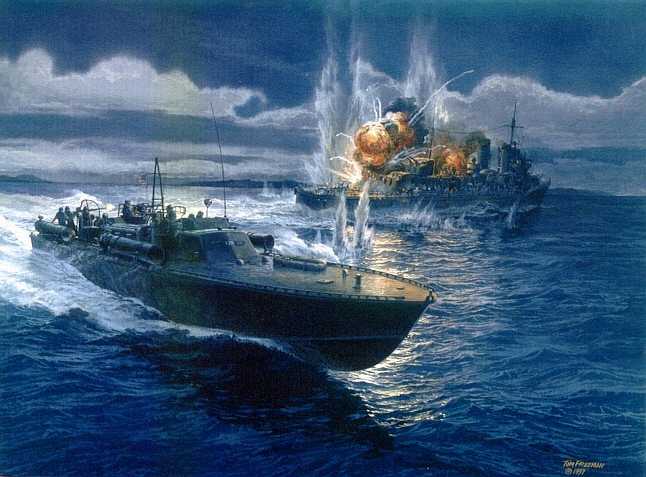
The obvious answer is our battleships, cruisers, destroyers, PT boats, PBY Catalina patrol planes, Army Air Corps bombers and
our submarines would. They would be heading to us, into our land-based aircraft umbrella, our primitive "surveillance-strike-system". It would be the ill-advised land attack on Midway island except without American carriers and against Guadalcanal.
Again, we remind the reader that during the Second World War, United States Submarines operating in the Pacific sank:
201 x Japanese warships totaling 540,192 tons
1 x battleship
4 x large carriers
4 x small carriers
3 x heavy cruisers
8 x light cruisers
43 x destroyers
23 x submarines.
Of even greater importance to the war's outcome, the submarines sent to the bottom
1,113 x merchant ships
...of more than 500 tons each, for a total tonnage of 4,779,902, only a million tons less than the entire prewar Japanese merchant fleet.
Submarines sank 55% percent of all Japanese ships lost in the war, more than the U.S. surface navy, its carrier planes, and the Army Air Corps combined. 3,505 men and 52 submarines were lost, a lot due to defective torpedoes supplied by the cheap USN bureaucracy.
So no, 7 Japanese aircraft carriers are not enough to control 50 enemy submarines in the Pacific much less the entire world (remember this number). If your aircraft carriers do not have fixed-wing ASW planes/capabilities to stop submarines---like the fatal flaw of the Japanese carriers---then they cannot control the sea. If you don't stop submarines you cannot control the sea. A near dozen aircraft carriers might be able to do AAW if their planes/pilots are better than their foes, they might be able to do AsuW if their planes can get through enemy planes with AAW and air defense AAA, but this does nothing to stop submarines from sinking the supply ships your troops need to survive and SINKING YOU. Moreover, even if you had 100 aircraft carriers dropping bombs on dug-in ground troops doing LA, it isn't going to do much of anything on a planet earth that easily absorbs HE effects. We had 102 aircraft carriers in WW2 and we air-bombarded Japanese-held islands for days on end with battleships, cruisers and destroyers adding their gunfire in and this didn't even dent the burrowed defenders; marines came ashore and were mowed down in the thousands. Without an enemy fleet to sink and no ASW capabilities, aircraft carriers have nothing to do but act as supply ships themselves and hope to not get themselves sunk...which is what the Enterprise and Saratoga did post-Midway for our troops on Guadalcanal, ferry planes to be used on land.
The turning point of the war in the Pacific Ocean was WHEN WE SENT OUT OUR SUBMARINES TO ISOLATE AND STARVE OUT THE JAPANESE holding islands they couldn't keep. The turning point of the war in the Atlantic was when our ASW forces began to dominate the German U-Boats to such a degree that our supply convoys COULD GET THROUGH TO FEED THE BRITISH. From England, we invaded Europe and did "regime change" on Germany to end the war there. Now back to the Pacific.
So what would decide the issue on land there?
The Jap troops needed supplies, we needed supplies. Both came by supply ship convoys or by aircraft hopping a distance at a time. We had the huge "land aircraft carrier" of Australia.
The difference again was submarines.
Ours stopped Japan's supply ships starving their bypassed island garrisons, theirs ignored our supply ships sustaining our forces that leap-frogged into island land masses bypassing the enemy islands and interdicting them from resupply.
The U.S. Navy after Pearl Harbor sent out its long-range Gato class submariners and even with defective torpedoes, they denied the Jap troops critical supplies which enabled us to evict them. Helping our subs find the Jap supply ships and fleet in general were thousands of PBY Catalina seaplanes (helped at sea by seaplane tenders), other patrol bombers and our battleship/cruiser seaplanes who could not only radio in where they were, they could attack ships/subs with bombs and depth charges, too. The Japanese never came up with a convoy escort system of ASW means to defeat our subs. Despite having the best seaplanes, the Japanese didn't figure out to supply them like the British Hurricats on British cargo ships to ward off our long-range maritime patrol planes and our subs. The Japs saw war as only a duel between uniformed military combatants, logistics was for "pussies", but a tiger (professional narcissistic warrior) without food will die just as surely as a sheep without food, and sheep (draftee Army/Mc) well-led and fed will slay the weakened tiger every time.
In contrast, our supply ships got through and would have got through even if the Japs had large aircraft carriers and we had none, because our undeterred submarines would have sank their carriers. As it was our subs sank over half their carriers, anyway. The weakness of the IJN was in their ASW capabilities. We were in WW2 dropping sonobuoys from patrol planes to listen for submarine sounds radioed back to the patrol plane to pattern and box in a contact for depth charging and destruction. We had airborne radar. All the Japanese planes had were the "Mark 1 eyeballs" of their crew to visually spot a sub on the surface or a periscope wake; ie; in other words look for their sub prey to make a mistake and give their position away. In fact, our subs sank more of their aircraft carriers than our aircraft dropping bombs and splashing in torpedoes did, a FACT the USN big aircraft carrier lie machine does not want you to know.
If we had got off our asses with seaplane fighters, our battleships, cruisers and destroyers could have held their own against the rapidly dwindling Japanese air strength. As we began to pour superior-performing land-based fighters into land masses taken by our Army/Mc with our superior industrial might, we'd pac-man gobble up the Japanese East Co-Prosperity Sphere a chunk at a time bypassing and starving them out. We created a supply line to Australia from the U.S. of "advanced naval bases" to refuel the fleet and strongpoint the islands with troops and aircraft to protect supply ships.
www.ww2pacific.com/raids.html
U.S. troops are rushed to establish garrisons on the islands that mark the path of convoys from the U.S. West Coast or from the Panama Canal. The first half of the trip is open water.
Convoys from Panama then pass the Marquesas, then in sequence;
Societies, where Bora Bora was to become a fueling station, Samoa, with U.S. and UK bases Fiji, New Caledonia in the Loyalty Islands Brisbane, Australia.
The route from the West Coast
first meets the Line Islands with Palmyra Atoll and Christmas Islands, Phoenix Islands with Canton Island then Samoa, Fijis, New Caledonia and Australia.
These future bases are: In the Line Islands, Palmyra and Christmas Island; Bora Bora in the Society Islands to become a refueling station outside of the projected war zone ; Canton in the Phoenix Islands; Pago Pago in American Samoa ; (there was already British base on Savaii, Western Samoa) ; Suva in the Fijis ; Noumea, New Caledonia to become a headquarters ; and, finally, Brisbane, Australia. Anzac patrols the Fiji to Brisbane portion. The 2nd marine brigade arrives in American Samoa 23 Jan 42 from San Diego, escorted by Yorktown and covered by Enterprise.
Another large convoy comes through the Panama Canal and is screened by Lexington task force on her way from Pearl to the South Pacific. This convoy provides garrison troops for:
Christmas Island, 5000 men about 5 Feb;
Canton, 5,000 men 7 Feb;
Noumea, 10,000 men 14 Feb.
A hydrographic survey of Bora Bora has its charts completed 12 Feb to receive 4,500 men to build a refueling station, escorted by two old cruisers from South American patrol, Concord (CL-10) and Trenton (CL-11).
If the Japs and their aircraft carriers came to attack, our land-based aircraft would have gleefully sunk them ala Cactus Air Force. If they tried to play land aircraft carrier like fortress Rabaul, MacArthur simply bypassed them and with our subs and now land-based low-level attack A-20, B-25 medium bomber aircraft bristling with .50 caliber heavy machine guns and bombs of General Kenney's 5th Air Force wrapped around them, no supplies from Japan got through.
SO THE STRATEGIC LEVERAGE HERE IS NOT THE AIRCRAFT CARRIER, ITS LAND.
CONTROLLING THE LAND IS THE KEY.
WAR IS ABOUT PEOPLE.
PEOPLE LIVE ON LAND---NOT ON THE SEA LIKE A KEVIN COSTNER WATERWORLD.
Not the sea.
Sorry Mahan.
TO CONTROL THE LAND YOU NEED TROOPS. TROOPS NEED MILITARY SUPPLIES (they don't grow on trees). TO GET SUPPLIES YOU NEED TO KEEP SUPPLY LINES OPEN IN THE AIR AND SEA.
SUBS STOP THE ENEMY'S SUPPLY SHIPS GETTING TO THEIR TROOPS TO FIGHT WITH.
SUBS STOP ENEMY SURFACE WARSHIPS FROM INTERDICTING OUR SUPPLY SHIPS.
US. AIRCRAFT CARRIERS STOP THE ENEMY'S SUBS FROM SINKING OUR SUPPLY SHIPS SO OUR GROUND TROOPS GET THE SUPPLIES THEY NEED.
SUBS GIVETH AND SUBS TAKETH AWAY.
To stay alive on land with war implements if you can't make them there (ideal) is by supply ships from land masses where such implements are made.
Since the way to control land surrounded by sea is to SINK SHIPS that might sink your supply ships and you do that with SUBMARINES and LONGER-RANGED AIRPLANES than you find on aircraft carriers, but if that's all you got, that's what you use but without the at-sea accidental losses. Not by dropping unguided bombs which miss, but by
TORPEDOES.
Essentially, very large linearly directed undersea high explosive "bullets" with enough blast to sink ships by exploding a huge hole below their water line so they sink. Subs are the best way to line up secretly to shoot and sink ships because they cannot be seen. Next best are airplanes dropping torpedoes because they are fast and then surface ships because in WW2 they were at least as fast as who they were trying to torpedo.
You may say, wait a minute! What about the Japanese submarines?
They were mis-directed to attack our warships and ignored our supply ships who were guarded by our cargo ship small aircraft carriers. From 1943 on we mass produced so many cargo ship small aircraft carriers in WW2 we had enough to escort both our supply ships and our cruisers/destroyers...the Japanese submarines who tried to ambush these forces were vanquished just like the German U-Boats were vanquished by ASW convoys with cargo ship aircraft carriers.
SO THE REAL LESSON OF NAVAL COMBAT IS NOT THE SUPERIORITY OF THE LARGE AIRCRAFT CARRIER TO DUEL OTHER ENEMY LARGE AIRCRAFT CARRIERS (AKA THE MIDWAY MYTH) TO HAVE NAVIES EXIST TO FIGHT EACH OTHER...ITS THAT NAVIES EXIST TO SUPPORT LAND CAMPAIGNS TO DEFEAT NATION-STATES WHO COULD BE THREATENING OUR ECONOMIC INTERESTS BY TAKING LAND RESOURCES AND USING THESE LAND BASES TO INTERDICT OUR CIVILIAN CARGO SHIPS! Keeping the sea lanes out of range of land-based aircraft means defeating the enemy's submarines; he can build 100 subs for every large aircraft carrier.
THE REAL LESSON OF WW2 NAVAL COMBAT IS THAT YOU NEED LOTS OF SMALL AIRCRAFT CARRIERS TO DEFEAT THE LOTS OF ENEMY SUBMARINES HE MAY HAVE BY SMOTHERING THEM AND SPOILING THEIR ATTACKS BEFORE THEY CAN GET A LINE-OF-SIGHT FOR TORPEDO SHOTS ON YOUR CARGO SHIPS.
Its the submarine, stupid.
If your aircraft carriers do not have fixed-wing ASW planes/capabilities to stop submarines---like the fatal flaw of the Japanese carriers---then they cannot control the sea.
If you don't stop submarines you cannot control the sea.
Here are some telling WW2 statistics
www.world-war-2.info/statistics
Major Warships Sunk In World War 2
|
Country |
Aircraft Carriers |
Battleships |
Cruisers |
Destroyers |
Submarines |
Total |
|
Germany |
N/A |
4 |
9 |
53 |
994 |
1060 |
|
Japan |
26 |
12 |
46 |
43+ |
190 |
|
|
Britain |
9 |
5 |
29 |
142 |
75 |
260 |
|
Italy |
0 |
2 |
15 |
99 |
116 |
232 |
|
USA |
11 |
2 |
10 |
82 |
52 |
157 |
|
France |
0 |
5 |
10 |
58 |
65 |
138 |
|
USSR |
0 |
0 |
2 |
34 |
95 |
131 |
|
Holland |
0 |
0 |
3 |
11 |
15 |
29 |
|
Poland |
0 |
0 |
1 |
4 |
2 |
9 |
Germany, with no aircraft on TOP of the water in the end of and middle areas of their U-Boat patrols to ward off ASW aircraft lost a horrific 1, 000 submarines. The only anti-aircraft weapons they had were AAA deck guns only if they surfaced and exposed themselves to more air attack; bombs and guns and torpedoes could now by visually aimed at them. Germany had ZERO aircraft carriers and this imbalanced force structure doomed them.
Japan had only 8 large and 18 small aircraft carriers with 9 seaplane aircraft carriers. One large carrier never left port, so its really 7. That's it.
www.ww2pacific.com/japcv.html
4 lost at Midway left 3, and all of them were sunk by December 1944. For all the hoopla about Japanese aircraft carriers, the fact is they didn't have that many to begin with and they could have avoided Midway's 4 lost carriers and they still wouldn't have much aircraft to put into the sky to duel America's 102 aircraft carriers. The Japanese were always out-numbered in aircraft because they were always outnumbered in aircraft carriers except in the beginning when we had 4 large carriers to their 6 in 1942 because 2 of our carriers were in the Atlantic.
www.ww2pacific.com/japbb.html
Since Japan only had handfuls of aircraft from handfuls of small carriers and these never were nearly enough even if ASW equipped to stop our submarines from sinking their supply ships or their warships. The Japanese aircraft carriers lost by default, they forfeited the match by not showing up to the fight. They could have kept all 4 of their large carriers and they still would have been outnumbered. They had no sophisticated aircraft ASW and they had no aircraft AAW. Their opposites, American subs and planes were free to attack them for all intents and purposes unopposed. All the Imperial Japanese Navy surface ships could do was AsuW with guns, their excellent torpedoes and the dubious LA mission with guns. Their seaplanes could do AsuW and LA with guns and bombs but only rudimentary ASW by visual sighting. That they sank any American subs is a testament to the utility of the seaplane/tender carrier concept. The following historian agrees:
www.ww2pacific.com/japair.html
Carriers did not have catapults, therefore flight operations depended on speed into the wind as the only aid to launching. Some carriers converted from other designs were slow and had to use more flight deck for takeoff thereby interfering with both flight and storage operations. The Japanese always suffered from gasoline fires when hit, whereas the American carriers learned to first empty gas lines, then to flush them with CO2 to prevent secondary explosions. During the lull in the naval air war, late '42 to mid '44, Japan should have built Shokaku class carriers, the equivalent of the Essex class, yet only one was build, Taiho. Shipbuilding resources were spent on the supercarrier Shinano and on conversion of ocean liners to escort carriers. In this period Japan launched 1 x CV, 5 x CVLs, and 2 x CVEs. The U.S. launched 12 x CVs, 9 x CVLs, and 50 x CVEs.
Japan never considered anti-submarine activities for carriers. Meanwhile, USN submarines sank the carriers and merchant fleets that were the life of Japan. Japan started the war using their submarines successfully for anti-shipping and anti-fleet activities, but soon felt compelled to disarm much of their submarine fleet to use in supply of remote sites. The USN payed much attention to anti-submarine defense, initiated from the Atlantic U-boat menace, and kept Japan's submarines suppressed, for example, 6 subs were sunk in 12 days by ONE U.S. destroyer escort, England (DE-635).
Britain, essentially lost about 10 aircraft carriers like the Americans and then more gun warships than even the Americans because they would often send them out on their own with no aircraft on TOP of the water to ward off enemy AsuW aircraft or U-Boats from below. They lacked excellent seaplanes to catapult from their battleships/cruisers capable of doing more than observing.
Rethinking the Battle of the Atlantic: A New Northwest Passage to Europe from North America--by Train!
www.daftlogic.com/projects-google-maps-distance-calculator.htm
Watching the new Battlefield II documentary on the Battle of the Atlantic something amazing struck me.
 www.youtube.com/view_play_list?p=FE093CDF5F45EE9A
www.youtube.com/view_play_list?p=FE093CDF5F45EE9A
WHY are the supply convoys going straight across the middle of the Atlantic ocean for 2, 000 miles + that a 10 mph cargo ship would then be exposed to u-boat attack for 8.3 days when the "GIUK" distances from the UK to Iceland to Greenland to Canada are considerably less?
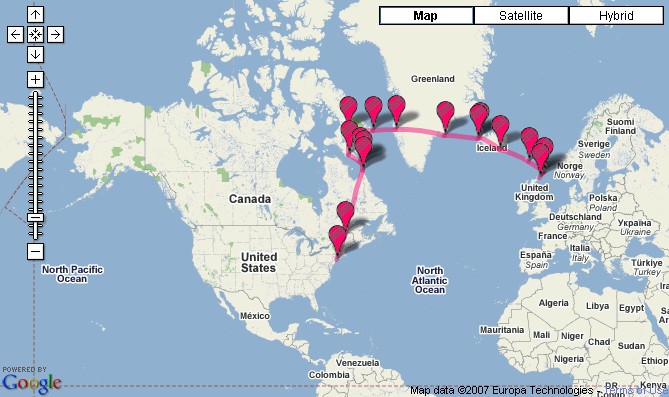
How less are the sea routes?
UK to the Shetland Islands: 59 miles
Shetland to Faeroe islands: 182 miles
Faeroe Islands to Iceland: 297 miles
Iceland to Greenland: 289 miles
Greenland to Baffin Island 212 miles
Baffin to Canadian/U.S. mainland: 59 miles
____________________________________
1098 miles!
Here's what I propose. War armaments are taken by land TRAIN from the U.S. to the tip of Quebec where ferries take the train cars across to Baffin island. Concentrated air and sea ASW forces keep the u-boats away, steel nets might even be feasible to totally seal off the Hudson strait only 59 miles wide. From there, the supplies in train cars take a land TRAIN to the Davis strait crossing point where special high-speed ferries or ships take them across to Greenland where again concentrated ASW forces are present guard the 212 miles from u-boats. The cars are off-loaded and connected to a train that takes them to the eastern end of Greenland where special high-speed ferries or ships take them 289 miles across to Iceland where they can then skirt around hugging the coast under concentrated ASW forces protection to then make the 297 miles in a dash to the nearest Faeroe island. There, they can skirt then dash to the northern-most Shetland island and possibly offload their cargoes and let ferries take the supply rail cars the last 59 miles to the UK.
Now you could say "ice/weather".
This is good! We lead convoys with icebreakers and the ice keeps the old technology u-boats away. Does Baffin bay ever get completely iced-over so trucks can drive across to Greenland? If so, we are down to just 2 x 300 mile gaps to cross cargo ships. Surely we can concentrate ASW forces and keep u-boats away.
What do the high-speed ferry ships do now? Do they sail back empty and run the 3 x 300 mile gauntlets of German u-boats?
No!
They are converted by British shipyards into WARSHIPS. Either escort aircraft carriers or supply ships.
What about the merchant crewmen?
They take SEAPLANES or LANDPLANES back the same way they came in short hops.
Relevance for Today?
http://en.wikipedia.org/wiki/High-speed_rail
What I propose we do today is we build 3 x 300 mile TUNNELS to bridge the GIUK gap with a 300 mph high-speed train! Under the water there'd be no weather ton contend with just some wiggle to compensate for continental drift, plate tectonics etc. Each one of the 3 underwater tunnels @300 mph would be crossed in 1 hour. The entire trip from North England to the tip of New Foundland 5 hours in comfort--on a train--possibly with your electric or hybrid car with you. ISO container cargo should also come across by train. From there to New York would be another 3-4 hours for a total trip of 8-9 hours in comfort compared to the current 2 hours in security checks and 6 hours in agony on a tube and wing airliner packed like sardines flying the long way across the Atlantic.
Convoy Battles
|
Date |
Convoy Code |
Ships |
Sunk |
Tonnage |
German Subs |
Sunk |
|
October 1940 |
SC-71, HX-79 |
79 |
32 |
154,600 |
12 |
0 |
|
September 1941 |
SC-42 |
70 |
18 |
73,200 |
19 |
2 |
|
July 1942 |
PQ-17 |
42 |
16 |
102,300 |
11 |
0 |
|
November 1942 |
SC-107 |
42 |
15 |
82,800 |
18 |
3 |
|
December 1942 |
ONS-154 |
45 |
19 |
74,500 |
19 |
1 |
|
March 1943 |
SC-121, HX-228 |
119 |
16 |
79,900 |
37 |
2 |
800 x U-Boat subs sank 2,640 ships in the Atlantic
|
Year |
Total Allied Ships Sunk |
Sunk By German Submarine |
|
1939 |
222 |
114 |
|
1940 |
1059 |
471 |
|
1941 |
1299 |
432 |
|
1942 |
1664 |
1160 |
|
1943 |
597 |
377 |
|
1944 |
205 |
132 |
|
1945 |
105 |
56 |
British economic survival depended upon supply ships from the U.S., so they had to come up with a complete answer to the U-Boat undersea 3D threat. They flew long-range seaplane and bombers converted into maritime ASW patrol planes to keep the pressure on the U-Boats who now couldn't surface to run diesel engines to recharge their batteries. Their destroyers would hunt U-Boats using radar, sonar and guidance from aircraft, then kill them using depth charges or gunfire, torpedoes or even ramming if they were on the surface. They put Hurricane fighters on supply ships on rocket catapults to ward away German FW-200 Condor maritime patrol planes. In 1940, 1 out of every 2 supply ships were getting sunk, a suicidal 50% rate. By 1943, only 1 out of every 100 supply ships were getting sunk by German subs.
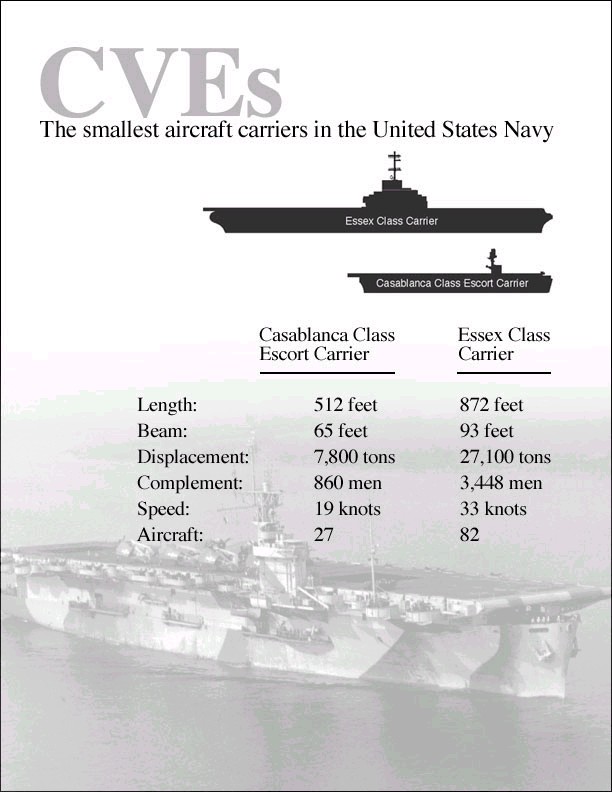
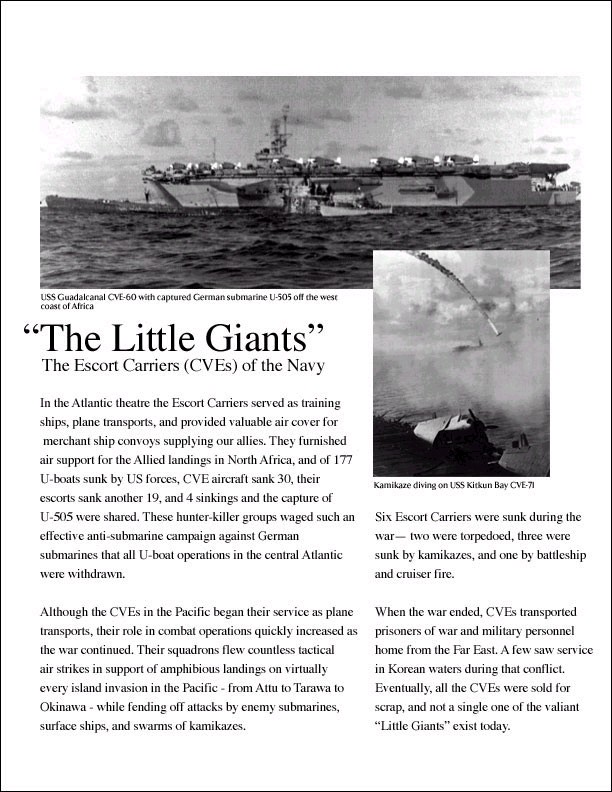
The change was that in the middle of the ocean they now had 124 of FDR's small cargo ship converted and purpose-built aircraft "escort" carriers from the U.S; starting in 1943 this tipped the scales in their favor against the U-Boats.
www.navsource.org/archives/03idx.htm
Of the 124 escort carriers built, 38 went to the Royal Navy:
Designation Original American Name (if any) British Name
(BAVG-1) HMS ARCHER
(BAVG-2) / HMS AVENGER
(BAVG-3) / HMS BITER
(BAVG-4) / HMS CHARGER / see (CVE-30) CHARGER
(BAVG-5) / HMS DASHER
(BAVG-6) / HMS TRACKER
(CVE-6) ALTAMAHA / HMS BATTLER
(CVE-7) BARNES / HMS ATTACKER
(CVE-8) BLOCK ISLAND / HMS HUNTER
(CVE-10) BRETON / HMS CHASER
(CVE-14) CROATAN / HMS FENCER
(CVE-15) HAMLIN / HMS STALKER
(CVE-17) ST GEORGE / HMS PURSUER
(CVE-19) PRINCE WILLIAM / HMS STRIKER
(CVE-22) HMS SEARCHER
(CVE-24) HMS RAVAGER
(CVE-32) CHATHAM / HMS SLINGER
(CVE-33) GLACIER / HMS ATHELING
(CVE-34) PYBUS / HMS EMPEROR
(CVE-35) BAFFINS / HMS AMEER
(CVE-36) BOLINAS / HMS BEGUM
(CVE-37) BASTIAN / HMS TRUMPETER
(CVE-38) CARNEGIE / HMS EMPRESS
(CVE-39) CORDOVA / HMS KHEDIVE
(CVE-40) DELGADA / HMS SPEAKER
(CVE-41) EDISTO / HMS NABOB
(CVE-42) ESTERO / HMS PREMIER
(CVE-43) JAMAICA / HMS SHAH
(CVE-44) KEWEENAW / HMS PATROLLER
(CVE-45) PRINCE / HMS RAJAH
(CVE-46) NIANTIC / HMS RANEE
(CVE-47) PERDIDO / HMS TROUNCER
(CVE-48) SUNSET / HMS THANE
(CVE-49) ST. ANDREWS / HMS QUEEN
(CVE-50) ST. JOSEPH / HMS RULER
(CVE-51) ST. SIMON / HMS ARBITER
(CVE-52) VERMILLION / HMS SMITER
(CVE-53) WILLAPA / HMS PUNCHER
(CVE-54) WINJAH / HMS REAPER
And 86 went to the U.S. Navy:
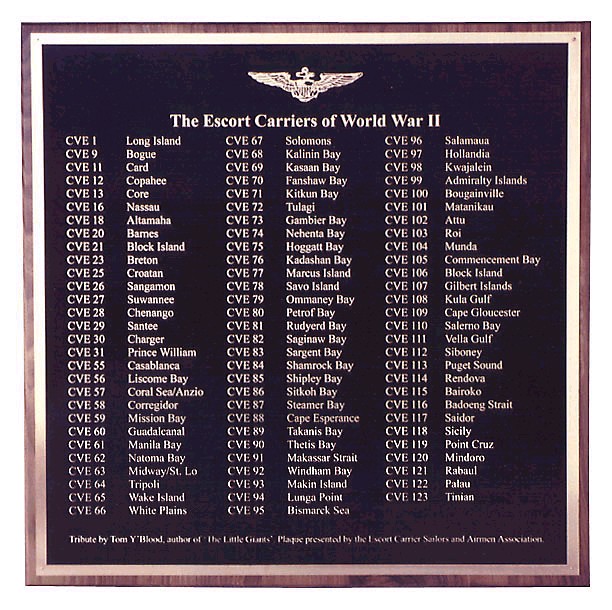
Many also served during the Korean war:
www.korean-war.com/USNavy/USNavyShips.html
(CVE-9) USS Bogue
(CVE-11) USS Card recalled to active duty, delivered U.S. Army helicopters and USAF/USN/Mc aircraft to Vietnam
(CVE-12) USS Copahee
(CVE-13) USS Core recalled to active duty, delivered U.S. Army helicopters and USAF/USN/Mc aircraft to Vietnam
(CVE-16) USS Nassau
(CVE-18) USS Altamaha
(CVE-20) USS Barnes
(CVE-21) USS Block Island SUNK IN COMBAT
(CVE-23) USS Breton recalled to active duty, delivered U.S. Army helicopters and USAF/USN/Mc aircraft to Vietnam
(CVE-25) USS Croatan used in 1965 NASA expedition to explore atmosphere during period of solar flares, recalled to active duty, delivered U.S. Army helicopters and USAF/USN/Mc aircraft to Vietnam
(CVE-26) USS Sangamon
(CVE-27) USS Suwannee
(CVE-28) USS Chenango
(CVE-29) USS Santee
(CVE-30) USS Charger
(CVE-31) USS Prince William on active duty after WW2
(CVE-55) USS Casablanca
(CVE-56) USS Liscome Bay SUNK IN COMBAT
(CVE-57) USS Coral Sea/Anzio
(CVE-58) USS Corregidor recalled to active duty, Korean War; used in 1958 Lebanon crisis to launch U.S. Army STOL aircraft, recalled to active duty, delivered U.S. Army helicopters and USAF/USN/Mc aircraft to Vietnam
(CVE-59) USS Mission Bay
(CVE-60) USS Guadalcanal
(CVE-61) USS Manila Bay
(CVE-62) USS Natoma Bay
(CVE-63) USS Midway/St. Lo SUNK IN COMBAT
(CVE-64) USS Tripoli recalled to active duty, Korean War as TCVE
(CVE-65) USS Wake Island
(CVE-66) USS White Plains
(CVE-67) USS Solomons
(CVE-68) USS Kalinin Bay
(CVE-69) USS Kasaan Bay
(CVE-70) USS Fanshaw Bay
(CVE-71) USS Kitkun Bay
(CVE-72) USS Tulagi
(CVE-73) USS Gambier Bay SUNK IN COMBAT
(CVE-74) USS Nehenta Bay
(CVE-75) USS Hoggatt Bay
(CVE-76) USS Kadashan Bay
(CVE-77) USS Marcu Island
(CVE-78) USS Savo Island
(CVE-79) USS Ommaney Bay SUNK IN COMBAT
(CVE-80) USS Petrof Bay
(CVE-81) USS RUDYERD BAY
(CVE-82) USS SAGINAW BAY
(CVE-83) USS SARGENT BAY
(CVE-84) USS SHAMROCK BAY
(CVE-85) USS SHIPLEY BAY
(CVE-86) USS Sitkoh Bay recalled to active duty, Korean War as TCVE
(CVE-87) USS STEAMER BAY
(CVE-88) USS Cape Esperance recalled to active duty, Korean War as TCVE
(CVE-89) USS TAKANIS BAY
(CVE-90) USS Thetis Bay on active duty in the 1950s as first helicopter amphibious assault carrier, Cuban missile crisis blockade participant with marines embarked, 1962
(CVE-91) USS MAKASSAR STRAIT inactive reserve after WW2
(CVE-92) USS Windham Bay aircraft ferry and training carrier during Korean war era
(CVE-93) USS Makin Island
(CVE-94) USS Lunga Point
(CVE-95) USS Bismarck Sea SUNK IN COMBAT
(CVE-96) USS SALAMAUA
(CVE-97) USS HOLLANDIA
(CVE-98) USS KWAJALEIN
(CVE-99) USS ADMIRALTY ISLANDS
(CVE-100)USS BOUGAINVILLE
(CVE-101)USS Matanikau
(CVE-102)USS Attu
(CVE-103)USS Roi
(CVE-104)USS Munda inactive reserve after WW2
(CVE-105)USS Commencement Bay
(CVE-106)USS Block Island SUNK IN COMBAT
(CVE-107)USS Gilbert Islands recalled to active duty, Korean War, first to land jets, service in Vietnam war as communications relay ship
(CVE-108)USS Kula Gulf recalled to active duty, Korean War, recalled to active duty, delivered U.S. Army helicopters and USAF/USN/Mc aircraft to Vietnam
(CVE-109)USS Cape Gloucester inactive reserve after WW2
(CVE-110)USS Salerno Bay recalled to active duty, Korean War
(CVE-111)USS Vella Gulf inactive reserve after WW2
(CVE-112)USS Siboney recalled to active duty, Korean War
(CVE-113)USS Puget Sound inactive reserve after WW2
(CVE-114)USS Rendova recalled to active duty, Korean War
(CVE-115)USS Bairoko recalled to active duty, Korean War
(CVE-116)USS Badoeng Strait recalled to active duty, Korean War
(CVE-117)USS Saidor recalled to active duty, Korean War
(CVE-118)USS Sicily recalled to active duty, Korean War
(CVE-119)USS Point Cruz recalled to active duty, Korean War; did largest helicopter amphibious airlift of Indian DMZ peacekeeping troops using U.S. Army helicopters
(CVE-120)USS Mindoro recalled to active duty, Korean War
(CVE-121)USS Rabaul
(CVE-122)USS Palau recalled to active duty, Korean War; first ASW carrier
(CVE-123)USS Tinian
(CVE-124)USS BASTOGNE CANCELLED
(CVE-125)USS ENIWETOK CANCELLED
(CVE-126)USS LINGAYEN CANCELLED
(CVE-127)USS OKINAWA CANCELLED
CVE-128 Through CVE-139 Unnamed, Never Laid Down.
www.chinfo.navy.mil/navpalib/ships/carriers/cv-escrt.html
The U.S. Navy website above notes:
The need for escort carriers came early in the war when German submarines and aircraft were taking a devastating toll on convoy shipping. The heaviest losses occurred far at sea where land-based aircraft couldn't operate. The Royal Navy had experimented with catapult-launched fighter planes from merchantmen; while this was somewhat successful in combating the U-boats, the number of planes that could be embarked was limited. Something else was needed, and in a hurry. Great Britain appealed to the United States for help.No real specifications had been developed for escort carriers at this time, although the Navy had looked into converting merchant ships for this purpose before the war began. Thus, the quick solution was to build the early CVEs on merchant ship hulls.
The first CVE was USS Long Island (CVE-1), converted from a Maritime Commission freighter. Due to a shortage of merchant ship hulls, four escort carriers were built on Cimarron-class fleet oiler hulls. These four, USS Sangamon (CVE-26), USS Suwanee (CVE-27), USS Chenanago (CVE-28), and USS Santee (CVE-29), were so successful in anti-submarine work and in covering amphibious operations that, after participating in the landings in North Africa, they were deployed to the Pacific. There, the fleet was in desperate need of carriers. [EDITOR: TYPICAL LYING USN URBAN LEGEND BULLSHIT]
These early ships paved the way for a tremendous building program of Jeeps in the United States. Between June 1941 and April 1945, 78 escort carriers would be built and launched - a remarkable feat of wartime naval construction.
In the Atlantic, escort carriers originally stayed close to the convoys they were protecting. Over time, tactics evolved that enabled the Jeep carriers and their destroyer escorts to become independent "hunter-killer" groups. They could attack concentrations of U-boats at will and were no longer required to provide constant umbrella coverage for a convoy. This tactic was further refined by having the escort carrier groups concentrate their efforts in areas where U-boats met their supply submarines ("milch cows").
This operational phase was so successful that three Jeeps - USS Core (CVE-13), USS Card (CVE-11) and USS Bogue (CVE-9) [left] - and their escorting destroyers sank a total of 16 U-boats and 8 milch cows in a period of 98 days. During this time, U-boats sank only one merchantman and shot down only three planes from the escort carriers. This loss of submarines, particularly the milch cows, was a severe blow to the German Navy. With diminished capability for refueling U-boats at sea, and with no friendly bases in the area, Admiral Karl Doenitz, commander of the German U-boat fleet, was forced to withdraw his remaining supply submarines and cancel all U-boat operations in the central Atlantic.
Testimony indeed to the hard work, skill and dedication of the Jeeps and the men who served in them. [EDITOR: which the USN will reward you by retiring your ships and using your memory paid for in your blood to pump up their egos to build other ships]
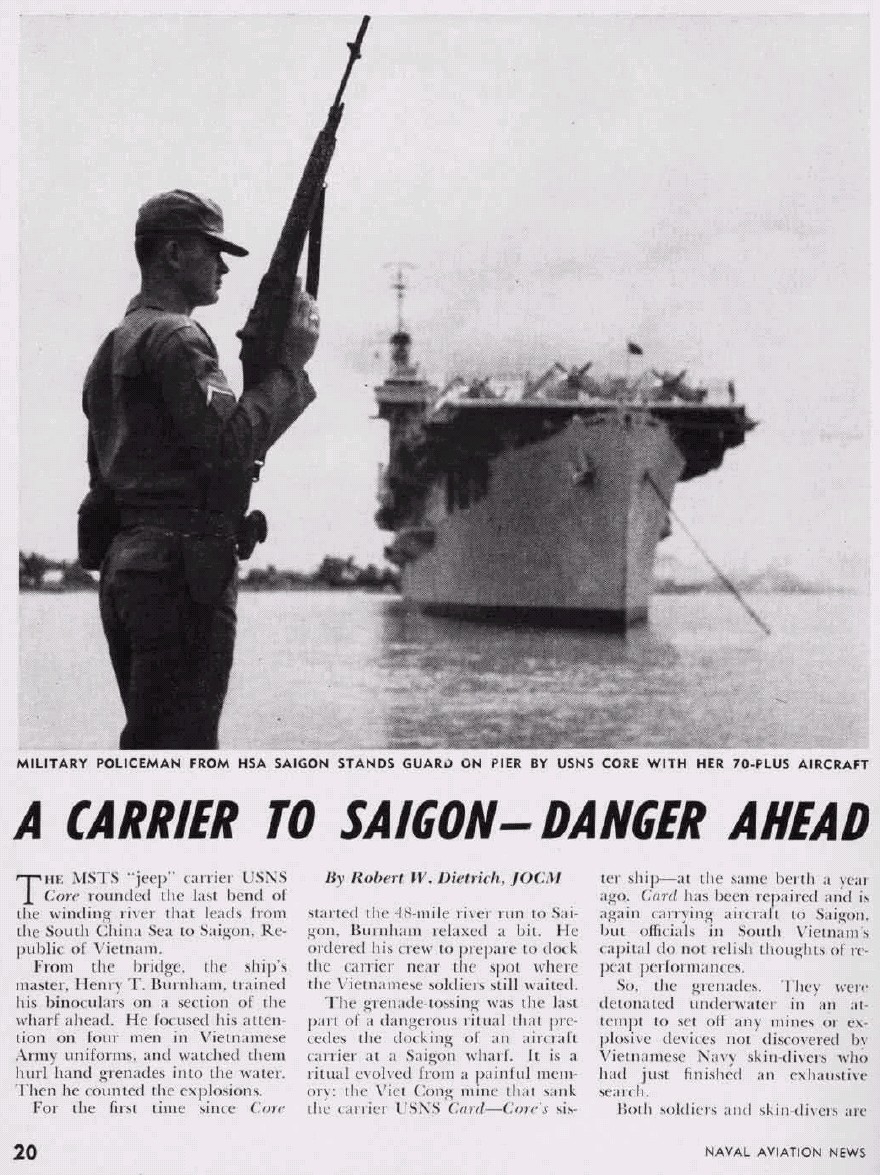
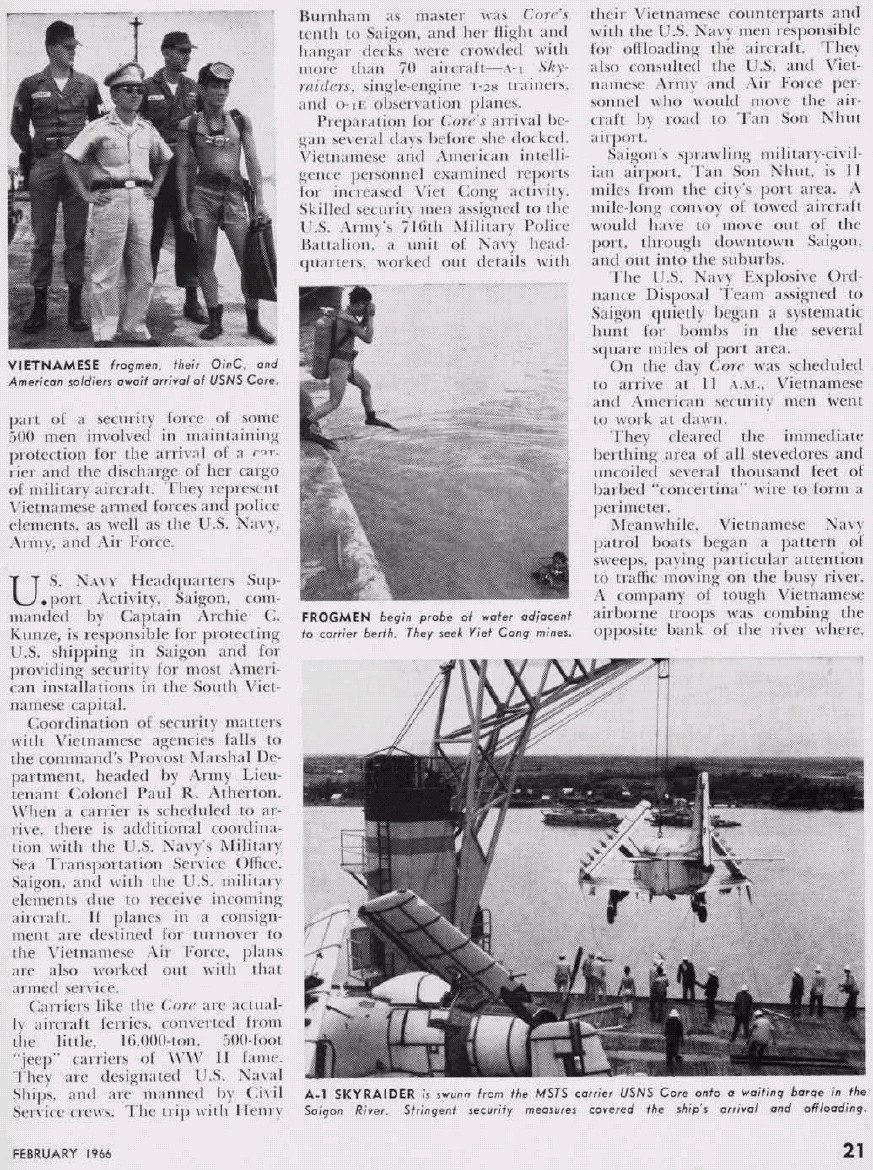
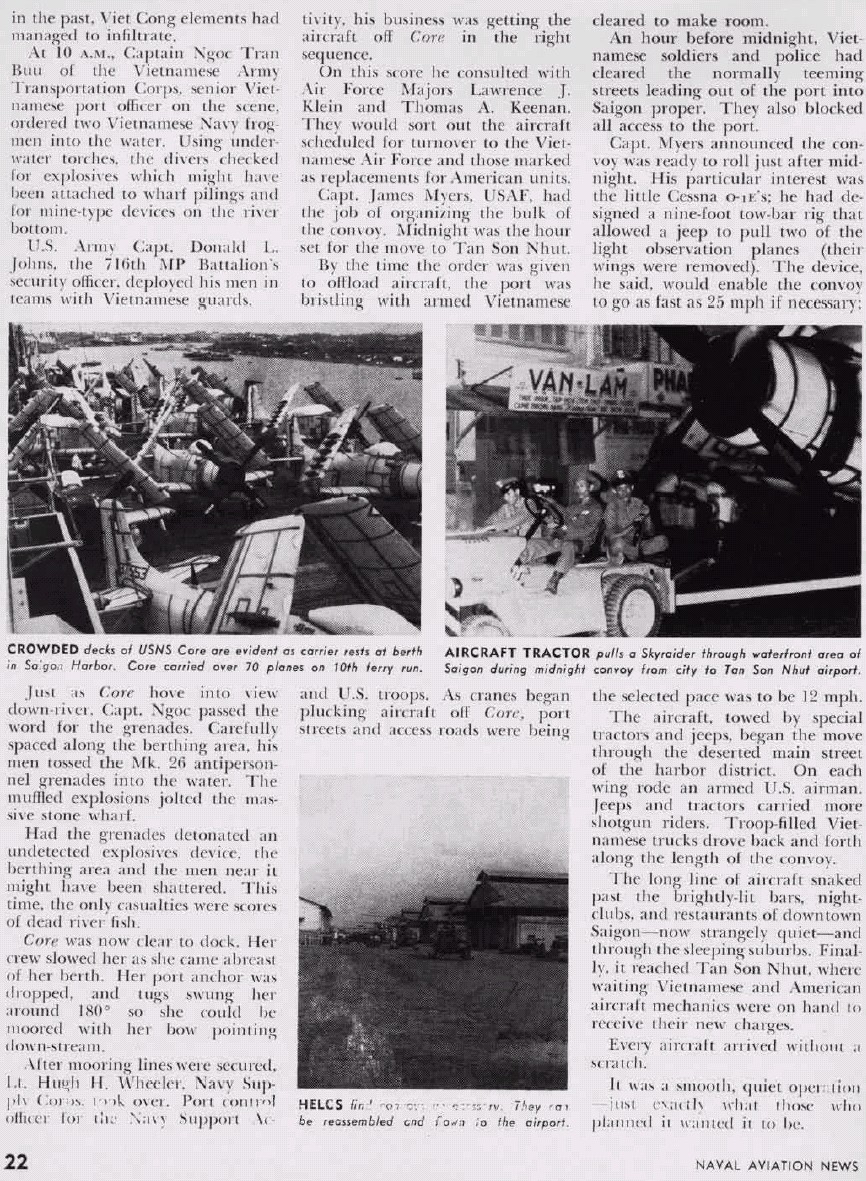
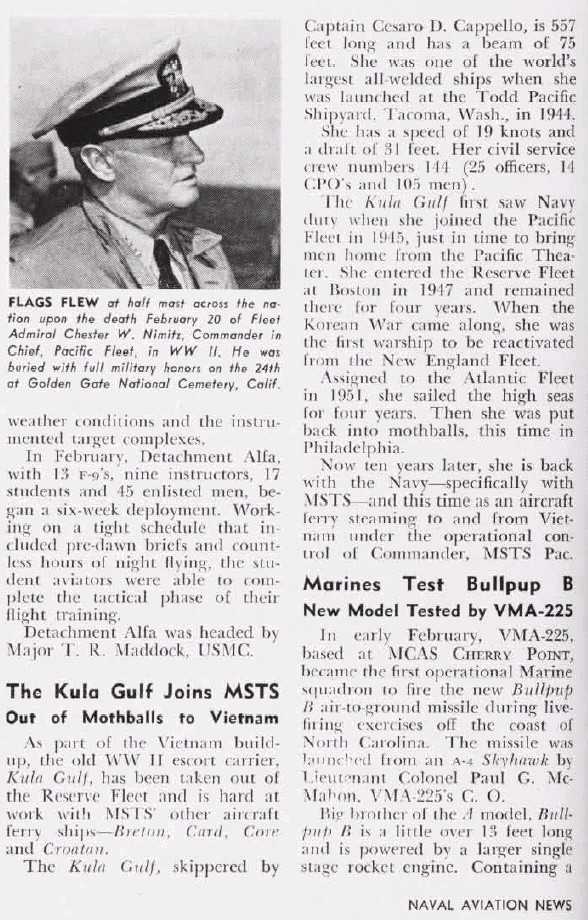
The Brits were the world leaders in radar and fitted it to both ships and planes to defeat the German submarines...the Japanese did not do this and they lost the war because of it.
http://uboat.net/allies/technical/uk_radars.htm
ASV Mk.XIThe ASV Mk.XI was a centrimetric radar intended for the TBR (torpedo bomber and reconnaissance) aircraft of the Fleet Air Arm, the component of the Royal Navy that operated carrier aircraft. It was also known known as ASVX and therefore it sometimes has been called, erroneously, ASV Mk.X.
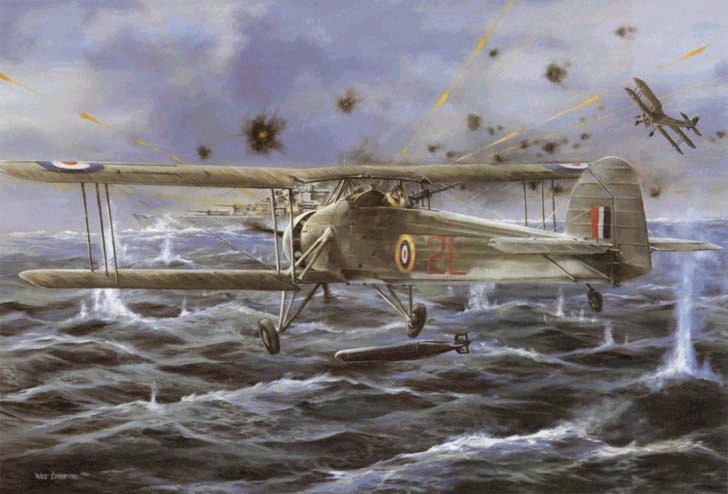
ASV Mk.XI could be fitted between the main wheel legs of a Fairey Swordfish. In addition to the bulky radome, a Leigh light could be fitted. The radome made the the carrying of torpedoes or large depth charges impossible, so when the target was a ship the Swordfish was accompanied by other aircraft without radar. Against submarines, the radar-equipped Swordfish Mk.III was armed with eight rockets on underwing launches, and also carried flares to illuminate any U-boat it found. Fired at 600 yards, the rockets easily penetrated a submarine's hull.
This radar was also carried by the Fairey Barracuda Mk.III.
ASV Mk.XI had a maximum range of about 60km against ships, and in good conditions and at low altitude (2000 feet) it could detect a surfaced submarine at about 20km. But it could detect a schnorkel only in very calm seas and at distances below 8km. It gave bearings with an accuracy of about 2 degrees.
Assisting the Hurricat CAM ships, CVE "Jeep" escort carriers with ASW planes were Navy long-range LTA blimps, patrol bombers and seaplanes. The December 1, 1946 U.S. Naval Aviation News magazine reports:
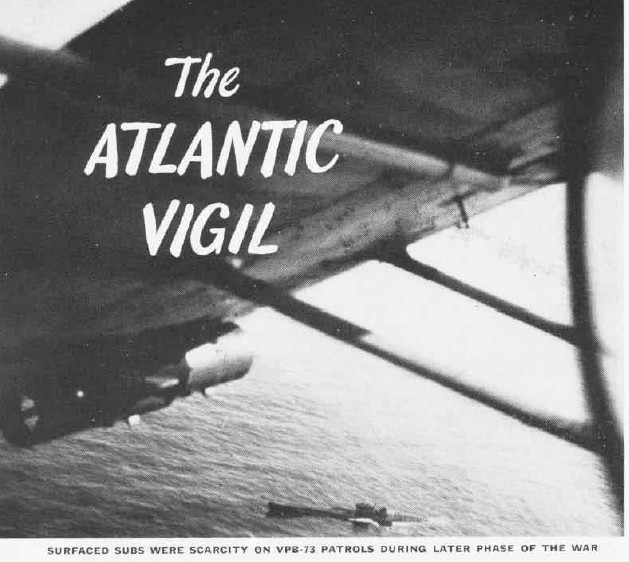
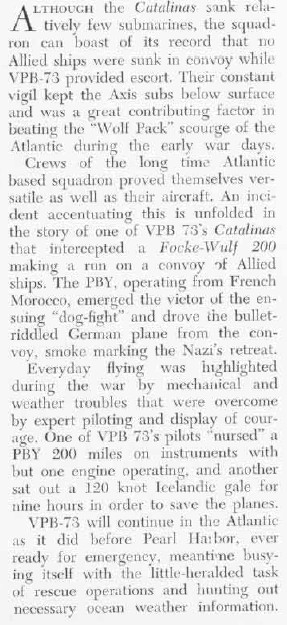
Look at some more of the the FACTS:
German Submarine (U-Boat) Combat Losses
|
Sunk By |
1939 |
1940 |
1941 |
1942 |
1943 |
1944 |
1945 |
Total |
|
Aircraft Carrier |
0 |
2 |
3 |
36 |
140 |
68 |
40 |
289 |
|
Ships |
5 |
11 |
24 |
32 |
59 |
68 |
17 |
216 |
|
Bombs |
0 |
0 |
0 |
0 |
2 |
24 |
36 |
62 |
|
Mines |
3 |
2 |
0 |
3 |
1 |
9 |
7 |
25 |
|
Submarines |
1 |
2 |
1 |
2 |
4 |
5 |
3 |
18 |
|
Other |
0 |
4 |
5 |
6 |
17 |
43 |
17 |
92 |
|
Total |
9 |
23 |
35 |
86 |
236 |
235 |
122 |
746 |
BBC Documentary on How the U-Boats were Defeated: THE HUNTED
www.youtube.com/watch?v=BC6qFBJyjgw
PART 2
Liconia incident, don't ever get separated from your baby, dumbass American patrol bomber pilot fucks up any chivalry from uboats, fortified uboat pens but at sea protection ignored, Doenitz only listened to german military advice in Berlin, no improvements from end of ww1!!! U-Boat design complacency, air coverage gap, Hitler says massacre surviving seamen, Doenitz said no, good for him
www.youtube.com/watch?v=oSXgr5o9wUM
PART 3 Horton's war games hones technotactical skills, ONS 5's 11 escorts vs 34 U-Boats battle, had DF gear plus radar
www.youtube.com/watch?v=n_erMJxOIuo
PART 4 surface escorts have edge over u-boats now, Doenitz's son kia, 2 years til high underwater speed U-Boat, German crewman sabotaging uboats to stop suicidal cruises
www.youtube.com/watch?v=Mzxzgj59Ado
PART 5
www.youtube.com/watch?v=rW4oRsy-oA4
Their heavy loss of 142 destroyers like America's near 100 destroyer losses shows the price they paid to hunt/kill enemy U-Boats which was successful, but hardly the ALL AIRCRAFT CARRIER CREATED SUCCESS MITSCHER POMPOUSLY DECLARES FOR HIS PET SERVICE MEANS. Surface ships killed just about as many U-Boats as aircraft carrier aircraft, and if you look at 1943, when both worked together, both of their kill numbers went up. People like Mitscher who only want their pet large aircraft carriers do not want to share the power/glory nor do the dirty work of escorting supply ships so they can get through to help the ground forces win nor even to strategically keep an ally's civilian populace alive. All they want to do is stroke their own egos by sinking the other guy's fleet of aircraft carriers even if it has no bearing on what really matters, which in war is what happens on land where people actually live.
America, enjoys a capital armored ship protection plan. After Pearl Harbor, only 1 armored cruiser is sunk by aircraft, and that was by a torpedo. Armored ships that are moving were not sunk by aircraft; those that were not armored were often sunk by aircraft. The other 9 cruisers that were sunk were all sent to the bottom by torpedoes from subs, surface ships or heavy gunfire. With 102 aircraft carriers, mostly converted cargo ship small carriers, 400+ destroyers, long-range maritime patrol planes, and each battleship/cruiser flying their own seaplanes, they smother the Japanese submarines with ASW. They can't stop all leakers, though and Japanese subs still sink half their few surface ships that are lost. With all these aircraft flying overhead in defensive self-protection in knee-jerk reaction to Pearl Harbor air attacks which only destroyed 1 actual battleship, the traumatized American Navy forced the Japanese to realize that humans in aircraft flying through enemy fighters and over massed AAA fires could not hope to release their torpedoes or bombs in an aimed manner and survive intact to fly back to base to rearm.
Japan with No Naval Air Force Turns to Human Guided Cruise Missiles, We Get a Sneak Preview but then emasculate ourselves after WW2
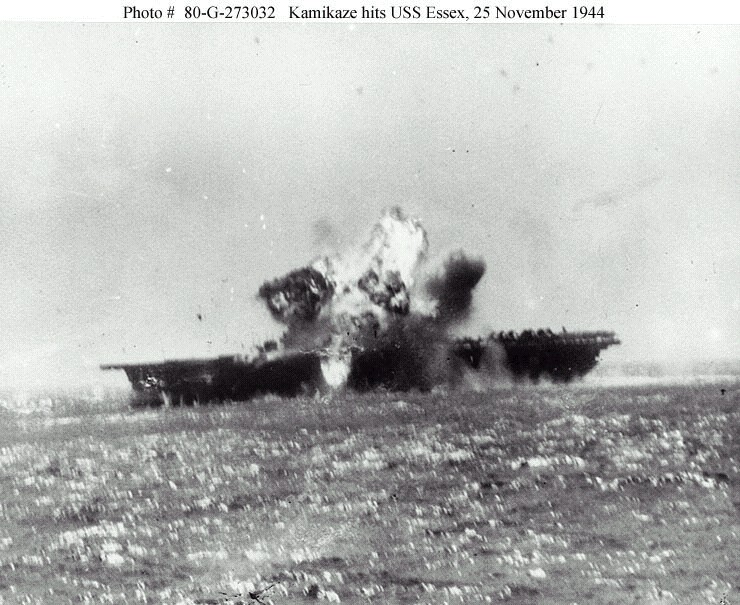
The Japanese concluded they needed guided cruise missiles that would take the inevitable fighter and AAA gunfire hits and still be able to dive into the ships with HE attached. They did not have the technological means to guide aircraft with HE remotely, so they had humans commit suicide in their Kamikaze planes. The battle of Okinawa in 1945 was an awful warning that unarmored ships of ANY type---be they aircraft carriers, destroyers, whatever were at extreme risk to guided missiles. These vulnerable surface ships could be taken out by a smarter not so emotional enemy to remove ASW capabilities to facilitate a fatal collapse of the entire combined-arms synergism of a fleet.
Enter the "Super Aircraft Carrier" BS



From U.S. Naval Aviation News, December 1946
The USN DID NOT LEARN THESE LESSONS; with pompous asses like Mark Mitscher running his mouth, we eventually whittled the WW2 flawed but winning formula down to today's just 11 armored large "super" aircraft carriers, no heavily armored battleships and just flimsy light cruisers and destroyers with nuclear submarines. It all began at the end of WW2 with the advent of the USS Midway "Super Carrier" to feed USN ego and budgetary greed as 78 total aircraft carriers were mothballed (21 big carriers, 57 small carriers and 27 seaplane tenders/aviation support ships). However, there were still some people with common sense on active duty who realized the ocean was still very big and kept 13 big carriers and 9 small carriers for a total of 22 on active duty--twice as many as we have today. They also had 9 seaplane tenders on active service in 1946--today we have none. However, men of common sense are leaving the service in droves and the pompous asses have their knives out. Fast forward to 1948...
www.history.navy.mil/nan/backissues/1940s/1948/jan48.pdf
The January 1948 issue of U.S. Naval Aviation News on page 3 reveals the disgusting anti-small aircraft carrier mentality that emerged...
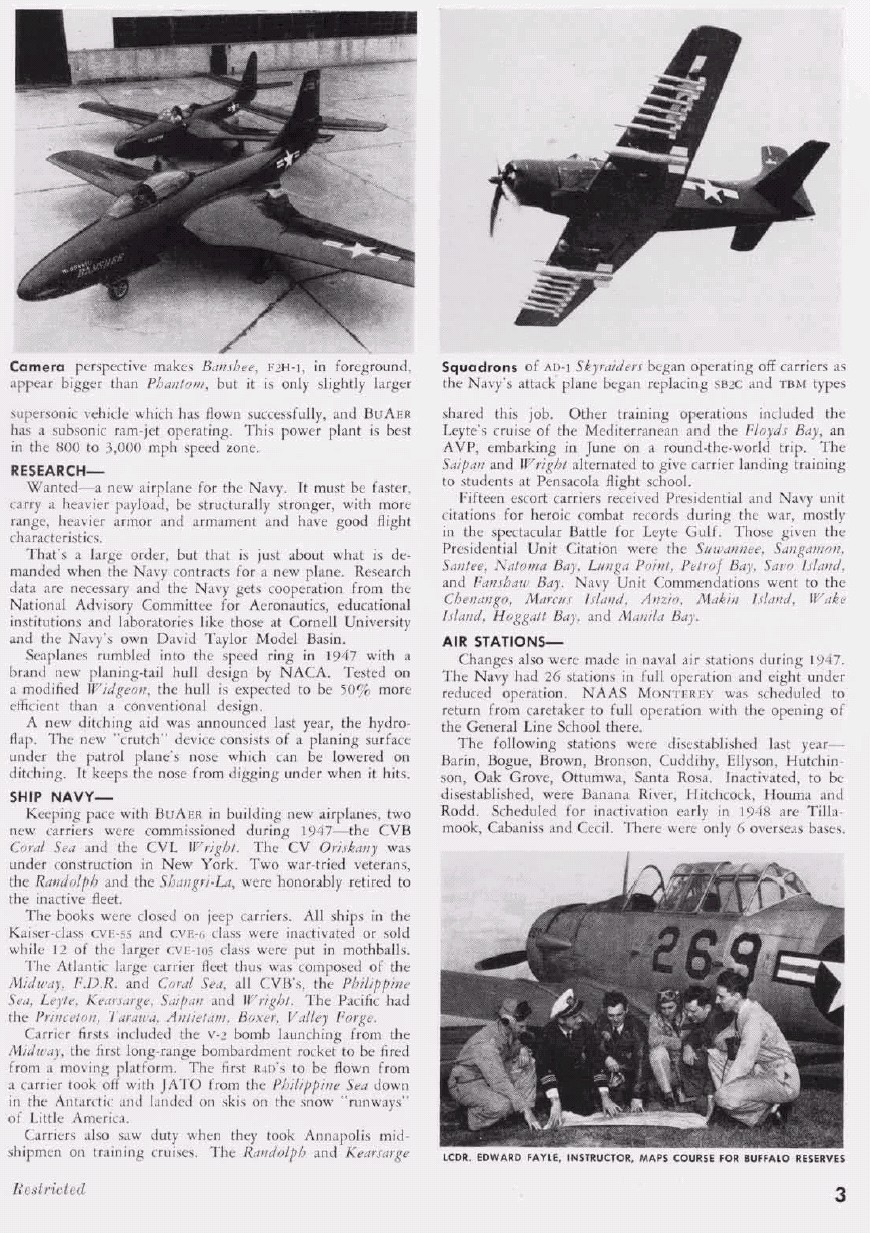
First, the Navy boasts that they have gotten rid of all the shitty little "jeep carrier" CVEs:
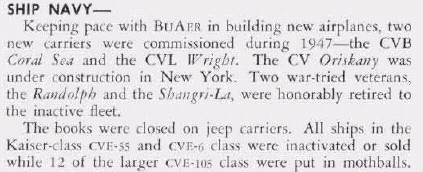
that get-the-job-done Harry Kaiser built. But all the CVEs are really not gone because some of the CVE-55 and CVE-6 class were put in storage we know from previous reports and there are the 12 x CVE-105s are in storage mentioned here. We know from previous reports 9 x CVEs were on ACTIVE DUTY. Or have they been retired? mothballed? Sold?
If the Navy has "closed the books" on escort carriers why are NINE CVEs still on active duty?
Are the CVE escort carriers (CVE-122) USS Palau, (CVE-120) USS Mindoro, (CVE-110) USS Salerno Bay, (CVE-112) USS Siboney and (CVE-118) USS Sicily not in the Atlantic ocean conducting operations with about 2, 000 active duty personnel? Are the CVE escort carriers (CVE-114)USS Redova, (CVE-115) USS Bairoko, and (CVE-116) USS Badoeng Strait and (CVE-117) USS Saidor not in the Pacific doing the same thing?
And what of this report of these non-existant "closed book" CVEs being used for current training and missions?
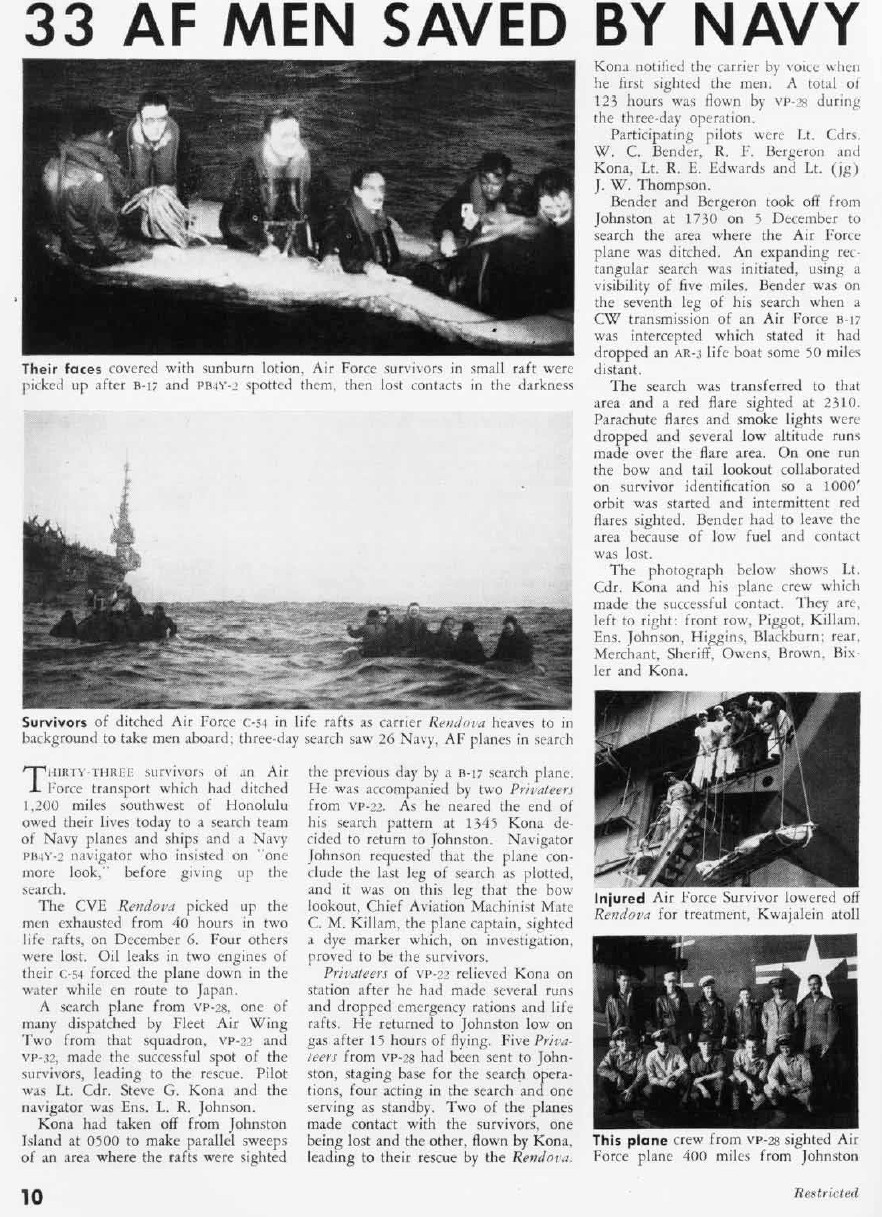
What the fuck is going on here?

These guys REALLY HATE the small carriers and the large carriers with COMBAT records since they retired all of them. They really hate all reminders of how we needed to operate in WW2 lest it get in the way of their avant garde jet fighter crusade against the rival USAF. Somebody at headquarters needs to see a shrink.
If this can't get anymore weirder....IN THE SAME ARTICLE ON THE SAME PAGE that they were defecating on the small carriers...THEY ARE PRAISING THE COMBAT HEROICS THEY MADE POSSIBLE OF THE MEN THAT USED THEM!!!

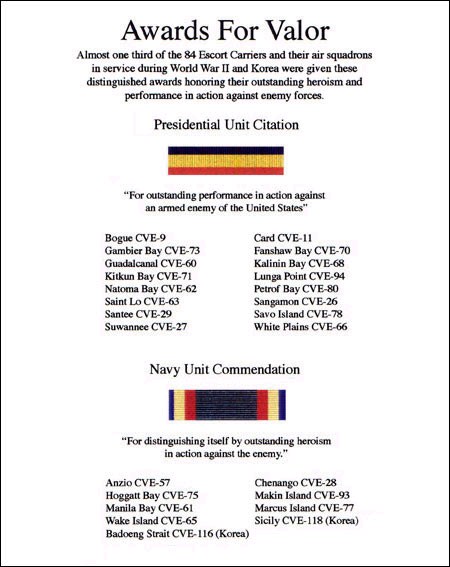
This hypocrisy reeks to high heaven....when they need the small carrier for institutional ego the Navy brass are quick to use the exploits paid in other men's blood to puff up their image...but at all other times the CVEinderellas can go fuck themselves and be scrapped for $$$ or go away and rot somewhere in storage.
Reality check!
Could the new AD-1 SkyRaider prop attack planes fly from the CVEs?
YES.
Could a new prop-plane (FR-2 Dark Shark with turbojet help would be great) ASW/CSAR/COD aircraft fly from CVEs?
YES.
Could helicopters fly from CVEs?
YES.
Then what is the Navy's fucking functional problem then?

The BS fighter jock supercarrier post-war Navy has begun, all other WW2 vital sea control functions be damned. All hail the false god of personal pilot egotism!
In two years this clusterfuck will slam head-on into reality into Korea. Fortunately for the ground maneuver troops, reserve pilots hanging on by flying Corsairs and some SkyRaiders on active duty will be on hand to render effective naval CAS by virtue of their slow speed, low altitude agility and ruggedness, but there will be no SC-1/2 SeaHawk heavy Baltimore class cruiser and Iowa class battleship observation planes--it'll be interesting to see how if any naval gunfire spotting is employed. Remember, the Navy brass don't want cruiser and battleship gunnery to be effective and rob their fighter jet/supercarriers from getting the limelight.
More Fuel = More Vulnerability
www.history.navy.mil/nan/backissues/1940s/1949/may49.pdf
U.S. Naval Aviation News from May 1949 reveals the emergence of the supercarrier lust was excused by the jet airplane's composition as a flying fuel tank.
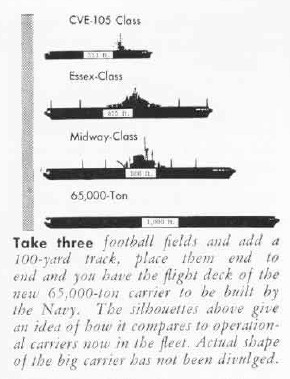



A viscious circle was created; Navy wants to fly faster so it needs jets; jets need more fuel so Navy gets bigger carriers which is what they wanted all along; centralization into fewer platforms (targets) to order around more people to boost ego and budget.
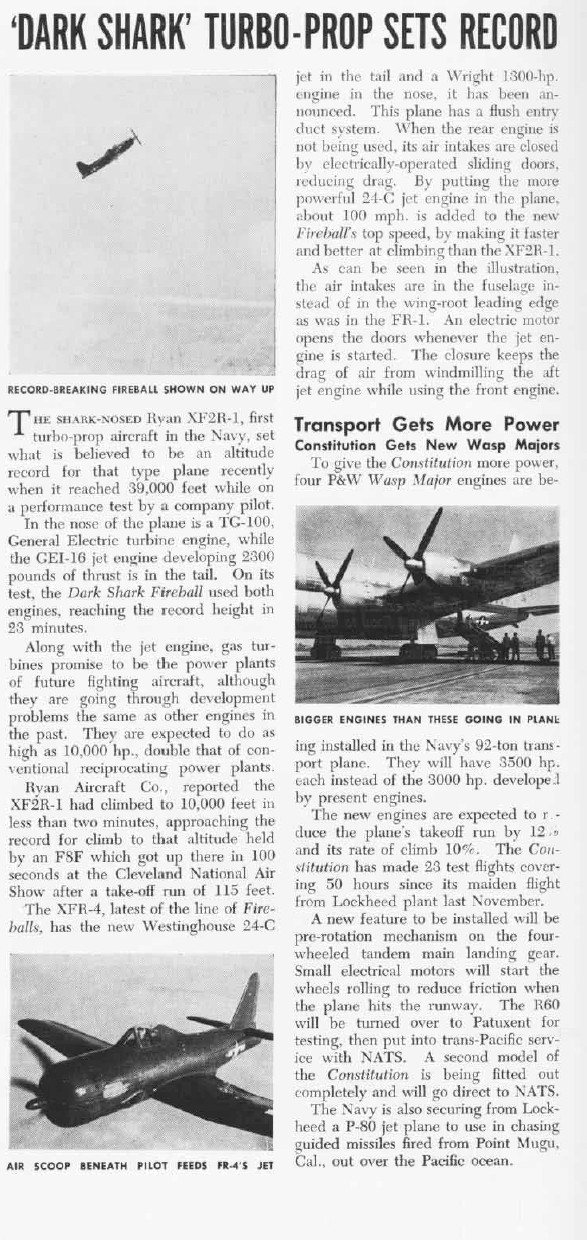
Nevermind, that for the price of 1 supercarrier with 100 jets you could operate 30 small CVE escort carriers with 1, 000 prop-jetslike the FR-2 Dark Shark with greater range and twin-engined reliability albeit at a 500 mph instead of 600 mph....but as know-how increased, the British would invent the angled deck and these could be fitted to the CVEs to operate pure jets if you wanted. Again, note how eager the Navy brass are constantly proclaiming to get rid of the "Last CVE" when we know 9 x CVEs are still on ACTIVE-DUTY and 57 s CVEs are in storage and some will return to duty for the Korean and Vietnam wars.
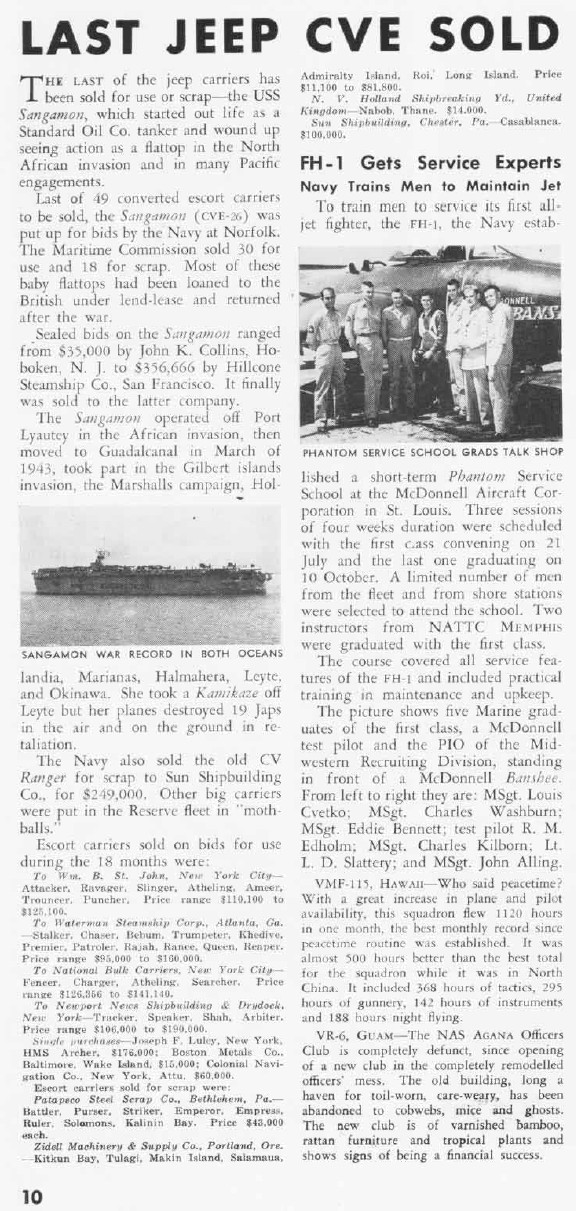
Our thanks to the British for inventing the dry deck aircraft carrier to operate wheel landing gear planes was to take back the CVE escort carriers we lent them at WW2's end and to sell them at bargain basement prices (see listing above) so these small carriers would not be in the hands of the crafty Royal Navy lest they come up with something clever to threaten the pompous egomaniac U.S. Navy's version of Nimrod's tower-of-babel-but-afloat supercarrier dreams.

Out-of-Control Navy Brass: Building SuperCarriers that Can't Go through the Panama Canal Since 1955!
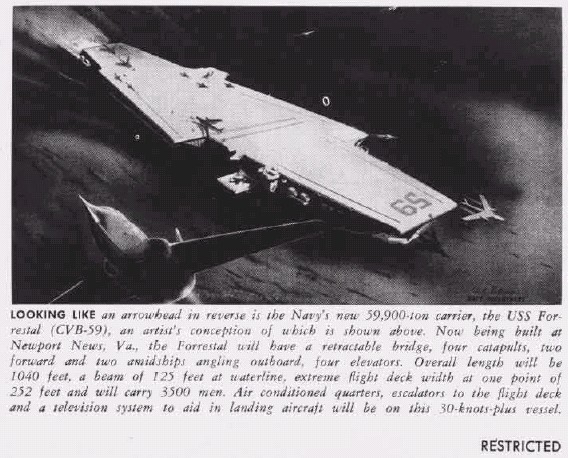
The Japanese wanted to knock out the Panama Canal with an I-400 submarine aircraft carrier raid in 1945...and we went ahead and DID THE DAMAGE TO OURSELVES BY MAKING SUPERCARRIERS TOO BIG TO GO THROUGH THE CANAL!!!
In a major shooting war with no time to mass mobilize a nation or rev up ship production we win or lose with what we already got on hand...and TIME IS OF THE ESSENCE!!
http://en.wikipedia.org/wiki/Panamax
EXCERPTS:Ships classified as Panamax are of the maximum dimensions that will fit through the locks of the Panama Canal. This size is determined by the dimensions of the lock chambers, and the depth of the water in the canal. Panamax is a significant factor in the design of cargo ships, with many ships being built to exactly the maximum allowable size.
Dimensions
Panamax is determined principally by the dimensions of the canal's lock chambers, each of which is 33.53 metres (110 ft) wide by 320.0 metres (1050 ft) long, and 25.9 metres (85 ft) deep. The usable length of each lock chamber is 304.8 metres (1000 ft). The available water depth in the lock chambers varies, but the least depth is at the south sill of the Pedro Miguel Locks, and is 12.55 metres (41.2 ft) at a Miraflores Lake level of 16.61 metres (54 feet 6 in). The height of the Bridge of the Americas at Balboa is the limiting factor on a vessel's overall height.
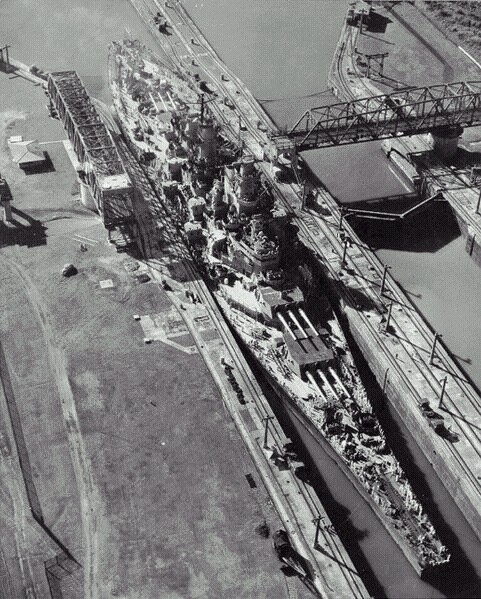
USS Missouri, one of the Iowa class battleships, makes a very tight fit as she passes through the Miraflores Locks of the Panama Canal in October 1945. The maximum dimensions allowed for a ship transiting the canal are: [1]
Length: 294.1 metres (965 ft)
Beam (width): 32.3 metres (106 ft)
Draft: 12.0 metres (39.5 ft) in tropical fresh water (the salinity and temperature of water affect its density, and hence how deeply a ship will sit in the water)
Height: 57.91 metres (190 ft) measured from the waterline to the vessel's highest pointA Panamax cargo ship would typically have a displacement of around 65,000 tons.[2]
Many modern ships, known as post-Panamax ships, are far larger than this (and hence cannot use the canal). This is the case for supertankers and the largest modern container ships; much bulk merchandise such as grain products is moved primarily on Panamax (or sub-Panamax) ships. U.S. Navy supercarriers are also in the post-Panamax class; the Nimitz class aircraft carriers are 333 metres (1092 ft) long overall with a beam of 41 metres (134 ft), while the flight deck is 76.8 metres (252 ft) wide.

The USS Essex class large aircraft carriers that can fit through the Panama Canal were able to receive angled decks as the namesake shows in the photo above...so what was the justification for the "supercarriers" that can't? As you will "see", the Navy began to stray from its sea control obligations to the nation starting at the end of WW2 assuming the American Empire had no peer nation-state competitor and we would be free to play shore bombardment from floating air bases...hence the lust for bigger and bigger more comfortable "air bases". As the Soviet Navy improved in the 1970s, alarmed leaders like Admiral Zumwalt tried to wake the Navy up to start using smaller aircraft carriers called "sea control ships" to work-around supercarrier mafia egos, but to no avail.
SIDEBAR: Panamax Salvation for the Supercarriers?
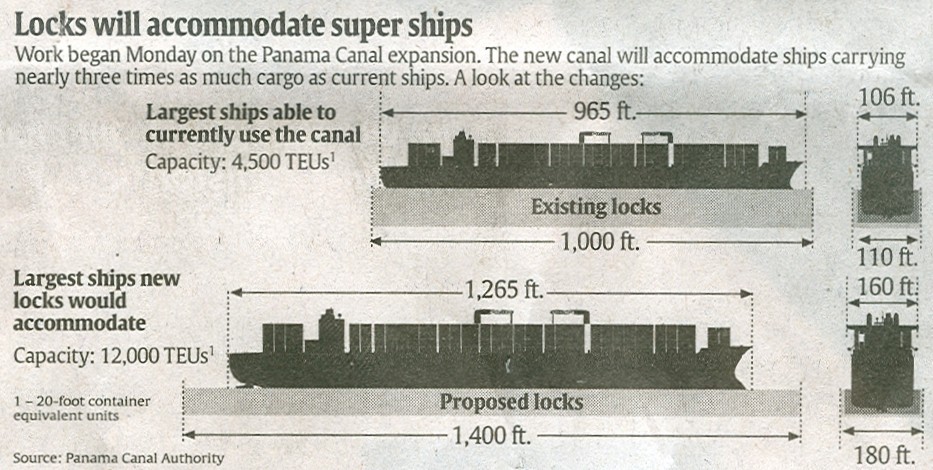
http://en.wikipedia.org/wiki/Panama_Canal_expansion_proposal
Notice no one mentions that once the canal has a new widened sea lane, 134 foot wide, 1100 foot long U.S. Navy "stupercarriers" will be able to transit through.
www.navy.mil/navydata/fact_display.asp?cid=4200&tid=200&ct=4
Could this be the REAL driving force behind the project? Good ole' PaxAmericana aka corporate greed?
You might ask, could other small ships the Navy already has suffice?
Yes, they could, this is why we advocate EVERY SURFACE SHIP HAVING SEAPLANES. Enough of them doing this and you have a defacto Naval air force at sea. In 1945 the United States Navy also possessed 1,728 amphibious ships, which constituted 40 percent of the fleet and enabled the U.S. to project 13 combat divisions. Remember that in WW2 the U.S. Army even operated small observation "grasshoppers" fixed-wing airplanes from amphibious ships. Today, 36 troop-carrying amphibious ships remain in the fleet. By 2010, the number will drop to approximately 32. 12 LHA/LHD are quasi-small aircraft carriers but the only fixed-wing aircraft they can operate are the dwingling 119-or-so crash-prone AV-8B Harrier II STOVL attack planes; in 5 years we will have less than 50 Harrier IIs left; only enough to outfit 2 LHA/LHDs as quasi-sea control ships. The Navy refuses to put ski jumps on the LHAs/LHDs for flight safety or arrestor cables to operate STOBAR aircraft let alone buy STOBAR capable aircraft lest they take the limelight away from the F-18 fighter pilot egomaniac super carrier flying club. The result of these actions is an amphibious fleet that is rapidly reaching the end of its effective service life which is a good thing since packing unskilled marine line infantry that stumbles around on foot and in road-bound, easily ambushed trucks by the thousands in vulnerable surface ships is an invitation to mass slaughter by the enemy. Its not even sound to pack so many men in surface ships even when confronting the forces of the earth. In fact, in WW2, the U.S. Navy LOST MORE SHIPS AND PLANES TO THE BATTLE AGAINST THE EARTH than to their human Japanese/German foes!

Watch the quasi-fictional account of a minesweeper being misdirected by an incompetent Navy Captain during a typhoon in the film "The Caine Mutiny" or read up on how many ships and men Admiral "Bull" Halsey lost during an actual typhoon at war's end which "inspired" young Navy officer/author Wouk to write the book (hint, hint).
U.S. Naval Aviation News of March 1, 1946 reports:
www.history.navy.mil/nan/backissues/1940s/1946/1mar46.pdf
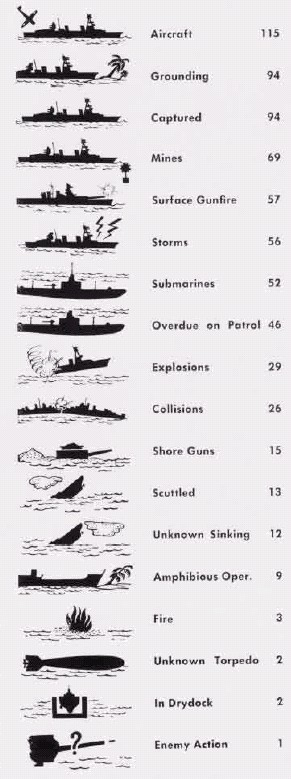
Grounding 94 + Storms 56 + Explosions 29 + Overdue on patrol 46 + Fire 3 + Unknown Sinking 12 = 240 ships!
PLANE LOSSES
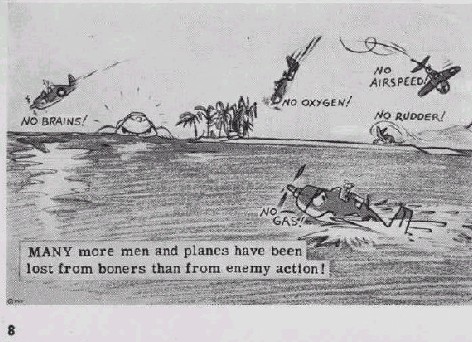
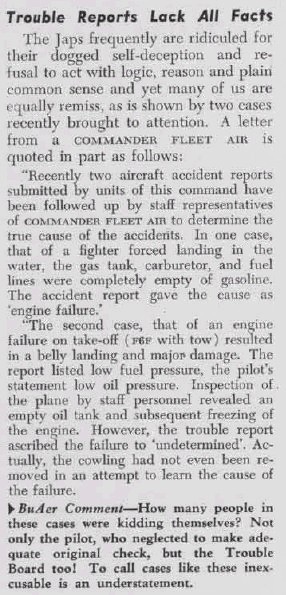
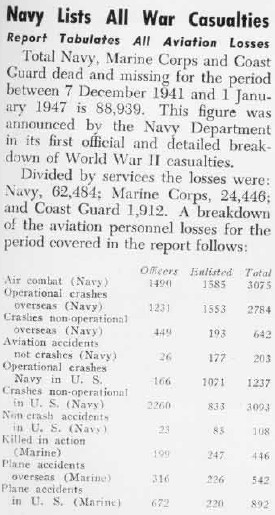
Non-Combat (TBATE)
Navy: 2, 784 + 642 + 203 + 1, 237 + 3, 093 + 108 = 8, 067 DEAD
Mc: 542 + 892 = 1, 434 DEAD
________________________________
TOTAL: 9, 501 DEAD
Combat (TBAM)
Navy: 3, 075
Mc: 446
________________________________
TOTAL: 3, 521 DEAD
So much for the "heroic" mythology from the USN/Mc propaganda machine....most men died due to incompetence caused pilot flying errors and/or equipment failures or simply "showboating" for ego. Typical example below:


Even when death is only a few seconds away by operating platforms in the air and sea, the military narcissistic mind is barely dented...the numbers of aviators showboating to peers and girlfriends trying to buzz them but ending up as flaming wrecks was such a problem in WW2, that the Navy told all their men that if they did such things and got themselves killed their loved ones would receive no death benefits. Read the U.S. Naval Aviation News magazines from 1942-1946:
NARCISSISM is the #1 PROBLEM IN THE U.S. MILITARY.
The last we checked, planet earth is still the same large size it was in WW2. So if we needed 102 aircraft carriers to get lots of planes over the water to stop submarines and protect from aircraft attacks, how in the hell do we think a mere 11 large-target carriers with at best 100 of these 800 aircraft, all slow moving, short-ranged ASW helicopters going to be able to stop today's submarines who are not only undetectable but do not even need to surface to recharge batteries and are as fast if not faster than surface ships, and their guided torpedoes are not likely to miss even if we see them coming and try to evade them with maneuvers and countermeasures? FYI, ashore we are down to under 100 P-3C Orion maritime patrol planes, when we had 5, 000 PBY Catalina and other type patrol planes in WW2! These deadly post-WW2 submarines have already been proven able to not only easily sink our large WW2 re-enactment ego carriers, but WIPE OUT ALL THEIR SURFACE SHIPS ESCORTING THEM. DefenseWatch naval warfare expert, Robert G. Williscroft writes:
www.argee.net/DefenseWatch/Is%20the%20Nuclear%20Submarine%20Really%20Invincible.htm
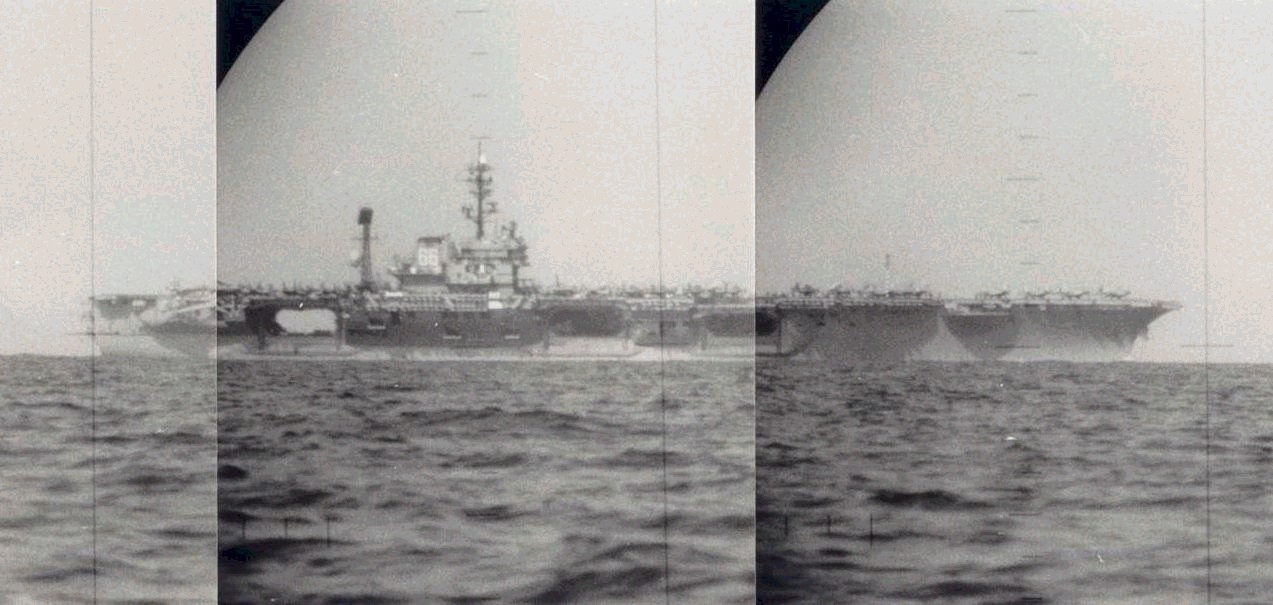
There is an old adage, however, that history is written by the victor. And history has taught us over and over again that overconfidence can lead to disastrous results.Here' s another alarming report on how Red China is getting ready to kick the U.S. Navy and marine corps' ass as they stupidly re-enact WW2 in a half-assed manner.How invincible is our submarine fleet? How good are our submerged sharks, our fleet of nuclear submarines that stands guard on the front lines, protecting our battle groups, shadowing potential missile launchers, and standing by to wreck havoc in the event of a shooting war?
The U.S. Navy has long relied upon exercises to measure itself against potential threats. These exercises usually pit one U.S. naval group against another, one submarine against another, or one or more submarines against one or more surface ships or even a battle group. Sometimes we join forces with our NATO allies to conduct more realistic exercises, going up against crews with different kinds of training and experience.
Of course, all these exercises are scripted in one way or another. They have to be in order to avoid collisions, to keep things safe and moving in the right direction, and to meet the exercise objectives. Scripting has its disadvantages, of course. For one thing, in a real war, the other side isn't following a script, at least not one we might know about. Thus, sometimes individual skippers will deviate from the script - sometimes on secret orders, and sometimes, just because over the years, these off-script events have produced surprising results - or maybe on hindsight, not-so-surprising results. Let's take a closer look.
Twenty-three years ago during the 1981 NATO exercise Ocean Venture, an unnamed 1960s vintage Canadian diesel submarine "sank" the carrier USS America without once being itself detected, and a second unidentified vintage sub "sank" the carrier USS Forrestal.
What did we learn from this?
Eight years later, during NATO exercise Northern Star, the Dutch diesel submarine Zwaardvis stalked and "sank" the USS Americaagain. Did the America just have problems? Well, in RIMPAC 1996, the Chilean diesel submarine Simpson "sank" the carrier USS Independence, and in 1999 during NATO exercise JTFEX/TMDI99, Dutch diesel submarine Walrus not only "sank" the carrier USS Theodore Roosevelt, but also "took out" the American exercise command ship USS Mount Whitney, plus a cruiser, several destroyers and frigates, and the nuke fast attack USS Boise - all without herself receiving a scratch.
Then, during RIMPAC 2000, the Australian Collins Class diesel sub HMAS Waller "sank" two American nuke fast attacks and got dangerously close to the carrier USS Abraham Lincoln. During Operation Tandem Thrust in 2001, HMAS Waller "sank" two American amphibious assault ships in waters between 200 to 350 feet deep, barely more than the length of the submarine itself, and an unnamed Chilean diesel sub "took out" nuclear fast attack sub USS Montpelier twice during successive exercise runs. A year later in October 2002, HMAS Sheehan successfully hunted down and "killed" the U.S. fast attack USS Olympia during exercises near Hawaii, and just a year ago in September 2003, in an unnamed (read "classified") exercise, several Collins Class subs "sank" two U.S. fast attack subs and a carrier - all unnamed, of course. And a month later another Collins Class sub surprised and "sank" an American fast attack during another exercise.
Oops!
What's going on here? How is it possible for "ancient," diesel powered "surface-bound" submarines to take on and defeat the best-trained, best-equipped sailors driving the most advanced ships and submarines in the world?
Diesel submarines operating on batteries are quiet. They're small and maneuverable, and they carry the same detection equipment and armament as their nuke big brothers. Their only disadvantage is their limited submerged time. And as the above narrative reveals, even this disadvantage does not seem to matter very much. In 2001, the Waller eventually was herself "sunk," but the trade was one "insignificant" diesel sub in exchange for two large amphibious assault ships. If you must keep score, this is how to do it.
In earlier articles ("Tomorrow's Submarine Fleet - The Non-nuclear Option," DefenseWatch, Feb. 6, 2002 , and "The Wrong Sub for New Warfare Era", DefenseWatch, Sep. 20, 2004 ), I discussed the concept of the Air Independent Propulsion (AIP) submarine, and its role in modern warfare. Seen in light of the poor performance of our nuclear submarines against modern diesel subs, one can only imagine what would happen if they came up against AIP subs - subs that have eliminated the only "disadvantage" of modern diesels against modern nukes.
When you add to the equation that you can build eight comparably equipped AIP submarines for what it costs to build one otherwise equivalent nuke, one can only ask: What in hell are we doing?
If we don't solve this conundrum with alacrity, AIP David is going to kick Goliath's nuke butt right to Neptune 's doorstep the next time it really matters.
(Thanks to Prof. Roger Thompson of Knightsbridge University for his in-depth research into the performance of the U.S. Nuclear Navy against "inferior" non-nuclear submarines in exercises around the world.)
CHINA: THE PLA NAVY'S DEVELOPING STRATEGY
By Bernard D. Cole
From China Brief, October 25, 2006
The Jamestown Foundation, Washington, DC.
China is now deploying the fruits of a dedicated effort to build a new navy, one capable of confronting modern maritime opponents, especially Taiwan, Japan and the United States. While the People's Liberation Army Navy (PLAN) is modernizing in almost all areas, it has placed an emphasis on developing its submarine force. If the PLAN is ordered into action against Taiwan, it has evidently decided that submarines are the most effective platforms both to isolate the island by blockade or quarantine, and also as the most effective way to deter, and if necessary delay and even defeat, U.S. naval intervention on Taiwan's behalf.
The first of these goals-deterrence-does not seem to be a viable objective for Beijing, since U.S. administrations-whether Democratic or Republican-have uniformly insisted that the China-Taiwan imbroglio must be resolved peacefully. While the Taiwan Relations Act (TRA) of 1979 does not formally commit the United States to intervene militarily on Taiwan's behalf, just such a commitment was signalled by President William Clinton's dispatch of two aircraft carrier battle groups to the scene in the spring of 1996, in response to Beijing's aggressive missiles tests and military exercises.
The second of these objectives-delaying intervening naval forces-is a more likely accomplishment, as China's already formidable submarine force continues to modernize. This process includes the replacement or augmentation of old Romeo and Ming-class conventionally powered submarines by much more capable Song- and Kilo-class boats, the first indigenously produced and the second purchased from Russia. This dual acquisition program is the result of both China's increasing foreign reserves and improved capability of the nation's defense industry to produce modern weapons systems.
The Modernizing Navy
The PLAN is also renewing its small force of nuclear powered submarines (SSN); the five boats of the old Han-class are being augmented and will likely be replaced by the newly constructed Type 093-class SSN. The first of these is already operational and at least one more has been launched. China's past failure to deploy an effective nuclear ballistic missile submarine (SSBN) will soon change with the deployment of the Type 094 Jin-class SSBN currently under construction. At least one of these has been launched; while the final number to be built is unknown, at least three will probably be constructed [1].
The next likely step in the development of China's submarine force will be incorporation of an Air Independent Propulsion (AIP) system into some of its boats. An AIP system enables a conventionally powered submarine to remain submerged for up to 40 days (at slow speed) instead of the usual four days before snorkelling is required for the diesel engine to recharge its batteries. This technology significantly increases the threat posed by a conventionally powered submarine, while avoiding the expense of nuclear powered construction.
China is also modernizing its force of surface warships. The current fleet of approximately two dozen relatively modern guided missile-equipped frigates and destroyers are all powered by modern engineering plants and are equipped with potent surface-to-surface cruise missiles. This force remains significantly limited, however, in the crucial areas of anti-submarine (ASW) and anti-air (AAW) warfare. It is only since the 2004 commissioning of three new classes of destroyers-the Luyang I, the Luyang II and the Luhai-that the PLAN seems to have deployed ships capable of "area AAW" [2]. This important capability enables a single ship to provide anti-aircraft defence not just for itself, but also for a formation of ships. This capability is crucial to fleet operations at sea, whether against a U.S. naval task force or for escorting an amphibious task force against Taiwan.
Limitations Remain
Beijing has also made a significant investment in its amphibious lift capability during the past five years. This process has not produced a dramatically more capable force, however, in terms of the ability to transport multiple divisions across even the Taiwan Strait to conduct an opposed landing. Another remaining PLAN limitation is in mine warfare. The Chinese navy's relatively old minesweepers have only recently begun exercising with late 20th century mine hunting and clearance systems. The PLAN's mine laying capability is more formidable, however, and this could serve as a powerful tool in a maritime campaign against Taiwan.
China's naval aviation capability remains the PLAN's least capable warfare community. Yet this is not a significant weakness given the proximity of Taiwan to the Chinese Air Force's (PLAAF) many mainland bases, and the increasing integration of naval and air force aviation. Hence, it is understandable that while the PLAN continues to expand its ship-borne helicopter capabilities, its shore-based fighter and attack air assets remain limited. More serious for China's maritime power, and not compensated for by the PLAAF, is the PLAN's very limited airborne ASW and reconnaissance capability.
A new Maritime Strategy?
Beijing has been developing a new maritime strategy to guide the employment of the navy it is now putting to sea. When it was established in April 1949, the PLAN was assigned specific "primary missions" to "independently or jointly with the Army and Air Force, guard against enemy invasion from the sea, defend the state's sovereignty over its territorial waters, and safeguard the state's maritime rights and interests" [3].
While these missions remain applicable a half-century later, the 2004 Defense White Paper acknowledged a shift from China's traditional focus on ground forces when it stated that "the PLA gives priority to the building of the Navy, Air Force and Second Artillery Force to seek balanced development of the combat force structure, in order to strengthen the capabilities for winning both command of the sea and command of the air, and conducting strategic counter-strikes" [4].
In the maritime arena, the 2004 White Paper reiterated the navy's responsibility "for safeguarding China's maritime security and maintaining the sovereignty of its territorial seas along with its maritime rights and interests." It went on to emphasize the importance of conducting operations well offshore, timely "preparation for [the] maritime battlefield," enhanced "integrated combat capabilities" and the ability to conduct "nuclear counter-attacks." It further charged the PLAN with the importance of "building maritime combat forces, especially amphibious combat forces...[and] updating its weaponry and equipment," to include "long-range precision strike capability...joint exercises...and integrated maritime support capabilities" [5].
These missions are not unusual for modern naval forces, but certain conditions point the missions in specific directions for the PLAN. First and foremost are the issues raised by Taiwan. China's naval modernization during the past 15 years, and especially since the Taiwan Strait crisis of 1995-1996, has clearly been focused on preparing for a possible armed conflict over the island's status, a conflict that would almost certainly feature a maritime scenario. This contingency has provided the basic rationale for the ongoing naval modernization programs that, while striking in terms of capability, have been moderate in terms of pace and priority.
The key question for the continuing development of maritime strategy in China is "What beyond Taiwan?" That is, what will guide the employment of the PLAN following resolution of the Taiwan issue? A likely strategy will emphasize classic command of the sea, defined as the naval ability to defend vital national maritime interests.
Second only to Taiwan is Beijing's concern with future Japanese actions, especially over China's sovereignty claims in the East China Sea. This concern ties directly to a more general and increasing worry about securing the sea lines of communication (SLOCs) upon which increasing amounts of China's imported energy resources depend. SLOC defense-coastal, regional, inter-regional, global-remains ill defined for the PLAN. Focusing its maritime strategy on SLOC defense will require addressing several significant factors. First, Beijing would have to delineate a threat justifying such a strategy; current piracy and terrorism issues do not qualify. Second, the U.S. and other navies currently maintain free navigation on the high seas; a Chinese decision that PLAN efforts in non-coastal waters are required for SLOC defense would mean Beijing's loss of faith in the present international maritime regime. Finally, China would have to alter national economic development priorities to allocate the extensive resources required to build a navy even partially capable of defending China's very long SLOCs to Southwest Asia and the Middle East. The scope that such an effort would require is indicated by the difficulty of protecting the North Atlantic SLOCs during World War I and II. Hence, national priorities pose major issues with which the Chinese government would have to solve, before embarking on a massive PLAN expansion program.
Also affecting maritime strategic development in China is its history as primarily a continental nation. Despite its long coastline of over 14,000 kilometers and more than 5,000 islands, China's view of national security threats has almost always focused on continental rather than maritime dangers. Furthermore, the PLA remains dominated by the army, with the navy apparently able to exert influence in intra-service debates only as strong as specific maritime-associated national interests are able to justify. China's leaders are well aware of maritime interests as vital elements in their nation's economic health and their own political legitimacy, but China's priority for SLOC defense, especially concerns for the security of its overseas energy supplies, does not dominate its national security policy process. Current PLAN modernization is fueled more by increased national revenues than by a general reordering of military budgeting priorities.
China's modernizing navy is already capable of carrying out many missions in defense of maritime security interests, including those involved inTaiwan's status. While it certainly poses a thought-provoking challenge to possible U.S. naval intervention in such a scenario, the PLAN is not yet able to pose a significant threat to open-ocean naval operations by the U.S., Japanese or Indian navies, either in the East China Sea or over the long SLOCs that run from the Indian Ocean to the Middle East. Hence, China's maritime strategy is very much a work in progress, with its most likely direction to be an expanded view of post-Taiwan missions involving the high seas of the Pacific and Indian Oceans.
Notes
1. Bernard D. Cole, The Great Wall at Sea: China's Navy Enters the Twenty-First Century (Annapolis, MD: Naval Institute Press, 2001), p. 98, 185. According to standard SSBN operational doctrine and the minimal standards for an effective deterrence, one boat would be kept at sea at all times with a second in maintenance and a third in training.
2. For more information on the Luyang I/II and Luhai class DDGs, see: www.globalsecurity.org/military/world/china/luhai.htm;
3. http://english.peopledaily.com.cn/data/organs/pla.shtml.
4. http://english.gov.cn/official/2005-07/28/content_18078.htm. 5. Ibid.
CHICOM submarine mugs the USS KittyHawk off coast of Okinawa: U.S. Navy not taking submarine threat seriously has retired ASW aircraft
Short-range ASW helicopters are NOT enough to deter submarine attack. We retired the carrier-based long-range S-3 Viking fixed-wing planes leaving our 11 x large aircraft carriers and ALL OTHER SURFACE SHIPS fatally vulnerable to submarine attack. Our land-based P-3C Orion long-range fixed-wing aircraft are worn out and numbers dwindling.
IF we are going to survive on the surface of the water, we need a LOT OF ASW AIRCRAFT this means ASW seaplanes on every surface ship, MORE long-range ASW planes, and A LOT OF CARGO SHIPS CONVERTED INTO ESCORT CARRIERS.
In WW2, FDR had to ORDER the navy to use cargo ship escort carriers to win WW2 against the German U-Boats and Japanese subs. Our admirals are in love with a few large status-symbol aircraft carriers and have neglected the aircraft operating from them to boot instead of the less glamorous things needed to prevail against not just submarines, but anti-ship missiles and air attacks as well.
www.washtimes.com/national/20061113-121539-3317r.htm
China sub stalked U.S. fleet
By Bill Gertz
THE WASHINGTON TIMES
November 13, 2006
A Chinese submarine stalked a U.S. aircraft carrier battle group in the Pacific last month and surfaced within firing range of its torpedoes and missiles before being detected, The Washington Times has learned.
The surprise encounter highlights China's continuing efforts to prepare for a future conflict with the U.S., despite Pentagon efforts to try to boost relations with Beijing's communist-ruled military.
The submarine encounter with the USS Kitty Hawk and its accompanying warships also is an embarrassment to the commander of U.S. forces in the Pacific, Adm. William J. Fallon, who is engaged in an ambitious military exchange program with China aimed at improving relations between the two nations' militaries.
Disclosure of the incident comes as Adm. Gary Roughead, commander of the U.S. Navy's Pacific Fleet, is making his first visit to China. The four-star admiral was scheduled to meet senior Chinese military leaders during the weeklong visit, which began over the weekend.
According to the defense officials, the Chinese Song-class diesel-powered attack submarine shadowed the Kitty Hawk undetected and surfaced within five miles of the carrier Oct. 26.
The surfaced submarine was spotted by a "routine" surveillance flight by one of the carrier group's planes. The Kitty Hawk battle group includes an attack submarine and anti-submarine helicopters that are charged with protecting the warships from submarine attack.
According to the officials, the submarine is equipped with Russian-made wake-homing torpedoes and anti-ship cruise missiles. The Kitty Hawk and several other warships were deployed in ocean waters near Okinawa at the time, as part of a "routine" fall deployment program. The officials said Chinese submarines rarely have operated in deep water far from Chinese shores or shadowed U.S. vessels.
A Pacific Command spokesman declined to comment on the incident, saying details were classified. Pentagon spokesmen also declined to comment.
The incident is a setback for the aggressive U.S.-China military exchange program being promoted by Adm. Fallon, who has made several visits to China in recent months in an attempt to develop closer ties. [EDITOR: you mean their torpedoes slamming into our warship hulls?]
However, critics of the program in the Pentagon say China has not reciprocated and continues to deny U.S. military visitors access to key facilities, including a Beijing command center.
In contrast, Chinese military visitors have been invited to military exercises and sensitive U.S. facilities. Additionally, military intelligence officials said Adm. Fallon has restricted U.S. intelligence-gathering activities against China, fearing that disclosure of the activities would upset relations with Beijing.
The restrictions are hindering efforts to know more about China's military buildup, the officials said. "This is a harbinger of a stronger Chinese reaction to America's military presence in East Asia," said Richard Fisher, a Chinese military specialist with the International Assessment and Strategy Center, who called the submarine incident alarming.
"Given the long range of new Chinese sub-launched anti-ship missiles and those purchased from Russia, this incident is very serious," he said. "It will likely happen again, only because Chinese submarine captains of 40 to 50 new modern submarines entering their navy will want to test their mettle against the 7th Fleet."
Pentagon intelligence officials say China's military buildup in recent years has produced large numbers of submarines and surface ships, seeking to control larger portions of international waters in Asia, a move U.S. officials fear could restrict the flow of oil from the Middle East to Asia in the future.
Between 2002 and last year, China built 14 new submarines, including new Song-class vessels and several other types, both diesel- and nuclear-powered.
Since 1996, when the United States dispatched two aircraft carrier battle groups to waters near Taiwan in a show of force, Beijing also has bought and built weapons designed specifically to attack U.S. aircraft carriers and other warships. "The Chinese have made it clear that they understand the importance of the submarine in any kind of offensive or defensive strategy to deal with a military conflict," an intelligence official said recently.
In late 2004, China dispatched a Han-class submarine to waters near Guam, Taiwan and Japan. Japan's military went on emergency alert after the submarine surfaced in Japanese waters.
Beijing apologized for the incursion. The Pentagon's latest annual report on Chinese military power stated that China is investing heavily in weapons designed "to interdict, at long ranges, aircraft carrier and expeditionary strike groups that might deploy to the western Pacific."
It could not be learned whether the U.S. government lodged a protest with China's government over the incident or otherwise raised the matter in official channels.
The advances being made by the Chinese should be used as reasons to totally reform our Navy/Mc but will instead be used to justify their continued racketeering for crap.
Washington Times
March 2, 2007
Pg. 1China Expands Sub Fleet
Military buildup includes nuclear-missile boats
By Bill Gertz, Washington Times
China's military is engaged in a major buildup of submarines that includes five new strategic nuclear-missile boats and several advanced nuclear-powered attack submarines, according to the Office of Naval Intelligence.
The new nuclear-powered missile submarines (SSBNs), identified as Type 094s, will be outfitted with new 5,000-mile range JL-2 missiles that "will provide China with a modern and robust sea-based nuclear deterrent force," the ONI stated in report made up of written answers to questions on the Chinese submarine buildup.
The ONI report was first disclosed to Sea Power magazine, and a copy was obtained by The Washington Times. It was the first time the Pentagon has identified the number of new Chinese strategic submarines under construction.
The five new missile submarines will "provide more redundancy and capacity for a near-continuous at-sea SSBN presence," the ONI said, which noted that sea trials for some of the submarines are under way and the first deployments could begin as early as next year.
The buildup is raising new concerns among senior Pentagon planners already worried by Beijing's broader strategic nuclear-forces buildup, which also includes several new long-range land-based nuclear missiles and a land-attack cruise missile similar to the Tomahawk.
"This is a troubling development," Richard Fisher, a specialist on the Chinese military with the private International Assessment and Strategy Center, said of the submarine buildup.
The five missile submarines, each equipped with 12 x JL-2 missiles, shows that China is working to achieve a force of 120 long-range nuclear missiles over the next decade, about half of them to be carried on the submarines, Mr. Fisher said. The other half would be the 60 land-based DF-31 missiles that current deployment rates will give China by then, he said.
The 120 missiles also could have multiple-warheads, since China is known to have acquired all the needed technology from the U.S. during the 1990s.
Retired Vice Adm. Michael McConnell, commenting at a Senate Armed Services Committee hearing on Tuesday, said China's nuclear missiles pose a threat.
"It's a matter of they're building their military, in my view, to reach some state of parity with the United States," said Mr. McConnell, the new director of national intelligence. "So they're a threat today, they would become an increasing threat over time."
Little is known about China's nuclear forces and efforts by Pentagon officials to engage Chinese military leaders about their strategic weapons and forces has not been successful. China's government has insisted its current modernization is part of a peaceful development, but the contrasting strategic nuclear-forces buildup is worrying, defense officials said.
Chinese Gen. Zhu Chenghu told reporters in 2005 that China would attack U.S. cities with nuclear weapons in response to any conventionally armed U.S. missile strikes against China during a conflict over Taiwan. Years earlier, Gen. Xiong Guangkai threatened to use nuclear weapons against Los Angeles if the U.S. helped Taiwan defend against a Chinese invasion of the island.
The missile-submarine buildup would provide Beijing with a major upgrade on current capabilities. In 1983, China built one Xia-class nuclear-powered ballistic missile submarine, reportedly with 12 1,000-mile range JL-1 missiles. But that solitary submarine has only twice test-fired its missiles and never ventured beyond China's regional waters.
"Although the range of the JL-1 limits the Xia's utility as a deterrent platform, targets throughout the region, including U.S. military facilities, could be targeted with the JL-1 from launch points inside traditional Chinese navy operating areas," the ONI said.
On China's new attack submarine, the ONI stated that China already has launched and is performing sea trials on an unspecified number of Type 093 nuclear-powered attack submarines. Published reports in China have said two Type 093 attack submarines are deployed and use "foreign technologies" and advanced anti-ship missiles and torpedoes.
The new advances are part of China's efforts to bolster its anti-ship weapons to permit strikes at greater ranges from the Chinese coast than its current diesel-powered submarine force offers, the ONI said. China currently is upgrading its current force of about 55 attack submarines -- most of them easy-to-track diesel boats -- with more-advanced and harder-to-track vessels, including Russian-made Kilos, and its own Song- and Yuan-class submarines.
"Each of these submarine classes, which are quiet platforms with anti-ship cruise missiles, is an integral part of China's regional anti-access strategy," ONI said. "The quieting incorporated into these submarines is required for successful operations in the open ocean operating areas which could facilitate the [Chinese navy's] wartime mission of keeping enemy combatants outside of strike range of the theater of operation."
A Song-class submarine surfaced undetected within five miles, well within firing range, of the aircraft carrier USS Kitty Hawk in October.
The ONI stated that China's maritime strategy is focused on blocking U.S. or Japanese intervention in a future conflict over Taiwan. To that end, Beijing has begun equipping its medium- and short-range ballistic missiles based on shore, hundreds of which are deployed across the Taiwan Strait from the island that the communist regime views as a renegade province, with maneuvering warheads.
These radar-guided or heat-seeking weapons "provide the accuracy necessary to attack a ship at sea," ONI said.
But China's rise in international trade and commerce, plus its growing dependence on imported foreign oil, also has expanded Beijing's maritime strategy from a mostly submarine force to one of building surface ships to "defend sea lines of communication" (SLOCs), because protecting sea-lanes with submarines is difficult.
ONI also said that in addition to new destroyers, "by 2020, China is likely to operate an aircraft carrier, the initial unit of which may be the refurbished ex-Varyag, acquired from Ukraine in 2000, to further support SLOC protection."
www.opinioneditorials.com/guestcontributors/mburleson_20070619.html
An All-Submarine NavyMike Burleson
June 19, 2007Last week, the third in a new class of "underwater battleships", the USS Michigan, joined the fleet after a $1 billion face lift. The 4 converted subs of the Ohio class, former Trident missile ships, are the undersea equivalent of the reborn Iowa class from the 1980's. Armed with over 150 Tomahawk cruise missiles, plus the ability to carry Special Forces and unmanned vehicles, they give the Navy an incredible ability to strike decisively from the sea.
I am of the opinion that in full-scale shooting war at sea, the U.S. surface navy will be devastated in the first day, by the combination of cruise missiles and stealthy submarines. The survivors would all be forced into port, unable to participate in the counterattack, which would likely be initiated by our own deadly nuclear attack submarines.
What this means is, our current force of colossal and pricey warships including aircraft carriers, cruisers, destroyers, and amphibious ships are obsolete in today's precision, push-button warfare. They are also tremendously expensive to build and operate, with only the richest of earth's superpowers able to afford them in ever declining numbers. If this wasn't reason enough for maritime nations to reevaluate their shipbuilding priorities, there are few if any jobs the surface fleet can do which the submarine cannot. I'll elaborate:
Command of the Sea
Submariners say there are only 2 types of ships: submarines and targets. There are valid reasons for this. Since World War 2 anti-submarine defenses have failed to match the attack boat's advancements in speed, stealth, and weaponry. For instance, since 1945 the average speed of destroyers has remained at 30 knots, with only nuclear vessels able to maintain this rate for any period. In contrast, the velocity of nuclear attack submarines, beginning with the launch of USS Nautilus in 1954, has tripled and quadrupled from around 10 knots submerged to 30-40 knots.
Also, an anti-submarine vessel must get within a few miles of an enemy sub to fire its rockets or torpedoes. Its only long-range defense, the helicopter, is slow and must linger in a vulnerable hover while its sonar buoys seek out their prey. Some Russian-built boats come equipped with anti-aircraft missiles which make this standard ASW tactic suicidal.
In contrast, a modern submarine can launch its missiles from 75 miles away and farther. Should it choose to close the distance, as occurred when a Chinese Song class stalked the USS Kitty Hawk last year, to fire its ship killing torpedoes, it can do so at speeds as fast as and sometimes surpassing surface warships. Whether attacking with cruise missiles or wake-homing torpedoes the attack boat remains submerged; the preeminent stealth vessel.
The sub has likely held this dominate position on the high seas, since the dawn of the first nuke ships beginning in the 1950's. The only lacking factor has been a full-scale naval war to prove it. The single example is the sinking of the Argentine cruiser Belgrano 25 years ago by the British submarine HMS Conqueror in the Falklands Conflict. Afterward, the Argentine Navy fled to port and remained there!
Commerce Raiding/Protection:
This traditional role of the submarine is one which it excelled in the last century. The difference today is, neither America nor Britain has the capability to mass produce the thousands of anti-submarine escorts which just barely defeated Germany's U-boats in 2 world wars, even if it would matter. In the next war at sea, the submarine would bring all commerce to a halt, making a mockery of the globalized free market system. The only counter to this menace is perhaps a combination of aircraft and submarine escorts, with the latter acting as the destroyer, shepherding its convoy through the "shark" ridden waters.
Amphibious Assault
Admittedly, this is not a role in which the submarine excels at, with its sparse crew and cargo capacity. Where they do stand out is the ability to land small raiding parties, like the elite Navy SEALs, and underwater demolition teams in preparation for a full-scale assault.
Still, with the submarine maintaining command of the seas, it would allow a surface amphibious task force free reign against an enemy beachhead. Rather than requiring expensive standing amphibs, reserve vessels could be maintained on both our coasts, with a cadre crew ready for any emergency. Some could also be rapidly converted with landing strips for heloes or whatever air assets are needed. Some small and inexpensive littoral ships fitted with cannon could provide escort close to shore.
For standard peacekeeping operations, some large subs could be built or converted for troop carrying, as in the above mentioned Michigan. The ex-ballistic missile warship and her three sisters can load up to 66 SEALs, or more, I imagine, in a pinch, plus their equipment.
Conclusion
If America were to suddenly lose her preeminent surface fleet of carrier groups in such a future conflict, she would still have an excellent and capable submarine force to carry the fight to the enemy. The Navy says it must build 2 boats per year to maintain 50 in commission. Perhaps a doubling or tripling of this number would be necessary to replace the surface ships in the manner I propose. A fleet of 100-150 nuke submarines would be far cheaper to maintain, but also doubtless give the USN an unmatched mastery at sea for the rest of the century.
The "Tin Can" U.S. Navy: everyone vulnerable for the sake of the almighty large aircraft carrier--THERE CAN ONLY BE ONE EGO PLATFORM!!!
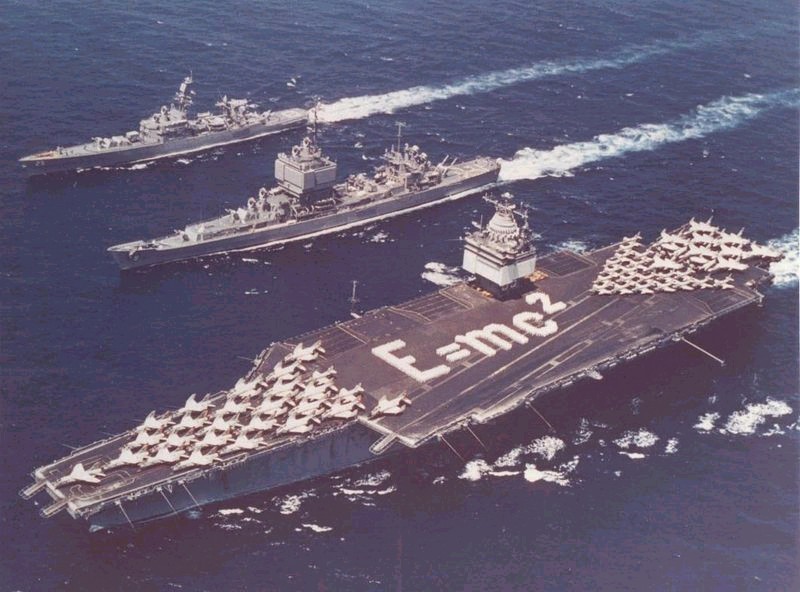
Operation "Sea Orbit" - On July 31, 1964, USS Enterprise (CVAN-65) (bottom), USS Long Beach (CGN-9) (center) and USS Bainbridge (DLGN-25) (top) formed "Task Force One", the first nuclear-powered Task Force, and were sent on a 30,565-mile, 65-day voyage around the world, reminiscent of that of the 16 battleships of the "Great White Fleet" in 1907-09. Accomplished without a single refueling or replenishment, Operation "Sea Orbit" demonstrated the capability of nuclear-powered surface ships to operate in remote areas at high speeds without logistic support.
Source: U.S. Navy promotional photo: www.navsource.org/archives/02/026522.jpg
Here is the critical juncture: 1960.
We could have continued with seaplanes finally perfected but didn't.
We could have continued with LTA airships, but didn't.
We could have continued with HEAVILY ARMORED surface ships POWERED BY NUCLEAR REACTORS so this weight would NOT be a drag on mobility....but didn't!
Ever since the nuclear-powered, armored USS Long Beach in 1960 all the USN has built has been BS vulnerable tin can destroyers....I surmise the brass realized that if cruisers and destroyers were nuclear powered and heavily armored they would be gulp.......CAPITAL SHIPS....ships that can fight at times independantly...oh shit!! We can't have that!!!
THERE CAN ONLY BE ONE CAPITAL SHIP EGO PLATFORM IN THE U.S. NAVY AND IT IS THE SUPERSIZED BLOATED AIRCRAFT CARRIER!!!
All the other ships must be LESSER and WEAKER and play a SUPPORT ROLE TO THE SUPERCARRIERS.
Got it?
The article below reveals ever since the Long Beach all the Navy has been making are tin can destroyers with the corresponding you-are-expendible all-firepower-no-armor mentality. Armor was absent from thin hull form destroyers to create SPEED; with NUCLEAR POWER you can have SPEED without sacrificing armor protection and even have a fat battleship hull form.
We need to fire all the gatekeepers and aircraft carrier assholes ruining our navy for years and get in a new team that wants a balanced excellent naval force not a floating version of the USAF only interested in land attack.
http://en.wikipedia.org/wiki/USS_Long_Beach_(CGN-9)
USS Long Beach (CGN-9)
From Wikipedia, the free encyclopedia
Jump to: navigation, searchCareer
Ordered: 15 October 1956
Laid down: 2 December 1957
Launched: 14 July 1959
Commissioned: 9 September 1961
Decommissioned: 1 May 1995
Struck: 1 May 1995
Fate: All superstructure removed: awaiting scrapping at the Bremerton, WA Shipyard
General Characteristics
Displacement: 15,540 tons
Length: 721 ft 3 in (220 m)
Beam: 71 ft 6 in (21.8 m)
Draft: 30 ft 7 in (9.3 m)
Propulsion: 2 C1W nuclear reactors; 2 General Electric turbines; 80,000 shp; 2 screws
Speed: 30 knots (56 km/h)
Range: Essentially unlimited
Complement: 1160 officers and men
Armament: 2 twin Terrier guided missile launchers
1 twin Talos guided missile launcher
1 8-tube ASROC launcher
2 × 5 in/38 (2 × 1)
2 × 12.75 in torpedo tubes (2 × 2)
Aircraft: None; landing pad for one helicopter
Motto: "Strike Hard, Strike Home"USS Long Beach (CLGN-160/CGN-160/CGN-9) was a guided missile cruiser in the United States Navy. She was the only ship of her class.
Long Beach was the first "all-new" cruiser designed and constructed after World War II (all others were completions or conversions of cruisers begun or completed during the war). She was the third Navy ship named after the city of Long Beach, California, and the last ship built on a traditional "cruiser hull" in the U.S. Navy; all subsequent cruisers were built on scaled-up destroyer hulls.
Contents
1 Configuration
2 Weapons suite
3 History
4 Milestones
5 Commanders
6 Unit Awards
7 See also
8 External linksConfiguration
The ship was designed as an "all-missile" ship from the very beginning, but was fitted with two 5 inch (127 mm) / 38 caliber gun mounts amidships at President John F. Kennedy's order. The space taken up by the 5 inch (127 mm) / 38 caliber mounts and the Anti-Submarine Rocket (ASROC) system was, at different times, slated for the Regulus nuclear cruise missile or, later, 4 launching tubes for the Polaris missile. Long Beach was also the last cruiser built on a traditional long, lean cruiser hull; later new-build cruisers were actually converted frigates (DLG/CG Leahy, Bainbridge, Belknap, Truxtun, and the California and Virginia classes) or uprated destroyers (DDG/CG Ticonderoga class).
The ship was propelled by two nuclear reactors, one for each propellor shaft, and was capable of speeds in excess of 30 knots (56 km/h). The high box-like superstructure contained the SCANFAR system, consisting of the AN/SPS-32 and AN/SPS-33 phased array radars, precursors of the AN/SPY-1 phased array systems lately installed on Aegis warships (Ticonderoga-class cruisers and Arleigh Burke-class destroyers). At the time, Long Beach had the highest bridge of any ship smaller than an aircraft carrier.
Weapons suite
The original weapons suite consisted of:
Talos Long Range Surface-to-Air Missiles (SAM) with a range in excess of 80 nautical miles (148 km).
Terrier Medium Range SAMs with a range in excess of 30 miles (48 km). Anti-Submarine Rocket (ASROC) system capable of delivering a torpedo or depth charge (nuclear capable) at a range of 10,000 yards (9.1 km).
Two twin 12.75 inch torpedo launchers that could fire Mk 46 torpedoes.
Two 5 inch (127 mm) 38 caliber single mounts, capable of surface and shore bombardment to a range of 18,000 yards (16.5 km).
The ship went through several modifications by time she was decommissioned. The final weapons suite consisted of:
Two forward launchers for the SM-2 extended range missiles. These replaced the Terrier.
The rear launcher for the Talos was replaced with 2 Tomahawk cruise missile box launchers. Each launcher held 4 missiles.
Two Phalanx CIWS were added to the rear of the ship.
Two Harpoon ship-to-ship missile launchers were added. Each launcher held 4 Harpoons.
History
Long Beach was originally ordered as CLGN-160. She was reclassified CGN-160 in early 1957, but was again reclassified as CGN-9 on 1 July 1957. Her keel was laid down on 2 December 1957 by Bethlehem Steel Co., Quincy, Massachusetts. She was launched 14 July 1959, sponsored by the wife of Craig Hosmer, Congressmen of California. She was commissioned on 9 September 1961, with Captain Eugene P. Wilkinson in command.
Long Beach served in the Atlantic Fleet from her commissioning in 1961 until completing her first refueling in early 1966, when the cruiser was transferred from the homeport of Norfolk, Virginia to Long Beach, California.
Operation "Sea Orbit" - USS Bainbridge, Long Beach, and Enterprise.
In May 1964, Long Beach joined the aircraft carrier Enterprise (CVN-65) and the guided missile frigate Bainbridge (DLGN-25) to form the all-nuclear-powered Task Force 1. At the end of July, the three warships began Operation Sea Orbit, a two-month unrefueled cruise around the World. It was the first all-nuclear battle formation in the history of naval operations.
In October 1966, the Long Beach deployed for the first of a number of cruises to the Western Pacific. During this initial cruise, the cruiser served primarily as the Positive Identification Radar Advisory Zone (PIRAZ) unit in the northern Gulf of Tonkin. As such, the main responsibilities of the ship were to "sanitize" returning U.S. air strikes to ensure that no enemy aircraft were attempting to evade identification by hiding amongst returning friendlies. Additionally, the ship provided support for an on-board Search and Rescue (SAR) helicopter unit. During this tour, the Long Beach was responsible for directing the downing of one Soviet-made An-2 "Colt" aircraft that was attempting to engage South Vietnamese naval units. The shoot-down was executed by an F-4 Phantom II fighter under the control of a Long Beach Air Intercept Controller (AIC). The cruiser returned to Long Beach, California, in July of 1967, and was redeployed to the Gulf of Tonkin in 1968, shooting down two MiG fighter planes with her RIM-8 Talos missiles.
After Vietnam the Long Beach performed routine duties in the Western Pacific and Indian Ocean, although in 1975 she served escort duties for an ad-hoc U.S. task force during the Mayagüez incident. In 1980 the vessel rescued 114 Vietnamese boat people off the coast of Vietnam. In 1979, and again from 1980 to 1983, the Long Beach returned to Puget Sound to undergo a mid-life conversion, during which time she was fitted with BGM-109 Tomahawk cruise missiles. The Long Beach deployed throughout the 1980s and provided support during the Gulf War of 1991.
The Long Beach was decommissioned on 1 May 1995, over 33 years after she had entered service, and is now awaiting recycling at Bremerton WA Shipyard.
Milestones
2 December 1957 - Keel laid in Bethlehem Steel Company's Fore River Shipyard, Quincy, Massachusetts.
14 July 1959 - launching; Mrs. Craig Hosmer christened the ship as her sponsor.
5 July 1961 - USS Long Beach underway for the first time using her own nuclear power.
9 September 1961 - USS Long Beach is commissioned as the first nuclear powered surface vessel at the Boston Naval Shipyard.
2 October 1961 - Change of Home port to Norfolk, Virginia.
1 August 1963 - 1st deployment to the Mediterranean
28 April 1964 - 2nd deployment to the Mediterranean for "Nuclear Task Force One".
15 March 1966 - USS Long Beach and City of Long Beach, California unite for first time.
7 November 1966 - 1st West Pac deployment.
1 May 1967 - Deployed to Gulf of Tonkin.
15 April 1968 - 2nd West Pac deployment.
11 August 1969 - 3rd West Pac deployment.
1 July 1970 - USS Long Beach begins refueling at Mare Island Naval Shipyard.
28 March 1972 - 4th West Pac deployment.
1 May 1973 - 5th West Pac deployment.
7 November 1974 - 6th West Pac deployment.
7 June 1975 - Change of homeport to San Diego, California.
15 September 1976 - 7th West Pac deployment.
4 April 1978 - 8th West Pac deployment.
7 January 1980 - 9th West Pac deployment.
1 January 1982 - Begins Comprehensive Overhaul Puget Sound Naval Shipyard.
13 January 1984 - 10th West Pac deployment.
9 January 1985 - Selected Restricted Availability at Bremerton, Washington.
13 May 1986 - 11th West Pac deployment.
25 July 1987 - 12th West Pac deployment.
13 October 1988 - North Atlantic Treaty Organization Ship Visit.
18 September 1989 - 13th West Pac deployment/world cruise.
28 May 1991 - 14th West Pac deployment in support of Operation Desert Storm.
8 April 1992 - Comprehensive overhaul, Puget Sound Naval Shipyard.
12 May 1993 - Underway Counter Narcotics Patrol, Central America.
8 November 1993 - Underway Counter Narcotics Patrol, Caribbean.
6 May 1994 - Change of homeport to Norfolk, Virginia.
Commanders
9 September 1961 - 11 September 1962: Captain Eugene P. Wilkinson
11 September 1962 - 23 August 1966: Captain F. H. Price
23 August 1966 - 15 June 1968: Captain K. C. Wallace
15 June 1968 - 25 September 1972: Captain William A. Spencer
24 October 1975: Captain F. R. Fahland
24 October 1975 - 18 July 1978: Captain Harry C. Schrader
18 July 1978 - February 1982: Captain E. B. Bossard
February 1982 - 1985: Captain F. Triggs
February 1985 - September 1987: Captain M. J. Weniger
September 1987 - November 1990: Captain J. C. Pollock, III
November 1990 - April 1993: Captain W. R. Burns, Jr.
April 1993 - July 1994: Captain K. P. BerstickerUnit Awards
Armed Forces Expeditionary Medal
01 September 1987 - 02 September 1987
20 September 1987 - 26 September 1987
29 September 1987 - 28 October 1987
30 October 1987 - 29 November 1987
17 January 1990 - 31 January 1990Combat Action Ribbon
26 April 1972
Humanitarian Service Medal
29 April 1980
01 May 1980Joint Meritorious Unit Award
16 October 1990 - 18 November 1990
10 June 1991 - 28 June 1991Meritorious Unit Commendation
19 November 1966 - 08 June 1967
10 April 1972 - 30 November 1972
Battle Efficiency Award
01 July 1977 - 31 December 1978
01 January 1985 - 30 June 1986
01 July 1986 - 31 December 1987
01 January 1988 - 30 June 1989
01 January 1991 - 31 December 1992
01 January 1993 - 31 December 1993Navy Unit Commendation
07 May 1968 - 20 October 1968
Coast Guard Special Operations Service Ribbon
15 November 1993
Southwest Asia Service Medal
06 July 1991 - 12 October 1991
Vietnam Service Medal
29 November 1966 - 06 January 1967
01 February 1967 - 01 March 1967
12 March 1967 - 07 April 1967
05 May 1967 - 13 June 1967
04 May 1968 - 11 June 1968
21 June 1968 - 11 July 1968
13 July 1968 - 07 August 1968
12 September 1968 - 23 October 1968
03 September 1969 - 11 October 1969
26 October 1969 - 04 December 1969
10 December 1969 - 12 December 1969
20 December 1969 - 22 December 1969
01 January 1970 - 25 January 1970
13 April 1972 - 23 June 1972
01 July 1972 - 31 July 1972
08 August 1972 - 06 September 1972
15 September 1972 - 16 October 1972
25 October 1972 - 22 November 1972See also
See USS Long Beach for other ships of the same name.
External links
Unofficial USS Long Beach webpage
DANFS: Long Beach (CGN-9)
navsource.org: USS Long Beach
The Long Beach in dry dock (via Google Maps)
Long Beach-class cruiser
Long Beach (CGN-9)List of cruisers of the United States Navy
U.S. Navy/marines are not better off in the air with AAW, either!
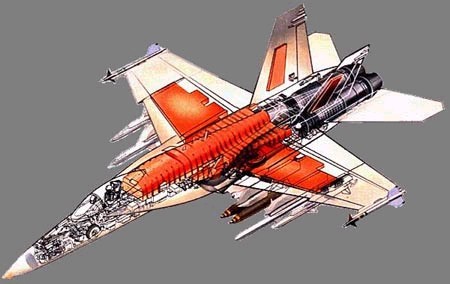 =
= 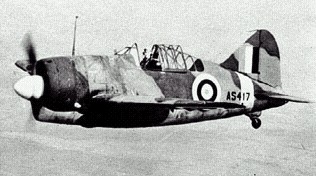
If this were not bad enough, how will at best 700 x F-18 aircraft, non of which has long-range AAMs, are overweight, under-powered and non-stealthy going to intercept and shoot down enemies with SU-27 type aircraft that fire beyond visual range radar guided missiles and heat seeker missiles simultaneously that will lock-on to our clearly visible planes and stay homing in on them as they take evasive action because their launch planes don't have to take evasive action? While our F-18 Brewster Buffalos are battling the enemy SU-27s, other enemy SU-27s or even anything that can fly and carry an ASM aloft plus shore ASM batteries will be sending hundreds if not THOUSANDS of kamikazes at high sub and supersonic speeds into our handful of aircraft carriers laden with fuel and ordnance. Its WW2 Okinawa all over again, except this time the USN has less ships to sink and the enemy MORE KAMIKAZES BY A FACTOR OF 1000x.
We could have unquenched enemy submarines attacking the American fleet that pompously ignores the need for ASW and is obsessed with LA, using carriers to try to out-bombard the USAF from a sea handicap for political gain at home for greater budgets from Congress. At the same time the enemy subs are attacking through our impotent ASW cruisers/destroyer outer screen, the enemy is attacking through our short-range air outer screen with hundreds if not thousands of ASMs from multiple directions. These are not unguided bombs and torpedoes from WW2. If they are homing, they are going to hit, if they hit they are going to KILL with their HE warheads against today's flimsy non-armored ships. What do you think is going to happen? I see thousands of unprepared men in the water like the USS Indianapolis fiasco in 1945 getting eaten by sharks and dying of exposure and thirst with no PBY Catalinas to find them or land and rescue them.
In the face of such increasingly dangerous guided HE threats, the unarmored partial WW2 re-enactment USN on the surface cannot survive as equipped and organized and will have to withdraw or be sunk. You could say, we got excellent submarines. So what? They might be able to get through the sea mine cordon around Taiwan to smash SOME of the Red Chinese invasion fleet of landing craft and amphibious light tanks, but they can't stop their Airborne forces in the air from landing. And after our attack subs leave after using up all of their at best hundreds of torpedoes, the THOUSANDS of CHICOM landing craft/tanks will continue on towards Taiwan to link up with their paratroopers and win the conflict. Isolated, running out of food and oil, under constant enemy HE missile attack, refugees fleeing to the mountains, Air force wiped out, Navy sunk, Army unable to repel the CHICOMS from the beaches, what do you think the Taiwanese government's civilian leaders options available will be? Can American minesweepers exposed and undefended by any friendly fixed-wing aircraft on the surface be able to break even the seamine blockade around Taiwan?
Because the surface navy fucked up and failed to do its part, our submarines will be powerless to stop the enemy's AIRCRAFT and ASMs from sinking the cargo ships a Taiwan that needs them to not starve from being sunk. Unlike Britain, the supplies will not get through and like Corregidor/Singapore the people there will have to surrender to the enemy but this time in the millions. We have you see, experienced this kind of self-created naval defeat before, we just refuse to LEARN from it, so we get to relive it again and again until our arrogance and hubris goes away replaced by smart humility.
We lost 11 aircraft carriers in WW2.
That's ALL we have today.
In WW2, we built in 4 years nearly 200 aircraft carriers or 50 aircraft carriers a year. Today, we build ZERO aircraft carriers in a year. We build ZERO aircraft carriers in two years. We build ZERO aircraft carriers in three years. We build ZERO aircraft carriers in four years. In five years---because the U.S. Navy insists that's the only kind of carrier THEY are willing to operate--a super large aircraft carrier---we will have built 1 x $5 BILLION large aircraft carrier. We build 1 aircraft carrier in 5 years. We are 250x times WEAKER industrially than we were in WW2. In a modern guided missile war, the whole conflict will be over in as soon as 5 HOURS or at the most 5 WEEKS.
If we lose our 11 aircraft carriers, there will be no replacements in time for the war.
There will not even be time to take a retired carrier from mothballs or from a museum and get it into action. We win or lose with what we got on hand, and once the carriers are gone, unlike the WW2 battleships/cruisers/destroyers THEY HAVE NO FIXED-WING AIRCRAFT CAPABILITY to defend themselves. There will be no air cover, it will be HMS Repulse and Prince of Wales all over again. The USN will have to withdraw or be sunk. We lose.
SUMMARY
1. We would have defeated the Japanese Navy even if they had large aircraft carriers and we had none by our undeterred sub/patrol plane combination sinking them and our battleships/cruisers/destroyers at least holding their own with their own catapult-launched improved seaplane fighters. The key overmatch here was our submarine/patrol plane combo was not countered by the Japanese with any effective ASW formula. Their carriers with no American carriers to sink could gallivant around the Pacific looking to sink our battleships/cruisers/destroyers and would just end up running right into our PBY large patrol seaplanes and submarines. What our submarines wouldn't sink, our surface ship small seaplanes would at least degrade if not sink and our surface ship gunnery would likely overmatch the IJN's giving the Tshushima sequel Yamamoto wanted but without the happy-for-Japan ending. The whole reason to exist for the IJN was wrongly to duel the American Navy which would achieve nothing even if superficially seemed successful as the Pearl Harbor surprise attack showed, when it should have been focused on using naval forces to enable their ground forces to take and keep land by insuring their supply ships got through by ASW and ours didn't by their own submarines. The IJN has the same egocentric Mahan disease as the USN has today, that the Navy exists for the sake of the Navy; to sail around the world and have a good time in port from comfortable capital ships full of petty floating garrison rigmarole (snobby RHIP BS).
2. We could have continued with land offensives in 1942 and beyond even without our own large carriers because our submarines were destroying the supplies of the Japanese ground troops we were facing with our own ground forces. Our supplies would have continued to get through by an IJN obsessed with dueling other naval combatants or even if they did wake up and started to attack our logistics, they would have sailed right into submarine, PT boat and battleship/cruiser/destroyer ambushes all within land aircraft air cover range... In other words the land we held defensively even though we were offensively taking it from the Japanese ground troops, would act as the land-based aircraft carrier...or should I say what an aircraft carrier is, is a piss-poor floating runway or a floating airfield. Me thinks we got this all backwards. Throw in some fighter seaplanes from our B/C/Ds for air cover and you get an even stronger synergism.
And this is exactly what most DEFENSIVE navies in the world do; they stay close to home and stay under their land-based air cover and do not need floating air bases, they use land air bases.
3. At the end of WW2 the snobby and greedy U.S. Navy downsized into a few large ego-gratifying "supercarriers" too large to move through the Panama Canal and packed with more fuel than ever before to operate fighter-bomber "lawn darts" to do land attack in competition with the USAF. Cruiser/battleship shore bombardment was marginalized by robbing them of seaplane spotter aircraft and when that wasn't enough, retirement. The vulnerability of these fuel-laden jet aircraft and their huge target ships has yet to be exploited by an enemy but a few accidents during the Vietnam war turned the flight deck into an inferno knocking the carrier out of action. A determined enemy attack will surely sink the supercarriers.
A Supercarrier U.S. Navy is not a balanced Force
Navy/marine Mission 1947

Navy/marine Missions, 2006
Bloated aircraft = bloated super carriers = earth not covered = fewer targets for enemy = disaster
The lies of the Navy brass are apparent here.





Essex class carriers with or without angled decks operated jet aircraft and prop twins in the B-25 format. Escort CVE carriers operated the latter and could have the former especially if fitted with angled decks. CVE-105 class ie; late model jeep carriers could do 30 mph in water.
The Navy used the bloated A-3D SkyWarrior with space-hogging turbojet engines dangling under its wings to excuse its supercarriers---none of which can cross the Panama canal. With the Enterprise the supercarriers go nuclear but still have to steam thousands of miles around the southern tip of South America where enemy subs could be waiting to ambush them.
All driven by a failure to contraprop engines to get twin-engined aircraft in the size of a single engine or to get 4 engines in the size of a B-25 like twin which would have been a carrier-borne C-130 to paradrop or STOL airland paramarines instead of the slow, loud and untenable helicopter Iwo Jima re-enactment flag-draged victimology club mentality we have now.
The whole supercarrier BS of the 1950s reminds one of the fuel hog tail fin cars of the same era, the smug American triumphalism and wastefulness is apparent. Bigger is better. A converted Essex required 2, 000 men to operate and delivered 100 planes and a supercarrier requires 4-6, 000 men and delivers 100 planes. This is losing laws of physics math for combat effect. 2 x Essex classes with 200 planes for 4, 000 men beats 1 x Forrestal supercarrier with just 100 planes for military effect but not EGO. The SkyWarrior would soon be untenable as a bomber and become a tanker, anyway.
Now we have a dozen supercarriers we can barely afford airplanes for as naval aviation is going broke.
RAND and other paid liars spread the Midway Myth to keep the disease infected in the taxpayer's body
This report is full of American and RMA triumphalist rhetoric, what we call on the street "bullshit".
It fails to even begin to understand the fatal act of packing 5, 000 men in one floating surface ship target is fundamentally unsound in a nuclear super high explosive (SHE) and guided high explosive (HE) age. It is a continuation of the flawed WW2 large aircraft carrier formula without the 100 escort carriers to smother out all enemy threats. At WW2's end the sinking of the troopship Rohna and the loss of 1, 000 troops by unmanned guided munitions and the 50+ ships lost to human-guided suicide planes off Okinawa should have made the Navy/Mc racketeers come to their senses. The nuclear Able and Baker tests at Bikini Atoll in the 1950s should have made them stop the dozen large surface ship aircraft carrier mentality. The revelation that four Soviet submarines were off the coast of Cuba with nuclear torpedoes and the authority to incinerate the 120+ American ships assembled there in blockade if they moved to invade should have caused the aircraft carrier racketeers to mend their ways. None of this has occurred because honest thinking and reflection is not going on and monies are spent on hired gun think tanks like RAND to put out self-serving propaganda that tells them the lies they want to hear that all is well when its not.
The truth is the USN/Mc are DYING physically.
We are down from 824 ships in 1963 to 281 today and the cause is this electronic gadgetification of our ships and planes at the expense of their basic physical powers, a decay that is underway today at full speed.
The root cause of this all is rampant NARCISSISM in every part of the U.S. military.
As long as EGO in intertwined with methods and equipment there can be no objective feedback and improvements. Pyramidal ego bureaucracies can only tolerate one thing getting the limelight and over time complimentary capabilities and platforms are squeezed out of existence as they remind everyone that the golden calf is not all its cracked up to be. So today we have a Navy/Mc with no large or small seaplanes, no blimps, no armored battleships/cruisers, no PT boats, no hydrofoils, no ASW planes as all must fall down and worship at the altar of the large supercarrier and jet fighter-bomber.
1. Dishonesty
Says USAF was not able to fly deep attack missions then contradict selves by saying they did 27% of OEF missions.
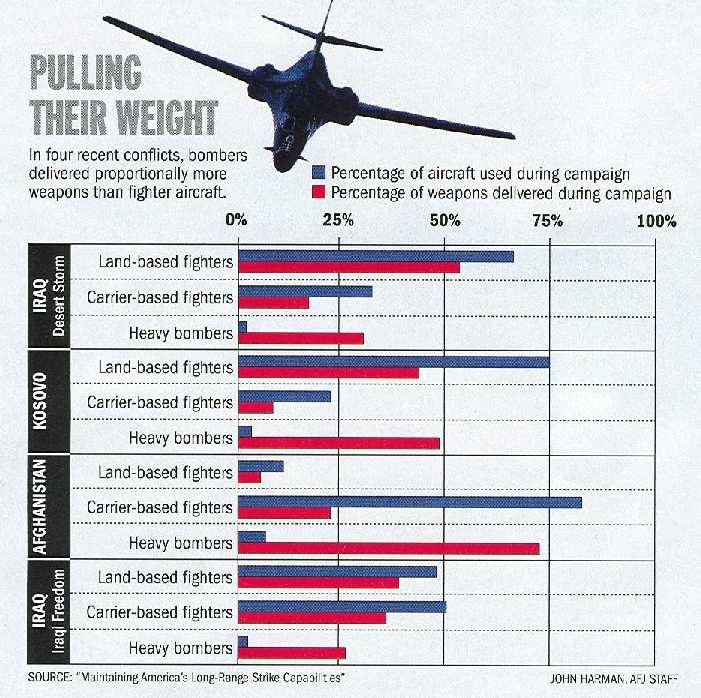
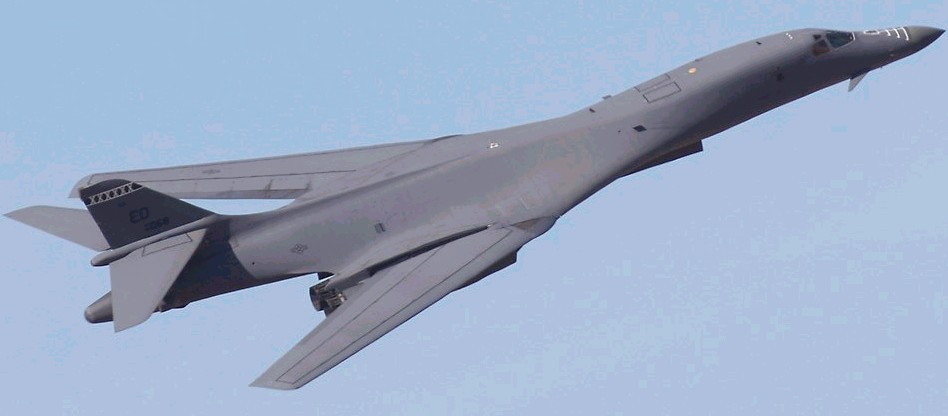

Obviously the USAF was able to get to Afghanistan to do deep strike inland attack we know this because we saw the B-52s, B-1s, F-15s and A-10s doing them. These strike aircraft WERE able to operate from land bases secured by ground forces, just take a look at Bagram AFB.
There is also the inherent lie about number of missions to deceive the reader when the actual amounts of high explosives dropped which is the actual military effect being offered; lots of planes not dropping much bombs is not superior to fewer USAF heavy bomber planes dropping far more bombs. Whether these HE munitions are actually hitting or even affecting the enemy is another issue needed to be examined closely. That we are blowing up essentially nothing at great costs shows we are just indulging ourselves in fantasies that we are doing something about actual humans threatening us when we are really just burning up money.
2. Lying by inferring its supercarriers or nothing to get deep air strikes (my way or the highway)
Critics argue that we are spending far too much money on multi-billion dollar vulnerable supercarriers to get land attacks that can be more efficiently done by heavy bombers from land bases or seaplanes and small tender ships that are less vulnerable to being sunk and killing thousands of men in one blow.
Battleship guns ballistically delivering HE is more efficient than HE delivered by planes and does not risk pilots but represents a suppressed technology the biased for supercarrier Navy brass does not want employed.
3. Relevance: boasts by assertion that any of these air strikes were blowing up anything more than mud huts--this is deja vu all over again--we did the same thing is Vietnam:
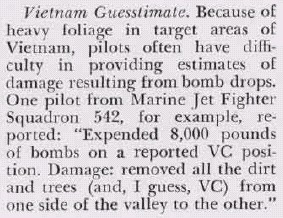
This is clearly a lying statistical bragging sheet trying to create an illusion that all these sorties are achieving important military effects and not just spinning their wheels conducting feel good air shows for their own statistically-driven egos. Aircraft sorties is like body count was in Vietnam.
4. A dozen supercarriers with at best 8 at one time does not cover the earth and their excessive costs have made them fatally vulnerable to submarine, mine and air attacks as funds to create a balanced navy are hogged up by carriers and land attack planes
A force of 30 smaller carriers with 3, 000 planes to include a well-rounded mix of ASW, AAW and LA, SOF types beats 12 large supercarriers with 720 x F-18 small short-range fighter-bombers and no ASW or SOF planes that can't transit the Panama canal. SOF transport planes flown from these smaller carriers could actually 3D maneuver with light air-mech vehicles like M113 Gavins to actually kill/capture sub-national conflict foes and not just be floating firepower bombardment platforms, which is what America needs to be protected (VICTORY)
A force of 100 seaplane long-range heavy bombers and 10 tender ships beats the ordnance that 12 supercarriers and 720 x F-18s can deliver without the vulnerability or high costs
A force of four Iowa class battleships can deliver more HE than 4 supercarriers worth of F-18s can to targets up to 25-100 miles inland if technology were applied to their 16 inch gun systems WITHOUT RISKING PILOTS TO DEATH AND CAPTURE.
Precision Bombing of Nothing: an American Tradition
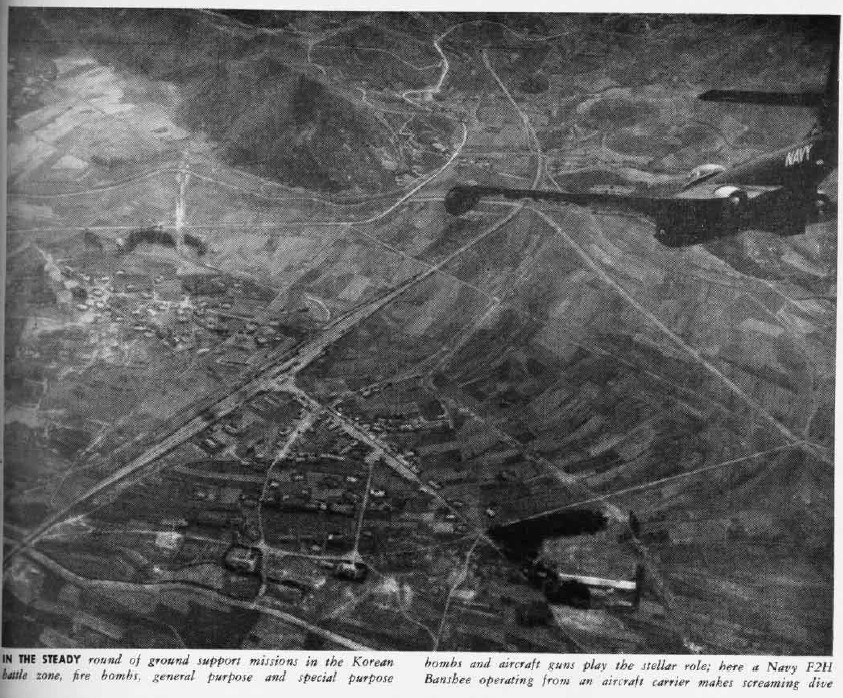
www.geocities.com/operationalliedforces/airinterdictionfails.htm
www.history.navy.mil/library/online/bombing_tool.htm
Americans want to replay WW2 on the cheap and do the firepower part from sexy aircraft and not do the necessary ground maneuver to take a Berlin or a Tokyo. Since nuclear SHEs are off the table to break the will of a nation-state foe, small amounts of HEs from small fighter-bombers from extremely costly, vulnerable aircraft supercarriers or piss-off-the-locals land bases going too fast to see what they are hitting means they can only hit what is obvious. Smart foes will not offer obvious targets seen from the air. Foes that are not nation-states with American-style industries will not HAVE ANY OBVIOUS air targets. Only if many heavy bombers are used to mass HE effects can nation-states be forced to bend their wills but only if we are willing to carpet-bomb and kill many civilians in the process and be just as evil as the government leaders we are opposing if those citizens are victims and not guilty accomplices of placing the governmental leaders in power.
The power of planet earth to absorb our inefficient fighter-bomber airstrikes is greater than our ability to throw money down the drain or create narcissistic egomaniacs to fly such pricey aircraft. America will continue to be defeated by foes refusing to play our partial WW2 re-enactment game with small amounts of HE until we finally realize that firepower cannot win wars short of SHE annihilation of all the people we THINK are against us, and to develop a MANEUVER based warfighting force structure that can DIFFERENTIATE between good guy and bad guy from the ground without getting itself hurt by it being in armored tracked combat vehicles with EFFICIENT firepower proving leverage to HELP. This would mean projecting massive amounts of precision HE BALLISTICALLY via guns from ships and artillery pieces whenever possible so as to prevent a human pilot from having to fly over or near a target to try to hit it. We must preserve THE WILL OF OUR OWN PEOPLE and not fritter it away delivering HE against mud huts. Men in aircraft flying low and slow must help ground forces find the enemy to not only hit him with HE/KE attacks but to control the ground itself so he cannot use it to wage war. Robbing the enemy of the ability to wage war by not allowing him the ground needed can force him to conclude that he should stop trying. When an enemy can no longer fight you, he is defeated. When an enemy has been made to changed in his mind to stop trying to fight you, you have hope that he can someday be your friend.
VIETNAM AIR WAR REALITY CHECK
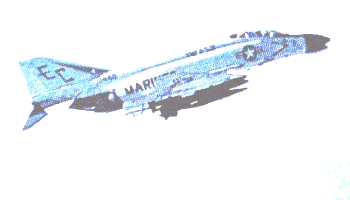
1. How many of these air strikes were un-necessary and Iowa class battleships/cruisers could have taken out the targets with naval guns ballistically launching HE?
2. How many of these shoot-downs were the result of stupid white paint jobs on USN/Mc aircraft? How many helicopters to stupid green paint jobs with MARINES in white letters? USAF bare silver non-camouflage? USAF jungle camo on top with gray underneath?
3. How many targets could have been hit by precision guided munitions at a stand-off instead of dumb bombs which resulted in pilot shoot downs?
4. How many of these 1, 052 Navy/Mc aircraft losses were from overly complicated and ill-designed aircraft? How many could have been avoided if single-engined planes had at least a back-up emergency engine? How many avoidable by having ARMOR? Did the SkyRaiders have the armor that was added late in the Korean war? Why were they and other aircraft not armed with Sidewinder AAMs to prevent MIG shoot-downs?
http://en.wikipedia.org/wiki/Aircraft_losses_of_the_Vietnam_War
EXCERPTS:
Aircraft losses of the Vietnam War
From Wikipedia, the free encyclopediaThere were a great many aircraft losses during the Vietnam War. Hundreds of U.S. fixed-wing aircraft were lost to ground fire in South Vietnam, Laos, and Cambodia, and to an integrated air defense system in North Vietnam, consisting of antiaircraft artillery (AAA), surface-to-air missiles (SAMs), and fighter interceptors (MiG)s. The great majority of U.S. combat losses in all areas of Southeast Asia were to AAA. The Royal Australian Air Force also flew combat and airlift missions in South Vietnam, as did the Republic of Vietnam. Additionally, accidental losses (such as in the case of the SR-71s listed) extracted an additional toll by themselves and are not differentiated in the following list below.
United States Navy
USN fixed-wing carrier-based
A-1 Skyraider --65 total, 48 in combat
-First loss A-1H 139760 (VA-45, USS Constellation), to AAA August 5, 1964, Lt.j.g. R. C. Sather KIA
-Final loss A-1H 134499 (VA-25, USS Coral Sea), to MIG February 14, 1968, Lt.j.g. J. P. Dunn MIA
[NOTE: stopped using it entirely in 1968 to complete prop plane back stab begun after Korean War by jet jocks]
A-3 Skywarrior --7 total, 2 in combat
-First loss A-3B 142250 (VAH-4, USS Hancock), non-combat December 22, 1964, 3 rescued, 1 killed
-Final loss A-3B 144627 (VAH-4, USS Kitty Hawk), AAA March 8, 1967, 3 crew KIA
[NOTE: stopped using it as a bomber and only as a tanker]
A-4 Skyhawk --282 total, 195 in combat
-First loss A-4C 149578 (VA-144, USS Constellation), AAA August 5, 1964, Lt.j.g. Everett Alvarez POW (longest held prisoner)
-Final loss A-4F 155021 (VA-212, USS Hancock), AAA September 6, 1972, pilot rescued
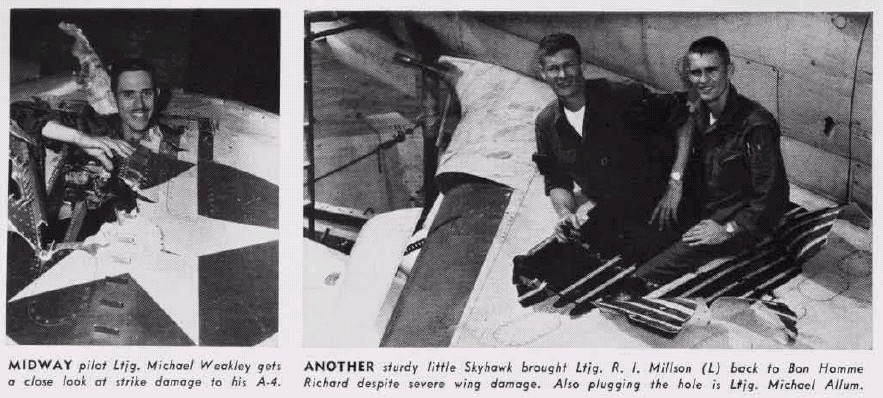
[NOTE: incredibly sturdy aircraft, the SkyHawk, many pilots owe their lives to it. Even more would have came back had it had two engines like T-38s/F-5s/A-37s have so there's a back-up thrust to make it home. We are foolish to not use them anymore.]
A-6 Intruder --62 total, 51 in combat
-First loss A-6A 151584 (VA-75, USS Independence), own bomb detonation Laos July 14, 1965, crew rescued -Final loss A-6A 157007 (VA-35, USS America), AAA South Vietnam January 24, 1973, crew rescued
A-7 Corsair II --100 total, 55 in combat
-First loss A-7A 153255 (VA-82, USS America), AAA Laos May 31, 1968, Lt. K.W. Fields rescued
-Final loss A-7E 156837 (VA-147, USS Constellation), non-combat January 29, 1973, pilot missing
C-1 Trader --4 total, 0 in combat
-C-1A 146047 (VR-21, USS Independence), non-combat August 30, 1965, 7 passengers and crew rescued
-C-1A 136784 (VR-21, USS Independence, non-combat September 12, 1965, 9 passengers and crew rescued, 1 killed
-C-1A 146054 (Carrier Air Wing 11, USS Kitty Hawk), non-combat January 16, 1968, 7 passengers and crew rescued, 3 killed
C-2 Greyhound --1 total, 0 in combat
-Sole loss C-2A 155120 (VRC-50, USS Ranger), Gulf of Tonkin crash December 15, 1970, 9 passengers and crew killed
E-1 Tracer --3 total, 0 in combat
-First loss E-1B 148918 (VAW-12, USS Independence), non-combat September 22, 1965, crew rescued
-Final loss E-1B 148132 (VAW-111, USS Oriskany), non-combat October 8, 1967, 5 crew killed
E-2 Hawkeye --2 total, 0 in combat
-E-2A 151711 (VAW-116, USS Coral Sea), April 8, 1970, 5 killed
-E-2B 151719 (VAW-115, USS Midway), June 11, 1971, 5 missing
EKA-3 Skywarrior-- --2 lost, 0 in combat
-EKA-3B 142400 (VAQ-132, USS America), non-combat July 4, 1970, 3 rescued -EKA-3B 142634 (VAQ-130, USS Ranger), non-combat January 21, 1973, 3 killed
EA-1 Skyraider --4 total, 1 in combat
-First loss EA-1E 139603 (VAW-111, USS Yorktown), non-combat April 15, 1965, crew rescued
-Final loss EA-1F 132543 (VAW-13, USS Franklin D. Roosevelt), non-combat September 100, 1966, crew rescued
F-4 Phantom --138 total, 75 in combat
-First loss F-4B 151412 (VA-142, USS Constellation), non-combat November 13, 1964, crew rescued
-Last combat loss (also last USN combat loss of war) F-4J 155768 (VF-143, USS Enterprise), AAA South Vietnam January 27, 1973, Cdr H.H. Hall and Lcdr P.A. Keintzer POW
-Final loss F-4J 158361 (VF-21, USS Ranger), non-combat January 29, 1973, crew killed
F-8 Crusader --118 total, 57 in combat
-First loss F-8D (VF-111, USS Kitty Hawk), to AAA over Laos June 7, 1964, LCdr C.D. Lynn rescued
-Final loss non-combat F-8J 150887 (VF-191, USS Oriskany) November 26, 1972, pilot rescued
KA-3 Skywarrior- --2 lost, 0 in combat
-KA-3B 142658 (VAH-4, USS Oriskany), non-combat July 28, 1967, 1 rescued, 2 killed -KA-3B 138943 (VAH-10, USS Coral Sea), non-combat February 17, 1969, 3 killed
RA-5 Vigilante --27 total, 18 in combat
-First loss RA-5C 149306 (RVAH-5, USS Ranger), non-combat December 9, 1965, 2 killed
-Final loss RA-5C 156633 (RVAH-13, USS Enterprise), to MIG North Vietnam December 28, 1972, Lcdr A.H. Agnew POW, Lt. M.F. Haifley KIA
RF-8 Crusader --29 total, 19 in combat
-First loss RF-8A (Det.C VFP-63, USS Kitty Hawk), June 6, 1964, to AAA in Laos, Lt. C. F. Klusmann POW
-Final loss RF-8G 144608 (VFP-63, USS Oriskany), non-combat December 13, 1972, pilot rescued
S-2 Tracker --4 total, 2 in combat
-First loss S-2D 149252 (VS-35, USS Hornet, January 21, 1966, 4 crew MIA
-S-2E 152351 (VS-21, USS Kearsarge, combat loss October 11, 1966, 4 KIA
-Final loss US-2C 133371 (VC-5, USS Hornet), non-combat September 27, 1967, crew rescued
USN rotary-wing
SH-2/UH-2 Sea Sprite-- --12 lost, 0 in combat
-First loss UH-2A 149751 (HC-1, USS Hancock), non-combat January 10, 1966, 4 rescued -Final loss UH-2C 149767 (HC-1, USS Bon Homme Richard), non-combat August 10, 1969, 4 rescued
SH-3 Sea King-- --20 lost, 8 in combat
-First loss SH-3A 148993 (HS-2, USS Hornet), AAA North Vietnam November 13, 1965, crew of 4 rescued
-Final loss SH-3D 156494 (HS-7, USS Saratoga), non-combat December 31, 1972, crew rescued
______________________
882 aircraft lost
Sources for USN figures: hand tabulation of individual loss entries by date and aircraft carrier, June 7, 1964-August 15, 1973, carrier air wings only, enumerated in Tonkin Gulf Yacht Club, René J. Francillon (1988)
United States marine corps
USMC fixed-wing
A-4 Skyhawk --81 lost
A-6 Intruder --25 lost
C-117 Skytrain --2 lost
EA-6 Prowler --2 lost
EF-10 Skynight --5 lost
F-4 Phantom --95 lost, 72 combat
F-8 Crusader --21 lost
KC-130 Hercules --4 lost
O-1 Bird Dog --7 lost
OV-10 Bronco --10 lost
RF-4 Phantom --4 lost
RF-8 Crusader --1 lost
TA-4 Skyhawk --10 lost
TF-9 Cougar --1 lost______________________________
270 aircraft lost
Source for F-4 losses is Phantom with U.S. marine corps (Joe Baugher), others are unsourced
This RAND travesty of begging for yet another supercarrier to do irrelevant firepower bombardment with minor technological tweaks to keep thousands of weak economic co-dependants and narcissistic egomaniacs employed reveals the bankruptcy of the Navy's WW2 re-enactment large aircraft carrier "Midway Myth" mentality. With no fleets to sink, the carrier's short range planes do land attack bombardments which they are even less efficient at doing than USAF fighter-bombers and certainly less than large bombers. The carrier is being used as a gimmick, a floating air base to do quasi strategic and tactical bombing which of themselves are of dubious value at winning wars when the earth itself so easily absorbs HE effects to naught. It is only through ground MANEUVER that human enemies are brought to the point of kill/capture or have their means to fight taken from them, and at best all the Navy's expensive carriers do is bombard what's obviously seen. This claim of close air support of ground maneuver forces is a lie; the F-18s do not fly slow or low enough to see the actual enemies and do not line up to hit them but are generally directed or have their costly ordnance guided by a ground observer. This is DISTANT air support not CLOSE air support. The value of DAS is questionable on its own merits and in light of what the taxpayers pay to get it and what it little it does to actually defeat enemies threatening America should be stopped. If we need to do firepower demonstrations to make weak foes surrender to our proxies we can do this cheaper and better from an USAF or Navy seaplane heavy bomber than from mega costly supercarriers and short-range F-18s.
Last But Not Least: Immature Navy FlyBoy but Admiral's Son McCain Incinerates 167 Fellow Sailors
Now You Will Know The Rest Of The Story: If This Doesn't Make Your Blood Boil You Are Not A True American!
McCain crashed 5 jets, plus he was responsible for the horrible USS Forrestal fire In 1967. Surviving crewmen and those who investigated the Forrestal fire case reported that McCain deliberately "wet-started" his A-4E Skyhawk to shake up the guy in the F-4 Phantom behind his A-4. "Wet-starts", done either deliberately (the starter motor switch allowed kerosene to pool in the engine and give a wet start) or accidentally, shoot a large flame from the tail of the aircraft. In McCain's case, the "wet-start" "cooked off" and launched the M34 Zuni rocket from the rear F-4 that punctured the Skyhawk's fuel tank, knocked the M-65 1000 lb. bomb off it's 500 lb. rated mount, and touched off the explosions and massive fire. The F-4 pilot was reportedly killed in the conflagration, along with 167 of his fellow Forrestal shipmates (including those who died later from wounds suffered). "Wet starting" was a common practice among young "hot-dog" pilots. McCain was quickly (they were still counting the Forrestal dead) transferred to the USS Oriskany (the only Forrestal crewman to be immediately transferred).
Description: XA4D-1 Skyhawk BuNo 137812 experiencing a wet start (note the pool of JP4 on the ground and the tongue of flame from the tailpipe). Do you need more - This is only a tip of the Iceberg!!!
www.skyhawk.org/5e/g137812/html/137812i.htm
John McCain And The USS Forrestal Fire
http://judicial-inc.biz/82jjohn_mccain_and_the_uss_forresta.htm
Go to www.YouTube.com & search. POW John McCain & Veterans Against McCain.
The videos in this e-mail are only a few of the things the Democrats will be using before the Nov. Election if McCain is the Republican choice.
YouTube - USS Forrestal Mishap July 29, 1967
YouTube - Actual Voice of Cap. John Beling USS Forrestal July 29, 1967
YouTube - Memorial of The USS Forrestal Disaster July 29, 1967
YouTube - John McCain Losing His Cool over our POWs using the Resume Excuse of the Perpetrators
YouTube - "McCain Says OK if U.S. Stays in Iraq for 10,000 Years"
http://election.newsmax.com/mccain_iraqok/?s=al&promo_code=4270-1
John McCain Campaign Advisor Is A Mexican Official - Do Not Believe McCain Is For Closed & Secure Borders!!! See for yourself
YouTube - POW's Against McCain
www.youtube.com/watch?v=EFhhvaIXA9A&NR=1
YouTube - POW's Say John McCain Is A Lying Skunk !!!!! HTS 020908 p2
YouTube - "Songbird" McCain Blocks Efforts to Find MIA's
YouTube - "Hanoi John" McCain Caught Lying About Iraq By Wolf Blitzer
YouTube - "Songbird" McCain EXPOSED NEO CON Shill by Oliver North
YouTube - Big Bad John: "The Company I Keep"
YouTube - Get This Iraq War Charge Off My Bill
Seaplanes and tender ships/subs/warships are better: the Aircraft Carrier is an expensive, dangerous and tactically unsound way to operate aircraft at sea
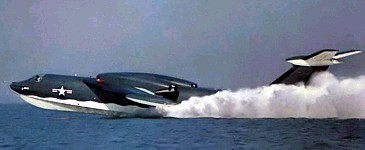
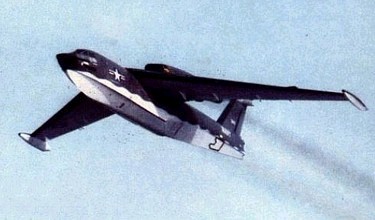
The large aircraft carrier mentality is bankrupting the American taxpayers and ruining the navy and marines. The large aircraft carrier is not using the sea, its fighting against it to artificially create a chunk of dry land; even a huge supercarrier is a bottleneck for aircraft to take-off and land (TO & L). Large Seaplanes operating from tender ship/submarines and small seaplanes from surface warships/submarines which are aerodynamically just as fast and agile as land planes on the other hand use the water's buoyancy to hold them up and NOT HAVE A TO & L BOTTLENECK. Seaplanes do not have the following problems:
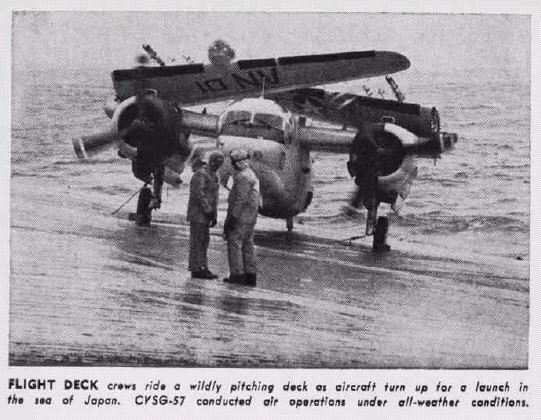
1. Dangerous flight deck which kills men trying to work around the bottleneck to cycle land aircraft with tail hooks, does not have broken wires, failed catapults, runaway aircraft, fires, freak accidents; ALL the seaplanes in the water by a tender ship/submarine can take-off or land SIMULTANEOUSLY in up to moderate sea states just like WW2 fighters could take off from grassy fields. Seaplanes catapulted from tender ship/submarines do not have to be wheeled on a wet, rolling deck into launch position, THEY ARE ALREADY ON THE CATAPULT.
2. Does not have aircraft that roll off the side of the deck into the water killing pilots and losing aircraft
3. Does not have failed TOs that are in jeopardy of the ship running over them
4. Does not have wind and waves and deck pitching action throw men over the side several stories high into the water
5. Does not consistently lose expensive multi-million-dollar aircraft sling shotted from off a carrier several stories high above the water; seaplanes if they have mechanical problems and can't TO simply stay on the water and are recovered and repaired
6. Limited in aircraft size to small to medium sizes due to deck space and elevator/hanger size, seaplanes can be as large as we have know-how to make them, there's an unlimited amount of ocean water available to park them and use as TO & L runways. 100 large seaplane turbofan jet bombers sustained by 10 tender ships/subs requiring 20, 000 men can deliver more HE upon the enemy faster, safer TBATE as well as TBAM and at less cost than 700 small landplanes with tail-hooks from 10 large supercarriers requiring 50, 000 men.
7. Seaplanes and tender ship/submarines are not clusterfucks of dozens of planes loaded with fuel and HE bombs and missiles waiting to take-off in a tiny space asking for an accidental or enemy created fire/explosion to incinerate everything and everyone on board, they are dispersed using the sea
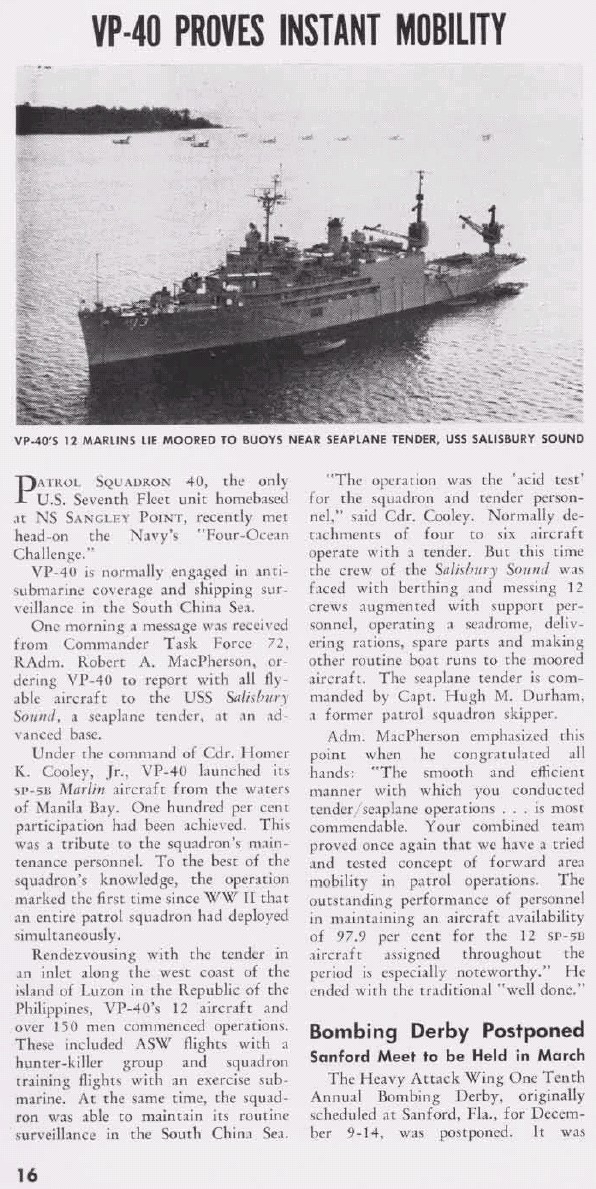
8. Seaplanes do not have the danger and risk of trying to land planes on tiny carrier decks pitching up/down and the resultant crashes, aircraft and pilot losses, they can point themselves as their own ships into the wind from the water to take-off and land
9. Seaplanes don't need 5, 000 potential victims clusterfucked into a huge for guided and nuclear weapons target supercarrier, they are dispersed and use ships/subs that need only a couple hundred men to service/rearm them. Military seaplane technology can refuel/rearm seaplanes while the ship is moving by taking the seaplanes aboard by crane or rear flooding wheel deck or refuel lines.
10. Seaplane tenders because they do not try to make a flat piece of earth on top can be just as heavily armed as a cruiser with guns and missiles. Seaplane tender (aircraft carrier) submarines can submerge and hide.
A NANEWS tidbit where a seaplane tender shelled Vietnam is below:
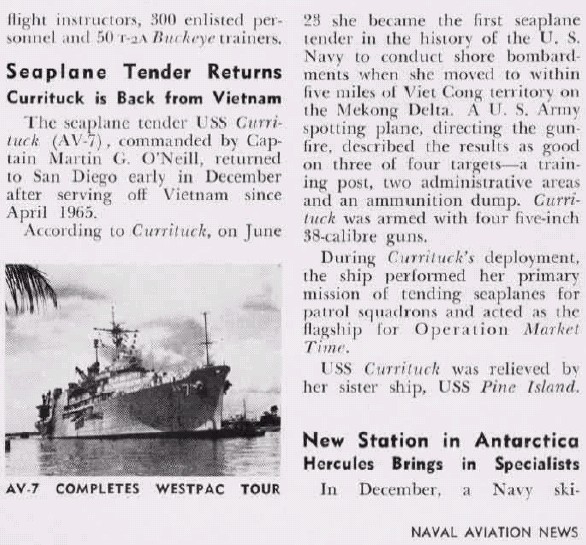
11. The overhead cost of fighting salt water corrosion of 100 seaplanes THAT ARE NOT GOING TO DESTROY THEMSELVES IN CARRIER OPERATIONS is nothing compared to the huge supercarrier maintenance costs to keep the flight deck clear, the steam catapults operating, transfering fiel/ammo/parts from supply ships to carriers....the large aircraft carrier is one huge grossly inefficient clusterfuck at sea waiting to explode and is unsound offering dubious naval capabilities and then only when the weather is good and part of the time due to needs for rest and overhaul.
5, 000 men fighting salt water all over a 85, 000 ton ship and 70 airplanes vs....
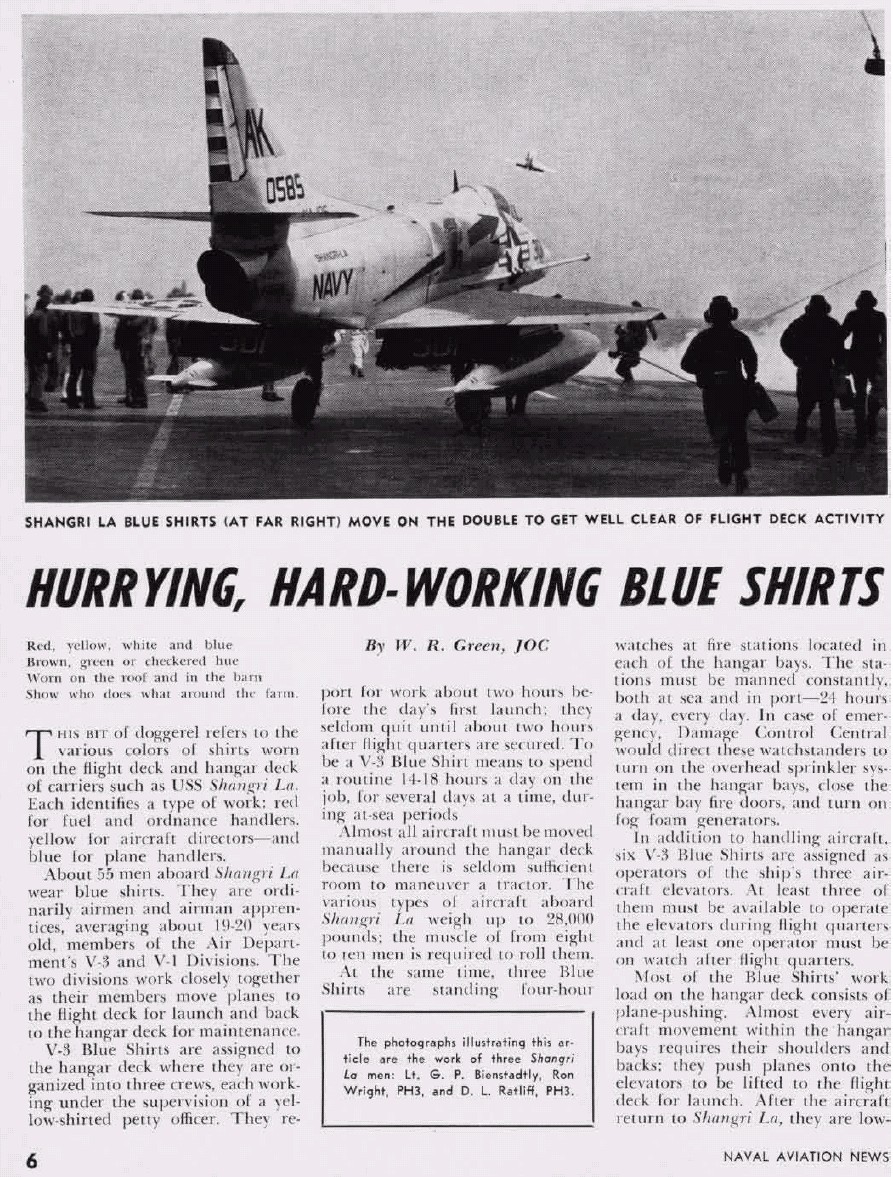
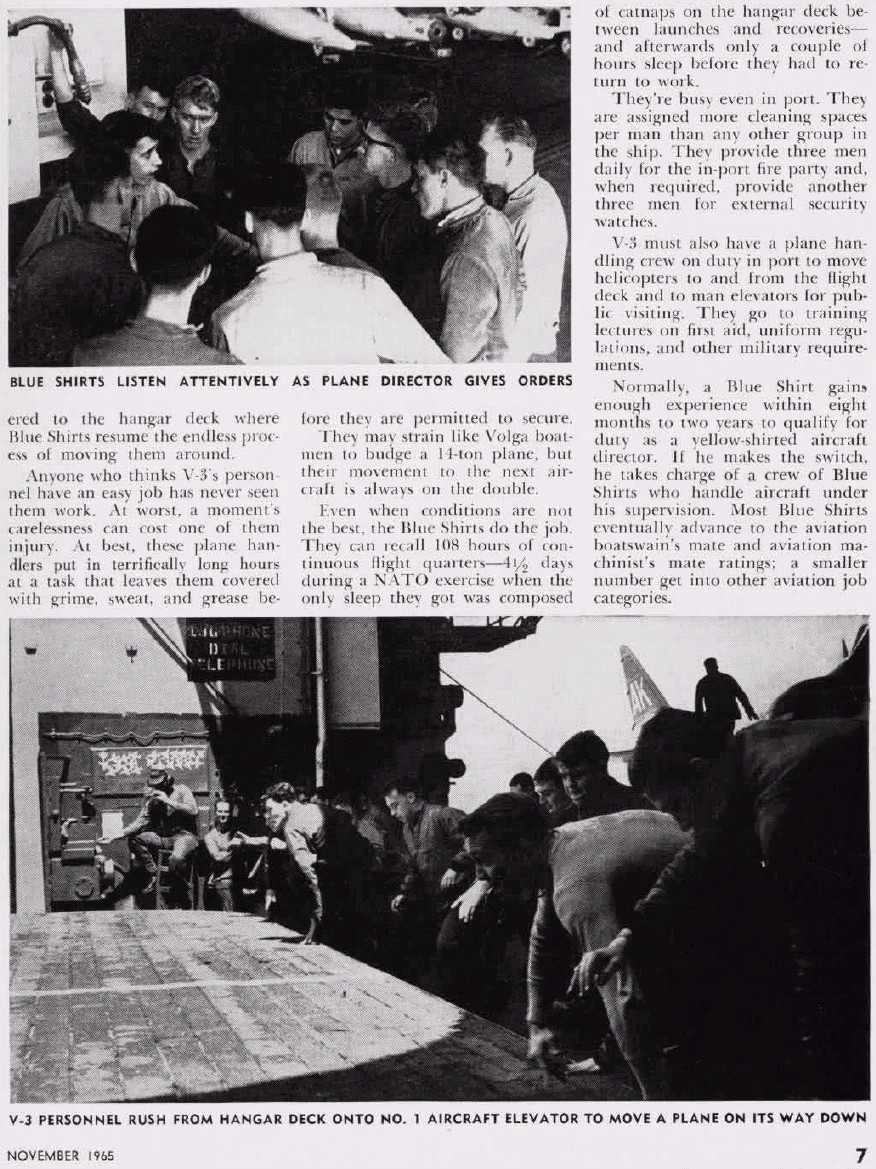
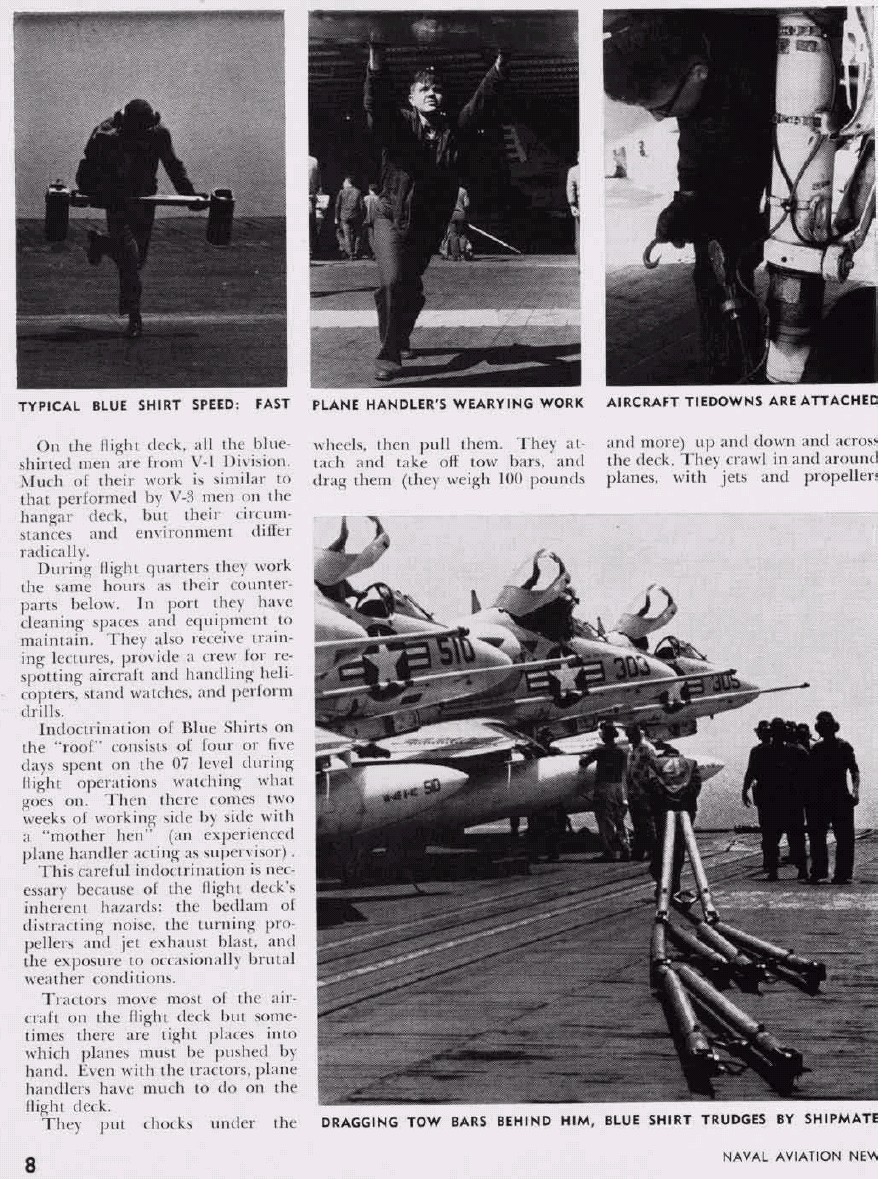
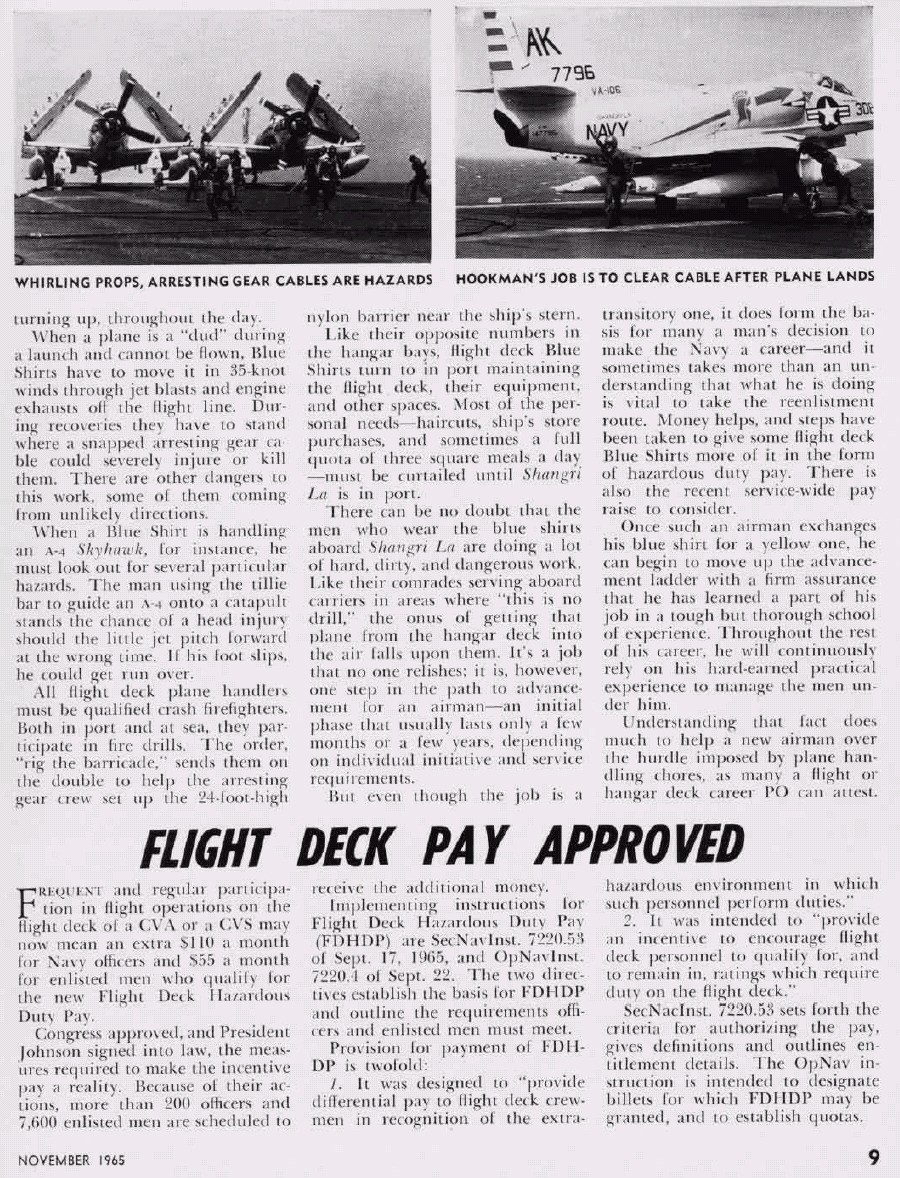
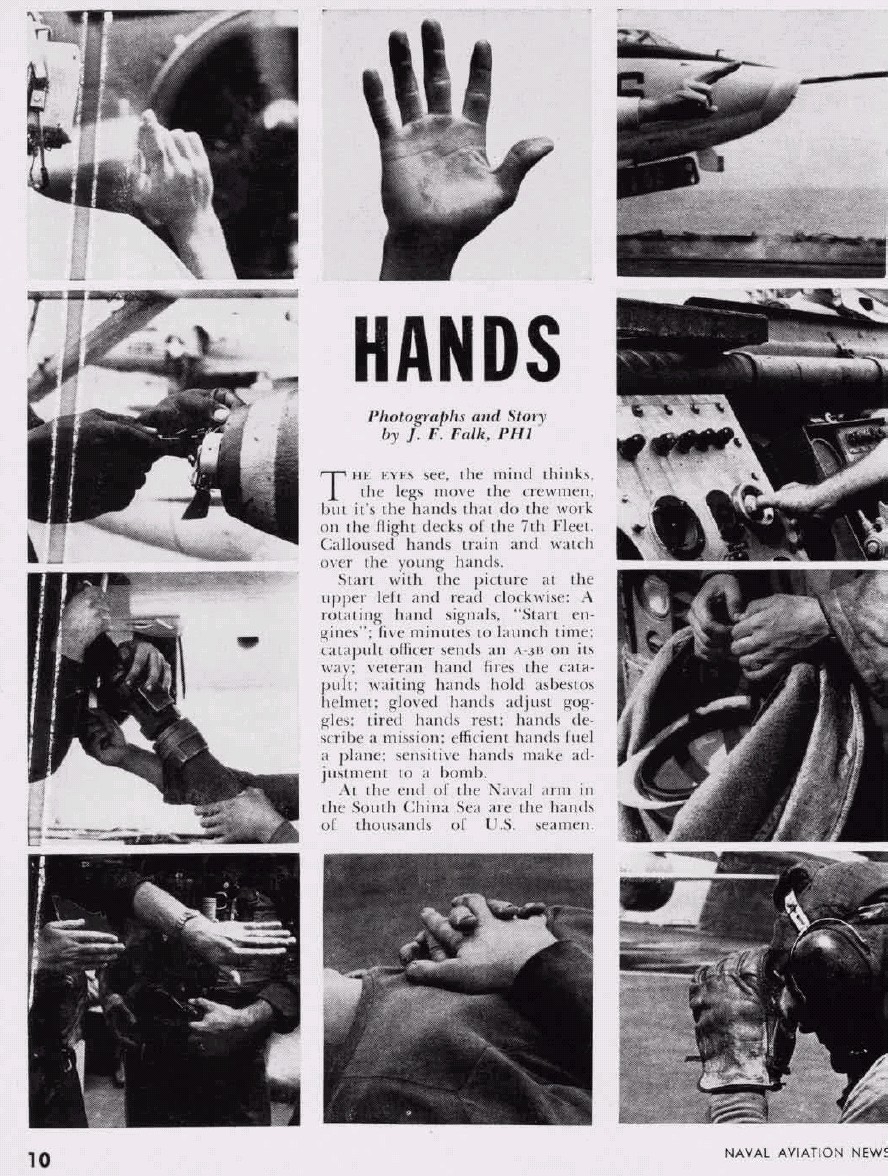
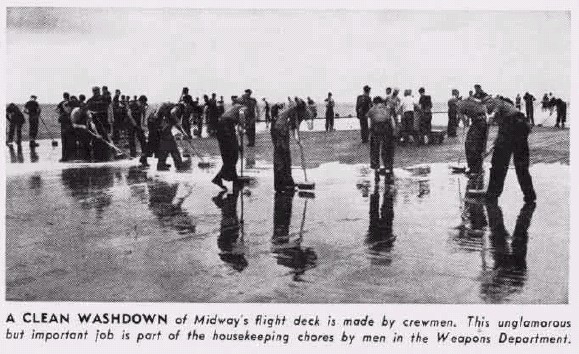
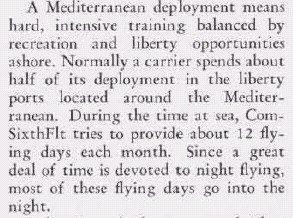
300 men fighting salt water corrosion over a 20, 000 ton ship and 10-12 large seaplanes...
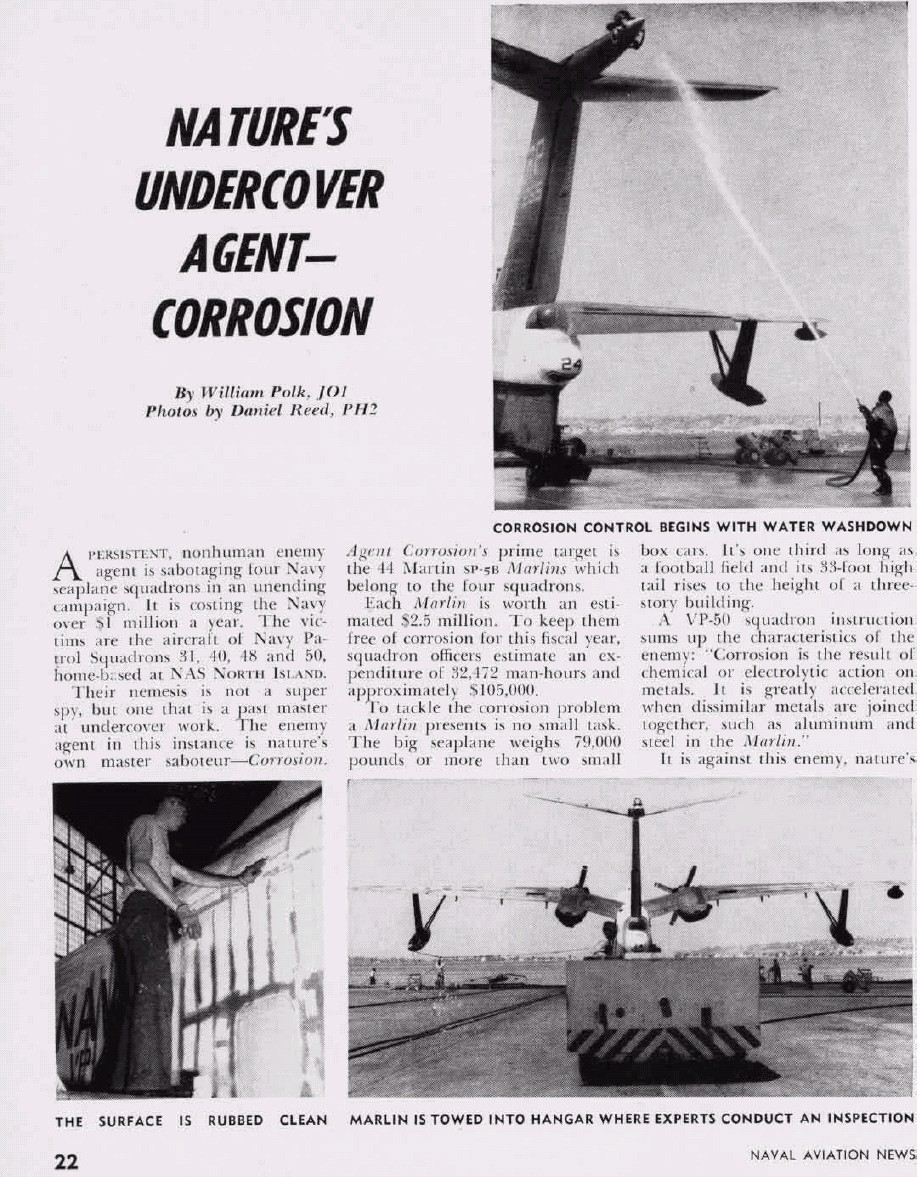
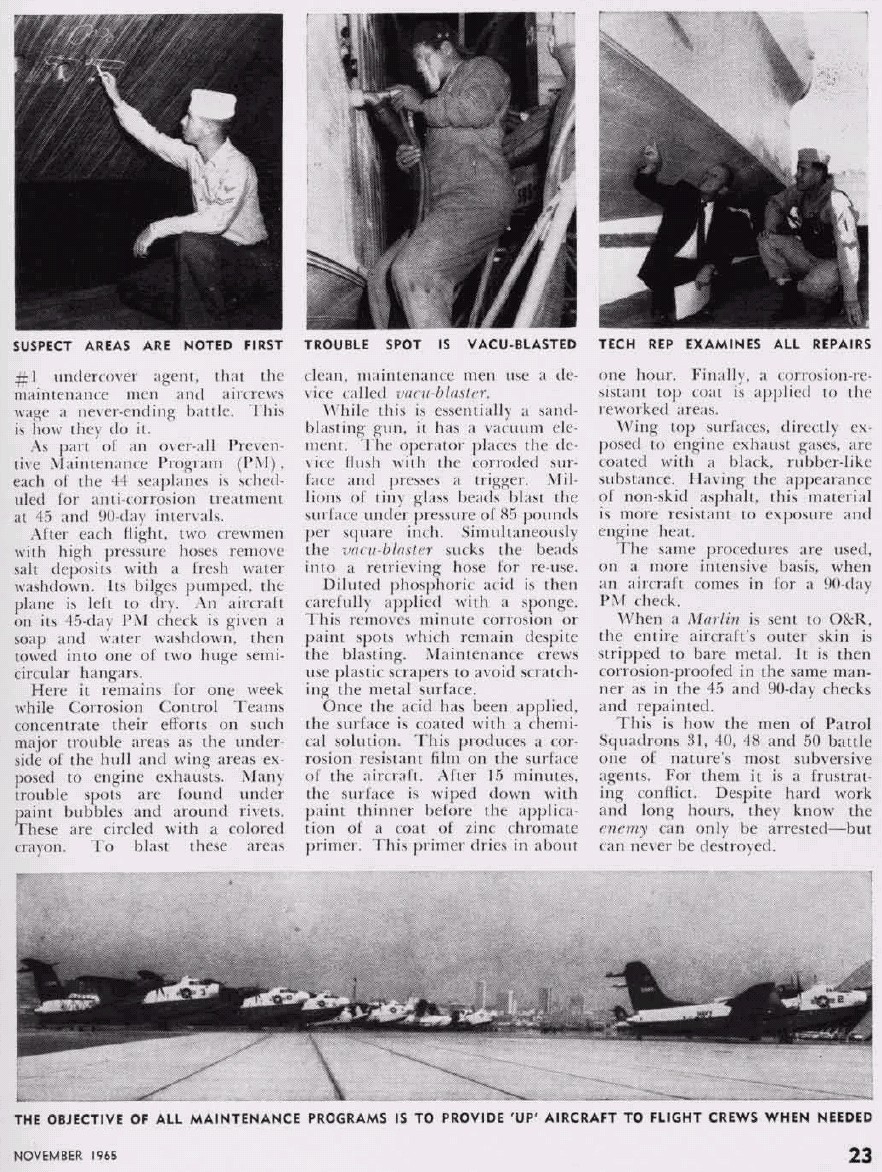
IF WE ARE GOING TO OPERATE CARRIERS THEY NEED TO BE AFFORDABLE AND SMALL SO THEY CAN TRANSIT THE PANAMA CANAL SO WE CAN HAVE A LARGE NUMBER OF THEM AT SEA TO SMOTHER ENEMY THREATS WITH LOTS OF AIRCRAFT. THEY NEED TO BE SIMPLE TO OPERATE AND THE PLANES THEY SHOOT OFF THEIR DECKS NEED TO BE IN CONSTANT MASS PRODUCTION AND ABLE TO FLOAT SO AT THE VERY LEAST WE CAN RECOVER CRASHES AND SALVAGE PARTS FROM THEM. EVENTUALLY THEY NEED TO BE OPERATED FROM SUBMARINE AIRCRAFT CARRIERS TO EVADE ENEMY SURVEILLANCE STRIKE COMPLEXES.
SMALL FIGHTER-BOMBERS ARE BEST FOR ANTI-AIR WARFARE AND CAN DO ANTI-SUBMARINE AND SURFACE SHIP WARFARE ON A SMALLER SCALE THAN LARGE LANDS OR SEAPLANE BOMBERS. If agile, they can do land attack to observe/attack small enemy targets, but the most efficient land attacker is the heavy land or seaplane bomber. Trying to strategic bomb nation-states with short-range, small carrier planes as we tried to do during the Vietnam war failed miserably and murdered thousands of our men needlessly.
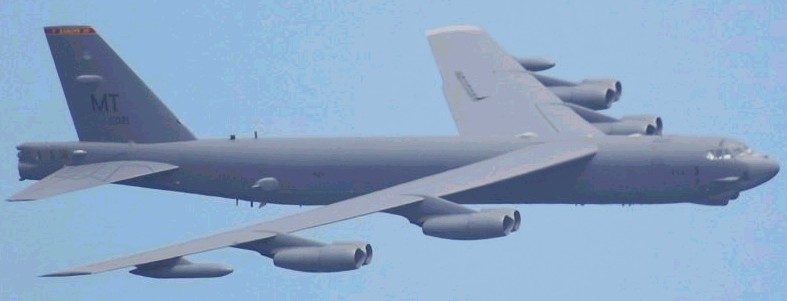

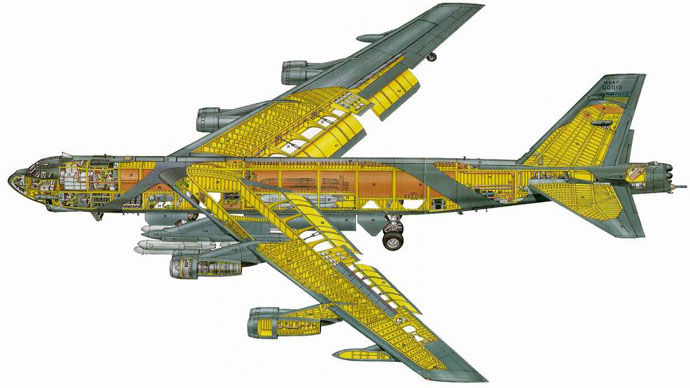
The North Vietnamese were not swayed to do a damn thing until USAF B-52 heavy bombers were sent north en masse. Its high time the USN/Mc get their collective heads-out-of-their-asses and stop the Midway Myth and Iwo Jima large aircraft carrier follies and start using sound seaplanes before we have a national military defeat at sea and continue to let inland foes get away.
Aircraft Carriers that can Fight if they can't Take Flight
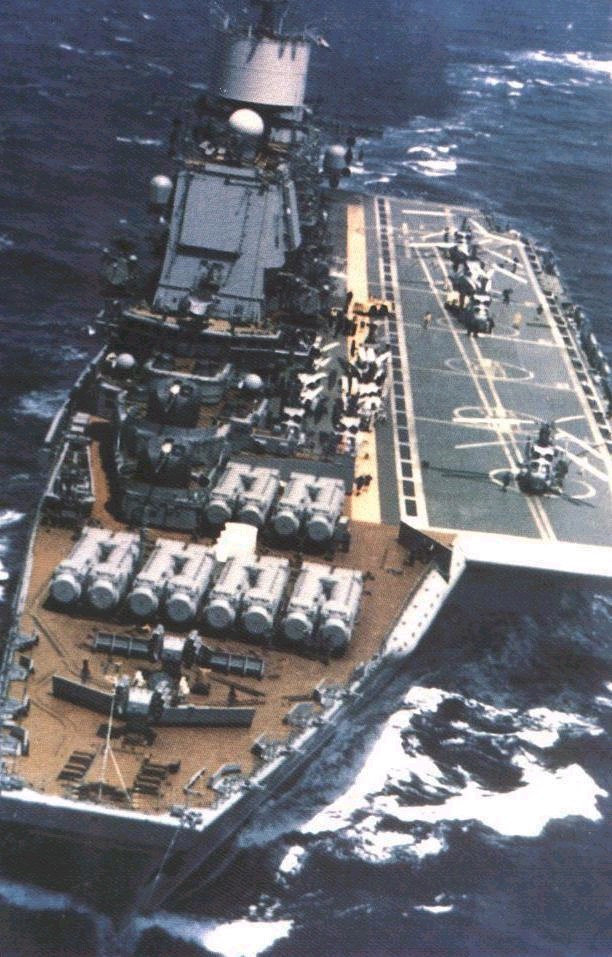
We would do well to learn from the Russians and insure our carriers have missile armament to keep on fighting in event aircraft flight operations are not possible. VLS missile cells could be forward of the flight deck for example. If you can't launch aircraft and STOP LYING THAT YOU CAN IN ALL WEATHER!---you need weaponry or else you can end up like the aircraft carrier HMS Glorious which did not have such a "glorious" end at the hands of German surface ship guns
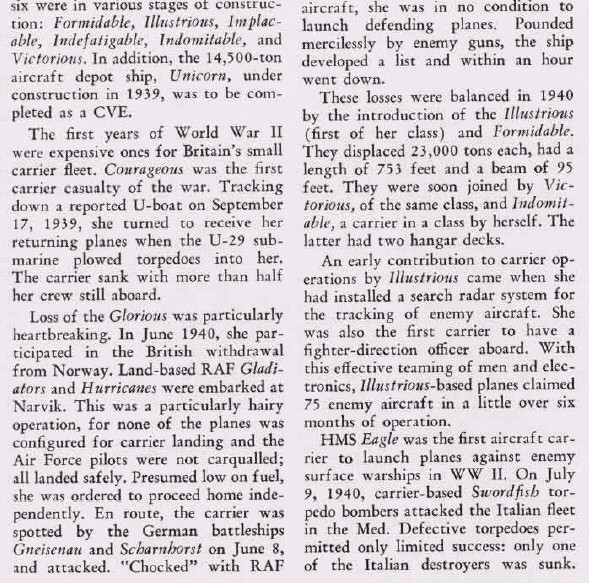
What we need to do is have about 30 smaller nuclear fleet carriers HEAVILY ARMORED WITH MISSILE WEAPONRY to fight even if the flight deck is rendered inoperative that can fit through the Panama canal so we can have at least 10 in operation at all times for 1,000 airplanes and 3, 000 planes in a surge during war to cover the earth and smother all sea/air enemies. We need IOHO another 70 x CVE jeep carriers made from cargo container ships. During sub-national conflicts (SNCs) these can be floating bases for SOF raiding forces and non-arrogant COIN troops to stabilize a country after we toppled it without a huge presence on land that tends to cause rebellions. That's if we did things right.
Since we are not interested in this and are stuck with the supercarrier targets we at the minimum need 30 x CVE jeep carriers ASAP or else we are going to be swept from the sea in a major war and continue to stumble doing SNCs.
The American people expect the Navy to control the seas with a balanced force, yet since WW2 they have paid for a supercarrier floating flyboy club increasingly at risk to modern weapons and unwilling and unable to protect our economic lifeblood ship movement of oil and containerized goods. The USN is divided into the following factions in descending order of $ budgetary importance:
1. Supercarriers + Naval Aviation (their wants drive the entire organization)
2. Cruiser/destroyer "Black Shoe" surface warfare community
3. Submariners
4. Amphib ships + marines WW2 frontal beach assault flag-draped victimolgy Iwo Jima re-enactment club
5. Special Warfare Club (SEALs, small boats etc.)
6. Patrol Navy (on life support)
7. Battleships (in mothballs)
8. Small seaplanes on battleships/cruisers/destroyers (DECEASED)
9. Large seaplane tenders + seaplanes in patrol navy (DECEASED)
10. Lighter-Than-Air Blimps (DECEASED)
11. PT boats (DECEASED)
The ASW Combo of a Balanced Navy We No Longer Have
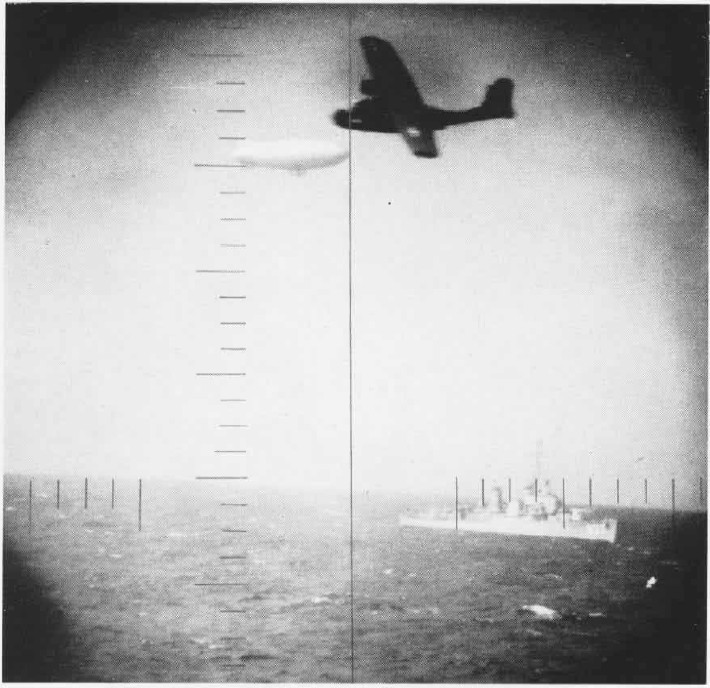
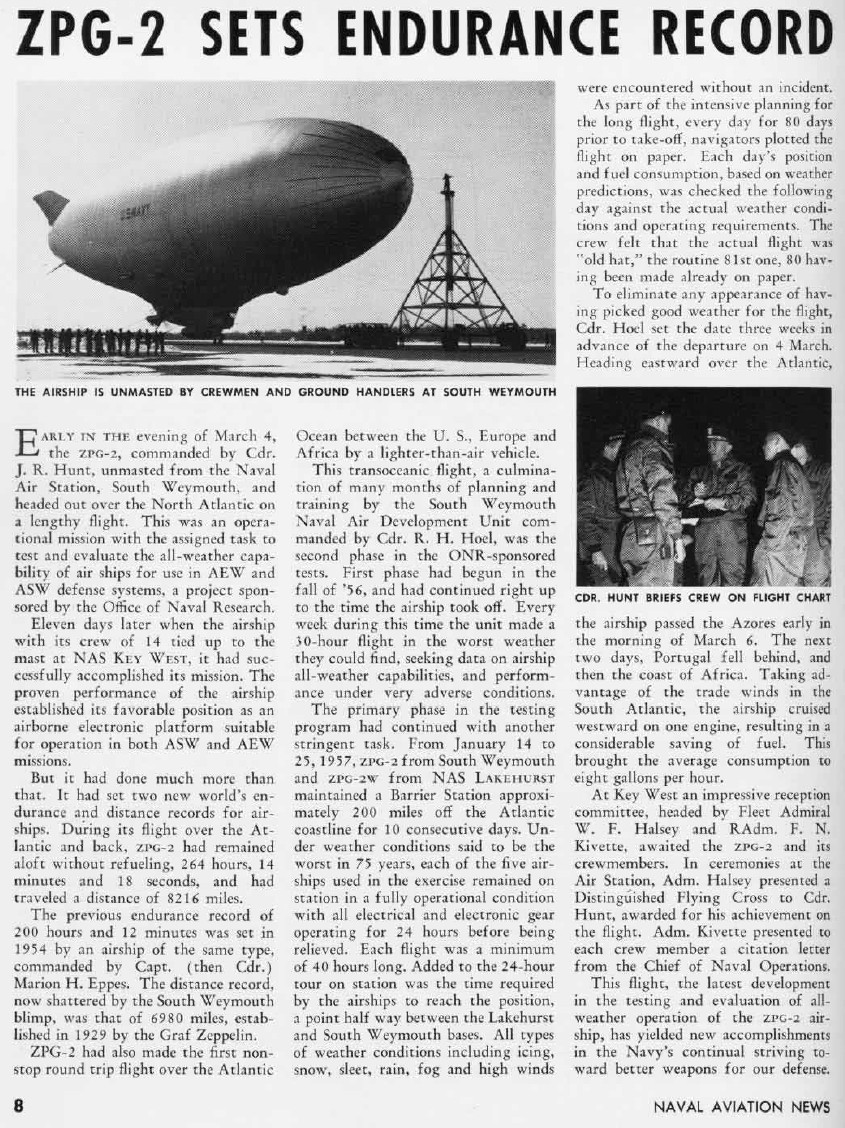
8216 miles in 264 hours = 31 mph
31 miles divided by 8 gallons of avgas = 3.8 miles per gallon
Far better than HTA aircraft!....but only slightly better than the MPG of a M113 Gavin light tracked AFV's 3.5 mpg admittedly a diesel.....but not as good as if the latter had a hybrid-electric drive and 7 mpg
Here's the LTA question for today...
What if the 2007 LTA blimp were diesel-electric with solar panels on top?
In sunny weather the diesel engines could be shut down and solar would power the batteries/motors....
We should get 2x the range to 16, 000 miles @ 2x the fuel economy (8 mpg) all other aspects being the same....plus diesel/JP-8/biodiesel is safer and potentially renewable....couple this with modern dipping sonar and improved MAD and weaponry, we'd finally have a long-range, long-endurance ASW platform at sea!---AGAIN.
Instead of a Supercarrier Egocentric Force how about a marine egocentric Navy?
The following is an article by establishment darling Frank Hoffman. Hoffman is always trying to subsidize his old ego club, the marines.
He like the others, doesn't start with reality and just offers his opinion---like assholes everyone has one. His opinion is no better than anyone else's just because he asserts it. He is making an argument-by-assertion just as weak as the Navy's argument-by-assertion to have a 313 ship fleet.
1. Planet Earth
How big is it?
How much naval power does America need over the earth to keep our sea commerce of cargo ships and oil tankers going in the face of enemy attacks?
How much sea power do we need to keep enemies from using the water to attack America?
Hoffman and others need to cut their crap and start with this reality.
Affordable container ships converted into escort carriers to the tune of 100 that can also act as mobile bases during sub-national conflicts could smother our enemies over the still very large earth. We needed over 100 small carriers to win WW2, why would we need less today when the submarine and air threats are 100x more deadly? Anything less than this blanket coverage and our oil tankers/cargo container ships don't get through.
We also need to get our heads-out-of-our-asses and come up with naval forces to secure oil platforms from pirates and prevail in mine-sweeping and ASW which we are fatally neglecting. This means LTA blimps and seaplane/land patrol planes to scour the oceans to keep them clear of enemy submarines.
2. Human Threats
Is the USA going to go around the world and take-over countries to hog up oil and other natural resources, yes or fuking no?
Hoffman would have us build a resource-grabbing force that comes by the sea which is immoral. Its not only immoral, its INCOMPETENT. It would have us pack thousands of narcissistic marines like sardines in vulnerable surface ships asking to be slaughtered as the HMT Rohna was hit by a German guided munition in 1943 killing 1, 000+ Americans. If you are going to conquer the world you don't do it with things that will lead to your defeat in a world proliferating with D-E subs, sea mines, attack planes and ASMs.
The surface ship amphibious ship packed with marines is a deathtrap and needs to go away.
When we land forces the seas must be clear of all threats and they land with "sunday punch" to prevail against the best nation-state foes; they are completely light-medium-heavy mechanized air-ground maneuver formations not foot slogging ego-victims. These forces have their mechanized means in sealift ships and the men themselves LINK UP BY LONG RANGE SEAPLANES. Another option would be C-17 STOL airland/parachute jump to link up with off-loaded tracked AFVs. Anything on the water's surface for small evacuations/raids on hoistile nation-states needs to be HEAVILY ARMORED as in an Iowa class battleship or coming from a submarine. Naval amphibious power projection needs a complete reform and disbandment of the egomarines would be a great place to start. We don't need a multi-billion dollar evacuation/demonstration force.
The Flimsy Surface Ship Pork Racket: "We never have enough sealift" to do anything
Destroying perfectly good ships gives navy/marines ready-made excuses to "never have enough" so maybe they will not have to be sent anywhere to fight and gives illusion that new ships need to be built frantically to make everyone rich and egotistical. Its a giant racket.
Washington Post
March 5, 2007
Pg. 15Going Down With The Ships
By Craig Hooper
Over the past six years, 79 condemned Navy ships have been towed out to sea and destroyed by Air Force bombs, submarine-launched torpedoes or hails of gunfire. These exercises, long considered the most "cost-effective" way to dispose of unwanted naval vessels, have eaten away at America's inventory of still-useful retired warships. Soon every vessel capable of serving in America's reserve combat fleet could vanish, leaving an overextended Navy with no viable backup forces. This unwise drawdown goes against Navy tradition. As the Navy budget, already under pressure because of the wars in Iraq and Afghanistan, is hoarded for new shipbuilding initiatives, the inactive reserve, an emergency fleet of second-string warships, is quietly becoming a sham. Denied maintenance funding and protected only from "fire, flooding and pilferage," decommissioned warships are quickly deteriorating past any hope of recall. The aircraft carrier USS Constellation, "mothballed" in 2003, went from the battle fleet to designation for the artificial-reef donation program in a mere three years.
Since being sworn in early last year, Secretary Donald C. Winter, a former Northrop Grumman executive, has headed a Navy that is continuing to dispatch vessels with an efficiency unseen since just after World War II, when the battle fleet was chopped from 6,768 ships to 634.
Important reserve warships are disappearing. The USS Belleau Wood, an amphibious assault vessel used to carry helicopters and marines, returned from a Persian Gulf deployment in 2004, was decommissioned in 2005 and was sunk just eight months later.
At one time, prudent thinking would have dictated that the Belleau Wood undergo a life-extending refit and return to service for 15 more years. But that mind-set is long gone. Meanwhile, a better candidate for target practice, the former USS New Orleans, a helicopter carrier decommissioned in 1997, rots away, still waiting to be sunk.
As the United States confronts an enormous budget deficit and a looming shortage of already overtasked amphibious assault vessels, the expense of mothballing -- and in an emergency, repairing and operating -- venerable marine "Gators" might seem trivial compared with the cost of the replacement vessels, the Northrop Grumman LHA(R) assault ship.
Even relatively fresh vessels are being wrecked. According the Naval Vessel Registry, the ex-USS Valley Forge, a billion-dollar anti-aircraft and missile-defense cruiser (also made by Northrop Grumman), was blasted after serving barely half of an expected 40-year lifetime. Four other recently decommissioned Aegis cruisers will probably follow suit.
This flurry of ship disposal suggests the administration is getting rid of useful warships to compel construction of pricey new vessels such as the next-generation CG(X) anti-missile cruiser or the $3.3 billion DDG-1000 land-attack destroyer. When the Clinton administration pruned the national stockpile of reserve destroyers, only eight feeble, 46-year-old hulks went to the bottom. But the Bush administration has sunk (so far) a 31-year-old fleet of 27 destroyers. Twenty-two others have been scrapped or sold, and additional disposals are pending.
In this carnage, virtually all 31 of the country's middle-aged submarine-hunting Spruance-class destroyers have been sunk, scrapped or scheduled for destruction. As China readies a deep-ocean submarine fleet and more navies deploy cruise missiles on ultra-quiet diesel submarines, the rationale for eliminating a mothballed reserve fleet of sub-killing destroyers is scanty at best. The administration is destroying a cheap insurance policy.
An inactive reserve has always been a national safety net. The country's first large warship, the frigate USS United States, was maintained in mothballs after the Revolutionary War and returned to fight during the War of 1812. In the early days of World War II, when Britain and Canada needed anti-submarine escorts to fight Germany, reserves provided 50 World War I-era destroyers on short notice. After World War II, prudent Navy leaders invested $213 million to mothball a "Ghost Fleet" of 2,000 surplus vessels. That supplied 381 much-needed warships during the Korean War, including 13 aircraft carriers and two battleships. Other ships were recalled for Vietnam, and even the enormous Iowa-class battlewagons returned to finish out the Cold War.
Some tired Navy assets will always be sunk. Sinking exercises grant an unparalleled opportunity to hone ship-killing skills while simultaneously collecting data that can make new vessels less vulnerable. Real battle data are so valuable that during World War II, the Navy shipped a bombed-out destroyer, the former USS Welles, back from Europe for research. But now, rather than extract all possible value from stricken ships, America appears uneager to study many of its sinking exercises.
This is no way to run a navy. With each sinking, the Navy risks becoming a hollow force, dependent on the construction of pricey ships that, given America's overextended finances, may never arrive.
The writer is a lecturer at the Goldman School of Public Policy at the University of California at Berkeley. He served on the Chief of Naval Operations' Maritime Strategy Working Group at the Naval War College last fall.
This article below provides some interesting points for the shipbuilding porkster/racketeers. The use of Corbett makes it valuable to us since the "Corbett fleet" has the maritime power flavor that we want to advocate but not with stupid marines in trucks. Obviously, we don't advocate 55 x LCS type ships, but the low draft unmanned Monitor isn't a bad concept, we would scrap his San Antonio based fire support ships in favor of 24-32 "Fast Expeditionary Combatants" that get from point A to B quickly with the mechanized sunday punch after the way is cleared for them not linger in the oceans for months asking to be attacked and sunk.
The fleet we need: A look at alternative - and affordable - futures for the U.S. NavyBY FRANK HOFFMAN
"We require for the guidance of our naval policy--something of a wider vision than the current conception of naval strategy, something that will keep before our eyes not merely the enemy fleets, or the command of the sea, but also the relations of naval policy and action to the whole area of diplomatic and military effort."
- Julian S. Corbett, British naval historian
Alfred Thayer Mahan inexplicably remains the touchstone for U.S. naval force planning, despite his weak relevance to this century. In his day, Mahan was a useful advocate for an emerging power in need of a strategic rationale for investment in a powerful fleet. Yet, Mahan's emphasis on cataclysmic clashes of capital ships concentrated in deep blue water fulfills only an outdated lust for future Jutlands or Nelsonic musings of modern Trafalgars. The American Navy continues to routinely inhale antiquated Mahanian fumes despite his narrow use of history and today's dramatically altered strategic situation.
One need not look far for Mahan sightings. At this year's Current Strategy Forum at the Naval War College, both Chief of Naval Operations Adm. Mike Mullen and Navy Secretary Donald Winter cited Mahan in their speeches. Actually, the CNO mentioned one of Mahan's enduring strategic applications, the influence of navies upon nations, people and history. Mahan may have been a better advocate than historian, but he got this point right. It is an excellent starting point for a belated effort to redefine both the strategic basis for America's Navy and the resulting force architecture.
But there is another naval strategist with a better grasp of strategy and history, a broader understanding of the use of maritime forces, and more joint approach. Such a framework will better serve the U.S. as it strives to transform today's overwhelming military combat power into tomorrow's agile post-Cold War armed services.
This article explores the nature of tomorrow's Navy by examining and expanding on an incredibly detailed Congressional Budget Office (CBO) study authored by Eric Labs, who is recognized as one of the nation's premier naval analysts and an objective expert in costing naval programs. This extensive CBO study comes on the heels of a long debate on alternative fleet designs in 2005. Over the past year, Congress has become increasingly concerned about the Navy's inability to:
• Consistently articulate a rationale for the fleet.
• Provide a compelling fleet architecture or design.
• Argue for a fleet large enough to maintain the shipbuilding industrial base.
• Properly manage the sharply rising costs of Navy procurement programs.
The accumulating dissatisfaction and management failures are leading to a crisis in future fleet capabilities. In the past year, Congress has directed agencies outside the Department of the Navy to provide alternative fleet designs, publicly criticized the Navy's leadership and called for independent costing agencies to give the Congress an objective basis for measuring naval costs.
The Navy, for the third time in a little more than a year, offered a long-term shipbuilding plan in February.
This plan defined a 313-ship Navy, a modest increase in current force levels. This was almost immediately criticized, however, by key think tanks and the Congressional Research Service as wildly unaffordable. In the CBO's latest report, the new Navy-planned fleet and aircraft acquisition profile would require almost twice as much funding as the recent average for naval procurement.
For background, the Navy has averaged a bit over $10 billion per year for ship construction over the past decade. The Navy argues that its plan costs between $13.4 billion and $14.4 billion per year and assumes that reduced operations and maintenance costs can be shifted to acquisition due to the newer ships being brought on line. CBO questions the Navy's methodology and budget assumptions and finds the Navy's proposed fleet would have an average yearly procurement cost of roughly $21 billion.
The main conclusion of CBO's analysis is that unless shipbuilding budgets increase significantly or the Navy designs and builds much cheaper ships, the size of the fleet will fall substantially. Most defense analysts do not think resources can be increased or that costs can be adequately reduced. Nor has the naval leadership resolved how best to meet competing demands for a force that can make a substantive contribution to today's "Long [sub-national] War", or materially defeat a competitor in the next [nation-state] war. This is no agreement on what that next war might look like, although the Navy's staff seems intent on making China into the second coming of the Japanese or Soviet fleet. There is an internal drive to make China into a robust blue water threat in a reprise of War Plan Orange.
Composition of the Navy's Fleet
The current U.S. Navy battle force fleet numbers 285 combat and support ships, including 12 aircraft carriers, 14 ballistic missile submarines, 53 nuclear-powered attack submarines and four guided missile submarines.
The new CNO submitted his 30-year ship construction plan to Congress in February, which includes a requirement for 313 battle force ships. That plan is built around 11 carrier strike groups and nine expeditionary strike groups (a 25 percent cut) and reduces the current maritime prepositioning fleet by a third. It should be noticed that as the Navy gets bigger, from 285 to 313, the only cuts come from expeditionary power projection forces. This says something about the nature of the threat the Navy is focused on - or perhaps more about extant internal institutional prejudices in the absence of a national maritime strategy.
Required resources
To execute its ship-construction plan, the Navy must buy 275 ships from now through 2035 - an average of 9.2 per year. The Navy estimates that procuring those ships would cost about $14.4 billion a year, whereas CBO estimates that they would cost about $19.5 billion annually. Other ship construction/maintenance costs the Navy would face, such as nuclear overhauls, increase the average annual shipbuilding budget to $21.6 billion, according to CBO estimates. When you factor in CBO's cost estimates and budget assumptions, it is clear the Navy's plan is based on questionable resource availability estimates that are significantly higher than the past few years. Such rosy projections do not square with most analysts' views of expected increased pressures on the defense budget.
The CBO's study makes clear the significant delta between the Navy's plan and recent historical spending trends. The biggest gap between the Navy's plan and projected affordability is ship procurement. The Navy is clearly projecting that future resources for new ship construction will be significantly higher than past trends. It is one thing to hope for a windfall, but it is entirely something else to base the Navy's critical procurement decisions on a fantasy. Not only is the plan unaffordable, according to CBO, it is not executable, either. It does not achieve the 313 ships the Navy claims it does. The size of the battle force fleet would initially rise under the Navy's plan as the new Littoral Combat Ship (LCS) entered the inventory. The fleet would peak at 330 ships in 2019 but then gradually decline to 294 by 2035 - 19 less than the 313-ship "requirement".
The most critical implication to take from this detailed and balanced analysis is the conclusion that the Navy's shipbuilding plan is based upon a number of optimistic assumptions that cast its validity into severe doubt. This assessment will only further undercut whatever credibility the Navy has on the Hill. Second, this study highlights the severe pressure upon Navy programmers to construct and fund the future fleet. Third, it highlights the need for a serious debate on exactly what sort of Navy we need.
If the Navy does not receive or cannot devote more budgetary resources to ship construction in the future, to what extent can it modernize its fleet? To address that question, CBO looked at five options in which the Navy could keep its total ship and aircraft procurement, operations and maintenance costs at an average of about $43 billion annually over the next 30 years (see chart, "Current, planned and alternative U.S. Navy fleets"). CBO chose those alternatives to illustrate the potential consequences if large and sustained increases in funding for ship construction do not occur.
With respect to the options, the Balanced Fleet is not all that balanced, as it was flawed by its starting point - the unaffordable and overestimated Navy 313-ship plan. The Balanced Fleet is a hedging methodology; it has no strategic direction. Under this option, aircraft carriers, and thus the number of carrier strike groups, are reduced to seven. The CVN-21 carrier would be delayed from 2008 to the 2020s. The number of expeditionary strike groups declines to seven (from 12), and the amphibious ships in those strike groups would be cut in half. Submarine forces would be reduced by about one-third. The number of ballistic missile submarines would decline from 14 to 10, and the number of attack submarines would fall from the planned 48 to 35. The total number of battle force ships would increase from 285 to 299 in 2020 and then decline to 217 by 2035.
The Mahanian fleet modernizes the Navy by acquiring all three of the service's new surface combatants but far fewer other planned ships. In a twist that Mahan might not have agreed with, 82 littoral combat ships are acquired rather than the planned 55. To pay for the new surface combatants, aircraft carriers, attack submarines and amphibious ships are cut substantially. The carrier force is cut to seven; the first CVN-21 class carrier would be bought in 2026. The attack submarine force would decline by nearly 40 percent to 30 boats. The amphibious force would be reduced by more than half, the number of expeditionary strike groups would decrease to six and the Maritime Prepositioning Force (Future) program, or MPF (F), would be terminated. The number of Arleigh Burke destroyers and their replacements would drop from the planned 62 to just 28. The total number of battle force ships would rise to 300 in 2020. By 2035, however, the fleet would number 246 ships, one-third of which would be the maneuverable "Street Fighters." I think Mahan would trade 80 LCSs for eight cruisers.
The Midway option emphasizes aviation-based strike capability and preserves a carrier-based Navy of 11 aircraft carriers over the long term. The Navy would buy six CVN-21s between 2006 and 2035, one every five years. To pay for keeping 11 aircraft carriers and 10 deployable air wings without a real increase in funding, this option would result in the severe reduction or elimination of almost all other naval acquisition programs. CBO estimates that the Zumwalt-class destroyer would be canceled, the CG(X) program pared from 19 to eight ships, and LCSs cut from 55 to 40. The attack submarine force would drop to 30 boats, and the amphibious force would drop to just 13 ships. This alternative would result in the smallest battle force fleet of all the alternatives in the study, dropping to 189 by 2035.
The Stealth fleet is intriguing, offering the foundation for a fleet that is substantially subsurface and presumably more difficult to track, target or interdict. This option maintains 55 attack submarines over the long term, as well as 10 ballistic missile subs and four nuclear-powered cruise missile submarines. To maintain a 55 attack-boat fleet, the Navy would have to delay or cancel most major ship programs. Carriers would be reduced to eight, with just three CVN-21s purchased over the next 30 years. The Zumwalt and CG(X) programs would be canceled, and the number of large surface ships dropped to 31. Amphibious ships would be reduced to 13, and the sea-basing-capable MPF(F) eliminated. Under this option, the size of the Navy battle fleet eventually decreases to 219 ships. It may support a useful capability for guerre de course against a country with extended lines of communication like China, but it brings a limited strike capability and poor support for power projection ashore.
My own option is based on the teachings of Julian S. Corbett, the British strategist/historian who emphasized the use of a navy to serve joint operations ashore. Rather than supporting the Navy's focus on future hypothetical threats, this option exploits our domination of the global commons to improve our capacity to execute sea denial in key choke points and penetrate ashore against real threats we face today.
This alternative reduces the carrier force to seven and buys only two CVN-21s between 2006 and 2035. Instead of pulsed strike power, the emphasis would be on long-range unmanned systems. By 2030, an unmanned combat air vehicle squadron should be a key component of each carrier wing. The Zumwalt DD-1000 program would be canceled to save money, and the number of Arleigh Burke-class destroyers cut to 38. Because this option emphasizes operations on and close to shore, it would buy 55 LCSs. This alternative maintains nine expeditionary strike groups to ensure sufficient amphibious ships to support any future expeditionary operation. A four marine expeditionary brigade lift is retained, with a split of 2.0 amphibious lift level and 2.0 brigade equivalents in two squadrons of re-leased prepo ships. Future sea-basing technologies would be incorporated to the greatest degree practical but not through new ship design and acquisition.
As did CBO in its seabasing alternative, this alternative argues for a new type of ship to provide the fire support capability of the canceled Zumwalt-class destroyer. The new vessel - referred to here as a Fire Support Ship - would consist of a San Antonio-class amphibious ship fitted with two Advanced Gun Systems (total magazine of 900 shells) and 16 Vertical Launch System cells for launching missiles. To further increase sea-based fire support, the development of an articulated set of floating batteries, called Monitors, is suggested. Each Monitor is armed with the Advanced Gun System and 300 rounds and would deploy with both of the MPF squadrons. The Monitor could be extremely low draft and unmanned for operations in shallow littorals to provide more responsive and efficient fire support to joint forces operating in the littorals.
Overall, this option would expand the Navy's battle force fleet from 285 ships today to 323 by 2020, but slowly drop to 255.
Comparing capability
To evaluate the different approaches and the resulting capabilities of various options, CBO used a variety of measures. These help compare the options with both the Navy's shipbuilding plan and the current fleet (see chart, "Fleet capabilities in 2035"). Of the approaches analyzed in this study, the Navy's 2006 shipbuilding plan would provide the greatest capability, according to most measures - but at the greatest cost. The alternatives offer less overall capability than that plan and than today's fleet. Most of the plans do not have a big capability shift between now and 2020, assuming that current ships are permitted to retire at expected end-of-service-life dates. By 2035, however, the strategic orientation of each option is more pronounced.
The Corbett fleet offers a range of capabilities that appear well-suited for today's age, at an affordable price. Well-grounded in Clausewitz and the correlation of policy and strategy, Corbett placed special emphasis on commercial interests and economics. Those seeking to capitalize on the "global commons" and the growing velocity and interdependencies of global trade need to ask, "What would Julian do?" Corbett's grasp of the importance of sea lines of communication stands in marked contrast to Mahan, both offensively and defensively. He argued for distributed maneuver of cruisers to protect friendly lines and choke points. Additionally, he noted the fleet's wonderful opportunities to menace the opponent's capacity to sustain operations or his economy at the outbreak of hostilities. Given the energy-dependent nature of some growing economies, this point needs to become more prominent in our strategic thinking.
With regard to military operations and doctrine, Corbett is especially pertinent, as he eschewed Mahan's slavish devotion to concentration of the fleet. Like Liddell Hart and John Boyd, Corbett understood that dispersal maximized the effect of the fleet's ability to exploit surprise, flexibility and complexity relative to the opponent. The ability to reaggregate the fleet at the right time and place remains important, he would acknowledge. Corbett is clearly having an influence today as the emergent Naval Operational Concept is pregnant with discussions regarding distributed operations, the antithesis of one of Mahan's canonical principles.
Support to joint [EDITOR: marine egomaniac] operations ashore was another Corbett fundamental. Well before it was fashionable, he stressed the interrelationship between navies and armies. In this regard, he was optimistic about amphibious warfare although he was suspect about the prospects of effective naval fire support for joint operations ashore. He would be impressed with the Navy's range and the volume of the fleet's strike capacity today, but probably dispirited by the emphasis on expensive missile-delivered munitions, ideal for waging war against states with critical infrastructure and static targets.
The CNO is right that it is time for a new maritime strategy, one that shapes and defines the purpose and capabilities of tomorrow's fleet. The new shipbuilding plan is neither fiscally supportable nor "a wider vision than the current conception of naval strategy." As Corbett argued, we should not focus just on potential enemy fleets or the command of the sea, but also the relationship of our fleet to our strategy aims. This fleet cannot be built to Mahan's late 19th century precepts, it is time to stop lighting incense at poor Alfred's bust at Newport. We need to embrace Corbett, an astute geo-strategist who insisted that navies serve national political objectives, not just war fighting or institutional prerogatives. [USMC prejudices are AOK, right, Hoffman?]
Navy and marine brass lie cleverly about how "balanced" they are to do a "full-spectrum" of operations but the wise person will look at WHAT THEY ACTUALLY HAVE and what they EMPHASIZE to see they are dishonest incompetents. Not only do they not operate the necessary battleships, seaplanes and blimps to do sea control well, they do not operate the manned observation/attack planes or the light tanks needed to fight on land well; in our Non-Linear Maneuver Brigade (NLMB) proposal we go into detail about the types of ships and air and ground forces required that neither the Navy or idiotic marines bent on re-enacting their favorite parts of WW2 are not interested in. Especially infuriating is the boasting that we will team up with allied navies in even larger clusterfucks of surface targets for the enemy to easily sink to be Admiral Mullen's "1, 000 ship navy"--any excusive band aid is welcome so the U.S. Navy and marines don't have to admit to error and reform themselves. These guys are too busy making up lies to fit the current environment to read their own naval military history to see how allied ship clusterfucks work in actual war: Admiral Hart's American-British-Dutch-Australian (ABDA) force that was wiped out by the Japs in 1942. Holding hands of weakness doesn't necessarily create the needed strength UNLESS KEY TECHNOTACTICAL MISMATCHES ARE SOLVED. When these dumbasses left their seaplanes ashore they were easily sunk by the Japs who used their cruiser-launched seaplanes to direct their naval gunfire onto the allied ship clusterfuck.
The U.S. Navy's factions 1-5 are clusterfucked around the supercarriers or the amphib carriers to re-enact feel-good WW2; either "Fast Attack Carrier Task Force 58/38" or "Iwo Jima" with plenty of marine narcissists with a U.S. flag in their rucksacks to do a Suribachi photo op on cue. All of these fools unaware that their future is replicating the sinking of the USS Indianapolis; dying of exposure in the water, dying of thirst and devoured by sharks. A balanced Navy of WW2 was at least able to rescue 300 or so of the 900 men exploded into the water because it had plenty of long-range patrol planes to include seaplanes able to land and save them. Today's unbalanced supercarrier Navy offers THOUSANDS of men to be exploded into the water with no one to rescue them and not even the modicum of survival gear on each sailor; perhaps issuing out cyanide tablets might be the humane things to do if on a U.S. Navy ship in the 21st century?
CONCLUSIONS FOR TODAY
Now things get really, really dicey.
Control of the sea happens beginning in the sea in 3 dimensions, not just on the surface in 2 dimensions.
Above water = aircraft
3D
__________water surface 2D = surface ships______________
3D
Under water = submarines
______________________________undersea land bottom____________________
3D
Underground = sensors
What's fascinating is there is another 3D battlespace in the ground at the bottom of the ocean that can be used to lay sensors as well as sea mines. The Naval battlespace actually has a 3D air space above, a 2D one on the water's surface, a 3D one underneath in the water and an additional 3D space in the ground on the bottom of the ocean.
The main ship killer from WW2, the torpedo has gotten even more deadly, its GUIDED so it can turn to hit ships even if they zig-zag and take evasive action. This means surface ships as well as subs cannot afford to be detected in the first place, yet ships today are cheapo, less armored and more mental gadgetized versions of WW2 ships as per the RMA missile madness.
Dr. Carlo Kopp's superb web page reveals 32 x ALLIED SHIPS WERE HIT BY GERMAN GUIDED WEAPONS IN WW2 beginning in 1943.
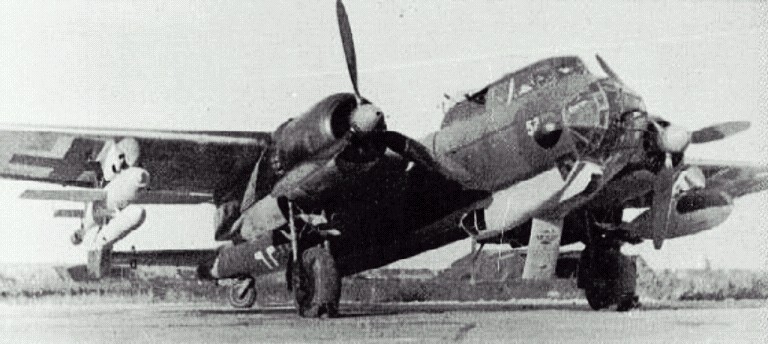
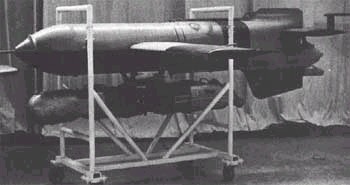
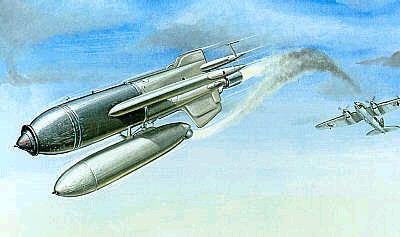
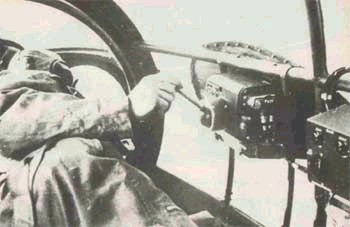
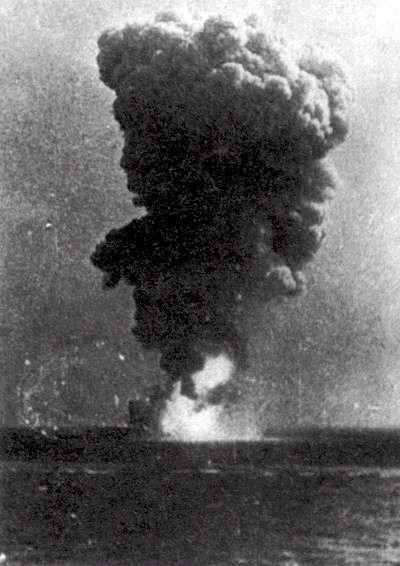
Hs293 ASM
www.youtube.com/watch?v=gQ5UAEVyyfk
This BS that guided missiles are a POST-WAR INVENTION OF US, THE ALLIES IS A LIE.
We smothered Germany with maneuver numbers...and not a SECOND too soon.
So now add the anti-ship missile which is nothing more than the bomb being guided or the Jap Kamikaze plane without the suicidal human. ASMs are now the #1 main ship killer thanks to our stupid lack of armoring and their greater speed and 360 degree from any direction attack angle.
Its only OFFENSIVE navies of militaristic nation-states that want to push other nations around with fleet duels or LA that sometimes want floating air bases to get airplanes up in the air in the middle of oceans out of easy reach of land-based planes. What is this navy going to do in the middle of the Pacific or Atlantic oceans with only a handful of large aircraft carriers? Hunt subs? With a handful of slow and short ranged HELICOPTERS? No, the best way to do this is with a LOT OF SMALL AIRCRAFT CARRIERS and patrol planes from land/lagoon bases, neither of which the large-aircraft-carrier-is-it-and-must stay-the-center-of-attention U.S. Navy idee fixe brass is interested in doing! What's the most efficient way to do LA? By battleship and cruiser guns and if targets are deeper inland by heavy bombers. The Navy could participate in this by offering a 600 mph jet seaplane bomber, the P-6M SeaMaster, but this threatens the last excuse to have large aircraft carriers, so the program was cancelled. The large aircraft carrier is there as an end unto itself, for the USN bureaucracy to have an excuse to suck up $BILLIONS of tax dollars and order people of lesser rank around. We have become the Japanese, we have become our own worst enemy.
No, in WW2, the Japanese and American fleets were there in the middle of the sea FOR THEMSELVES. Its all about THEM. They exist for themselves. All the large aircraft carrier is, is a replacement of the gun battleship with aircraft for a feel-good nation-state pride and honor duel. The large aircraft carrier is really a floating air base. Its then two large visible air bases fighting each other for their own selfish ends. You may say, they are fighting for "supremacy on the sea and air", but you can do this better with MORE AIRCRAFT from MORE SMALL AIRCRAFT CARRIERS. You may say; "the large aircraft carrier has more planes than 1 small aircraft carrier and is better armored". Not so, we are talking about many, many more small aircraft carriers which means GREATER DISPERSION plus MUCH MORE AIRCRAFT. If you armor the small aircraft carrier its also a smaller target that will be harder to sink than the larger, easier-to-spot-and-direct-hit large aircraft carrier. So instead of the current 11 large American aircraft carriers with 800 planes, we should have 33 small aircraft carriers and 1500 planes. Every cruiser and destroyer should also have a seaplane or VTOL/STOVL fighter to add to this number to control the skies above and the water below with long-range ASW. Twice the planes with three times the ships instead of half the planes with 1/3 the ships into an absurdly less than a dozen targets---the enemy only has to get lucky 11 times. In WW2, we lost 11 aircraft carriers out of 124 carriers! Now imagine if ALL of the enemy's attacks have to focus on were just 11 carriers! Too many eggs in too few baskets, means no eggs.
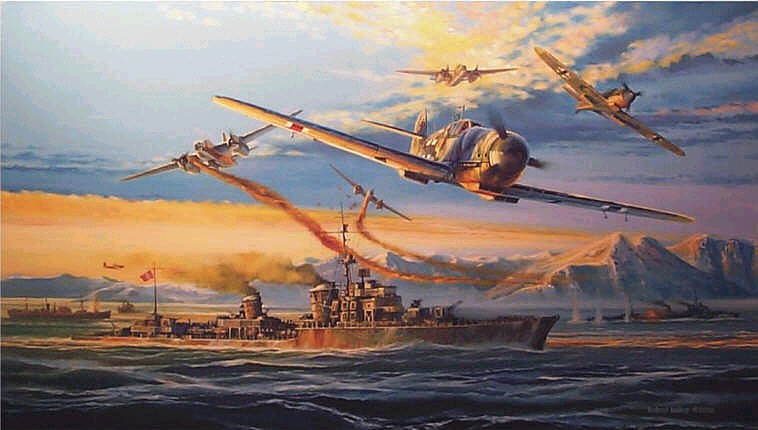
Here, German land-based fighters were able to defend their surface ships close to shore from British bombing attack
And the enemy doesn't have to play if he doesn't want to. If a nation doesn't want to come out into the big blue ocean and duel with our offensive navy's 11 knights, it can stay close to shore and lure in the handful of clumsy knights to be saturated by a sky full of longbow arrows (hundreds of ASMs). . If there are enough land chunks (islands) shipping lanes can be secured by aircraft operating from those bases with surface ships as the AAW, ASW and AsuW escorts. In other words, we can't take away the enemy's shipping lanes by surface action if they have them protected by land-based aircraft and escort ships with effective ASW. Our only hope is our own subs, but in the rock, paper, scissors of war, subs do not defeat aircraft. Some have suggested submarine anti-aircraft missile pickets, but to fire the sub will have to surface or if SAMs could be developed to launch from underwater, their exhaust plumes will show the enemy where they are. Would SAM missile subs be enough to stop an enemy air force from taking the air? If SAMs from ships that stay on the surface all the time are not enough, what makes you think they will have any greater effect from a submarine that spends less or no time on the water tracking enemy air targets?

However, if your aircraft carriers do not have fixed-wing ASW planes/capabilities to stop submarines---like the fatal flaw of the Japanese carriers---then they cannot control the sea. Secretary of the Navy and first Secretary of Defense James Forrestal states that ASW must be a top priority. Look what it got him? He was later thrown out of a hospital window by some government killers.
If you don't stop submarines you cannot control the sea.
Sea Control anyone? Reality Check! What do we do about the Mess we are in today?
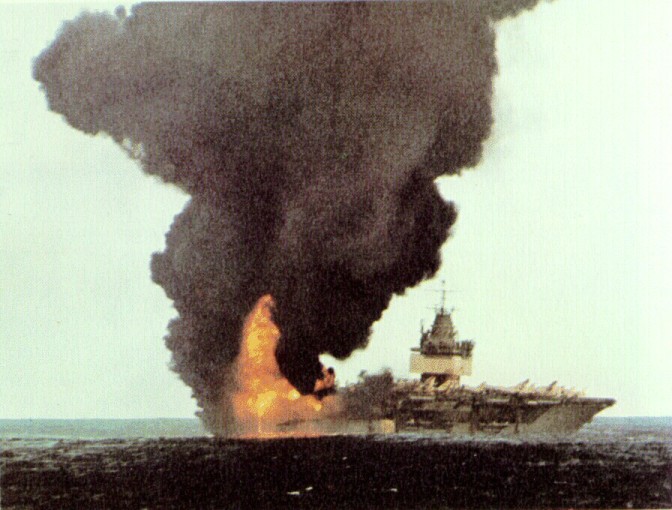
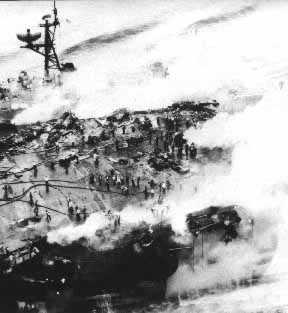
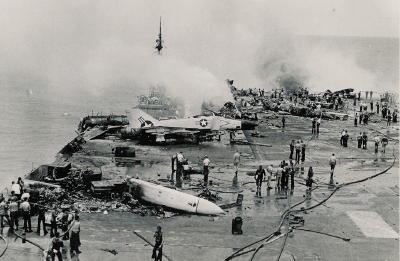
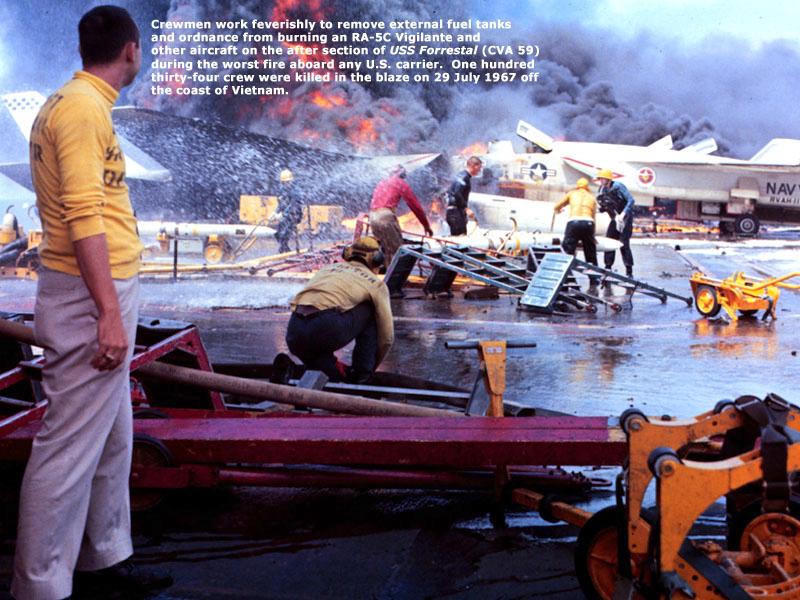
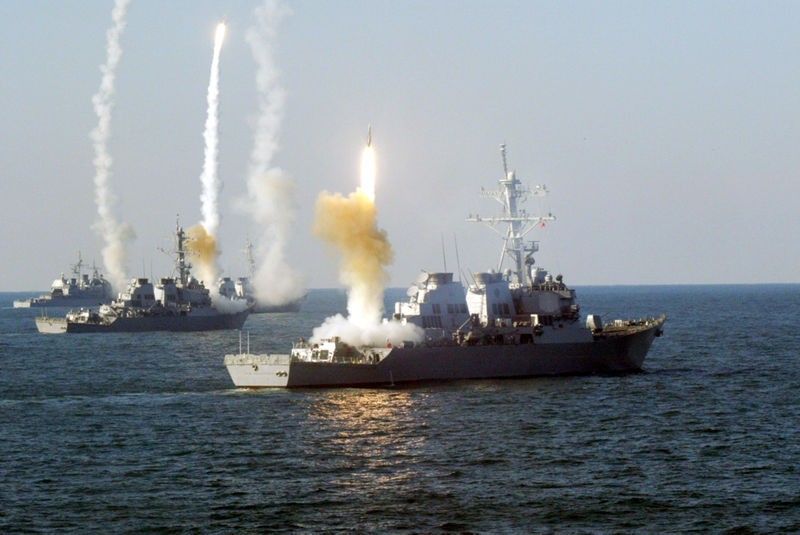
Its the height of hubris to think that our 11 aircraft carriers will be untouched and able to operate aircraft to fly CAP in an all-out missile war against a capable nation-state foe like Red China. We lost 11 aircraft carriers in WW2. Its down right fatal to make the same mistake of the Repulse and Prince of Wales and several other USN ships (see USS Pringle) to think their onboard anti-aircraft weapons will be enough to ward off multiple enemy air attacks at the last second once they are upon you. The best way to defeat air attacks is to SPOIL them with your own aircraft.
Carriers eat aircraft. We should equip carrier plane fuel tanks with pop-out floats to at least salvage some of their expensive gear if they fail to land and go over the side.
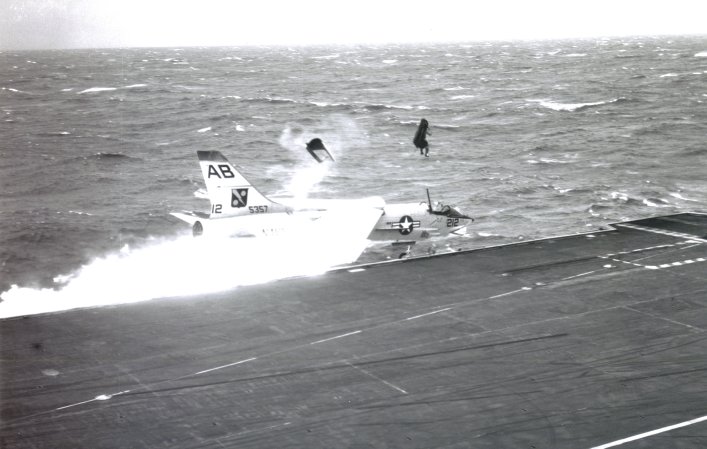

Zumwalt's Sea Control Ships: he was right all along
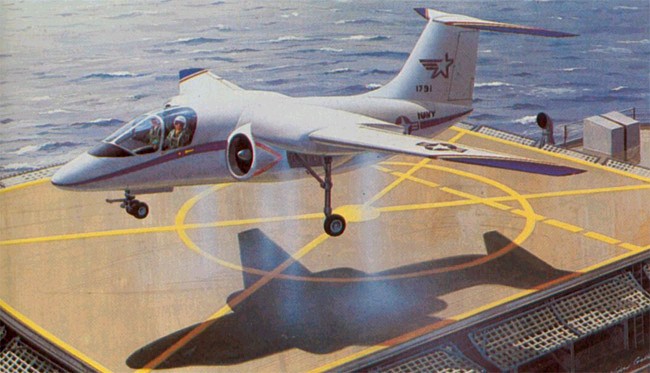
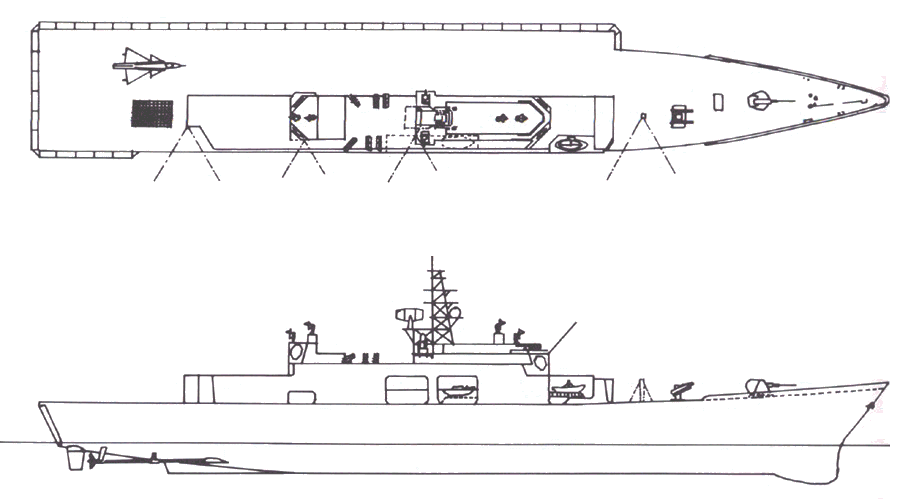
I guess we're playing catch-up...Zumwalt had this figured out long ago with his sea control ships (SCSs) in the 1970s...we need LOTS of ships with LOTS of aircraft to control the sea.....smaller aircraft carriers and V/STOL or STOVL seaplanes threatened the BS egomaniac aircraft carrier "mafia" who wanted and still want to do things the old warmed-over WW2 way and as soon as he was gone they went back to the crap handfuls of overly large aircraft carriers that can't put up enough or the quality of aircraft we need to control the sea...
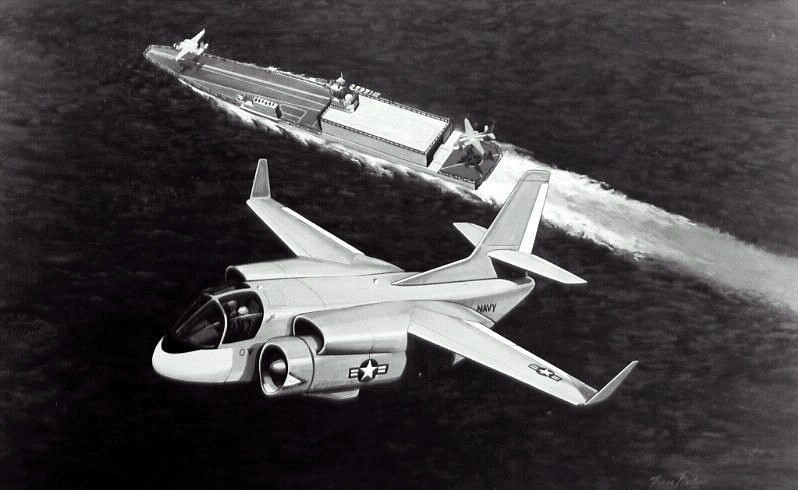
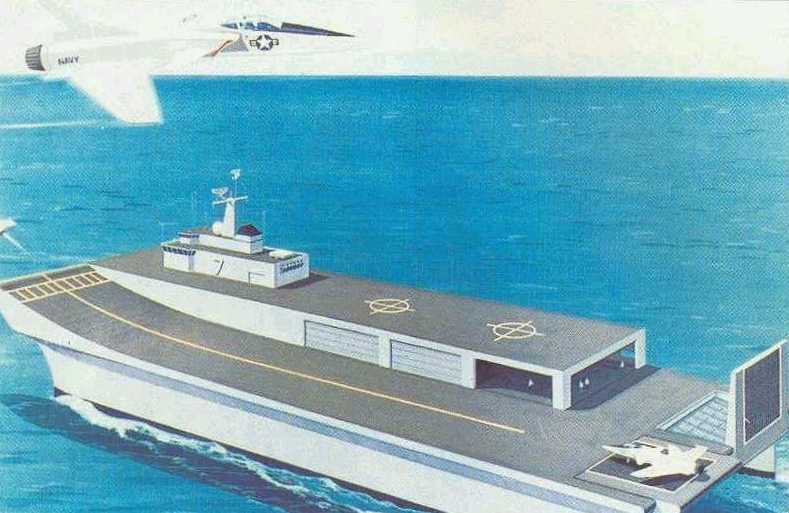
This web site below has an AMAZING documentation of the V/STOL sea control ship effort....
www.secretprojects.co.uk/forum/index.php?topic=103.75
The Grumman 698 tilt-engine V/STOL aircraft would have been a great way to accomplish multiple missions without even needing a SCS small aircraft carrier. ASW, AEW, ASuW and land attack delivering SEALS or marines could have been done from the fantail landing pads of existing cruisers, destroyers and frigates at far greater speeds, ranges and combat power than the current slow and short-ranged ASW helicopters now in use.
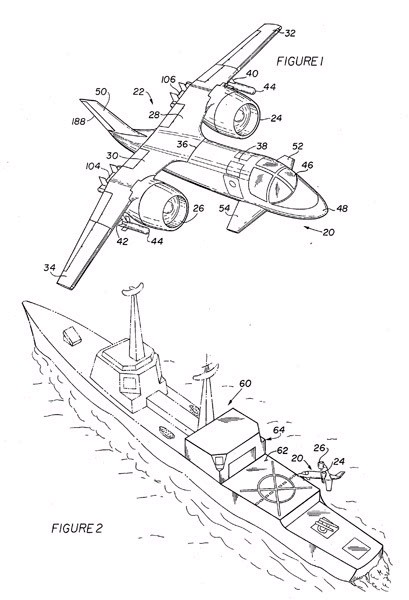
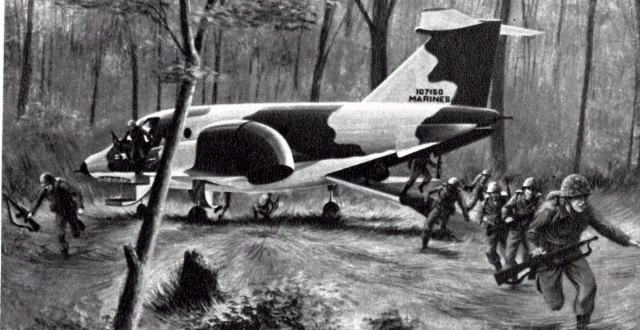
Another radical concept was to have a V/STOL aircraft like the bending fuselage "nutcracker" hover next to the ship and be snatched by a crane and brought on board.
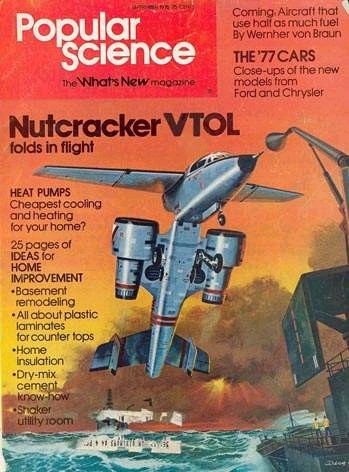
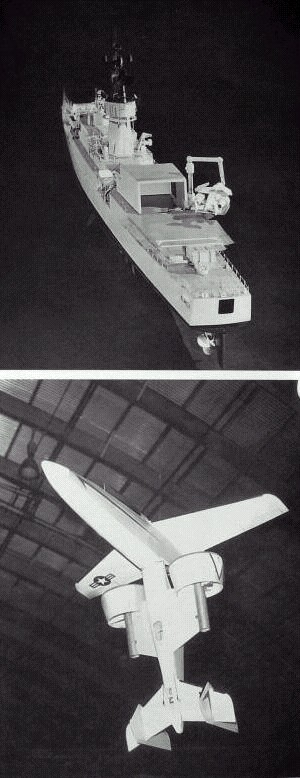
Our 2 cents is we need to make "SCSs" from container ships so we can keep costs down and actually get enough...and employ seaplanes from every other ship we have before its too late. Field several "Container Ship Aircraft Carriers" with STOBAR operating capabilities so aircraft can fly to them and operate when the supercarriers are knocked out of action. Details:
Straight Flight Deck (like converted British container ship, RM Argus)

STOBAR angled deck arrangement possibilities:
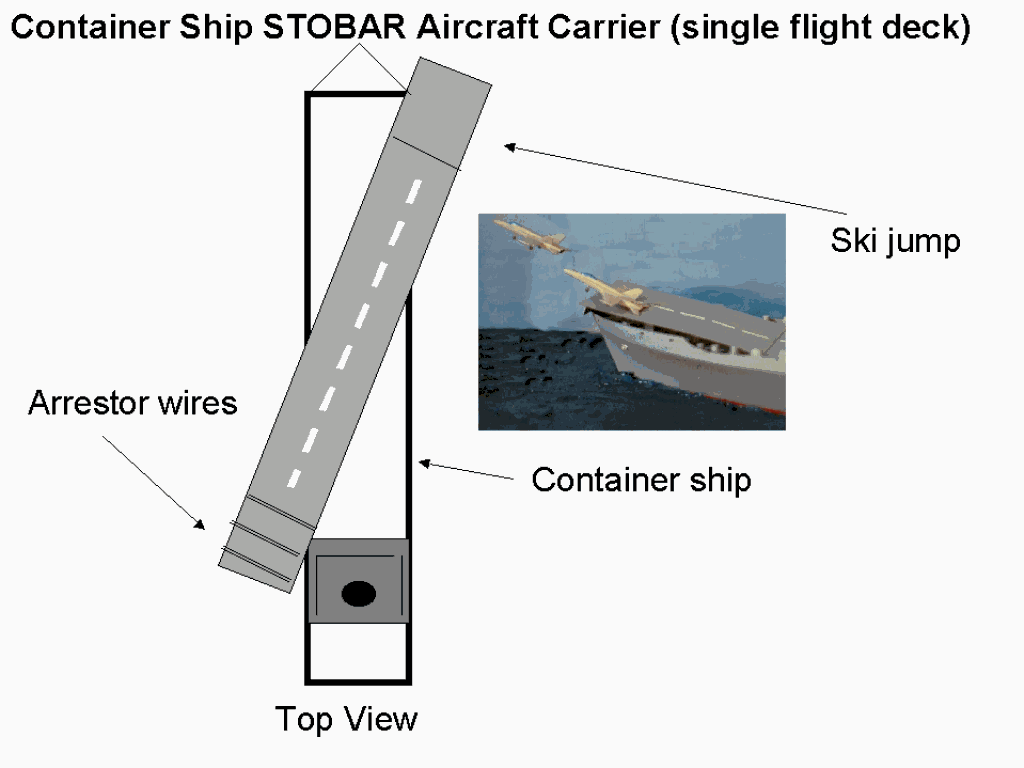
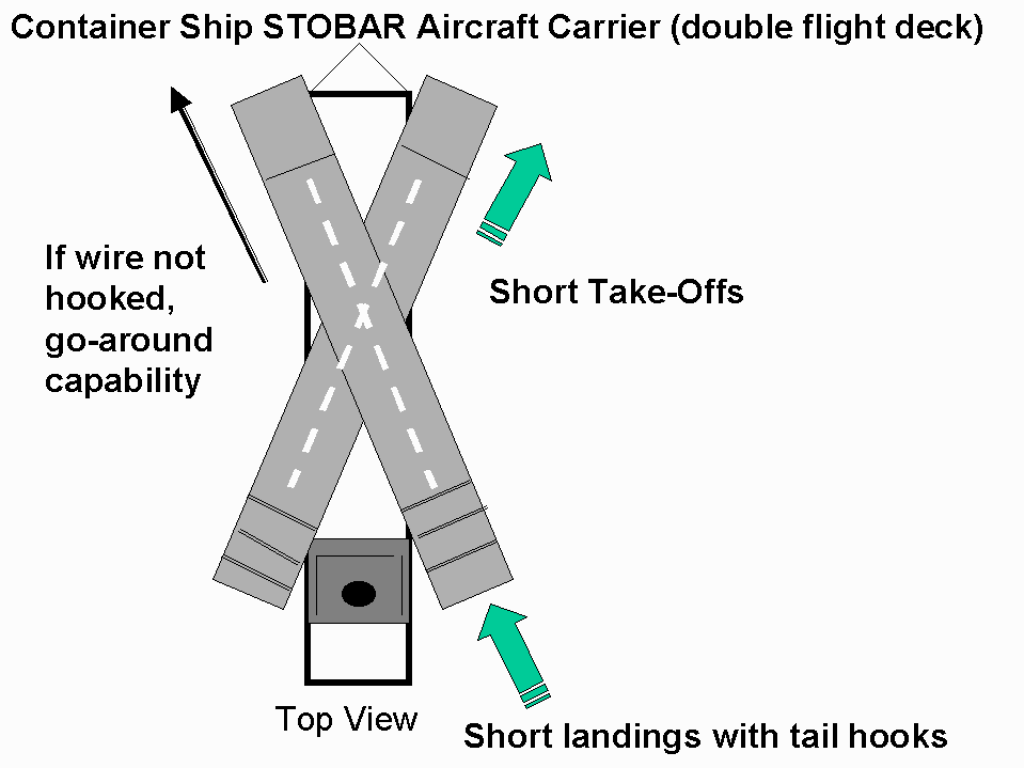
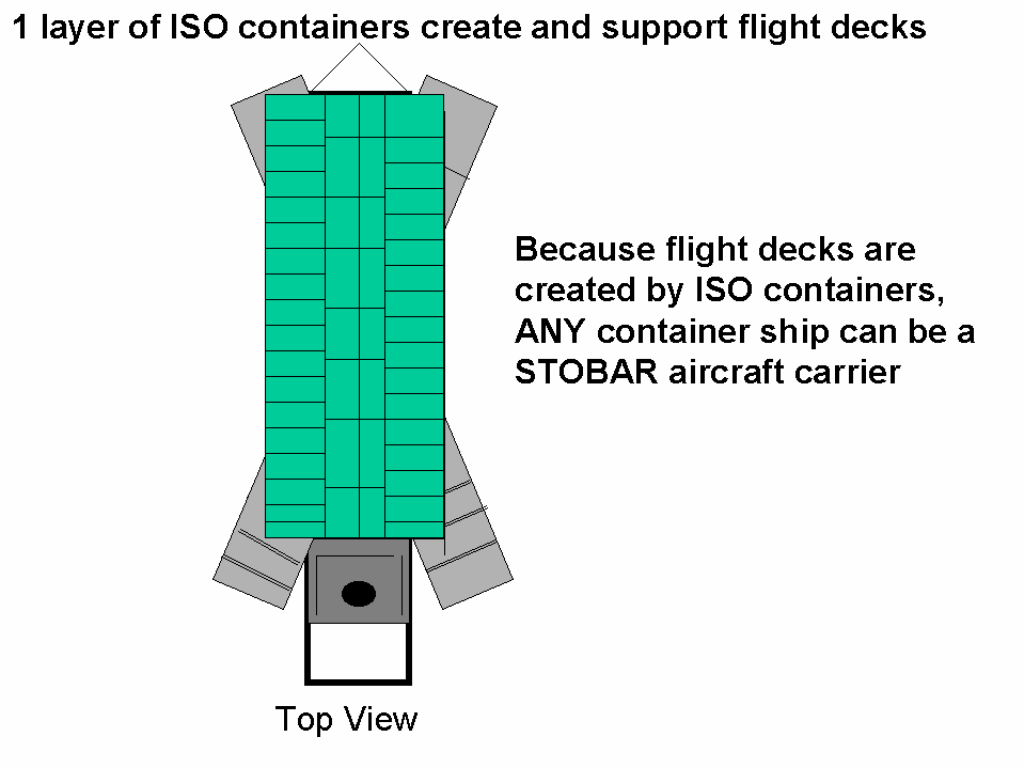
British have already done it: Container Ship Conversion to Aircraft Carrier: Arapaho, SCADS and SkyHook
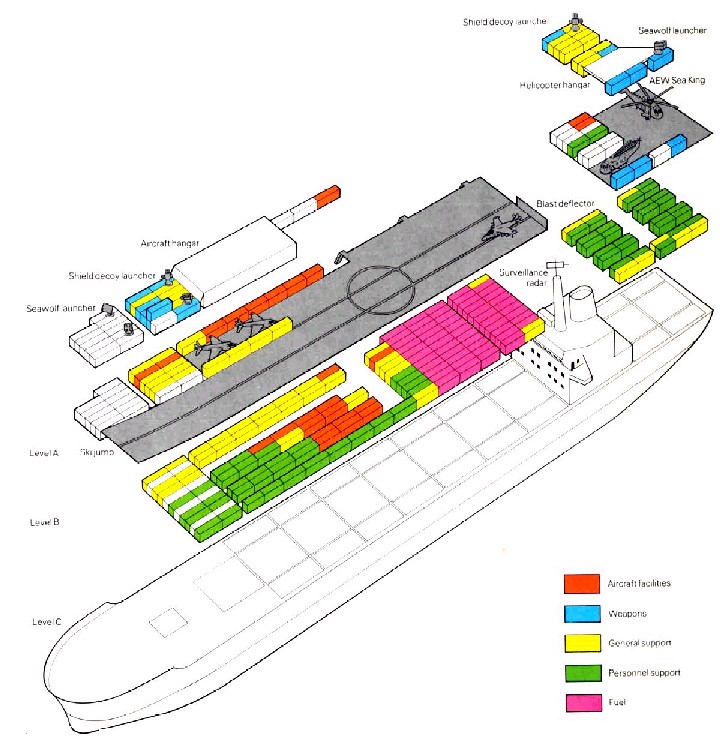
SCADS: Shipboard Containerized Air Defense System
http://home.planet.nl/~alder010/Future/Future.html
Future and Specials
In the late 1960s the U.S. Navy had conceived the "Arapaho" programme, under which a container ship would be modified to permit testing of its suitability to operate special mission helicopters. The aim at that time was to allow a significant proportion of wartime convoy escort and sealane protection tasks to be performed by such ships, manned by USN reservists. The Arapaho concept involved an LPD-size flight deck 200 feet (61m) long and 64 feet (19.5m) wide, and a 4,000 sq ft (372m²) hangar large enough to accommodate four Sea King [amphibious] helicopters. The complete installation weighed 900 tons, and could be installed on a container vessel in less than 18 hours.
In 1982 such an installation was emplaced on the 18,000-ton Export Leander, and 178 helicopters landings and take-offs were performed. In the following year the Arapaho equipment was leased by McDonnell and installed by Camel Laird at Birkenhead on the 27,900-ton MV Astronomer (subsequently renamed RFA Reliant) for tests in the South Atlantic.
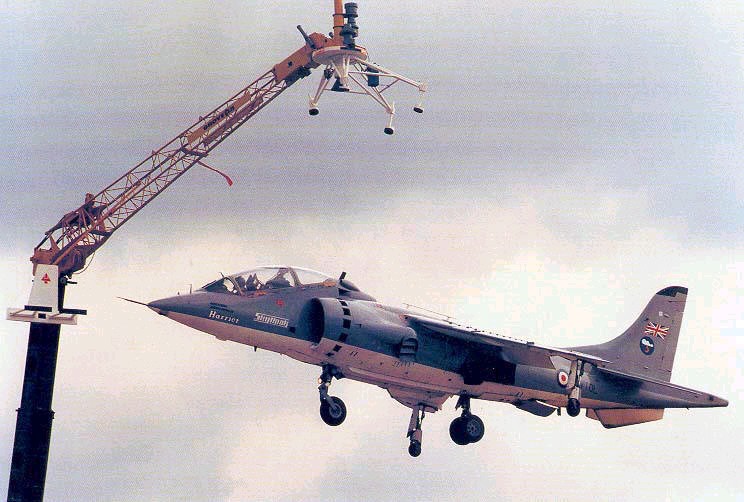
In efforts to exploit the sales potential of the Sea Harrier, which rested largely on its ability to operate from small, inexpensive ships, British Aerospace proposed the installation of ski-jump decks on commercial vessels, and the 'Skyhook' concept that would allow such aircraft to operate in the VTOL mode from ships without any form of aircraft deck.
"Skyhook" was invented by Heinz Erwin Frick (a BAe test pilot of Swiss descent) and the corresponding specification No.2104014 was filed with the British Patent office in 1982. Frick had been struck by the ease with which a Sea Harrier can be hovered with great precision, regardless of wind variations. It occurred to him that if this hovering accuracy could be combined with a space-stabilised "Skyhook" on a ship, then it could provide the means for the aircraft to recover to a highly mobile deck. If the design of the ship precluded the use of a ski-jump take-off, then the aircraft could depart from the "Skyhook", although its warload radius performance would then be much more limited.
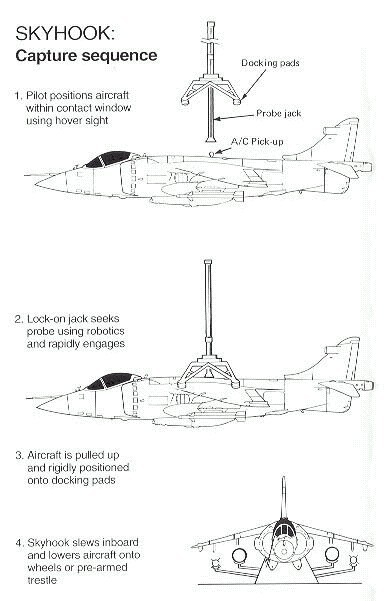
The concept required very little modification to the aircraft itself - simply a hoisting point above the centre of the gravity and possibly some local strengthening. If the operator wanted to refuel the aircraft while suspended from the "Skyhook", this would require modification of the fuel system, but it would still represent a minor expense. The major development task would be the advanced technology crane, presumably with an inertial platform in its base sending commands to a fast-acting hydraulic system that would keep the head of the crane moving linearly through space.
The computations for the crane system were based on the RN's 4,250-ton Sheffield class of destroyers, and the design allowed for sea state 6, to give uninterrupted operations in the North Atlantic for 97% of the time. Using a special form of display attached to the crane head to assist the pilot to hover accurately, it was concluded that the aircraft could easily be placed within the "capture envelope" of the "Skyhook". Engagement was to be performed by a robot system, scanning IR-absorbent patches bonded to the upper surface of the aircraft around the pick-up probe, and moving the hook accordingly. An IR engagement-control system was proposed in order that the aircraft could be illuminated in night recoveries without affecting the pilot's night vision.
Despite the very limited warload-radius performance available from the "Skyhook" launch (which would be less restricted in the case of an AV-8B), the concept undoubtedly has some potential in the context of convoy protection and in providing an outer defensive perimeter by making use of radar picket ships around a conventional carrier. However, BAe estimated in the mid-1980s that the system would cost around $12 million to develop. The company also insisted on acting as prime contractor for "Skyhook", rather than granting a licence (eg, to a company in Japan, where the concept might have special attractions). In the event, UK-MoD showed no great interest and BAe was unwilling to invest its own funds in the project, so "Skyhook" has been filed away, at least for the present.
www.secretprojects.co.uk/forum/index.php?topic=1304.msg11194
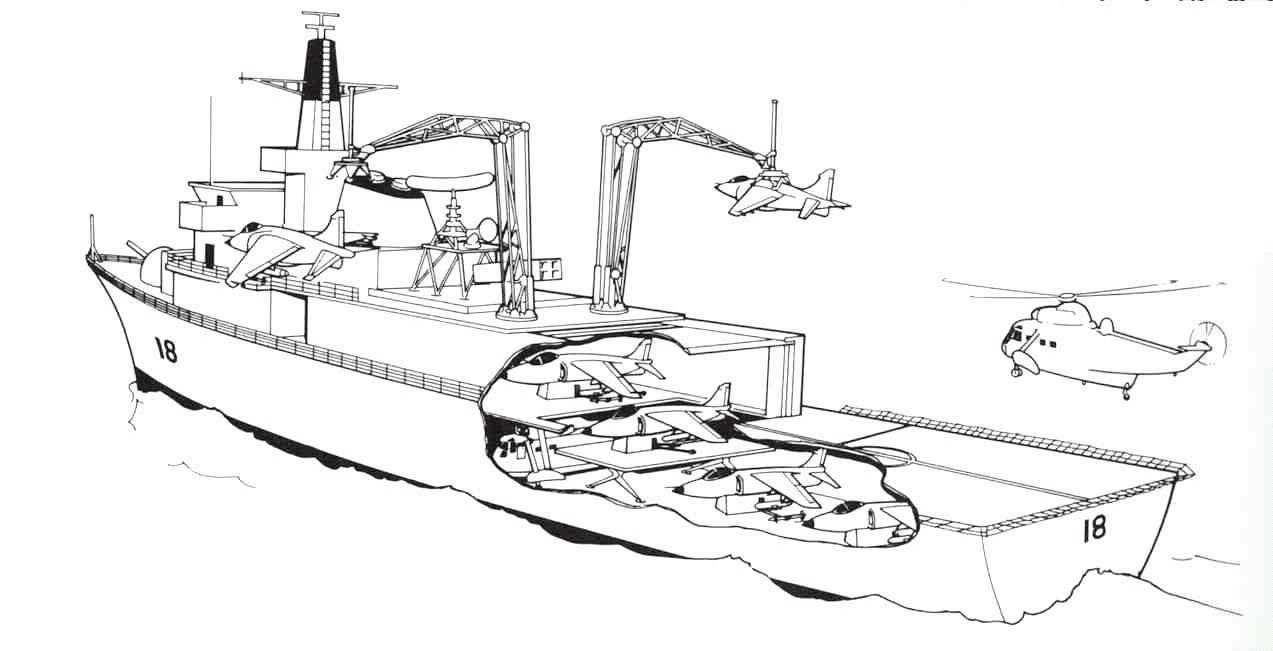
After the idea of SCADS BAe also came up with the SkyHook idea. The initial idea saw BAe propose two ships, one in their patent application (www.google.com/patents?vid=USPAT4523729&id=IcEyAAAAEBAJ&pg=PP2&dq=heinz+frick) and one used in publicity brochures.
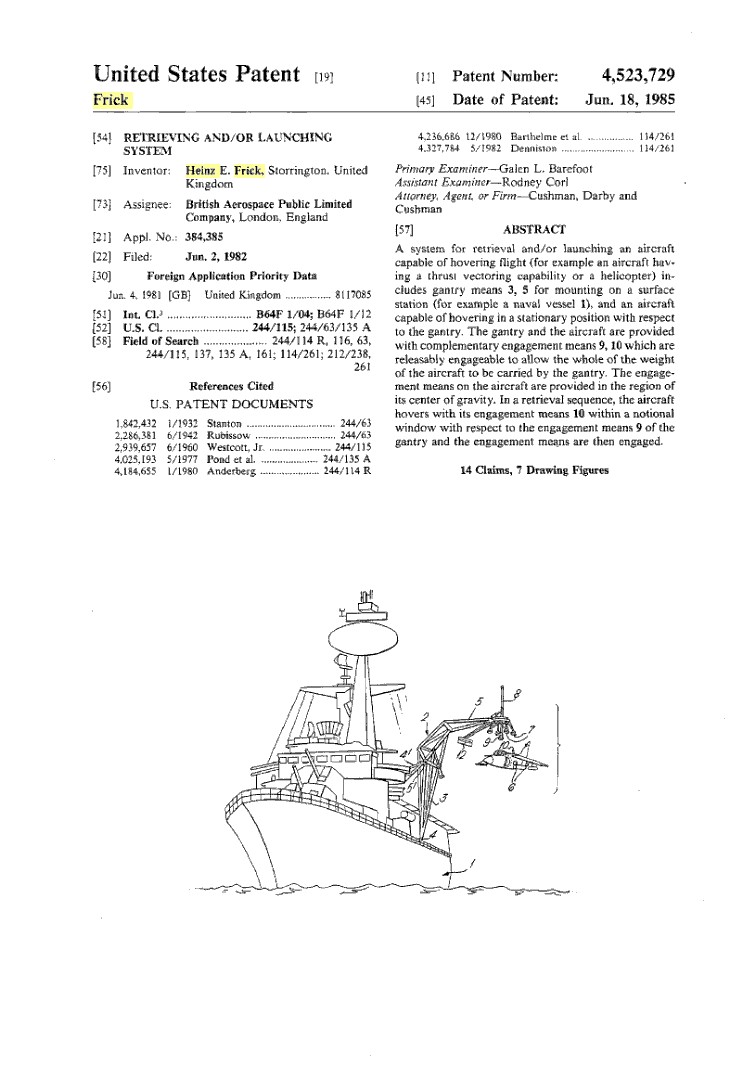
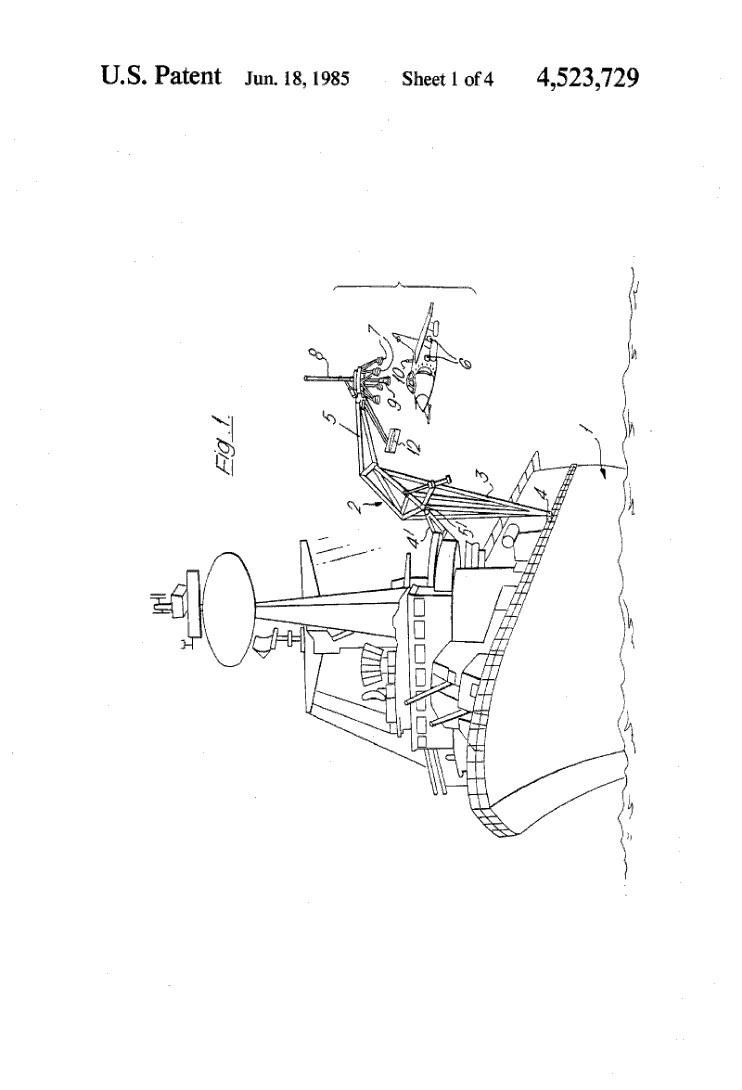
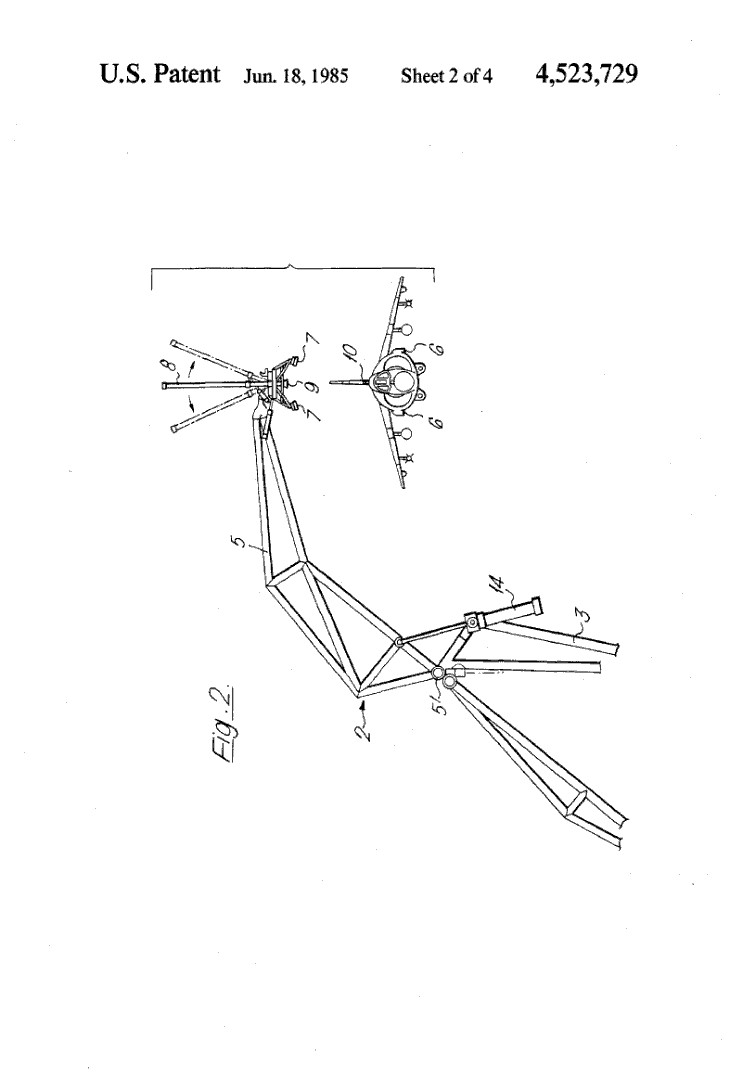
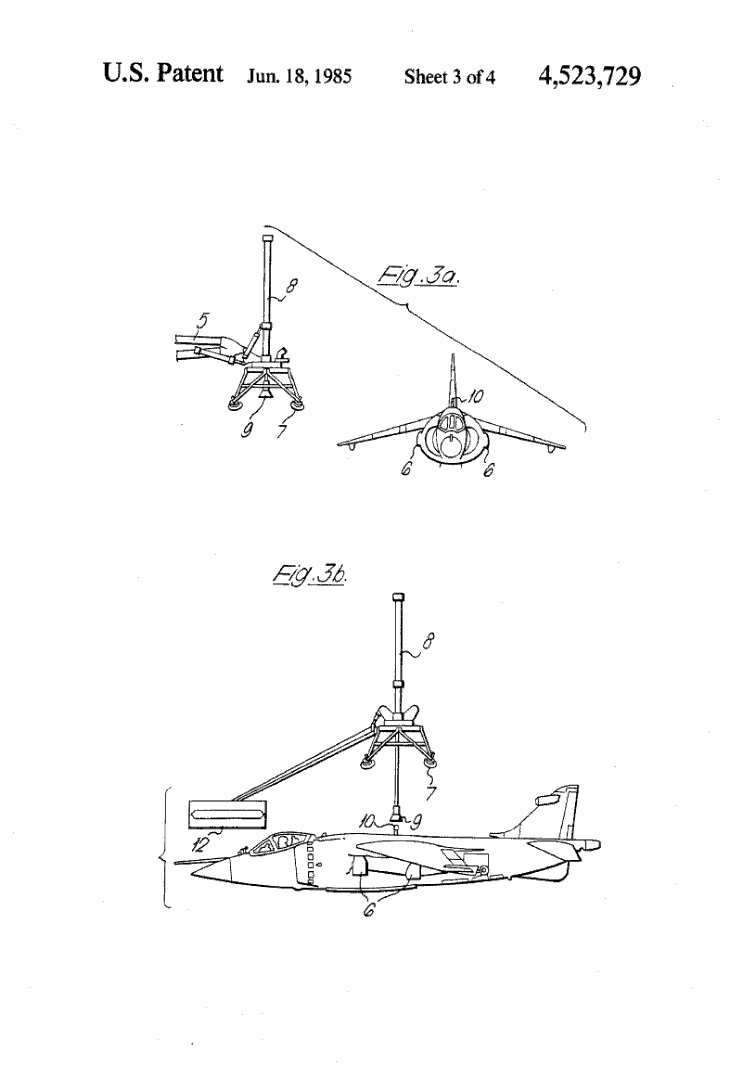
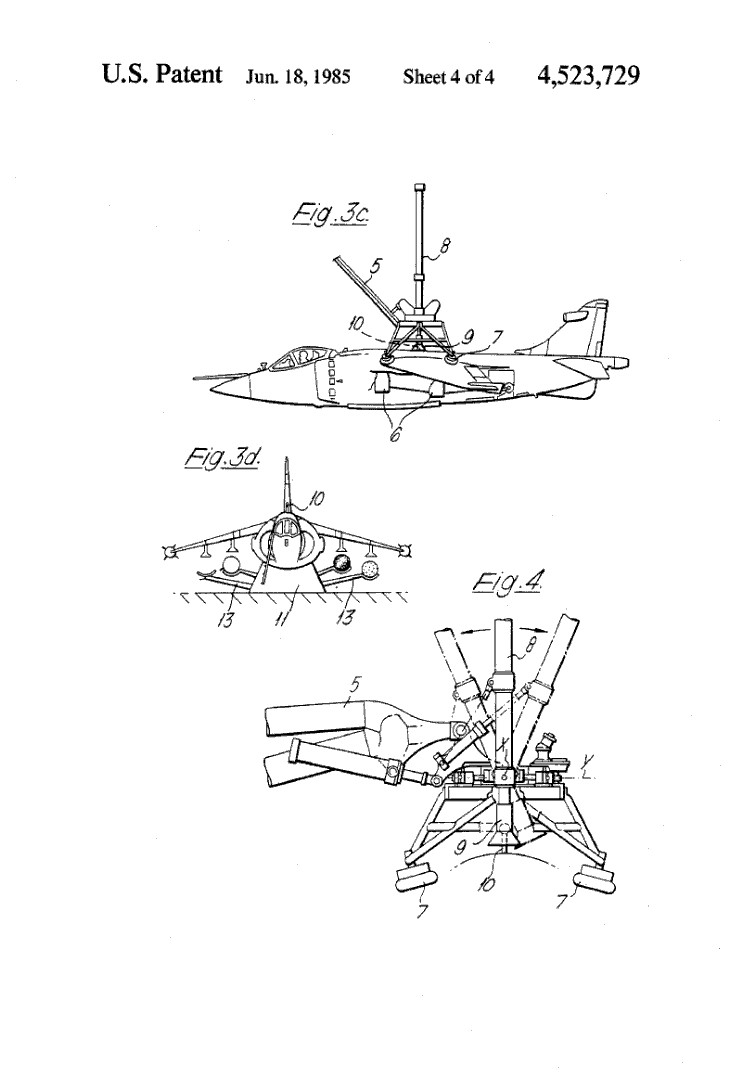
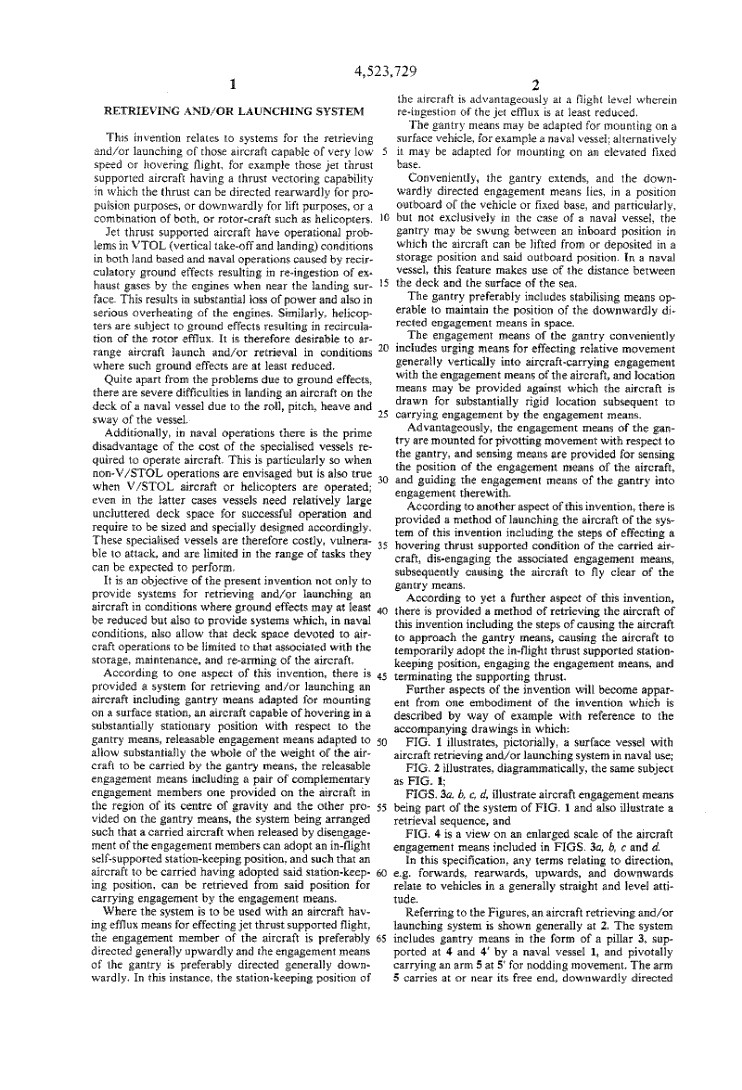
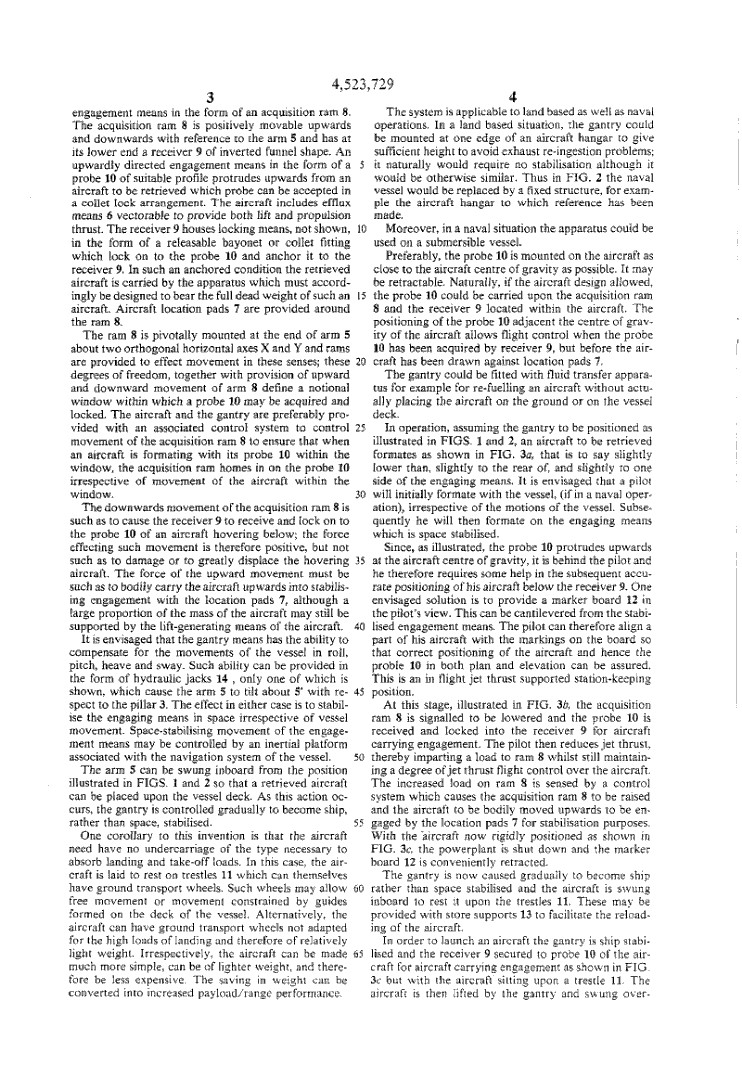
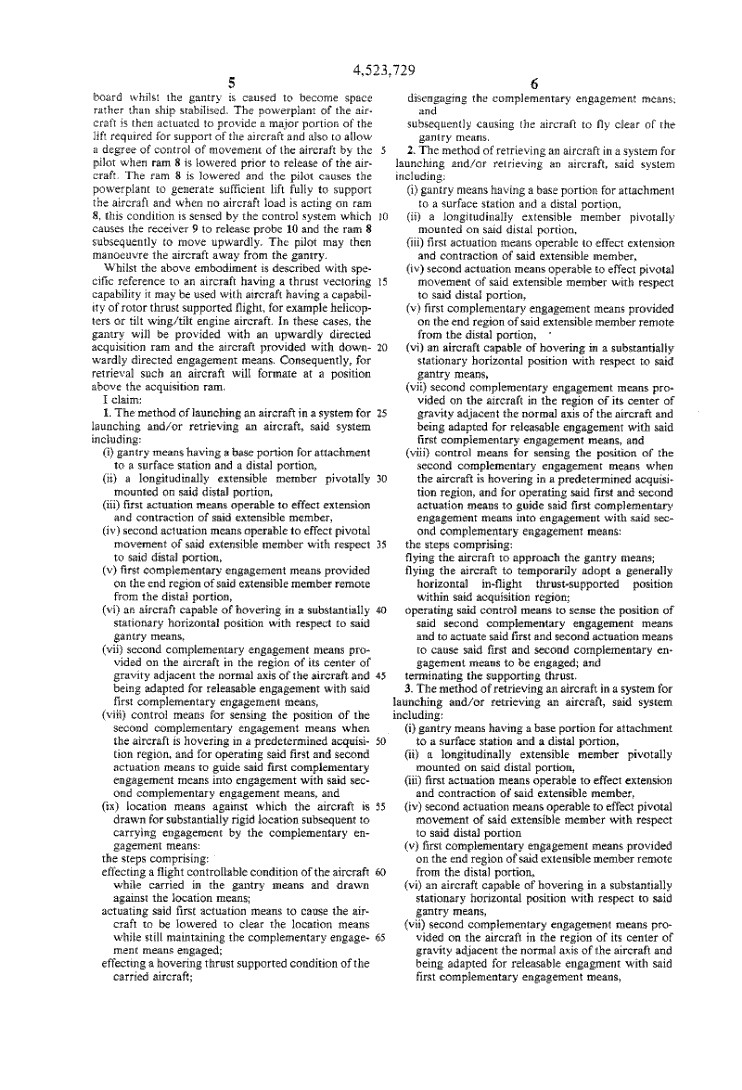
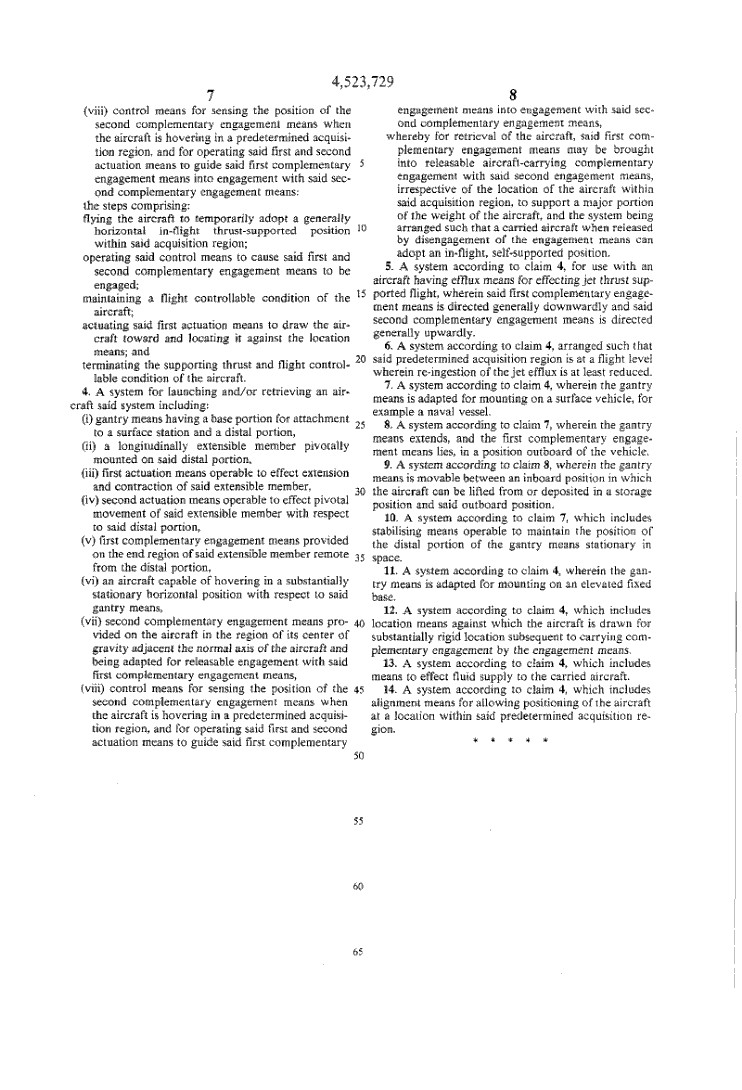
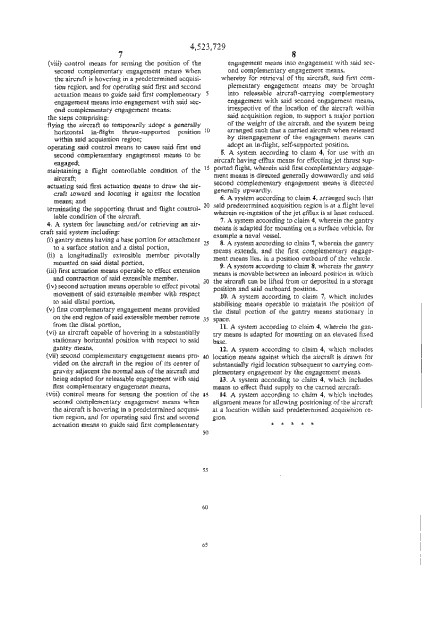
Both relied on SkyHook for take-off and landing, probably not too practical.
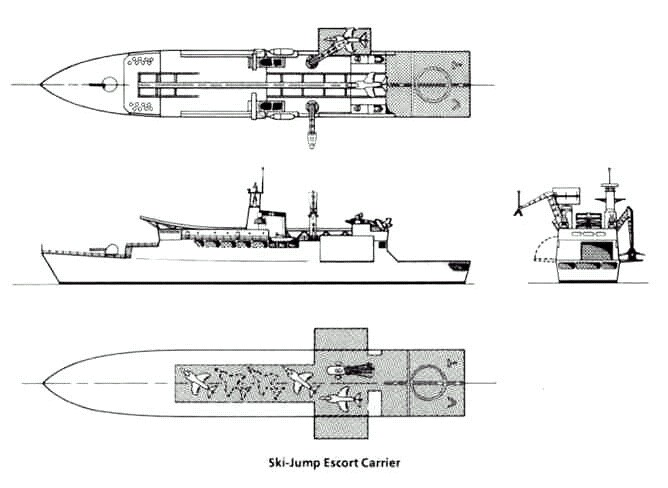
However, VT designed a "proper" ship around the concept and this featured a skeletal ski-jump atop the supersturcture for take-off. This increased payload, with recovery via SkyHook. Aircraft were stowed in a hangar with lateral doors for entry/exit, SkyHook being used to move aircraft to the launch position.
2x 25mm Sea Dragon CIWS, 1 medium gun, plus 16 x VLS missiles for defence.
5,200 tons diplacement, 416 feet 8in OA
45,000 shp = 26kts
5 x Sea Harriers, one helo.
The idea was to use the ship as a "forward base", allowing greater endurance in CAP patrols, with the aircraft returning to a large carrier for major maintenance. In other words, a naval version of the Harrier's land-based use of forward operating strips.
We must GET MORE SEAPLANE AIRCRAFT (IT) and DRIVE ON (GIDO) out to sea by using ALL our surface ships as platforms and as soon as we can, our submersible ships AKA submarines. The threat since Zumwalt's days has increased at least by a factor of 100x and the anti-progress large aircraft carrier mafia must be over-ruled before we have a national tragedy at sea. During the Korean war we were able to add flight decks to tankers...is this too hard for us to do today?
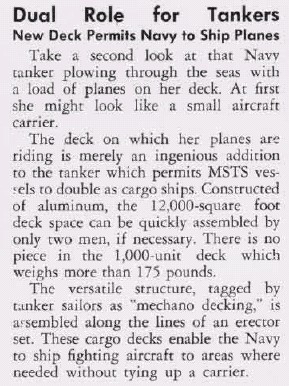
The first question we have to ask is, what do we have to work with "off-the-shelf" since the SCS experience shows the Navy/Mc cannot develop aircraft from-scratch in a timely manner?
The U.S. Navy has retired all its S-3 Viking long-range ASW planes from all 11 of its aircraft carriers, who now only have short-range ASW helicopters. The USN is obsessed with LA competing with the USAF for who will bombard sub-national groups better for GWOT/Long War dollars. They have retired the F-14 with its long-range AAW capabilities and KA-3 SkyWarrior and KS-3 Viking tankers to help give the impotent F-18 Brewster Buffalos some more range. The Royal Navy has retired their SeaHarriers with medium range AMRAAM AAMs making the same fatal mistake of assuming no one is going to challenge them at sea and to cut costs and focus on LA. The USN cannot stop enemy submarines from sinking them due to its own egomania and negligence. Enemy submarine no longer have an outer ring of ASW force to evade and can be directly upon the inner ring of the main body which is not much of a shield at all since it cannot detect much less target advanced AIP submarines.
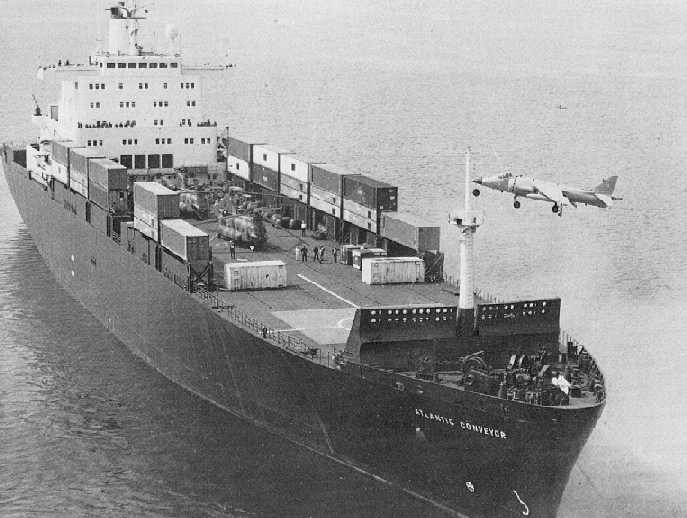
The British have already taken container ships to war in the Falklands in 1982. Snobby navies like the U.S. Navy want handfuls of custom-made "warships" and don't realize in war SIZE counts.
The author below doesn't seem to know that its possible to offload container ships without having to seize container cranes at a port. He doesn't know about FASTship or SCADS, either but he's right on target with how container ships can be made into aircraft, troop and tank carrying ships.
www.americanthinker.com/2005/04/chinas_container_ship_fleet_an.html
April 11, 2005China's container ship fleet and Taiwan's security
By Frederick W. Stakelbeck, Jr.
China is busily building a fleet of the largest container ships the world has ever seen. That is a boon for its export trade and economic efficiency. But like the Trojan Horse of ancient Greek civilization, the fleet could potentially be used by China in a spectacular, lightening invasion of Taiwan. Could the hollow hulls and empty decks of Chinese container ships carry infantry and mechanized divisions for a devastating attack on Taiwan, securing the island before the U.S. could respond?
The thought of mammoth Chinese container ships carrying an amphibious invasion force across the Strait of Taiwan is certainly frightening. But the capability for just such an invasion is slowly being put in place.
The Chinese have plans to build several 90,000 ton-plus container ships capable of carrying 8,530-TEUs [EDITOR: 20 foot long shipping containers] (Twenty Feet Equivalent Units).* In an agreement announced in November 2004, Chinese shipbuilder Hudong-Zhonghua Shipbuilding (Group) Co., Ltd. announced it will deliver 4-5 of the giant container ships to the China Shipping Group by October 2008. When completed, the new ships will surpass the Republic of Korea's 8,000-TEU as the largest container ships in the world.
Supplementing increased construction and advances in the container ship industry have been developments in China's amphibious capabilities. The People's Liberation Army Navy (PLAN) is building amphibious ships at a breakneck pace. The ships include nine large Yuting 072- II class LSTH; the Yunshu class LSM; a new 64 meter LCU; a number of medium landing ships; and the construction of LSDs and LPDs with flight decks for attack helicopters.
Solidifying China's stranglehold on the world's merchant fleet is the country's rapid ascension as a world leader in commercial ship repair and conversion services. These complex projects can now be completed at a number of shipyards throughout China. Its largest ship repair organization, the China Ocean Shipping Company (COSCO) Shipyard, operates the Nantong shipyard near Shanghai, which is increasingly handling tanker, container and bulk carrier repairs and conversions. Separately, the Dailan and Guangzhou shipyards, among the country's largest repair facilities, also expect rapid growth and increased investment in the near future.
The largest producer of ship containers in the world is also a Chinese company. China International Marine Containers (CIMC) ranks as the world leader in container manufacturing, with over 40 percent of the international container market. These containers can be custom built to specifications with louvered vents and electric power added to make a working, livable environment that is virtually sound-proof. Containers can also be armored and include partitions to conceal individuals or large items.
Entranced by economic opportunity, the Taiwanese are inadvertently making a possible Chinese container ship invasion a reality. In May 2004, ground was broken for construction of the first container center at the Port of Taipei. The new center is expected to save several hundred million dollars in transport costs and make the port an attractive location for investment. Located at the mouth of the Danshuei River in northern Taiwan, the Port of Taipei is one-hundred and thirty-four miles from Fuzhou Harbor in mainland China.
Further improvements to the Port of Taipai's transportation infrastructure are scheduled for completion in 2008 - the same year that the last of the great 90,000 ton container ships will be delivered to the China Shipping Group. Included in these improvements will be the completion of the Bali-Wugu section of an east-west expressway. This will allow for the easy transport of containers from the Port of Taipei via the expressway, or a link with Chiang Kai-shek International Airport via the West Coast Highway, which is currently being widened.
A Chinese invasion of Taiwan has been compared by some to the allied invasion of Normandy and McArthur's landing at Inchon during the Korean War. The D-Day Normandy invasion of 1944 transported 176,000 amphibious troops; used three airborne divisions; 10,000 aircraft, 136 warships, 3,000 landing craft and 2,000 support ships. Available intelligence reports suggest that the Chinese can assemble 15,000 amphibious troops, three airborne divisions, 3,300 aircraft, 60 warships and 300 landing craft for an invasion of Taiwan. In addition, a support force of 50,000 ground troops of the Chinese 31st Army Group now deployed at the Nanjing Military Region could be made available for an invasion with another 250,000 troops loaded onto container ships for an assault on Taiwan. According to Wang Jisi, Director of the Chinese Institute of Strategy at the Central Party School, "the danger of war truly exists. We are not a paper tiger. We are a real tiger."
In theory, a covert assault using Chinese container ships is possible. But like the Normandy invasion, most, if not all, of the operational and contingency planning involved in such a large-scale amphibious invasion would have to be precise and error-free. A fleet of container ships would have to unload men and material in an extremely fast, cohesive manner, probably under constant fire from Taiwanese ground, navel and air forces.
Loading docks in the Port of Taipei would need to be cleared for immediate military offloading operations. Major roads leading out of the port would have to be secured by airborne units of the Chinese 43rd, 44th and 45th divisions or advance units of a special operations force (SOF) attached to the invading amphibious force.
Once secured, the port would require continuous patrolling to propel a retaliatory naval or air assault on container ships unloading at the port. Air cover using a combination of attack helicopters and fighters from the decks of ships in port or from airfields secured by Chinese airborne units would be necessary. The imposition of a rigorous naval shield using China's fleet of diesel and nuclear powered submarines would be needed to diminish threats from the United States and its allies.
French Exocet SM-39 anti-ship missiles known as "carrier killers," 3M-80 Moskit Sunburn missiles, developed by the Chinese specifically to defeat the U.S. Aegis air-defense system, or cruise missiles launched from Russian-made Su-30 fighters could also be used to attack U.S. assets in the Pacific. Deployed on submarines, fighters, frigates, or mainland China, cruise missiles could inflict considerable damage and innumerable casualties on U.S. Naval Forces in the early hours of a conflict. This would effectively mitigate an overwhelming response from the U.S. and prompt a tactical regrouping of U.S. forces for a coordinated counteroffensive that could take several weeks or months to organize.
A southern Chinese invasion force made up of container ships and Chinese naval support ships could land near the ancient city of Tainan situated on the southwestern coastal plains of Taiwan. As one of the island's largest cities with a population of approximately 700,000 residents, Tainan's transportation system includes a major airport that, if secured by Chinese airborne units, would allow for accelerated troop movements north. The Tainan Airport, a public facility as well as an air base, is well-known to Chinese military strategists. Railway lines and highways leading north to Taipei already exist and are large enough to handle large supply trucks, tanks and armored vehicles.
Adding credibility to the hypothesis of a possible Chinese container-based invasion of Taiwan, the United States itself is now considering using container ships in support of naval operations, and plans to explore the conversion of container ships for military purposes. Working with Maersk Line Ltd., the U.S. Navy is considering its Maritime Prepositioning Force (MPF) Future Program with a modified S-class commercial container ship. The 1,140 feet long ship is designed to offload cargo for 6,000 troops and maintain a flight deck for the V-22 Osprey tiltrotor aircraft. Working with architectural firm Gibbs & Cox and ship conversion company Norshipco, the proposed ship will be outfitted with ramps, a loading platform and stern and bow thrusters. Construction is scheduled to begin in 2007. Hovercrafts would be used to deliver cargo to shore.
China has embarked on a determined mission to surpass both Japan and South Korea as the world's leading shipbuilder. The Chinese can now offer state-of-the-art shipbuilding, repair and conversion services as a result of increased domestic and foreign investment in maritime modernization projects. With improved shipbuilding production methods, modern capital equipment for its shipyards, and significant progress in the areas of ship design, China's shipbuilding industry deserves the attention of the U.S. and its Pacific allies as a possible national security threat.
Would China undertake a container-based invasion of Taiwan? This is an intriguing question which merits our attention as China approaches superpower status.
_________
*The unit TEU (twenty-foot equivalent unit) is used to express the relative number of containers based on the equivalent length of a 20' container. For example, 100 containers of 20' is 100 TEUs, while 100 containers of 40' is 200 TEUs, Export 911,
www.export911.com/e911/ship/conShip.htm.
Frederick W. Stakelbeck, Jr., is a freelance journalist residing in Philadelphia
U.S. Navy Maritime Defense Force
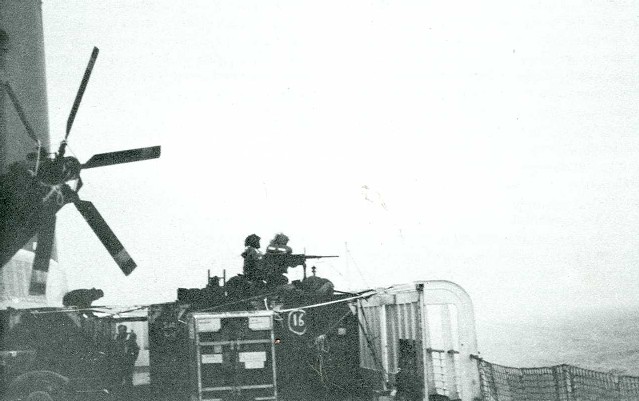
British Army Soldiers repeling Argentine air attacks with a .50 caliber heavy machine gun attached to an ISO shipping container during the 1982 Falklands War. Containers woulds make it easy to add weaponry to container ships as with more effort oil tankers to create self-defense capabilities.
Its high time we put weaponry and Navy personnel on all cargo and oil tanker ships doing commerce with the West.
WHY MUST WE WAIT FOR A SUB-NATIONAL TERRORIST GROUP "EXXON VALDEZ" TO HAPPEN?
This is further proof why we need an U.S. Navy Maritime Defense Force since the USN lacks the will or the necessary mindset to do this!
Los Angeles Times February 15, 2007Al Qaeda Faction Urges Oil Attacks
Militants are told to strike worldwide to disrupt U.S. supply.By Associated Press
CAIRO - A Saudi Arabian terrorist group affiliated with Al Qaeda has urged Muslim militants to attack oil facilities worldwide, including in Canada, Mexico and Venezuela, to stop the flow of petroleum to the United States, according to an article by the group posted on the Internet.
Al Qaeda in the Arabian Peninsula said in its monthly magazine posted on an Islamic website that "cutting oil supplies to the United States, or at least curtailing it, would contribute to the ending of the American occupation of Iraq and Afghanistan."
The group said it was making the statements as part of Osama bin Laden's declared policy.
Al Qaeda claimed responsibility for last year's attacks on oil installations in Saudi Arabia and Yemen after Bin Laden called on militants to stop the flow of oil to the West. The group also was behind the 2002 attack on a French oil tanker that killed one person in the Gulf of Aden.
The Canadian Security Intelligence Service declined to comment on the report. In Mexico, a presidential spokesman said the government was trying to confirm the veracity of the threat. Venezuela's Foreign Ministry said it had no immediate comment.
San Diego Union-Tribune
February 21, 2007Iran Brings Maneuvers To Gulf
War games prompt shipping worries, U.S. Navy buildup
By Jim Krane, Associated Press
MANAMA, Bahrain - Iran has brought its war games maneuvers over the past year into busy shipping lanes in the Straits of Hormuz, the narrow mouth of the Persian Gulf through which two-fifths of the world's oil supplies pass, the top U.S. Navy commander in the Mideast said.
The moves have alarmed U.S. officials about possible accidental confrontations that could boil over into war, and led to a recent buildup of Navy forces in the Gulf, Vice Adm. Patrick Walsh said.
During maneuvers, Iranian Sailors have loaded mines onto small minelaying boats and test-fired a Shahab-3 ballistic missile into international waters, he said.
"The Shahab-3 most recently went into waters very close to the traffic separation scheme in the straits themselves. This gives us concern because innocent passage of vessels now is threatened," Walsh said Monday on the base of the Navy's Fifth Fleet in the Gulf island kingdom of Bahrain.
Iran tested the Shahab during November maneuvers, which it said were in response to U.S. maneuvers in the Gulf it called "adventurist." Iran also showed off an array of new torpedoes in war games in April.
The U.S. aircraft carrier John C. Stennis - backed by a strike [victim] group with more than 6,500 Sailors and marines and with additional minesweeping ships - arrived in the region Monday. It joined the carrier Dwight D. Eisenhower after President Bush ordered the buildup as a show of strength to Iran.
The additional U.S. firepower has ratcheted up tensions with Iran. But Walsh said the increase aims to reassure Arab allies in the Gulf and prevent misunderstandings that could escalate into outright conflict.
"That's certainly what we're trying to avoid, a mistake that then boils over into a war," said Walsh, who departs his command of the Fifth Fleet this month to become vice chief of naval operations at the Pentagon, the Navy's No. 2 post.
Walsh said the Navy was responding to "more instability than we've seen in years" in the Fifth Fleet's region - with conflicts in Iraq, Afghanistan and Somalia, tensions in Lebanon and the standoff with Iran.
The Navy has grown increasingly alarmed at what Walsh called Iran's "provocations." Once-cordial Navy ship-to-ship relations with Iran in the Gulf have disintegrated over the past 18 months as Iranian vessels made "probing" incursions into Iraqi waters, he said.
"They threaten to use oil as a weapon. They threaten to close the Straits of Hormuz," Walsh said. "And so it is the combination of the rhetoric, the tone, and the aggressive exercises in very constrained waters that gives us concern."
Since the Stennis was ordered to the region, Iranian leaders have increasingly warned that they would respond to any attack by closing off oil shipping lanes or attacking U.S. interests.
The Straits of Hormuz are 34 miles across, but its shipping lanes are only about six miles wide.
Walsh said it was doubtful that Iran could physically block the entire six-mile lanes with mines - but hitting only a few vessels with missiles and mines would "terrorize" shipping and have the same effect.
"It's more the threat of mines than the threat of closing the straits. That would have dramatic effects on markets around the world," he said.
Walsh said his biggest worry was that Iran would underestimate U.S. resolve to protect its interests in the world's richest oil region. He said the tone of Iranian leaders could make their commanders on the ground more reckless.
What Congress needs to do is create a new military service called the U.S. Navy Maritime Defense Force to do the convoy defense and naval gunfire support dirty work the aircraft stuporcarrier asshole U.S. Navy is not interested in doing. It would receive funding straight from Congress and be commanded by a 4-star admiral.
The USNMDF would:
1. Perfect SCADS ISO container kits to attach to oil tankers and container ships to defend them against ASMs and air attacks. Also close-in weaponry and security detachments to repel boarders and suicide boat/ship attacks.
2. Perfect the SCADS container ship aircraft carrier and have 100 escort carriers ready to operate
3. Procure a LARA 2 seaplane fighter and man enough squadrons of reservists to operate from the 100 container ship escort carriers in a surge war situation
4. Procure LTA ASW blimps/large seaplanes to surveil our sea lanes
5. Reactivate all 4 x Iowa class battleships to be aircraft battleships to operate the LARA 2 and/or F-35B Lightning II seaplane fighters while acting as oil tanker/container ship convoy escorts and provide naval gunfire support for the Army/marines since they will container ship supply support during amphibious landing
We Better Do Something quick!! Or you can kiss the USN/Gyrenes Bye! Bye! 
The V-22 is a flying-then-flaming deathtrap, so we can't put ASW gear into it to do that mission.
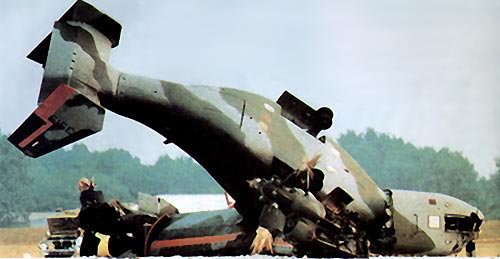
We should bring the S-3s back or modify E/C-2s using their rear ramp-accessed cargo bay to do ASW; these seaplanes can operate from aircraft carriers but not small surface ships. We can do this in a matter of months. A turbofan version would require a few more months on top of this.
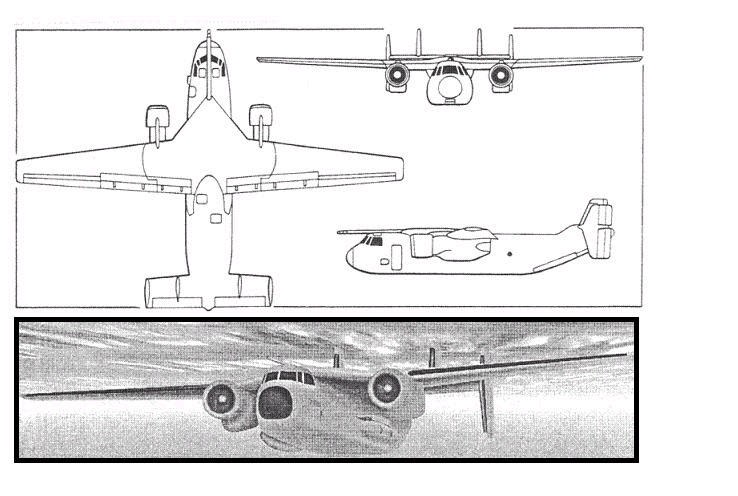
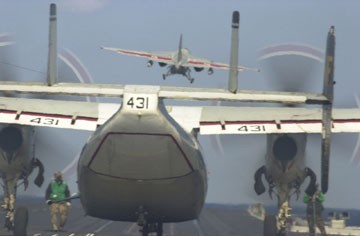
The best answer is to tilt the engine like the Grumman 698 does or tilt the wing like the Canadair 641 did, but this means YEARS to get aircraft from computer screen to operational service. We better get cracking!
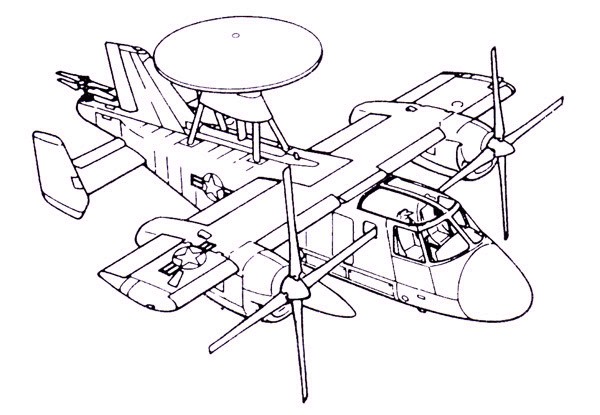

Its high time the USN wake up and quickly and increase its aircraft numbers by dropping its snobby large-aircraft-carrier-or-nothing non-sense and put ASW and AAW capable seaplanes and/or VTOL F-35B planes on every surface ship they have to get use numbers. The USN needs to create dozens of cargo container small aircraft carriers to get even more aircraft into the air to defeat subs and enemy ASM launching aircraft--just like FDR ordered them to do to win WW2 before we have a major fucking disaster at sea. Its high time the snobby USN returns all 4 of its heavily armored Iowa class battleships that don't have to run back to port but can actually sail into missile and submarine harm's way with a chance of surviving and dominating the fight to smash an enemy's invasion fleet with lots of affordable and area effect gunfire. Its high time the USN re-embrace the long-range blimp, small and large seaplane patrol bomber jet and transport planes to scour the seas for air, sea and sub-surface threats since the earth is still a huge area to control. Its time the USN stop doing a half-assed WW2 re-enactment and stop running around in poorly camouflaged easy to target and easy to kill surface ships some packed with thousands of marines bent of self-validating by assaulting fortified beaches. Its time for everything to be heavily armored, stealthy and under the water. No more marines ready to die by the thousands in surface ships, but ready to deploy on a few hours notice by seaplanes and submarine aircraft carriers who disembark them with M113 Gavin light amphibious tanks not slow foot-slogging or driving around in wheeled trucks that HE near misses will explode them into human hamburger meat or flaming funeral pyres.
The Aircraft Carrier Land Attack "Doolittle Raid" Myth: Jimmy Doolittle versus Glenn Martin: who strikes back at "Japan" First?
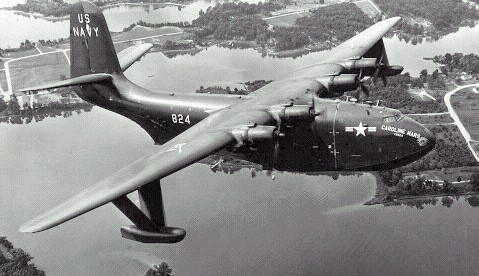 VS.
VS.
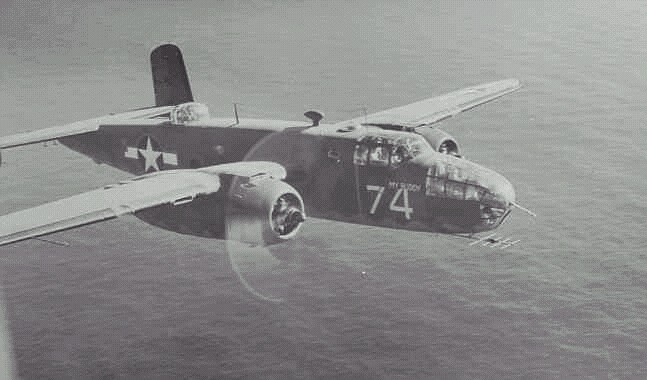
The vast majority of the billions of people on planet earth live on LAND, no one lives statically on/in the sea except those poor souls drilling for oil on platforms. People cause wars and they live on land. To get political effect, warfare must affect people on land. One of the tragedies of WW2 is that we walked away from it learning the wrong lessons in a case of who-gets-the-land-attack-licks-in-first, being remembered and emulated in our current un-balanced and dangerously unready naval force structure. If a weapon system does not achieve political effects it will not be rewarded by the tax payers with a continued existence regardless of how important or vital the roles it performs at sea where no one sees them doing these heroic deeds nor gives a damn. When a nation-state is attacked it wants BLOOD not operational art that provides leverage to end a war with the least amount of blood being shed. Land Attack (LA) provides the "red meat" the public wants in a "feeding frenzy" of revenge.
Before WW2, the Navy had realized it needed long-range, large seaplanes and refuel tender ships to range out ahead of its fleet much farther than any land-based planes could reach and certainly any wheel landing gear small airplanes from a carrier could reach. At a critical juncture the twin-engined PBY Catalina seaplane was put into mass-production and it gave us the critical edge in both the Atlantic and the Pacific at finding enemy submarines and surface ships first and then enabling naval commanders to "shape" the sea battlefield so we ganged up (combined all elements into a stronger whole than the enemy could defeat individually; cargo ship escort aircraft carriers by the dozens with hundreds of short-range planes, long-range LTA blimps and land-based patrol planes, small seaplanes from smaller ships etc.) on both the Germans, Italians and Japanese to smother them everywhere on the very large planet earth's oceans and seas. Naval aviation genius, Glenn Martin had improved upon the Catalina with his PBM Mariner and the 4-engined Coronado by a rival company were advancing the patrol and combat search & rescue missions with slightly faster speeds, longer ranges, more armor and armament and open ocean water landing capabilities. However, Martin was already thinking of projecting LA power by large seaplanes in two ways; by firepower using them as long-range bombers to smash land targets and for maneuver delivering ground troops to defeat land armies, hold key terrain and eventually topple the enemy nation-state government.
To do firepower LA from a seaplane across oceans, you first need range and enough speed to survive enemy land-based fighter interception. Being able to land on the water in the ocean to refuel from surface or submarine tenders was and still is a HUGE advantage, but the fuselage boat shape is not and hurts aerodynamically with speed reducing drag. When Martin designed his supersized Mars "Sky Battleship" seaplane with 4 engines to carry enough fuel, he got the range but not the speed to do LA bombing at least during the daylight hours; the plane flies today as a forest fire water bomber at 200 mph. At this critical, pre-Pearl Harbor Japanese attack juncture, the Navy told him to make the Mars a transport and this tragically stopped seaplane LA development for a decade. And most importantly for getting the necessary political visibility effect to make a place for seaplanes, the Mars bomber was not ready when the Japanese took our bait and attacked our WW1 battleships at Pearl Harbor so the American people would be pissed off enough to declare war on them and by alliance fight the real mortal threat to America, the high technology Nazi Germans.
As our WW1 battleships were being quickly refloated and patched up to go kick the Japanese's asses, plans were underway (pardon the pun) for Army Air Corp land-based B-25s to do a short take-off from a Navy aircraft carrier and strike back immediately at the Japanese to assuage the American public's need for revenge and serve notice to the Japanese that their home islands were not safe and to expect more to come. Details:
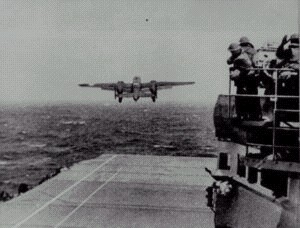 VS.
VS.

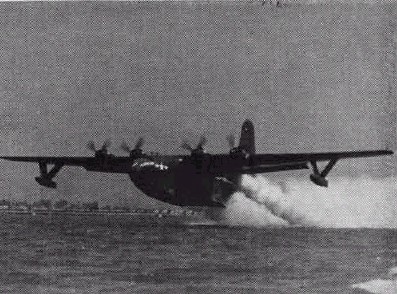
The B-25C without a boat hull could fly at 284 mph at 15, 000 feet but would be flying low over the water to evade Japanese air defense detection so cruising speed was 233 mph carrying just 3, 000 pounds of bombs and for a range of only 1,500 miles and would RISK TWO ENTIRE AIRCRAFT CARRIERS AND 10, 000 MEN (USS Enterprise 2, 217 + USS Hornet 2,919 and 16 other ships!) In contrast, the Mars seaplane could cruise at 185 mph but could fly for 4, 000 miles unrefueled only risk a couple of tender ships and deliver 34, 811 pounds of bombs!. That's over 11 times the amount of bombs one B-25C could deliver. In fact, with 16 x Doolittle B-25 raiders launching from the Hornet, a pair of Mars seaplanes could deliver more damage than a squadron and a half B-25s at 50 mph slower speed, which if done at NIGHT would be a wash. As we know now with 20-20 hindsight, no B-25s were shot down even during daylight on the surprise Doolittle raid, but resulted in the execution deaths of some brave Americans by the sore loser asshole Jap militarists after they were forced down in China and captured. We know ALL of the Doolittle raiders crash landed or parachuted into occupied China because they RAN OUT OF FUEL since there was no "Plan B" to recover them after the mission since the B-25s didn't have tail hooks to land back on the Hornet. Which in any case was high-tailing it out of the area before they got attacked and sunk. So here is the point, and I'm sure you see it coming.
WE SHOULD HAVE ATTACKED THE JAPANESE HOME ISLANDS WITH A SQUADRON OF 12 x MARS SEAPLANES AT NIGHT DELIVERING 360, 000 POUNDS OF HIGH EXPLOSIVE BOMBS AND INCENDIARIES UPON JAPAN ACHIEVING SIGNIFICANT MILITARY DAMAGE POSSIBLY EVEN STARTING A FIRESTORM IN A WOOD/PAPER RESIDENTIAL CITY.
Furthermore, seaplane tenders could have been waiting to refuel the Mars bomber crews after the mission enabling them to FLY HOME SAFELY. There is a good chance that NONE of these raiders would have died at all. None would have been forced to crashland or bail out in China because they didn't have a way home. AND 10, 000 MEN AND TWO ALLEGEDLY VITAL AND "SCARCE" AIRCRAFT CARRIERS WOULD NOT HAVE HAD TO BE PLACED IN SEVERE RISK TO STRIKE JAPAN. 250, 000 Chinese were murdered by the Japs trying to find Doolittle's men; if we had used self-recovering seaplanes they wouldn't have had been provoked to seek revenge on them for helping the American raiders.
If you think this is just theoretical, theorize again with FACTS. The facts are the Japanese actually DID use two Emily 4-engined seaplanes to bomb Pearl Harbor after their first raid. The Emily was faster than all our WW2 large seaplanes but didn't have much of a bomb load, but it PROVES that long-range seaplane bombing was feasible, doesn't it?
In fact, 20-20 hindsight reveals that the entire reach-the-Japanese-home-islands-by-aircraft carrier mentality is a crock of shit. Japan is NOT that far from either Hawaii or our western-most Alaskan islands. Land-based planes could have been bombing the Japanese home islands in 1942 that's right---3 years before we reached them the "long way" on the un-needed give-the-navy-and-marines-a-chance-to-showboat-their-large-aircraft-carriers-and-their-amphibious-warfare-3-ring-circus-against-fortified-beaches and-heavy-casualties central Pacific advance. We could have taken the northern Japanese Kurile islands from Alaska and set up Army long-range bomber bases and started plastering the Japanese home islands IF they really were a threat, which they were not. The truth of the matter is that the Pacific war was a sideshow because the real mortal threat to America was the German military as we raced to over-run them before they fielded weapons of mass destruction. Look at the casualty figures. Germany inflicted 50+ MILLION DEATHS UPON THE REST OF THE WORLD at a cost of only 11 million of themselves, most of which was civilians we killed in bombing raids. The Japs didn't kill much of anybody except the Chinese and nothing on the horrific genocidal millions upon millions scale as the Germans. Don't get me wrong, those people back then stunk and that's why I refer to them as "Japs". They were mass murderers but nothing like the Germans. And look at U.S. casualties in the Pacific war compared to Europe; the narcissistic and egotistical marines whine and cry about their "heavy" losses of less than 20, 000 dead against a weak, low technology foe (they never fought the Germans in WW2) when the TRUTH is OVER 185, 000 ARMY SOLDIERS DIED DEFEATING THE FAR MORE DANGEROUS HIGH TECHNOLOGY GERMANS. The marines don't have a fucking clue about what "heavy" losses are and need to shut their fucking mouths up about who paid the highest price to defeat the greatest threat to America and I don't care what the stupid American people feel or think about this just because they were fighting the hated Japs who showed themselves as obvious enemies. The enemies you have to worry about are the ones who do not reveal themselves; the ones whose axes are grinding and when they strike could be fatal, there is no second chances in total war with WMDs if you are stupid and only act in emotional knee jerks to the obvious which would be too late.
If we had really wanted to put Japan out of the war business we could have finished her off in 1942 by attacking the home islands directly through the Alaska-Kuriles axis of advance. Now I am not saying we could have used the Mars seaplanes to continually bombard the Jap home islands from there; I think with their slow speed a Pearl Harbor Revenge Mission was a one-time deal. However, the as-is Mars seaplanes could have SEA MINED THE JAPANESE HOME ISLANDS IMMEDIATELY ON NIGHT MISSIONS preventing supplies from going down to their island garrisons in the south Army General MacArthur skillfully bypassed with operational art. As we contined sea mining with Mars seaplanes, R&D would have went into a slimmer hull design like the P-6M SeaMaster but in 1943 not the mid-1950s to get 300, 400 and eventually 600 mph speeds with the advent of jet engines. Today's turbofan engines would up the speeds to 700 mph and double the range to intercontinental distances.
If we had struck Japan with two-way Mars seaplanes/tenders instead of one-way B-25s/aircraft carriers the POLITICAL EFFECT would have been registered in the minds of the American public that the best way to employ long-range aircraft power at sea is the SEAPLANE. Of course the aircraft carrier mafia wanted and still wants none of this. Mars seaplane transports that could fly entire Army and marine half-battalions and light tanks would have picked off islands surrounding Japan's home islands with lightning amphibious assaults instead of the ponderous slow and obvious ship bombardments followed by marine frontal assault blood baths. Japan would have been starved and firebombed into submission no later than 1944, precluding the use of the atomic bomb. What this would have meant for today is the U.S. Navy would not be a bogus un-balanced ego club for the bloated over-priced supercarrier mentality based on the "Midway Miracle" myth of aircraft carriers winning the Pacific war when the truth is that U.S. submarines were the ones who strangled Japanese supply liners so our troops could bypass and starve out the Japanese island garrisons taking the slow way to the home islands. We are now saddled with a bogus microcosm of the Doolittle raid living still in our expensive aircraft carriers since WW2 too large to even pass through the Panama Canal and with short range planes inefficient at LA bombardments but able to put on a good PR show for the american public until their airmen get shot down and become torture recipients at enemy Hanoi Hiltons. This Midway and Doolittle Large aircraft Carrier Myth that carriers are the only or best way to get LA political effect from the sea to placate the American people or do the bidding of unscrupulous Presidents has polluted our Navy from its purpose and best efficiencies.
Since WW2 when Martin unwisely did not exploit Harry Kaiser's offer to mass-produce his Mars seaplanes to get at least the MANEUVER aspect of seaplanes established, the aircraft carrier navy brass have conspired to eliminate any and all competitors to their ego BS floating airfields. First, they got rid of the small "jeep" escort carriers since it was actually their numbers that smothered Axis submarines so we wouldn't have to suffer the fate our unrestricted submarines did to the Japanese. Next, they got rid of catapult-launched small float seaplanes from cruisers/battleships so there would be no other means to get fighter-bombers into the air from ships than by dry flight deck carriers and to handicap the former's guns so they couldn't hit LA targets ashore lest their risk no man, HE efficiency be realized as the best way to do gunboat diplomacy--with a gunboat. Then, they began to use the Korean War's example where the carriers had no sea control threat and just did floating airfield rivalry with the USAF doing LA to justify ever bigger and less numerous supercarriers. Again, not getting the public ego limelight, the Navy's improved PBMs and P-5M Marlins did great work busting enemy mines and rescuing downed fliers, but who the fuck cares? This enabled the Navy to squeeze the large seaplanes and LTA blimps out of existence by 1962, leaving only the submariners as their only rivals left to control of the navy ego bureaucracy. The submariners are out of sight and out of mind and as a "silent service" not going to steal money and political effect from the American public. They have got their wish to emulate the parts of the WW2 force structure that they want to do, both the navy and the marines and have in the process put our nation at risk of a monumental strategic fucking defeat at the hands of a navy that actually practices and works at naval warfare. We have less than a dozen supercarriers that cannot even field a full compliment of aircraft types to defend itself from air and submarine attacks packed full of 5, 000 men ready to die in the water with no seaplanes or LTA blimps to pluck them out of the ocean. The marines have legacy-worshipping amphibious ships likewise packed with thousands of men ready to die if someone challenges us at sea and decides not to just let them go about their LA PR-grabbing "strike-at-Japan" (Japan is ANYONE the American public at large is pissed off about, today's its "terrsts") make-the-American-public-feel-good operations and evacuations. Our navy and marines have squandered BILLIONS of tax dollars on their warped BULLSHIT.
We have let morons in the Navy and the marines set up thousands of men into a handful of unarmored vulnerable ships poised to do land attack ASS U MING that they are unchallenged at sea and can pompously do whatever we want because "we are Americans". Our Waterloo at sea is impending.
What's worse (is it possible to be worse here?), its not even very good naval land attack. The best way to project high explosives is to PROJECT HIGH EXPLOSIVES ie; naval guns not FLYING HE in a plane and dropping it on the enemy who is going to shoot back. If you think you're such a clever fuck that the planes will be "unmanned" think again and think with facts; you get what you pay for on planet earth. No human in the plane fighting for its survival, guess what? It doesn't survive. UAVs have a 50% crash rate. Are we that rich that we can just throw away half our planes whether we launch them in peacetime or war? If we try to train on these, we will soon have none left when needed in war. This is all great for the MICC-TT that wants to build the least amount of BS for the greatest costs, but its bad for America...you know what the military SERVICE is supposed to be serving? If a nation-state enemy threatens us has need for oil tankers and cargo container ship commerce, the ability to lay LOTS OF SEA MINES to blockade them is the BEST way to strangle them into submission at least cost and deaths. We need long-range SEAPLANES to efficiently sea mine blockade such foes and we do not have them and will not have them as long as the bad WW2 re-enactment morons continue to run the Navy/Mc. If the threat is sub-national "terrst" groups (SNGs), we need submarine amphibious assault ships that can deliver SEAL commandos by small seaplanes deep inland by 3D maneuver and over the shore M113 Amphigavin amphibious light tanks to support them with 2D maneuver. It will take a while to field these, so in the meantime, we need container ships converted into commando carriers with strealthy, long-range, long loiter time fixed-wing prop planes, stealthy NOTAR helicopters and Amphigavins to 3D/2D maneuver deep into closed terrains where SNGs are hiding to root them out. We don't need a 174, 000-man marine corps of loud-mouthed braggadocio asshole narcissist marines who all they want to do is foot-slog or ride in wheeled trucks once ashore after a glorious beach assault or a flaming entrance a bit inland by V-22s. America needs to wake up, WW2 WASN'T ABOUT THE JAPANESE. IT WASN'T ABOUT PEARL HARBOR. IT WAS ABOUT THE GERMANS, STUPID. Stop wasting our money on a Navy and marines hell-bent and going-to-hell worshipping themselves with cultural narcissism that is patently un-American, unethical and exceedingly stupid.
What do we do to fix this?
Relearn what a Navy is for not how to better mooch political concessions from Congress and the public. Bring back ALL of the Iowa and North Carolina class 16" gun battleships and all 8" gun cruisers. The standard is ships on the surface are ARMORED to take hits and keep fighting not live in fantasy land that they will evade hits entirely by mental electronic gadgetry trickery. Bring back small seaplanes that can spot for naval guns, hunt subs, insert SEALs, rescue men in peril in the sea, be our "killer bees". Bring back large seaplanes to heavy bomb, mine lay, hunt subs and ships 24/7/365, insert/extract SEALs, and Army troops to do land maneuvers. Bring back LTA blimps to do AEW/ASW/CSAR. Create kits to make container ships into small aircraft carriers so we can actually have 100 of them to saturate the naval battlespace with their "killer bees". Divide the Navy's sub-elements up and give them budget authority to go to Congress directly each year. Stop buying large aircraft carriers that cannot even transit the Panama Canal. Disband the selfish USMC. Do your job before we have a major fucking disaster on our hands that topples the U.S. from the world stage as a super power into a stupor used-to-be power.
Towards a 313 Victim Ship Navy or a Navy that can take hits and still fight?
The following CRS report on the Navy's latest gimmick to build up to a 313 ship fleet ASSUMES that the whole WW2 re-enactment club force structure is sound, which it is clearly not.
1. Quality
Report assumes that the U.S. National Military Strategy's naval/marine aspects which are nothing more than a partial WW2 construct of a dozen large aircraft carriers and packing thousands of marines onboard vulnerable surface ships is sane or tactically sound in an age of nuclear SHE and guided HE weapons
2. Quantity
The numbers game begins by ignoring the fundamental reality of how large our earth is, this battle against the earth (TBATE) required over 1, 000 ships in WW2, why would we need any less today? Has the earth shrunk or is it the same large size?
Report tries to excuse away the importance of quantitative size with BS allusions to gadgets giving god-like omniscience and fails to realize that if we want and need more ships to cover the earth WE NEED SMALLER AIRCRAFT CARRIERS AND MORE HEAVILY ARMORED BATTLESHIPS that are less costly than supercarriers but do more work. The Navy refuses to budge on ship sizing to get greater quantity as well as better quality insisting on its bloated cash cows or nothing.
3. Missions
Clearly tries to foist the BS ships the navy wants as the solutions to sub-national conflicts and nation-state war with China when the facts are the qualities of large aircraft carriers with just F-18s and no ASW planes and packing thousands of men on amphib ships makes them potential VICTIMS not useful tools to justify the Navy's ship count to 313
4. Retirement BS
Why retire the USS Enterprise? Why not put it in reserve status and operate by reservists each month? Why must we keep on buying costly multi-billion dollar supercarriers? Why must we continue this madness?
5. Corporate Welfare
The next part of the report agonizes over how to keep submarine and surface ship builders employed as an end state unto itself for the technological "edge". Why design studies for a new submarine would cost the same as three actual new submarines seems a bald-faced lie and grab for greedy profit. Why must we continue subsidizing these deathtraps for our men in the future just to keep civilians in the present employed?
6. Chose your surface ship poison force structure plan
USN: status quo headed to victimhood
CNA: same as above
OFT: understands need to have numbers but doesn't use civilian cargo ships to get more (escort) carriers but BS 100 to 1, 000 ton PT to destroyer cans full of missiles to do firepower RMA. Doesn't understand maneuver or TBATE, wants a sexy catamaran mini-aircraft carrier
CSBA: understands nuclear carrier advantages, wants to turn USS Enterprise into off shore base in readiness (good idea), sees need for more carriers but doesn't get the 30-100 we need
NONE of the alternate plans realizes that entire surface ship packed with men constructs are fatally flawed, none generate enough escort carriers with enough aircraft to smother all threats to enable surface fleet to survive; no understanding of need to be HEAVILY ARMORED to prevail and continue to fight if hit, all propose glass jaw surface ships
None understand that USMC needs to move by seaplanes not amphib ships and submarine aircraft carriers must be the main future way to deploy aircraft at sea, all are conservative and unimaginative based on flawed thinking
1st TSG (A) Plan
Principles
* Ships can fight even if hit
* Ships are armored, stealthy and self-reliant
* Ships have their own air cover seaplanes
* Ships are in quantity to cover earth and smother all opponents
* Ships that deliver troops FLY, ships that stay in air a long time, FLOAT
* Ships can transit Panama Canal
* Ships are affordable and manned with minimum personnel necessary
* Maneuver forces that come ashore are full combined arms teams in armored tracks not foot sloggers in truck victims, America wants us to kick ass not have our asses kicked
* Marines adapt to reality or are disbanded
* No expensive, fragile crap that doesn't work
* No RMA delusions of firepower bombardment winning wars
* Balanced Navy and marines (if they chose to behave) no more flyboys and carrier egotists running the show and hogging up the budget
STEPS
1. Stop building BS supercarriers; those to be retired are placed in active reserve status to surge in time of war, R&D into reduced crewing using automation, SAVE $$$
2. Stop building BS amphib ships; those that remain organized into MEB-SOCs with combined arms force structures in ARMORED TRACKS not over 150 BS wheeled trucks, retire to reserve surge status by 2010
3. Start building 1, 000 large seaplane transports "Flying LSTs" to move Army ground maneuver units in M113 Gavin or Amphigavin light tracked AFVs
4. Disband USMC if it insists on playing Iwo Jima in vulnerable amphib ships if this is done points 10, 11 and 12 are moot; Army and marines completely ISO containerized in "BATTLEBOXes" to rapidly deploy and be self-sufficient on land
5. Restore all 4 Iowa class battleships to active duty for fire support and to break the back of amphibious invasions; make nuclear powered and with ski jumps to operate 6 x F-35 JSFs or LARA 2s
6. Create 100 escort carriers using PANAMAX container ships to be smother-the-ocean-of-enemies nation state war platforms as well as offshore bases for sub-national conflict interventions by SOF; David Giles' 40 mph FASTship with LST beaching ability would be ideal
7. Field LARA 2 contraprop ASW, SOF insert/extract seaplane to operate from USN SSGN SOF submarines, Burke/Tico destroyers/cruisers and Iowa battleships to do ASW, gunfire spot, CSAR; fielded on CVNs to fix lack of ASW/MAS
8. Field LTA blimps to do ASW/AEW
9. Field 100 jet seaplane patrol bombers and 10 tender ships to do ASW, mine laying and strategic/tactical bombing
*10. Cancel V-22 flying deathtrap SAVE $$$
*11. Cancel EFV supposed-to-float deathtrap SAVE $$$; use M113 Amphigavins that are seaplane and C-130 and CH-53E air-transportable
*12. Cancel all LAV thinly armored truck purchases SAVE $$$
2007-2010
CVNs: 6 on active duty, 6 in reserve surge status
BBNs: 4 on active duty
CAs: 44 each with 2 LARA 2 seaplanes and 2 LAMPS helicopters
DDs: 44 each with 2 LARA 2 seaplanes and 2 LAMPS helicopters
CVEs: 30 on active duty, 70 in reserve
SSBNs: 14
SSGNs: 4
SSNs: 48
MPF: 16 add 4 x LCAC hovercraft to each ship enable rapid LOTS off-load
Amphibs: 30
Order:
LTA: 20
Flying LSTs: 1, 000
SeaMaster 2s: 100 to replace P-3 Orions
LARA 2 seaplanes: 300
___________________________________________________
TOTAL: 316 ships
Begin R&D on new heavily armored stealthy cruiser for AsuW, AAW, LA and destroyer for ASW using different mission modules and submarine aircraft carrier/amphibious assault ship
R & D on hydrogen power for all naval aircraft to not need fossil fuel replenishment.
2010-2030
CVNs: 2 on active duty, 10 in reserve surge status
SSNCVs: 30
BBNs: 4 on active duty
CANs: 44 each with 2 LARA 2 seaplanes and 2 LAMPS helicopters
DDNs: 44 each with 2 LARA 2 seaplanes and 2 LAMPS helicopters
CVEs: 30 on active duty, 70 in reserve
SSBNs: 14
SSGNs: 4
SSNs: 48
MPF: 16 with 4 x LCAC hovercraft each to enable rapid LOTS off-load
Amphibs: none on active duty all in reserve surge status awaiting til its safe to sail
LTA: 20
Flying LSTs: 1, 000
SeaMaster 2s: 100
___________________________________________________
TOTAL: 346 ships
NONE of the combatants need ship bunker fuel to operate except the CVEs and MPF ships. All are nuclear.
ALL ships are heavily armored and ship wake stealthy.
All naval aircraft are hydrogen powered.
Primary aircraft and amphibious assault means come from SUBMARINES.
NOTES
www.ww2guide.com/b25.shtml
www.marylandaviationmuseum.org/mars/marsbackground.html
www.navsource.org/archives/02/06.htm
www.navsource.org/archives/02/08.htm
http://feeds.baltimoresun.com/~r/baltimoresun/news/local/rss2/~3/62674713/bal-md.rodricks17dec17,0,979691.column
www.ww2pacific.com/japcv.html
Chronology of Japanese Carriers and Seaplane Carriers.
1941.
6 Dec 41. Yacht Isabel (PY-10) is sighted by floatplane from Japanese seaplane carrier Kamikawa Maru of Indo China. Later in the day, Isabel receives orders to return to Manila.
8 Dec 41. Seaplane tender (destroyer) William B. Preston (AVD-7) is attacked by fighters and attack planes from Japanese carrier Ryujo in Davao Gulf, P.I.
14 Dec 41. Submarine Seawolf (SS-197) torpedoes Japanese seaplane carrier San'yo Maru off Aparri, P.I.; one torpedo hits the ship but does not explode.
16 Dec 41. Japanese Pearl Harbor Attack Force detaches carriers Hiryu and Soryu, heavy cruisers Tone and Chikuma, and two destroyers to reinforce second attack on Wake Island.
21 Dec 41. Planes from carriers Soryu and Hiryu bomb Wake Island.
22 Dec41.Japanese bombers and attack planes, covered by fighters from carriers Soryu and Hiryu, bomb Wake Island .
23 Dec 41. Planes from carriers Hiryu and Soryu, as well as seaplane carrier Kiyokawa Maru provide close air support for the invasion of Wake Island.
1942.
27 Jan 42. USAAF B-17s bomb and damage Japanese seaplane carrier Sanuki Maru off Balikpapan, Borneo.
10 Feb 42. USAAF LB-30s bomb and damage Japanese seaplane carrier Chitose in Makassar Strait south of Celebes.
15 Feb 42. ABDA striking force (RAdm Doorman, RNN) is attacked by Japanese naval land attack planes as well as carrier attack planes from carrier Ryujo.
1 Mar 42. Japanese heavy cruisers Myoko, Ashigara, Haguro and Nachi engage three Allied ships fleeing Java, sinking British heavy cruiser HMS Exeter and destroyer HMS Encounter. Destroyer Pope (DD-225), escapes the cruisers but is located and bombed by floatplanes from seaplane carriers Chitose and Mizuho. Pope is then located by carrier attack planes from Ryujo and bombed. Scuttling is in progress when Myoko and Ashigara deliver the coup de grace with gunfire.
10 Mar 42. Two U.S. carriers attack Japanese invasion fleet off Lae and Salamaua, New Guineas sinking three and damaging ten ships including seaplane carrier Kiyokawa Maru.
6 Apr 42. Indian Ocean, Central Group, formed around carrier Ryujo attacks shipping.
Akagi, Soryu, Hiryu, Shokaku, Zuikaku attack British fleet at Ceylon.
9 Apr 42. PT-34 is bombed and strafed by floatplanes from Japanese seaplane carrier Sanuki Maru and destroyed off Cauit Island, P.I.
2 May 42. Submarine Drum (SS-228) torpedoes and sinks Japanese seaplane carrier Mizuho off south coast of Honshu.
7 May 42 . Battle of Coral Sea. Small carrier from the invasion support force, Shoho, sunk. "Scratch one flattop."
8 May 42 . Battle of the Coral Sea concludes as Japanese Carrier Strike Force formed around carriers Shokaku and Zuikaku is located and taken under air attack. SBDs from Lexington (CV-2)and Yorktown (CV-5) damage Shokaku and force her retirement. Zuikaku's air group suffers heavy losses. Damage to Shokaku, as well as to Zuikaku's air group, prevents the use of those two carriers for several months, thus making them unavailable for immediate operations (Midway).
27 May 42. Navy Day ceremony Inland Sea: Akagi, Kaga, Soryu, and Hiryu.
3 Jun 42. As part of the overall Midway plan, Japanese Second Strike Force bombs Dutch Harbor, Alaska; with planes from carriers Ryujo and Junyo.
4 June 42. Concentrating on the destruction of Midway air forces and diverted by their torpedo, horizontal, and dive bombing attacks, the Japanese carriers are caught unprepared for the carrier air attack which began at 0930 with the heroic but unsuccessful effort of Torpedo Squadron 8, and were hit in full force at 1030 when dive bombers hit and sank the carriers Akagi, Kaga, and Soryu. In the late afternoon, U.S. carrier air hit the Mobile Force again, sinking Hiryu, the fourth and last of the Japanese carriers in action.
5 June 42. Planes from Japanese carriers Ryujo and Junyo reprise their attack on installations at Dutch Harbor, Alaska.
3 July 42. USAAF B-24s bomb and damage Japanese seaplane carriers Kamikawa Maru and Kimikawa Maru off Agattu Island.
24 Aug 42. Battle of the Eastern Solomons. With a force of 58 ships, including three carriers and eight battleships, the Japanese attempt to reinforce Guadalcanal. Planes from Enterprise Saratoga sink the Japanese light carrier Ryujo, damage seaplane carrier Chitose, and destroy 90 enemy planes causing that force to withdraw.
1 Sept 42. USAAF B-17s bomb and damage Japanese flying boat support ship Akitsushima
24 Sep 42. USAAF B-17 damages Japanese seaplane carrier Sanuki Maru off Shortlands Island, Solomons.
Submarine Trout (SS-202) torpedoes Japanese escort carrier Taiyo east of Truk.
28 Sep 42. Submarine Sculpin (SS-191) torpedoes Japanese seaplane carrier Nisshin east of Kokoda Island
11 Oct 42. Battle of Cape Esperance. Japanese transport force, formed around seaplane carriers Chitose and Nisshin and six destroyers, reaches Tassafaronga, Guadalcanal, to disembark elements of the Japanese Army's 2d Infantry Division.
15 Oct 42. Off San Cristobal, Solomons, planes from Japanese carriers Shokaku and Zuikaku sink the destroyer Meredith.
26 Oct 42. Battle of Santa Cruz Islands. The U.S. victory does not come cheaply in this fourth major carrier battle of 1942, for Enterprise (CV-6) is damaged by planes from carriers Junyo and Shokaku. Hornet (CV-8) is damaged by planes from Junyo, Shokaku, and Zuikaku. South Dakota (BB-57) and San Juan (CL-54) are damaged by planes from Junyo. SBDs from Enterprise damage carrier Zuiho. SBDs from Hornet damage carrier Shokaku.
1943
Seaplane carriers Chitose and Chiyoda rebuilt as light aircraft carriers.
7 April 43. Operation I-Go: last Japanese air offensive in the Solomons off Lunga Roads. Carrier bombers (VAL) strike U.S. and Allied shipping near Tulagi, Solomons, sinking destroyer Aaron Ward (DD-483) and New Zealand corvette HMNZS Moa and damaging oilers Kanawha (AO-1) and Tappahannock (AO-43) and tank landing ship LST-449.
29 May 43. Submarine Scamp (SS-277) sinks Japanese seaplane carrier Kamikawa Maru north of Kavieng, New Ireland
10 June 43. Submarine Trigger (SS-237) damages Japanese carrier Hiyo 18 miles off Irozaki, Honshu.
23 June 43. Submarine Harder (SS-257) damages Japanese seaplane carrier Sagara Maru off southern Honshu.
4 July 43. Submarine Pompano (SS-181) sinks Japanese seaplane carrier Sagara Maru, previously damaged by Harder (SS-257).
10 July 43. Submarine Steelhead (SS-280) damages Japanese escort carrier Un'yo., near Truk in the Carolines.
23 July43. Three waves of Navy and USAAF planes, including B-17s and B-24s, attack Japanese resupply convoy off Cape Friendship; SBDs and TBFs sink seaplane carrier Nisshin.
6 Aug 43. Submarine Pike (SS-173) unsuccessfully attacks Japanese aircraft carrier Taiyo east of Marianas.
Ise rebuilt as aircraft carrier.
24 Sept 43. Submarine Cabrilla (SS-288) disables Japanese carrier Taiyo northwest of Chichi Jima.
18 Oct 43. Submarine Flying Fish (SS-229) attacks Yokosuka-bound Japanese escort carrier Chuyo, in the Marianas. Although Flying Fish claims one hit, the enemy flattop bears a charmed life, having survived an attack by Mingo (SS-261) on 16 October 1943 as well, and continues on to her destination on schedule.
5 Nov 43. Submarine Halibut (SS-232) damages Japanese carrier Junyo in Bungo Channel of southern Japan; heavy cruiser Tone tows the damaged ship to Kure.
30 Nov 43. Submarine Skate (SS-305) attacks Japanese carrier Zuiho, in the Mariana Basin, which, along with carrier Un'yo and escort carrier Chuyo and escort vessels, is proceeding back to Japan from Truk. Although Skate claims one damaging hit, none of her four torpedoes strikes home.
4 Dec 43 . Submarine Sailfish (SS-192) torpedoes and sinks Yokosuka-bound Japanese escort carrier Chuyo southeast of Honshu. Unbeknown to Sailfish, Chuyo is carrying survivors from sister ship Sculpin (SS-191).
Japanese seaplane carrier Sanuki Maru is damaged by mine, off Pomelaa, as she sails for Singapore.
27 Dec 43. Submarine Tautog (SS-199) damages Japanese seaplane carrier Kimikawa Maru off Shionomisaki, Honshu.
1944
19 Jan 44. Submarine Haddock (SS-231) damages Japanese carrier Un'yo 140 miles east-southeast of Guam.
17 Feb 44. TF 58 aircraft raid Truk and damage Japanese destroyers Shigure and Matsukaze, submarines I-10 and RO-37, target ship Hakachi, repair ship Akashi, ammunition ship Soya, seaplane tender Akitsushima, and auxiliary submarine chaser Cha 20.
14 Mar 44. Japanese seaplane carrier Sanuki Maru is damaged by mine off Thailand.
16 Mar 44. Submarine Lapon (SS-260) carries out unsuccessful attack on Japanese seaplane tender Kunikawa Maru, NW of Philippines.
19 June 44. Battle of the Philippine Sea. The Japanese lose at least 300 aircraft in what U.S. Navy pilots call the "Marianas Turkey Shoot." Submarine Albacore (SS-218) sinks Japanese new carrier Taiho, 180 nautical miles north-northwest of Yap. Submarine Cavalla (SS-244) sinks Japanese carrier Shokaku, 140 nautical miles north of Yap Island.
20 June 44. TBFs from Belleau Wood sink damaged carrier Hiyo northwest of Yap Island. TF 58 planes also damage carrier Zuikaku, small carriers Junyo, Chiyoda and Ryuho, fast fleet tanker/seaplane carrier Hayasui, battleship Haruna, heavy cruiser Maya and 5 lesser ships. Vice Admiral Mitscher orders the ships of TF 58 to show lights in order to guide returning strike groups home.
26 July 44. Submarine Angler (SS-240) damages transport (ex-seaplane carrier) Kiyokawa Maru in convoy in South China Sea.
18 Aug 44. Submarine Rasher (SS-269) encounters Japanese convoy off west coast of Luzon. Rasher sinks escort carrier Taiyo, transport Teia Maru, cargo ship Eishin Maru, and oiler Teiyo Maru southwest of Cape Bojeador.
19 Aug 44. U.S. submarines continue attacks on Japanese convoy begun the previous day as Bluefish (SS-222) sinks fast fleet tanker/seaplane carrier Hayasui, 80 nautical miles northwest of Cape Bolinao.
17 Sep 44. Submarine Barb (SS-220) sinks Japanese escort carrier Un'yo and tanker Asuza Maru, 220 nautical miles southeast of Hong Kong.
08 Oct44. Submarine Becuna (SS-319) damages Japanese seaplane carrier Kimikawa Maru in South China Sea.
23Oct44. Submarine Sawfish (SS-276) sinks Japanese seaplane carrier Kimikawa Maru west of Luzon.
25 Oct 44. Battles of Leyte Occupation. The Fast Carrier Force met the Northern Force in the Battle Off Cape Engano, sinking the heavy carrier Zuikaku and light carriers Chiyoda, Zuiho, and Chilose, the latter with the assistance of cruiser gunfire.
17 Nov 44. Submarine Spadefish (SS-411) sinks Japanese escort carrier Shinyo 140 miles northeast of Shanghai, China, in Yellow Sea.
29 Nov 44. Submarine Archerfish (SS-311) sinks Japanese supercarrier Shinano, 71,000 tons, built on a superbattleship hull. She was sunk in Tokyo Bay traveling between her launch site and training base.
09 Dec 44. Submarine Sea Devil (SS-400) and Redfish (SS-395) damage Japanese carrier Junyo a few hours apart.
19 Dec44. Submarine Redfish (SS-395) sinks new Japanese light carrier Unryu 200 nautical miles SE of Shanghai, China.
1945
28 Jan 45. Submarine Spadefish (SS-411) attacks Japanese convoy in the southern Yellow Sea and sinks transport (ex-seaplane carrier) Sanuki Maru.
06 Feb 45. Japanese battleship/carrier Ise is damaged by mine, Singapore.
19 Mar 45. TF 58 (VAdm Mitscher) pounds airfields on Kyushu, and shipping at Kure and Kobe, Honshu, destroying incomplete Japanese submarine I-205 in drydock, and damaging battleships Yamato, Hyuga and Haruna; carriers Ikoma, Katsuragi, Ryuho and Amagi; small carrier Hosho; escort carrier Kaiyo; heavy cruiser Tone, light cruiser Oyodo, submarines I-400 and RO-67, auxiliary submarine chaser Cha 229 at Kure; and escort destroyer Kaki at Osaka.
9 Apr 45. Submarine Tirante (SS-420) damages Coast Defense Vessel No.102. Transport (ex-seaplane carrier) Kiyokawa Maru tows the damaged ship to safety.
29 Apr 45. Transport (ex-seaplane carrier) Kumikawa Maru is damaged by mine laid by RAAF Catalina off Balikpapan, Borneo.
30 Apr 45. USAAF B-24s sink Kunikawa Maru previously damaged by Australian mine.
24 May 45. B-29 laid mine damages transport (ex-seaplane carrier) Kiyokawa Maru
14 July 45. TF 38 planes damage Japanese carriers Amagi and Katsuragi, and battleship Haruna at Kure, Japan.
24 July 45. Aircraft from TF 38 launch two-day attack on the Inland Sea area, Japan, striking Kure Naval Base and airfields at Nagoya, Osaka, and Miho. TF 38 planes sink battleship-carrier Hyuga in Hiro Bay, Kure; heavy cruiser Tone (she is pushed aground to facilitate salvage) off Eta Jima; target ship (ex-battleship) Settsu at Kure; and damage carrier Ryuho and battleship-carrier Ise at Kure; battleship Haruna and light cruiser Oyodo off Eta Jima; heavy cruiser Aoba at Kure Navy Yard; transport (ex-seaplane carrier) Kiyokawa Maru, and 12 lesser ships. Carrier Amagi is hit by a rocket off Kurahashi Jima, Kure.
24 July 45. Japanese escort carrier Kaiyo is damaged by planes from British carriers HMS Formidable, HMS Indefatigable, and HMS Victorious. Kaiyo's travails, however, do not end there. She is damaged by mine laid by a B-29 off Beppu.
28 July 45. Aircraft from TF 38 of the Third Fleet (Admiral Halsey) strike Inland Sea area, between Nagoya, and Northern Kyushu; principally targeting the Kure Naval Base. TF 38 planes sink battleship Haruna, battleship-carrier Ise, heavy cruiser Aoba,, light cruiser Oyodo, and 19 lesser ships.
28 July 45. TF 38 planes damage carrier Katsuragi and training carrier Hosho.
29 July 45. USAAF B-25s (5th Air Force) damage Japanese escort carrier Kaiyo in Hiji harbor.
Land-Based Long-Range Strike Aircraft of the U.S. Army Air Corps/Force in the Southwest Pacific in WW2
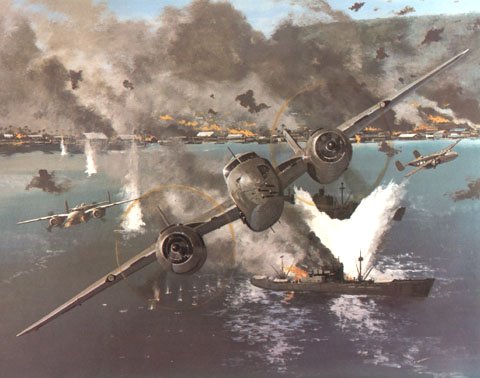
www.youtube.com/watch?v=YVLV67xILI4
http://aupress.au.af.mil/SAAS_Theses/SAASS_Out/Gann/gann.pdf
Disclaimer The views in this paper are entirely those of the author expressed under Air University principles of academic freedom and do not reflect official views of the School of Advanced Airpower Studies, Air University, the U.S. Air Force, or the Department of Defense. In accordance with Air Force Regulation 110-8, it is not copyrighted, but is the property of the United States Government
ABSTRACT
When Generals George C. Kenney and Ennis C. Whitehead became the two senior commanders of the U.S. Fifth Air Force in July 1942 their work was cut out for them. The previous January, the Japanese secured the port of Rabaul in eastern New Britain. They immediately began the drive down the east coast of New Guinea with the objective of driving the Allies from Port Moresby. For the next year and a half, in some the harshest climates of World War II, the Fifth Air Force helped to reverse the tide and drive the Japanese from eastern New Guinea. This was accomplished despite the Europe-first policy and an inappropriate doctrine based on high altitude, daylight, precision bombing. Kenney and Whitehead's first task was to modify existing aircraft and develop a suitable doctrine to interdict Japanese shipping between New Britain and New Guinea. In order to suppress ship-borne anti-aircraft artillery (AAA), forward-firing machine guns were mounted in the nose of Douglas A-20 light bombers and North American B-25 medium bombers. Low altitude skip-bombing tactics were borrowed from the British and perfected by constant practice and refinement. By February 1943, Allied intelligence, greatly aided by ULTRA intercepts, predicted the movement of a Japanese convoy destined for New Guinea. Kenney and Whitehead were determined to destroy the convoy with their recently modified commerce destroyer fleet and focused all their energies on doing so.
A dress rehearsal featuring the Fifth Air Force light and medium bombers as the main striking force was conducted in the Port Moresby Harbor. On March 3rd after being hit twice by mass, coordinated attacks, the convoy was virtually wiped out in what became known as the Battle of the Bismarck Sea. That same fleet of light and medium bombers also proved deadly against enemy airfields. Aircraft combat range was extended and modifications were made to the bomb bays to accept parachute fragmentation bombs. Airfield attack profiles were developed and once again, ULTRA provided a suitable target. In preparation for the anticipated Allied ground invasion of the Huon Peninsula, the Japanese moved the 4th Air Army to their four bases near Wewak. Beginning on August 17th, in a carefully- planned attack, Fifth Air Force bombers caught the enemy on the ground. By August 21st, nearly every aircraft at Wewak was destroyed. The subsequent Allied invasion was carried out virtually unopposed from the air. Fifth Air Force light and medium bomber operations during 1942 and 1943 are textbook examples of doctrinal flexibility and extraordinary innovation. The unprecedented success of both the Battle of the Bismarck Sea and the Wewak Raid illustrate how airpower became the dominant force in the Southwest Pacific.
LIST OF ABBREVIATIONS
A/A Antiaircraft artillery
AAA Antiaircraft artillery
AAF Army Air Forces
ACTS Air Corps Tactical School
AFB Air Force Base
AIB Allied Intelligence Bureau
APGC Air Proving Ground Command
AU Air University
AUL Air University Library
CB Central Bureau
HRA Historical Research Agency
RAAF Royal Australian Air Force
RAF Royal Air Force
RAN Royal Australian Navy
SWPA Southwest Pacific Area
USA United States Army
USAAF United States Army Air Forces
USAF United States Air Force
USN United States Navy
USSBS United States Strategic Bombing Survey
BIOGRAPHY Lieutenant Colonel Timothy D. Gann (BS, University of Southern California; MS, Embry-Riddle Aeronautical University) is a KC-1O pilot. A recent graduate of the inaugural class of the School of Advanced Airpower Studies, he was just assigned to the Doctrine Division, Headquarters USAF/XC, The Pentagon. Also a graduate of Air Command and Staff College, his previous assignment was Chief, Military History and Strategy Branch, Air Command and Staff College, Maxwell AFB, Alabama. Previous assignments included KC-10s at Seymour Johnson AFB, North Carolina, March AFB, California, and Barksdale AFB, Louisiana; and KC-135s at Seymour Johnson AFB.
Introduction
When the New Britain port of Rabaul fell to the Japanese on January 23, 1942, it represented a "base which could serve as the key staging and supply center for their ambitious plan of encircling and dominating the Coral Sea." [l] Their next task was to capture and control the two key land masses that crowned the Coral Sea--the Solomon Islands and New Guinea. After retreating from the Philippine Islands to Port Moresby in southeastern New Guinea, the Allied Air Forces, and later, the U.S. Fifth Air Force, U.S. air component of the Southwest Pacific Area (SWPA), was thrust into the role of leading the fight against the Japanese. [EDITOR: WOW. STOP. Naval aircraft carrier aviator BS is bad enough, we don't need a USAAC/F version. The only things that stopped the Japanese were American ground troops at this point. And this stoppage was greatly helped by USN submarines]. The challenge was immense. The Europe-first policy meant that few replacement aircraft, let alone additional combat groups, would be available for the foreseeable future. Those aircraft that survived early combat were badly in need of repair and in their present configuration, ill-suited for warfare in the SWPA. Perhaps as important, the USAAF's preferred doctrine of high altitude, daylight, precision bombing aimed at the industrial and economic structure of the enemy was of little use when the enemy's homeland was over 3500 miles away. [EDITOR: how about it doesn't work at all against civilians to make their nation-state government surrender unless it uses nuclear super high explosives or the civilians are foolishly in thin paper and wood houses vulnerable to firebombing? How about high-altitude dropping of unguided bombs only works when done en masse and in direct support of ground maneuver AKA Cobra break-out in 1944, B-52s in Vietnam etc.]
Warfare in the SWPA in 1942 and 1943 was much different than anywhere else in World War II. The combination of the harsh tropical climate and disease-infested jungles of New Guinea made overland transportation nearly impossible [CLOSED TERRAIN. Good thing the enemy did not have light armored tracks like the M113 Gavin]. Airfields and ground bases became precious fortresses. Their perimeters were heavily defended with numerous anti-aircraft artillery (AAA) guns, but the surrounding territory was normally unoccupied. Foraging was sparse, making resupply from rear areas essential. The lack of air transportation capability and the great distances between Rabaul and bases along the eastern coast of New Guinea put a premium on sea lines of communications. The Japanese realized the importance of maintaining the flow of supplies and armed its vessels with AAA and used its superior Zero fighter to provide escort. [EDITOR: WRONG. If the Japanese had realized how important sea supply ships were, they'd have PLACED A RUFE (Zero with floats) or other type seaplanes ON THEIR CARGO SHIPS FOR AAW/ASuW and ASW defense. They did not and the American "Betties", better armed and armored A-20s and B-25s got them.]
By the end of 1943, the Japanese were retreating from New Guinea's Huon Peninsula and were abandoning Rabaul. The ability of the Fifth Air Force to successfully accomplish its campaign by isolating the battlefield and destroying the Japanese air, ground, and sea forces was the key. Major General Charles A. Willoughby, SWPA G-2 affirmed this when he said, [I]t was [the Fifth Air Force], which had systematically cut down reinforcements and supplies from Rabaul to Buna, that had finally allowed [Major General Robert C.] Eichelberger to crash through on the ground...There would be other tough engagements on the ground but from 1943 on MacArthur elaborated the system of bypassing the Japanese strong points and neutralizing them by pounding them by air after their communications from Japan had been slowed or cut. [3] This decisive use of airpower was not achieved by thousand-plane heavy bomber raids. Instead, light and medium bombers flown in squadron-sized formations at minimum altitude became the main striking force. [EDITOR: to get DIRECT HITS the planes had to attack low and get direct line-of-sight like a guided missile to insure accuracy] How was the Fifth Air Force able to succeed so quickly using aircraft and tactics deemed of secondary value elsewhere? The answer can be found by examining two air campaigns. From March 3rd-5th, 1943, during the Battle of the Bismarck Sea, twelve ships containing the bulk of the Japanese 51st Division and its equipment were annihilated. Six months later, from August 17th-21st, over 200 aircraft, the bulk of the Japanese Fourth Air Army
at Wewak, were destroyed. This paper will elaborate on the contributions made by the Fifth Air Force light and medium bombers in those two monumental battles and what factors were most responsible for their success. But in order to put events in perspective, a brief prelude will review the air situation in the first nine months of the war. This will be followed by a look at the careers of the two airmen who led the way. The bulk of the paper will analyze the factors that directly contributed to the creation of the sea and airfield interdiction capability. The conclusion will note the significance of the achievements and suggest some relevance for the future.
PART I
Early Operations in the SWPA and Organization of the Air Units Shortly after securing Rabaul, the Japanese Seventeenth Army established its headquarters and began its drive down New Guinea's Papuan Peninsula. On February 9, 1942, Gasmata, New Britain, and Lae and Salamaua were captured and became key forward bases. By June, the Headquarters of the Japanese Southeastern Fleet was also established at Rabaul which included the Eighth Fleet and the Eleventh Air Fleet. Naval aircraft initially assigned to its defense and to support ground operations in New Guinea included 60 Zero fighters, 60-80 Nell and Betty bombers and over twenty floatplanes and flying boats. [4] In July, the Japanese Army received an unplanned reinforcement. Those forces originally destined for Midway were rerouted to Rabaul with orders to increase the Seventeenth Army's pressure towards Port Moresby. [5] No time was wasted: On 22 July Major General Tomitaro Horii landed some 4,400 troops at Gona, on the northeast coast of Papua. This force quickly occupied Buna; and by 28 July elements had penetrated inland to Kokoda, high in the Owen Stanley Mountains, where Australian [ground force] resistance was met. Additional men and supplies poured in, and a base of operations was established in the Buna-Gona area. By 22 August over 11,000 troops had landed, and the drive on Port Moresby began. [6] Allied aircraft attempted to counter the enemy landings by bombing the Japanese convoys from 25,000 feet. Despite meeting no air opposition, ten Boeing B-17 Flying Fortressess, five North American B-25 Mitchells, and six Martin B-26 Marauders could only hit one transport. One of the bombers and several fighters attempted low-altitude strafing and bombing attacks, meeting with slightly more success but by the afternoon the [enemy] troops were safely ashore. By the time the Fifth Air Force was formally constituted on September 3, 1942 many of its men and aircraft had been fighting for as long as nine months. [EDITOR: Boo-Hoo it was World War 2]. [7] After being badly mauled
during the initial Japanese attack on the Philippine Islands on December 8, 1941, American air units steadily retreated southward to northern Australia. By March, lead elements of the 3rd Bombardment Group (Light) began to arrive from the U.S. and absorbed those light and medium bomber assets that had not perished during the bloody retreat. [8] By April, the 3rd Bomb Group was flying sorties against New Guinea targets from the most northerly Allied base at Port Moresby. The Allied effort to save southeastern New Guinea was known as the Papuan Campaign. During the defensive phase, from July 21 to August 25, 1942, Fifth Air Force light and medium bombers concentrated on two types of missions: Modified Douglas A-20 Havocs strafed enemy troop and supply concentrations and B-25s and B-26s attacked Japanese convoys attempting to resupply forces in New Guinea. [9] In an effort to cut-off the Japanese from their supplies, Fifth Air Force bombers attacked enemy shipping by staging through Port Moresby, a distance of 700 miles from their main operating bases in Townsville, Australia. [l0] The results were pitiful. [EDITOR: Current flyboy narcissists will tell you its all about pilot skill and equipment is not important] During the month of August, 19 hits were achieved by dropping 434 bombs resulting in a 4.4% probability of hit. Only one transport and one cargo ship was sunk. September was worse. Out of 425 bombs dropped, only nine ships were hit and only one cargo ship was sunk resulting in a dismal 2.1% probability of hit. [ll] Fighting on the ground was ferocious. Allied air support, though valuable at times, was often "spotty" and anything but decisive. [EDITOR: Boo-Hoo again. Stop trying to fucking grab all the limelight. Why does aircraft have to be decisive? Is victory what matters or glorifying the Air Service?] But behind the scenes, the Fifth Air Force was steadily responding to the challenge. Units were being reorganized, outmoded tactics and aircraft discarded, and new and better ones developed. [EDITOR: No maverick innovator General Kenney was responding and adapting. If it wasn't for him the 5th Air Force would still be fucked up and have lots of excuses]
As commander of the Fifth Air Force, General George C. Kenney and his headquarters were located in Brisbane, Australia. Since the bulk of his time was spent supervising his two organizations and providing MacArthur with air expertise, an intermediate organization to manage combat operations was necessary. Accordingly, General [Ennis C.] Whitehead was made deputy air force commander and placed directly in charge at Port Moresby of Fifth Air Force, Advanced Echelon. ADVON, to use the abbreviated designation, had been conceived as a separate, small and highly mobile advanced headquarters, free of most administrative details and charged primarily with the immediate direction of combat operations. [12] By September 30, 1942, there were one light and two medium bomb groups in the V Bomber Command, bomber component of the Fifth Air Force. The 22nd Bombardment Group (Medium) had 38 x B-26Bs; the 38th Bombardment Group (Medium) had 63 x B-25s; and the 3rd Bomb Group had 13 x B-25s, 33 x A-20As and 8 x Douglas A-24 Dauntlesses which had already been pulled from combat. [13] Because of the priority given to operations in North Africa, no new groups would arrive until mid-March 1943. [14]
Beginning in November, the Allied ground forces shifted to the offensive climaxing in the defeat of the Japanese at Buna. Meanwhile, Fifth Air Force light and medium bombers continued to learn the tough lessons of war. Seeking to implement new counter-air techniques, airfield attacks using parachute fragmentation (parafrag) bombs were becoming "highly successful." [15] Strikes against enemy convoys also showed improvement, though the Japanese continued to supply their troops. The Fifth Air Force had come a long way in its first five months. Kenney summed it up best when he said, "we learned a lot and the next one will be better." [16]
The Earlier Careers of the Two Airmen at the Top Kenney arrived in Brisbane on July 28, 1942 and met with MacArthur the next day. [17] Having established an excellent working relationship with the Commander-in-Chief, Kenney immediately set out to energize the badly depressed air forces. During the preceding 25 years, his blend of operational, educational, and command experiences prepared him well for the challenges ahead. Prior to World War I, Kenney attended the Massachusetts Institute of Technology (MIT) and worked as an engineer, eventually heading a small engineering corporation. [18] In 1917, he enlisted in the U.S. Army. After completing flight training he was sent to Issoudun, France where he flew 75 missions in the Great War.
In these combat sorties Kenney whet his appetite for what was later coined "attack aviation." In France Kenney met Brig. Gen. William "Billy" Mitchell. According to Kenney, Mitchell directed him to fly "special missions." These were flights to find American troops, sometimes in large numbers, that had become lost...Kenney and his cohorts would fly at almost treetop level, looking for American uniforms. From that experience, according to Kenney, the idea of "attack aviation" came to him. It was safer to fly at low-altitude where aircraft were less exposed to ground fire. [19] After the war, unlike many officers who continued to hone their flying skills, Kenney "concentrated on aeronautical development and its application to warfare." In 1921, he graduated from the Air Service Engineering School and finished first in his class. Next, he was assigned to the Curtiss factory where he tested aircraft and became the Air Service representative. [21] Returning to McCook Field, Ohio in 1923, Kenney reported to the Engineering Division where once again he demonstrated a knack for innovation. [22] Energetic and restless as ever, he conceived the idea of mounting [machine guns] on a plane's wings instead of on the engine cowling where they had to be synchronized to fire, at a much slower rate, through the propeller arc. He demonstrated its feasibility by attaching two .30-caliber [machine guns] to the
wings of a considerably modified DH-4. It was an idea ahead of it time, a significant though rejected breakthrough in the development of aircraft armament. [23] In 1926, Kenney graduated from the Air Corps Tactical School (ACTS) at Langley Field, Virginia, and returned a year later as an instructor in the attack section. [24] He put his time to good use at the ACTS. Seeking a way to enhance the capability of the low-level aircraft, he helped develop the parafrag bomb. [25]
Kenney was truly an attack aviation enthusiast and presided over its zenith at the ACTS. In an interview many years later he reminisced of his days at Langley: Well the thing that I was interested in more than anything else was attack. I taught attack aviation there (ACTS) and wrote the textbook on it and developed the tactics by using the class as tools to build the tactics at low altitude work. [26] When Kenney departed the ACTS, attack aviation slowly declined in importance; due partly to his absence and partly to the school's growing emphasis on bombardment. [27] In 1938, he became the Chief, Production Engineering Section at the Air Corps Materiel Division where he gained the reputation of a "trouble shooter." [28] During this and previous tours at McCook Field, Kenney developed his appreciation for the other side of combat airpower--supply, aircraft maintenance, and modification. He left there an "ardent advocate of air power and of expanded funding for military research and development." [29] As the German war machine rolled through France, Kenney was sent to Paris as the Assistant Attache for Air Observing the Luftwaffe's rapid successes, he made numerous recommendations for improvements in U.S. aircraft. [30] Kenney left Europe convinced "the U.S. Army Air Corps was markedly inferior to the major European air forces in quantity and quality of planes and personnel." [31] Whitehead arrived in Brisbane on July 11, 1942, met with MacArthur and was warmly received. [32] A little over two weeks later, Whitehead was named Deputy Commander, Fifth Air
Force. Like Kenney, Whitehead came to the SWPA with talents and experiences that served him and his future combat crews well. Whitehead also enlisted in the U.S. Army during World War I. After flight training he too was sent to Issoudun, France where he served as an instructor and test pilot. [33] When the war ended, he returned to college and graduated from Kansas University with a Bachelor of Arts degree in Journalism. [34] Yearning to return to flying, he reentered the service in 1920 and flew fighters in the 94th Pursuit Squadron.[35] In 1921, his unit deployed to Langley Field to participate in bombing tests of the Ostfriesland under the supervision of Billy Mitchell. [36] Whitehead's formation of fighters was the first to attack the German battleship giving him the opportunity to witness first-hand the vulnerability of a surface vessel to a well-planned aerial attack. In 1926, Whitehead graduated from the Air Service Engineering School and, like his future boss, graduated first in his class. [37] After attending the ACTS in 1930, he completed several tours in fighters and reported to the War Department General Staff in the Military Intelligence Division (G-2). Two years later he became G-2's first chief of the Aviation Section. [38] This tour in intelligence was particularly beneficial to him and the Fifth Air Force. The assignment in Washington was perhaps one of the most important ones that Ennis Whitehead ever had, not for the contacts he made, although the contacts were important, but for the knowledge which he obtained on the use of air power by the Germans and British during the Blitzkrieg days...Through his job with G-2, Whitehead learned quickly the flexibility and mobility of air power. [39] While at G-2, Whitehead was able to expand his concept of airpower. One of his conclusions was "that [airpower] could be used for other things beside [strategic] bombing, among them: mine laying, carrying of troops, and interdiction of the battlefield." [40] MacArthur found two airmen who were eminently qualified to direct the SWPA's air
campaign. Both were veterans of World War I and excelled in engineering. Though they were vocal advocates of airpower and had enjoyed personal contact with Billy Mitchell, neither had become strategic bombing zealots. While Kenney was in Europe watching the start of World War II, Whitehead was in Washington building an air intelligence framework. Kenney was the attack man, Whitehead knew fighters. Their experience and pragmatic attitudes became essential ingredients in the Fifth Air Force's recipe for success. Perhaps most important, in a theater where the size of egos was legendary, the two men worked well as a team. Kenney had great confidence in Whitehead. He would forward general operational directives from Brisbane, allowing his subordinate great flexibility in carrying out the assigned mission. The two men communicated with each other practically on a daily basis to work out operational details. They would maintain a strong, close personal and professional relationship throughout the war. [41] Their work was cut out for them.
In order to get the air war on track they had to find some aircraft that could take the fight to the Japanese. Enhancing the Air Fleet In August 1942, the 3rd Bomb Group's 89th Bombardment Squadron received their shipment of A-20As from Savannah, Georgia. These A-20s were normally configured with four fixed, forward-firing .30-caliber [medium] machine guns mounted against the fuselage and three flexible guns in the rear gunner section. [42] Unfortunately, the squadron's guns did not make the shipment. To add to their frustration, with a combat range of only 525 miles, the A-20s lacked the reach to strike most Japanese targets. In its present state, the 89th wasn't going to see any fighting in the near future. Knowing that replacements were not on the horizon, the mechanics of the 3rd Bomb Group under the supervision of Major Paul I. (Pappy) Gunn, went to work modifying their A-20s.
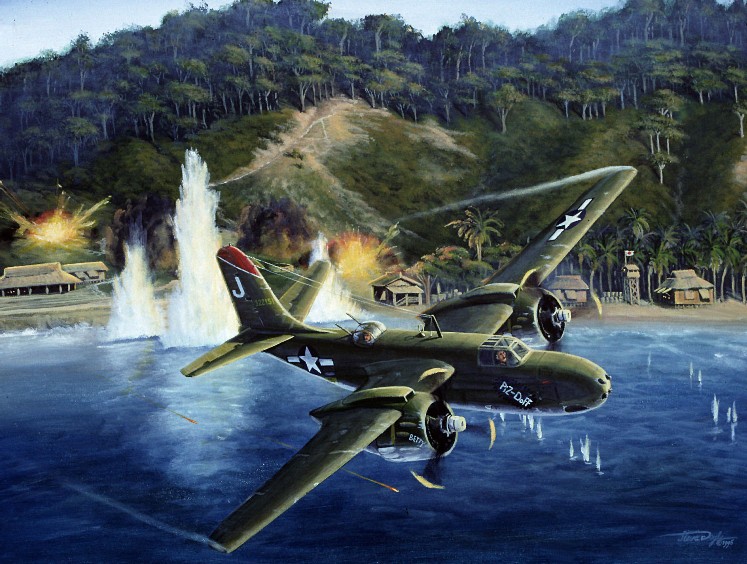
To increase the range, two 450-gallon fuel tanks were installed in the forward bomb bay.[43] The resultant loss of bomb load was offset by inserting four .50-caliber fixed, forward- firing [heavy] machine guns in the nose in place of the bombardier station. [44] This package installation was a design masterpiece and was eventually adopted throughout the Pacific, European, and China-Burma-India Theaters. When combined with the remaining four fixed, .30-caliber fuselage [medium machine] guns, the A-20A became a potent strafing weapon. Prior to departing for Australia, Kenney discovered 3000 parafrag bombs stored in war reserve and requested their transfer to the SWPA. These were the same bombs he began developing in 1928. A parachute was attached to a 23-pound bomb and given a supersensitive instantaneous fuze. The parachute stopped the forward momentum of the bomb and gave the low-flying attack aircraft a chance to depart the fragmentation pattern. [45] Upon detonation, the bomb burst into between 800 and 1200 pieces. It was designed to strike airplanes, small open boats, searchlights, trucks, artillery tractors, mechanized forces, personnel and animals--perfect for the jungle targets of New Guinea. [46] When the parafrags arrived in late August, Pappy Gunn once again supervised the modification effort. A honeycomb rack was fastened to the A-20's rear bomb bay which allowed 40 or more bombs to be carried.[47] After considerable flight testing the new platform was ready for combat trials. An experiment using parachute bombs was tried in a carefully coordinated attack on Buna. On 12 September 1942, seven B-17's swept in through rain squalls and heavy anti-aircraft fire to drop 300-pound demolition bombs from 3,000 feet on the airdrome. These were followed by additional demolition bombs dropped by five B-26's from 5,000 feet. Finally, and under a cover provided by [Bell] P-400's, A-20s roared over the target area at 70 feet pouring .30- and .50-caliber bullets into parked enemy planes and loosing over 300 x 23-pound parachute bombs. In spite of poor visibility, all anti-aircraft fire was silenced, and the A-20 group commander claimed 17 x Zeros destroyed on the ground...This was the first reported use of parachute bombs in the Southwest Pacific.[48]
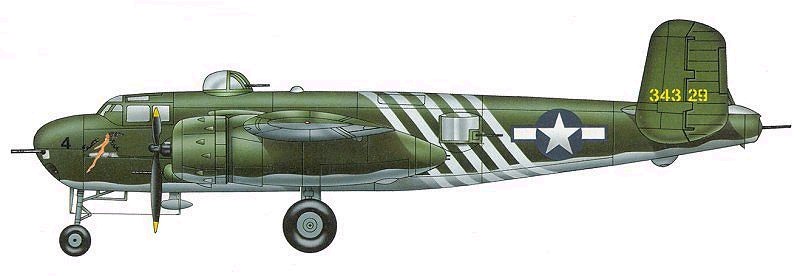
Another unit in the 3rd Bomb Group, the 90th Bombardment Squadron, received B-25Cs originally destined for Dutch airmen in the Netherlands East Indies. The B-25s were armed with two .50-caliber [heavy machine] guns in the upper turret, two more in a retractable belly turret and a single flexible .30-caliber [medium machine] gun in the nose. [49] After the show put on by the A-20s, Kenney directed Pappy Gunn to go to work on the B-25s. His original request was formidable: I sent word to...pull the bombardier and everything else out of the nose of a B-25 medium bomber and fill it full of fifty-caliber [heavy machine] guns, with 500 rounds of ammunition per gun. I told him I wanted him then to strap some more on the sides of the fuselage, and three underneath. [50] After experimentation, the three guns underneath the nose were deemed impractical. However, four .50-caliber [heavy] machine guns in vertical pairs were attached to the side of the fuselage and a package installation similar to the A-20 was inserted in the nose. Since the B-25s would be flown at low altitude, the tail and belly turrets were removed. [51] When the upper turret was turned forward, the newly designated B-25C-ls could concentrate ten .50-caliber [heavy machine] guns on the target. These modifications were the first step in transforming the Fifth Air Force light and medium bombers into potent killers. Bypassing the normal USAAF bureaucracy and often conducting tests in combat, the aircraft were ready in weeks instead of months or years. The next step was to train the crews and develop the tactics. The Evolution of Skip-Bombing Reflecting their interwar doctrine, early USAAF units used conventional bombing tactics against enemy shipping. Plans called for, "flights of sufficient size to assure a pattern of bombing large enough to cover any possible move of the target in the interval between release and impact of the bomb." Typical high altitude attacks were flown at 20,000 feet to avoid the
effective range of enemy AAA. With a constant shortage of bombers and escort fighters, the results were often poor.
[EDITOR: REALITY CHECK. ITS A LOT HARDER THAN MOST PEOPLE THINK TO AIR BOMB A MOVING SHIP AND HIT IT TO SINK IT. THIS IS WHY AFTER PEARL HARBOR, WHERE OUR SHIPS WERE SITTING STILL WE NEVER LOST ANOTHER HEAVILY ARMORED BATTLESHIP TO AIR ATTACK SINCE THEY WERE KEPT MOVING AND HAD AT LEAST SOME AIRCRAFT TO SPOIL THE AIMING OF ENEMY AIRCRAFT. THE HMS REPULSE AND PRINCE OF WALES DID NOT HAVE THIS OR THEY WOULD HAVE BEEN SAVED. EVERY SURFACE SHIP SHOULD HAVE ITS OWN AIRCRAFT FOR SELF-PROTECTION.]
A tactical study prepared by the USAAF Headquarters determined "it was apparent that the answer still had not been found to the problem of successfully bombing floating targets, particularly fleeting or maneuvering targets, with a small force of bombers and fighters." [53] The Fifth Air Force eventually found the answer in skip-bombing. Though they can deservedly take credit for skip-bombing's first decisive use, the concept did not originate in the SWPA. Earlier in the war, the RAF used this technique to attack German shipping. On September 4, 1939, 15 x Bristol Blenheim bombers assaulted enemy vessels near the entrance to Wilhelmshaven. "The Blenheims attacked the pocket-battleship Admiral Scheer in the Schillig Roads with great gallantry at low-level, hitting the ship four times." [54] In April 1941, General H.H. Arnold visited Great Britain to observe and discuss the war. During a dinner hosted by Prime Minister Winston Churchill, several senior British officers discussed the merits of skip-bombing. Arnold recalled in his memoirs, "I learned about skip-bombing that night. The British claimed to have had wonderful success with that method and to have made far more hits than with high altitude bombing." [55] When Arnold returned to Washington, he directed the Air Proving Ground Command (APGC) at Eglin Field, Florida to carry out further tests. [56] The test report was formally completed on December 7, 1942. Its objective was to "determine the practicability of effectively attacking water-borne surface vessels from minimum altitudes with demolition bombs," [57] and to "develop tactics and techniques for accomplishing such attacks." [58] The report fully endorsed the concept and recommended that "training of pilots
in these techniques be initiated at the earliest possible moment." [59] Two methods of attack were deemed highly effective:
(1) Quartering front attack on armored surface vessels (more than one (1) inch of side armor plate) at maximum level flight speed and one hundred-fifty (150) feet to three-hundred (300) feet altitude, dropping one-thousand (1,000) pound or two-thousand (2,000) pound demolition bombs...
(2) Broadside attack on unarmored or lightly armored surface vessels (less than one (1) inch of side armor plate) at maximum level flight speed and at the minimum altitude necessary to clear the target, dropping demolition bombs of any appropriate size...[60]
In July 1942, during the long flight from the U.S. to Australia, Kenney, who was already aware of the Fifth Air Force's poor bombing record, pondered a means to improve their accuracy. With a long-held belief in the value of low-altitude attacks, he and his aide, Major William Benn, discussed the practicality of skip-bombing. During a stop in Nandi in the Fiji Islands, they decided to conduct an impromptu test: It looked as though there might be something in dropping a bomb, with a five-second-delay fuze, from level flight at an altitude of about fifty feet and a few hundred feet away from a vessel, with the idea of having the bomb skip along the water until it bumped into the side of the ship...The more we talked about the scheme, the more enthusiastic we got, so finally we borrowed a B-26 from the boys at Nandi, loaded on some dummy bombs, and tried the idea out against some coral knobs just offshore. [61]
Thus, when Kenney and Benn arrived in Australia skip-bombing became a priority. Shortly after getting acclimated to his new position, Kenney "fired" his aide and appointed Benn commander of the 63rd Bombardment Squadron, a B-17 unit in the 43rd Bombardment Group (Heavy). In October 1942, Benn initiated skip-bombing tests using his squadron's B-17s. He quickly achieved success: It was already accepted that their first problem would be to find the correct altitude and air speed for the release of the bomb in order that it hit into the side of the target. The target chosen was a small sand bar surrounded by shallow water. This was selected for the initial runs instead of the wrecked ship at Port Moresby
in order that they could observe the skip of the bomb, and check the distance and height...After this preparation, it was decided to make test runs on the wrecked ship...The second bomb was a direct hit. [62] However, Benn's enthusiasm for skip-bombing was tempered by his understanding of the heavy bomber's limitations. In the after-action notes of the trials, the commander of the 43rd Bomb Group cautioned:
Skip bombing with heavy bombardment aircraft must be considered an attack of opportunity. An attempt to skip-bomb a war vessel in the daylight, unsupported, would be hazardous, because of lack of speed, maneuverability, and small amount of forward fire. Successful daylight attacks have been made on unescorted merchant vessels by heavy bombers. Repeated skip bombing attacks in the same area would result in some form of protection to defeat it...[63]
[EDITOR: the Japanese might wake up and equip each of their supply ships with a seaplane fighter! So let's not waste the secret weapon/technique using B-17 heavy bombers lest they develop a countermeasure]
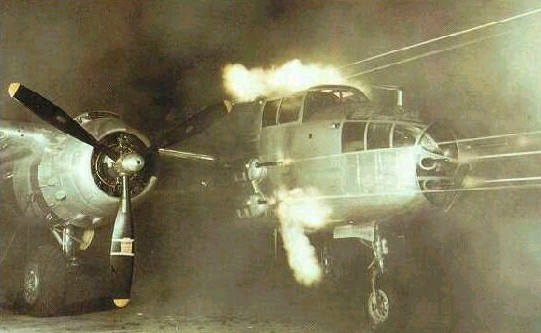

Fortunately, by now the Fifth Air Force had two types of aircraft that exceeded the B-17 in speed, maneuverability, and forward firepower--the modified A-20As and the B-25C-1s. During December, 90th Bomb Squadron crews skip-bombed the Moresby Wreck with their B-25C-ls. Once the B-25 crews became comfortable with the basic concept they made one key refinement. To eliminate the need to calculate the ricochet distance, they timed their release to hit the side of the ships, instead of bouncing short. This method was coined "masthead height bombing." The runs on the wreck allowed [the B-25 crews] to pick out a reference point on the nose of the airplane to use as a bomb sight, and gave them experience in low-level turns and confidence in their ability to hit a ship. [64] After sufficient practice, the V Bomber Command was so confident of the new masthead technique that they proclaimed, "A well-trained pilot should hit a ship nearly every time using the [masthead technique]." [65] Because masthead height bombing required the aircraft to fly immediately over the target, determining the correct fuzing delay was critical. Fortunately, as part of the skip-bombing tests, the APGC also looked at special fuzes. The report stated:
A tail fuze...burning in air to produce a minimum of delay of four (4) seconds, will provide a probable minimum safety margin of approximately seven-hundred (700) feet from the detonation of ricochetting one-hundred (100) pound and five-hundred (500) pound aerial bombs. [66] The APGC specifically approved the use of the M106 type fuze. [67] After some further experimentation, the Fifth Air Force used the M106 paired with an Australian detonator set for a five-second delay.[68] Tests using this configuration went reasonably well but not without some difficulties: One plane was badly damaged and made a forced landing on a reef as a result of an instantaneous detonation; another bomb hit the wreck and the bomb exploded almost instantaneously inside the wreck and splattered the belly of the B-25C-1 with rust and small fragments but did no other damage. [69] The final evolution in the newly christened "commerce destroyer" fleet was to develop a tactic to ensure the B-25s could get close enough to the target vessel to release the bomb without getting sprayed by AAA. On initial attempts against Japanese shipping, many aircraft had returned "badly shot up from enemy light- and medium-caliber ship-borne antiaircraft fire." [70] Ten forward-firing .50-caliber [heavy machine] guns would silence most enemy AAA but twenty even sounded better. Once again, a suitable tactic was created: B-25 crews were trained to attack in pairs simultaneously. One plane strafed the vessel from stern-to-stem and from stem-to-stern, while the other strafed the vessel as it came in on its beam and bombed it. As the result of prolonged practice, pairs of B-25's learned to attack a vessel at a gliding speed of 250 to 275 mph, and knew the firepower of one B- 25 would be raking the side of the vessel during the split second that the other strafed and bombed the beam. [71] The next step for the Fifth Air Force was to find a Japanese convoy and destroy it in a decisive engagement before the enemy developed countermeasures.
[EDITOR: respect for the enemy. How refreshing and absent today.]
Locating the Convoy
At the conclusion of the Papuan Campaign, Fifth Air Force planners probed their intelligence sources to find one of the periodic Japanese resupply convoys between Rabaul and New Guinea. By early 1943, the Allied intelligence capability under the centralized direction of Headquarters, SWPA was substantial.
Organized shortly after MacArthur's arrival in May, 1942, it included: (1) Allied Translator and Interpreter Section (ATIS) which trained, organized, and sent into the field linguist detachments to interrogate prisoners of war and translate captured documents; (2) Allied Intelligence Bureau (AIB) which conducted clandestine operations, sabotage, and espionage behind the enemy lines and in enemy-held territories; (3) Allied Geographical Section (AGS) which gathered and published geographical information on areas within the SWPA;... (4) Central Bureau (CB) which was an inter-Allied cryptanalytical service, co-ordinated with British and United States establishments. [72] These organizations and their parent unit, SWPA G-2 were busy during the first two months of 1943 trying to determine when the Japanese would reinforce their beleaguered units at Lae and Salamaua. In early February, Fifth Air Force reconnaissance coverage intensified and evidence of an upcoming operation began to mount: At Lae in the first five days of February allied reconnaissance revealed increased ground and renewed air activity, the repair of the runway, and construction of the blast bays. The air activity suggested the importation of supplies while the repair work was recognized as a characteristic enemy effort to recondition the airdrome for [land-based] fighter airplanes assigned to protect an expected [ship] convoy bringing further reinforcements. [73] Reconnaissance flights continued and on February 7th a Japanese floatplane was sighted near Gasmata. The enemy typically forward-deployed floatplanes for use as antisubmarine patrol for their shipping. [74] During the next week, increased Japanese air and submarine activity in the vicinity of Lae furthered Allied suspicions. [75]
Reconnaissance aircraft also monitored Japanese shipping levels in Rabaul. During December 1942 and the first half of January 1943 approximately 65 merchant ships totalling 200,000 tons were observed. In the last week of January, the number dipped to less than 45 totalling approximately 170,000 tons. However, beginning on February 12th, and lasting throughout the month, the number soared to almost 80 ships in excess of 250,000 tons. [76] By the third week in February, G-2 saw enough and in their daily summary made the following prediction: "Merchant shipping at Rabaul has reached a new high...In view of the comparative inactivity in the Solomons, this increase over the normal assumes serious aspects, in relation to possible employment against New Guinea." [77] In addition to scouting reports, G-2 also tapped its highly valuable signals intelligence sources. Receiving raw decrypts and intercepts from SWPA CB, U.S. Navy, and Allied agencies in Australia, MacArthur's intelligence personnel integrated this data with aerial reconnaissance and provided remarkably accurate predictions.[78] On February 19th, the U.S. Navy cryptanalysis unit based in Melbourne, Australia presented MacArthur with ULTRA traffic that confidently stated "the Japanese planned to land at Lae in early March." [79] This unbelievable and timely breakthrough was achieved by the kind of interservice cooperation rarely noted in historical accounts of the Pacific War: Since February 8, navy cryptanalysts in Washington had labored to decipher an intercepted Japanese naval message. Eight days later, despite difficulties in translation, the broken message revealed that the convoy scheduled to RZM--the Japanese designation for Lae-- had to be changed to add more destroyer transports. Seventeen hours later, a better translation clarified Japanese plans to dispatch three separate convoys, one each to land at Madang, Wewak, and Lae. The CINCPAC (Commander in Chief, Pacific) Intelligence Bulletin for February 19 reported the forthcoming simultaneous reinforcement and noted that the 20th and 41st divisions would be taken to Madang and Wewak in transports while transports and destroyers would carry troops to Lae.[80]
Allied air planners now knew where the convoys were coming from, their approximate size, and departure and arrival dates. But one key piece of information was still missing. Would the convoys depart from Rabaul as a unit and spilt up enroute or would they take separate routes? To cover all possibilities, Whitehead's men considered three possibilities: The entire convoy could land at Madang/Wewak; it could split up with half going to Madang/Wewak and half to Lae; or the entire convoy could land at Lae. To cover each contingency, planners devised the following strategy: If the entire convoy landed at Madang, the strike would consist of only heavy bombers since light and medium bombers lacked sufficient range. If the convoy split, heavy bombers would attack the ships heading for Madang and light and medium bombers would strike the remainder after passing through the Vitiaz/Dampier Straits. Finally if the entire convoy was headed to Lae, a coordinated attack using light, medium, and heavy bombers would strike it once within the light bomber's range.[81] Allied reconnaissance flights were stepped up to determine which route the convoy would take (i.e., north or south of New Britain) and the destination.82 Once again, these flights gave Allied planners valuable clues: In the last few days before February 27 there was obtained more evidence throughout the coastal area from Lae to Wewak of systematic developments and the imminence of substantial reinforcements by convoy. In addition, landing barges were seen to approach Salamaua and more submarine traffic was noted at Lae. [83] Allied weather forecasters predicted heavy cloud cover in the area north of New Britain and clear weather in the south for the first several days of March. From this information Kenney and Whitehead deduced that the Japanese would choose the northern route to stay underneath the cloud deck. [84] At about the same time, Navy cryptanalysis provided even further clarification:
Washington needed three days to decrypt a February 21 Eleventh Air Fleet message that pinpointed a six-ship convoy destined to land the 51st Division about March 5. [85] The final piece of the puzzle was in place. Combining hard evidence with sound judgment and intuition, the Fifth Air Force finally found a suitable target for their commerce destroyer fleet. In combat, such an opportunity comes rarely. Kenney and Whitehead were determined to make the most of it. The Development of the Attack Plan and Dress Rehearsal With the advantage of surprise, Kenney and Whitehead decided to hit the Japanese convoy with a mass, coordinated attack. The A-20s, even with their increased range, had the shortest "legs." Thus, a point within their combat radius, just off Finschaven inside the Vitiaz/Dampier Straits was selected as the target area. Heavy bombers would track and harass the convoy until it cleared the straits and then the entire force would strangle it. [86] The Papuan Campaign and the rigors of flying in the SWPA had taken its toll on the Allied Air Force aircraft. On March 1st, the Fifth Air Force was down to only one light and one understrength medium bomb group available for action. The 3rd Bomb Group had 17 x B-25s and 15 x A-20s and the 38th Bomb Group had 11 x B-25s immediately ready. The 22nd Bomb Group and its B-26s were so badly shot up they had been sent back to Australia for rest and recuperation. The Royal Australian Air Force (RAAF) 9th Group had an additional six A-20s (Bostons) and 13 x Bristol Beaufighters available. [87] With so few aircraft, Whitehead stood down the light and medium bombers to “conserve their strength.”88 The units could afford to rest because they had already demonstrated proficiency in the new skip-bombing concept during previous crew familiarization flights. “The pilots trained for six weeks before the Bismarck Sea
Convoy engagement and each pilot dropped thirty to forty bombs (one bomb to a run) on the Moresby Wreck.”89 Attacks against an unarmed, stationary hulk only proved the crews could physically hit the target. In order to inflict enough damage to the convoy to prevent it from landing men and supplies ashore, the Fifth Air Force needed a plan that would deliver an unprecedented degree of concentrated, coordinated firepower. Such an attack plan required precision both in planning and execution because every available aircraft would play an essential role. Mass, coordinated attacks were not invented in the SWPA. A member of Kenney's staff, RAAF Group Captain Bill Garing, had participated in coordinated attacks while piloting Short Sunderland flying boats in the European Theater. [90] Furthermore, when skip-bombing was being tested at Eglin, [t]he men who supervised the tests and who evaluated the results had the vision to foresee how this [skip-bombing] could be part of a broader technique, one which would employ low-level attacks as the power punch of mass coordinated attacks...[91] Regardless of the payoff, the plan was risky. As previously mentioned, the range of the light bombers would determine the location of the “kill box.” Unfortunately, that point was uncomfortably close to the convoy's final destination and afforded little room for error. Furthermore, a mass, coordinated attack was by-definition complex. Once the convoy was pinpointed, Fifth Air Force planners had to predict its exact time of arrival at the attack location. Next, the light and medium bombers would have to launch and affect a rendezvous with the participating heavy bombers and friendly fighters. Once assembled, the entire group would proceed to the convoy's projected location, After sighting the convoy, they had to readjust the formation to properly align the attack elements and commence the attack. All this would have to
be accomplished while avoiding hostile fighters and AAA as well as the danger of a mid-air collision. During the attack, to avoid fratricide or duplication of effort, sequencing was particularly critical. In order to minimize the chance for errors, Whitehead decided to conduct two rehearsals. The first was scheduled for February 28th, and the second, March 3rd. [92] On the first rehearsal, an attacking force of 3 x B-17's (representing 3 flights), 4 Beaufighters, 4 x B-25's, 4 x B-25C- l's and 3 x A-20's escorted by 8 [Lockheed] P-38's bombed the Moresby Wreck in a coordinated attack which went off smoothly. Eight [Bell] P-39's represented the opposition. Nearly all squadron leaders and many flight leaders participated and discussed tactics among themselves and with their squadrons before and after the -attack. [93] Thus far only the A-20s and B-25C-1s had received the nosegun modifications that would suppress the AAA during the masthead height attacks. During the rehearsal, the Beaufighter and unmodified B-25 crews combined their individual capabilities to give the B-25s protection during the final low altitude runs. The Beaufighters, firing their four 20mm cannons and six 30-caliber [medium] machine guns cleared a path. Immediately behind and slightly above roared the B-25s. At the release point the bombs were dropped and both aircraft escaped with the B-25 upper turret swung around to fire back at the ships. After the rehearsal the B-25 and Beaufighter squadron commanders discussed the results and made necessary adjustments. [94] Participating crews returned to their bases and briefed their squadron mates on the game plan. The following day, morale was high as the crews waited for the execution message. An entry in the 90th Bomb Squadron's log typified the feelings: News at night of a 14 ship convoy coming down from Rabaul...are on the north coast of New Britain...all of Port Moresby alerted for this shipping...the 90th working feverishly...guns loaded...bombs aboard...crews listed...silently, but efficiently, the 90th were at their jobs [95]
The Convoy is Sighted and the Attacks Commence
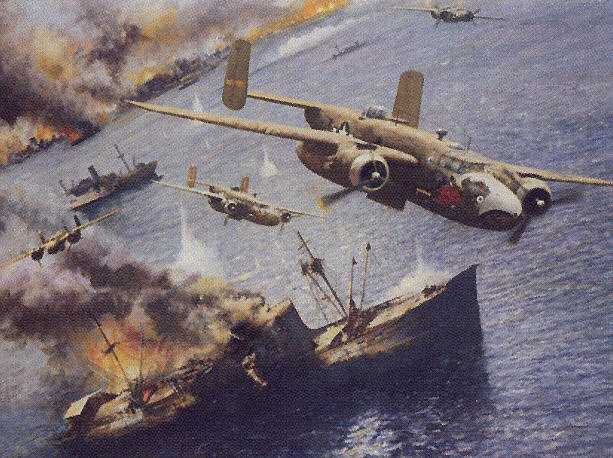
On March 1, 1943 at 1500 (New Guinea time), a 90th Bombardment Group (Heavy) Consolidated B-24 Liberator sighted the Lae convoy. Its location was about 100 miles west of Rabaul heading southwest.[96] Throughout the day and night, in very rough weather, heavy bombers shadowed the convoy. The first attack occurred on March 2nd. Still out of range of the A-20s, 26 x B-17s and 2 B-24s, in a quick though apparently not predetermined succession of bombing runs...flying individually and in elements of two and three [97] carpetbombed the convoy from 4500 to 8000 feet. Escorted by 16 x P-38s which engaged an estimated 30 x Japanese fighters, several ships were hit and presumably sunk.
Although several B-17s received some damage, all returned to base. Reconnaissance aircraft continued to monitor and strike the convoy throughout March 2nd and early March 3rd. During the morning of March 3rd, the convoy was within range for the mass, coordinated attack. At 0803, the attack order was transmitted:
ENEMY CONVOY CONSISTING OF ONE CRUISER, SIX DESTROYERS, TWO TRANSPORTS, FOUR CARGO APPROACHING NEW GUINEA; PROBABLE DESTINATION LAE LAST REPORTED POSITION LATITUDE 0654S LONGITUDE 14805E, COURSE 270 SPEED 10 TIME 0615/L CONVOY PROTECTED BY ENEMY FIGHTERS DURING DAYLIGHT HOURS...V BOM COM WITH MAXIMUM STRIKING FORCE OF MEDIUM, HEAVY, AND LIGHT BOMBARDMENT SUPPORTED BY P-38'S WILL ATTACK ENEMY CONVOY WHEN IN RANGE OF LIGHT BOMBARDMENT. THE ATTACK WILL BE MADE BY ONE SQUADRON B-17'S (12 AIRPLANES) FOUR SQUADRONS B-25'S ONE SQUADRON BEAUFIGHTERS, ONE SQUADRON A-20'S ESCORTED BY TWO SQUADRONS P-38'S...[98]
Finally, the Fifth Air Force would find out if all the aircraft modifications, tactical innovations, planning, and practice would pay-off. The aircraft assembled at their assigned altitudes over Cape Ward Hunt on the north coast of New Guinea. Departing from the rendezvous point at 0930 they headed for the convoy. The first aircraft to strike were the
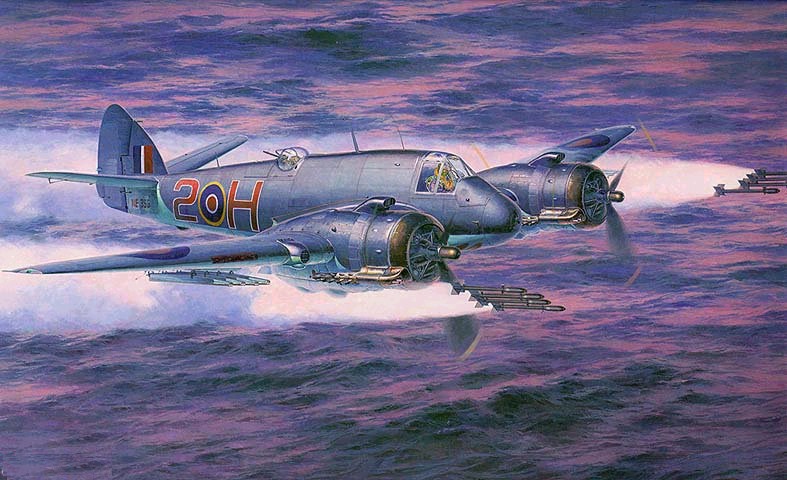
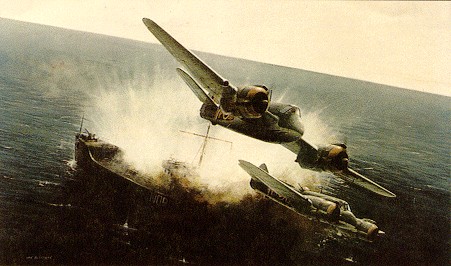
Beaufighters. Flying line abreast, they evaded the destroyer screen and thoroughly strafed the merchant ships' decks, superstructure and cargo. Racing in just above and behind them came the six unmodified B-25s carrying 500-pound bombs with the 5-second delays. [99] Next from masthead height, were twelve A-20s, loaded with 500-pound bombs. According to aircrew reports, of the twenty bombs delivered, they scored ten direct hits and two near misses on seven ships.[100] Minutes later, B-17s dropped their 1,000-pound demolition bombs from 6,000 to 9,000 feet and engaged the estimated 30 enemy fighters.[101] Cueing off the low altitude B- 25s, another seven B-25s dropped 35 x 500-pound instantaneously-fuzed bombs from 3,000 to 7,000 feet.[102]
They were followed minutes later by another six B-25s at medium level dropping 19 bombs. Between the last two medium altitude B-25 attacks came the fleet the Fifth Air Force had worked so hard to develop during the last three months. After sighting the convoy, twelve B-25C-1s, each carrying three or four 500-pound bombs split into three elements. As they approached the convoy, the aircraft peeled off individually and commenced their masthead height attacks.[103] The results were devastating: The [B-25C-1] pilot...made one run on an undamaged destroyer leader or light cruiser, and flew through considerable heavy A/A. He saw tracers from light A/A just before he opened fire. By tapping the rudders slightly during his approach, he covered the deck of the ship and when he levelled off 300 feet from the ship he received no fire. His co-pilot dropped two 500 pound bombs; one hit short but the other hit the ship just at water level and the explosion rolled it partly over, it righted but sank within a few minutes. He hit a medium sized cargo vessel with another 500 pound bomb after starting a strafing run. The bomb caused a heavy explosion and the ship sank.[104] B-17s flying at 7000 feet continued their horizontal attacks dropping 1000-pound bombs throughout the hour. By the time the last bomber left the area, according to observations from survivors of the Lae convoy, "every remaining merchant vessel...was damaged in one way or
another." [105] Throughout the morning and early afternoon individual bombers continued to monitor and attack the floundering vessels. After returning to their airfields, the aircraft reloaded for the second and final coordinated attack. Rendezvousing at 1400 hours, four B-25s, eight B-25C-1s and three A-20s struck at masthead height; ten B-25s, and five Bostons bombed from medium altitudes (3000 to 6000 feet) and eleven B-17s dropped bombs from 7,000 feet.[106] Although interrupted by rough weather along the route the force sighted the convoy, now dispersed and in disarray. With orders to concentrate on the merchant shipping, the crews discovered that few remained. Instead they went after the destroyers "which in fact was to be the principal accomplishment of [the] afternoon's attacks." [107] By this time, the water was full of Japanese survivors in "all manner of rafts, life boats, launches, and barges." [108] Allied aircraft with remaining ammunition strafed them to efface every possible trace of the convoy so that none of the reinforcements might reach the hard-pressed Japanese on New Guinea a vital consideration to the Allies." [109]
[EDITOR: WAIT A FUCKING MINUTE!!!! THIS IS A FUCKING WAR CRIME!!!! WHO THE FUCK ARE WE TO COMPLAIN WHEN THE JAPS GUN DOWN OUR SURVIVORS IN THE WATER WHEN WE DO THE SAME? WHY DIDN'T THIS AIR FORCE WORSHIPPING AUTHOR SAY A DAMN THING ABOUT THIS?]
The Results of the Battle On the tactical level, the Battle of the Bismarck Sea was a clear rout. The exact number of enemy losses remains unclear to this day. However, most post-war accounts agree that eight transports and four destroyers along with all the division's equipment were sunk, and approximately 2890 out of 8740 ground troops drowned.[110] In the air, 60 aircraft were claimed destroyed with a further 25-39 probably lost. On the Allied side, three P-38s and one B-17 were lost in combat and one B-25 was destroyed in a landing accident. Amazingly, only 14 Allied airmen were killed.[111] The Japanese ground forces at Lae were left without the necessary
reinforcement and any hopes of further drives back down the Papuan Peninsula were dashed forever. However, the Battle of the Bismarck Sea's greater contribution to the eventual Allied victory was in the affect it had on the senior leadership on both sides in the Southwest Pacific. The utter destruction of the convoy led the Japanese Eighth Area Army at Rabaul to shift its reinforcement of New Guinea through more northern bases in Wewak and Madang.[112] “Japanese reaction to the shock was apparent along his entire chain of command. Not until the Leyte campaign did he again attempt to resupply in force a beleaguered battlefield in range of [land-based] American medium bombardment.”113 Though some supplies were eventually transported to Lae via submarine, barge, or small craft, an “air blockade had been established--months in advance of the Allied conquest of Lae.”114 To MacArthur and other former SWPA skeptics, "airpower" had become the weapon of choice for future campaigns.
[EDITOR: that's why we still had to expel the Japs on the ground...righhhhhhhhht!]
Following the battle MacArthur praised the efforts of his airmen in a letter: Please extend to all ranks my gratitude and felicitations on the magnificent victory which has been achieved. It cannot fail to go down in history as one of the most complete and annihilating combats of all time. My pride and satisfaction in you all is boundless! signed MacArthur.[115] Notwithstanding MacArthur's knack for overstatement [EDITOR: listen you fucking airpower egotist, do you want an attaboy or not?], the battle's overwhelming success solidified his growing respect for the importance of airpower in the SWPA. Was this just a combination of “enemy ineptitude, and the superior skill of General Kenney and his pilots--together with a fair measure of good luck,” as suggested by the imminent Naval historian, Samuel Eliot Morison [116] No doubt Japanese failures and luck were present. But many battles have been lost or opportunities wasted when presented a similar opening. Superb leadership, innovation, doctrinal flexibility, and initiative gave Kenney and his crews the chance to
demonstrate their superior skills. March 1943 was a turning point for the Fifth Air Force and in many ways the entire USAAF. The ability of airpower to shape a campaign was no longer an empty promise. In the words of noted historian, Ronald Spector: Kenney's planes had finally achieved what General Billy Mitchell had so breezily predicted 15 years before. They had destroyed an enemy fleet at sea unaided by naval surface forces. Yet it had required 16 months of war experience, dearly bought air bases, especially designed equipment, painstaking training, good intelligence and fine weather to accomplish it. No matter. The principle was established. Air power was clearly the dominant element in the Southwest Pacific...[117]
[EDITOR: Ahem. Not. No land, no aircraft. Land comes by ground troops. Who creates these air egomaniacs, anyway? Are they born or perverted into being?]
PART II
The Strategic Situation in 1943
Shortly after the beginning of the Battle of the Bismarck Sea, MacArthur sent Kenney and several other senior members of his staff to Washington for the Pacific Military Conference. Two months earlier, the CASABLANCA Conference had already assigned the capture of Rabaul as the Pacific Theaters's strategic objective for 1943. The purpose of this conference, which included representatives from Admiral Halsey's South Pacific Area Command, the U.S. Joint Chiefs of Staff, and their key planners, was to select the exact tactical objectives for operations in the two areas.[118] After much discussion and significant compromise, the Joint Chiefs of Staff approved a directive on March 28th that included as a second step, “the seizure of the Lae-Salamaua-Finschafen-Madang area of New Guinea.[119] The SWPA strategy as articulated in the newly entitled CARTWHEEL Plan was now becoming familiar: Air attacks to gain air superiority, neutralize hostile airfields, and prevent resupply would precede the planned invasion.[120] For Kenney and Whitehead this meant the enemy aircraft based in New Guinea had to be destroyed. The Buildup of Japanese Air Capability Rabaul remained the center for power of the Japanese Southeast Area. With an unimpeded path to the massive staging area and Combined Fleet Headquarters at Truk, its recapture became the focus of Allied strategic efforts during 1942 and 1943. Rabaul supported the offensives against the Allied lines of communication, and defensively was a bastion which would help defend the Caroline Islands, the Netherland Indies, and the Philippines against attack from the south. It was one of the most important bases in the semi-circular string of island fortresses that
stretched from Burma through the Indies and the Bismarck Archipelago to the Marshall Islands, thence northwest to the Kuriles. [121] The direction of Japanese operations from Rabaul was a dual, but not joint, effort of the Imperial Japanese Army and Navy. The Eighth Area Army reported directly to Tokyo while the Southeastern Fleet was immediately subordinate to the Combined Fleet at Truk. Army operations in eastern New Guinea were supervised by the Eighteenth Army which by early 1943 was also providing tactical direction to the 6th Air Division. Naval operations were divided between the land- based 11th Air Fleet and the principally administrative Eighth Fleet.[122] After the painful losses from the Battle of the Bismarck Sea and the subsequent failed I Operation, Japanese Imperial Headquarters was finally convinced to strengthen its air force units in New Guinea. Consequently, on July 27th, the Fourth Air Army was transferred from the Netherland East Indies to Rabaul and in August to Wewak, New Guinea. It would eventually command the 6th and 7th Air Division, and the 14th Air Brigade. Reaching its peak strength of over 500 aircraft and 10,000 personnel shortly after arriving in Wewak, it included 8 fighter groups (air regiments) of 36 planes each; 5 bomber groups of 36 planes each; and 5 reconnaissance squadrons of 12 planes each.[123] Building the Forward Airfield at Tsili Tsili In order to contribute to the Allied campaign to take Rabaul, the Fifth Air Force needed to secure airfields on the Huon Peninsula. In keeping with the now-established SWPA strategy, neutralization of enemy bases within striking distance of Huon had to come first. From March through July the Fifth Air Force conducted mostly harassment strikes against enemy airfields along New Guinea's northern coast and the shipping between Rabaul and the growing
headquarters at Wewak. Much like earlier efforts, the effectiveness of Allied strikes was greatly hampered by the lack of available aircraft. Further, the Fifth Air Force's premier airfield attack assets--the light and medium bombers--needed an emergency airfield halfway between Port Moresby and Wewak. Of equal importance, such an airfield could also house a fighter group, allowing the P-38s to provide escort for the bombers. Kenney and Whitehead were already scouting potential locations south of Lae to base their fighters. Flying from fields in southeastern New Guinea, even the twin-engined P-38 lacked the range to provide sufficient air cover for the anticipated ground invasion.[124] Several sites were surveyed and in early June, Tsili Tsili, a small village lying about 60 miles west of Lae was selected. Kenney immediately dispatched an engineering team to carve out an airdrome. For once the inhospitable New Guinea jungle came in handy. By isolating ground bases it allowed Kenney and his engineers to consider building the airfield so close to the Japanese troops at Lae. But it was still a huge gamble because the Japanese possessed sufficient aircraft based in the Lae area for a potentially devastating air attack if the field was discovered. The Deception Plan To protect their airfield construction work, Kenney and Whitehead devised an ingenious deception operation. Realizing that the Japanese were expecting some sort of activity in preparation for the seizure of Lae, construction was simultaneously begun on an airfield 100 miles northwest of Lae near Bena Bena. This field, in reality no more than a grass strip, was originally intended as an intelligence center and emergency runway. Natives were recruited and despite the dearth of heavy equipment and cargo aircraft, engineers made sure dust was raised, fires started, and grass huts built to picque the interest of the Japanese.[125] True to form, on June
14th, the Japanese began an almost daily bombardment of the strip. [126] By working around the clock, the airfield at Tsili Tsili and accompanying early warning network were completed. On July 26th, the first fighters arrived.[127] Remarkably, the deception effort was still working. The Japanese continued to work over the dummy field at Bena Bena while Tsili Tsili was left unscathed. Kenney and Whitehead's gamble had paid off. Probing the Intelligence Network Throughout the summer of 1943, the Japanese fortified their air units in the Wewak area. The Fifth Air Force carefully monitored the activities using all available intelligence sources. Once again, ULTRA proved particularly useful. In early June, ULTRA intercepts uncovered the 14th Air Regiment's recent deployment to Wewak. Subsequent traffic analysis revealed that more aircraft were on the way. [128] The Allies intensified their aerial reconnaissance flights. By the middle of August, Kenney and Whitehead could piece together the location and composition of the 6th and 7th Air Division and the 14th Air Brigade. Spread amongst the Fourth Air Army's cluster of airfields at But, Boram, Dagua, and Wewak, the gradual buildup of Japanese aircraft was peaking. On August 13th, 110 x bombers and 92 x fighters were spotted at the complex.[129] Developing the Tactics for Airfield Destruction By the summer of 1943, Whitehead and his crews were demonstrating proficiency in attacking airfields. Having gained experience by striking bases in the Lae-Salamaua area and along the southern coast of New Britain they were developing a proven technique for success. Using the weapons acquired in the Papuan Campaign, their plan relied on light and 31 x medium bombers to reap the majority of destruction. The technique was broken down into four distinct phases:
1. Intelligence plots the movement of enemy aircraft in order that the attack may be timed for the movement when the heaviest concentration of planes can be hit.
2. Heavy bombers then deliver the initial blow from medium or high altitudes to soften up and tire out the opposition before the medium bombers can attack.
3. Medium bombers (B-25s sometimes aided by A-20s) follow the heavy bombers with a low altitude attack in which the entire airdrome area is strafed and clusters of parachute fragmentation bombs are dropped. To accomplish maximum results from the strafing attacks, the B-25's were modified to carry eight forward firing .50-caliber [heavy] machine guns.
4. Assessment of results is the fourth and final phase of these coordinated missions. On the basis of careful study both of strike and reconnaissance photos, the number of enemy planes destroyed is carefully tabulated.[130] Once intelligence provided a suitable target, crews noted fuel and supply depots along with the location of enemy radar sites, AAA positions and ground spotters. Courses of attack were planned to avoid known threats while ensuring destruction of both aircraft and facilities. [131] The timing between the high altitude heavy and low altitude medium bombers was the key. To confuse the enemy, the Fifth Air Force had devised two methods. “The heavy bombers frequently attack during the night preceding a minimum altitude daylight mission. Such attacks often soften up enemy opposition by tiring out the anti-aircraft gunners and by keeping the pilots awake during the night.”[132] The second option was for heavy bombers to precede the medium bombers by two or three minutes. “This type of attack forces the [Japanese] hand--if he puts his fighters in the air, he risks destruction of them by our fighter escort and if he leaves them on the ground, combined bombing and strafing will destroy them there.”[133] Once again, the bulk of the destruction would be achieved by the medium bombers. Using the experience gained in the earlier modification effort of the 3rd Bomb Group's A-20s, Kenney ordered similar honeycomb racks installed in the B-25s. With the forward section of the
bomb bay filled with fuel, a total of 35 x 23-pound parafrag bombs could be loaded in the rear bomb bay. In order to achieve maximum damage, careful coordination between strafing, bombing with parafrag clusters, and 100-pound delayed action bombs was planned. Photos (preferably oblique) were taken of the target airfields and lines to represent the axis of attack were drawn to ensure coverage of the entire runway and dispersal area. Flights in line abreast formation would plan to approach from opposite direction, timing their runs so that one flight was strafing while the other was dropping parafrags. As the opposing flights approached each other they would change altitudes and switch roles. The entire airdrome would be strafed to both cover bombing aircraft and to inflict as much damage on grounded aircraft, installations and personnel as possible.[134] Such an operation required precision flying but by August, Whitehead's crews were more than ready. The Plan is Executed With the target date to attack Wewak set for August 17th, efforts were further accelerated to supply the airfield at Tsili Tsili. On August 15th, its location was finally discovered and attacked by 20-30 Japanese fighters and 12 bombers. Fifth Air Force fighters rose to meet them and shot down all the enemy bombers but not before one crashed into the recently constructed chapel killing the chaplain and several men. At the time of the attack, twelve Allied transports were in the landing pattern and Japanese Oscar fighters shot down two. On August 16th, 95 x Allied transports loaded with 13 x 55-gallon drums of gasoline each arrived making the airdrome ready to support the next day's effort. Once again Japanese fighters attacked while the transports were arriving but this time no damage was suffered. [135]
For the first strike, Whitehead chose to use heavy bombers at night hoping to catch the Japanese unprepared. Between 2100 and midnight on the 16th, 50 x heavy bombers took off from airfields in the Port Moresby area for the three hour flight to the Wewak complex. A total of 48 aircraft reached the four airfields at But, Boram, Dagua, and Wewak and dropped a combination of incendiary, parafrag and demolition bombs. [136] On August 17th, between the hours 0600 and 0630, 63 x B-25s took off from Port Moresby and Dobodura. Due to a combination of bad weather and the inability of ten of the aircraft to release their 300-gallon turret tanks (a mandatory abort item by direction of Whitehead), only 32 aircraft reached the target. [137] The B-25s met light resistance indicating that the heavy bombers had achieved their objective of paralyzing the enemy. Arriving at the target at 0900 the B-25s commenced their attacks. The results were no less than spectacular. Three B-25s from the 405th Bombardment Squadron reached Dagua and initiated their runs from 30-50 feet. The pilot report stated: 40-50 x Dinahs, type 100 x Helens and type 97 Sallys inadequately dispersed in twos and threes in clearing along Southeast side of runway were bombed and straffed...Of these enemy planes 8 were reported definitely destroyed and 20 probably destroyed. [138] The 3rd Bomb Group's three squadrons also struck gold. The 90th Bomb Squadron claimed 15 aircraft destroyed at Wewak; the 8th claimed 40-60 destroyed at Boram; and the 13th claimed an additional 10 to 20 at Boram.[139] The extremely high tally at Boram was due to a combination of superb airmanship and once again, inadequate dispersion by the Japanese. An entry in the 3rd Bomb Group Combat Log summarized the attack and showed the degree of complete surprise achieved: Boram, the principle target, was the first to be hit. The formation of 8th and 13th Squadron ships, led by Colonel Donald P. Hall, came around the ridge onto the target and took the Nips completely by surprise. Over 100 Japanese aircraft were
lined up wing tip-to-wing tip; trucks were moving and personnel were busily at work. Col. Hall made the first pass from 100 feet and his initial burst exploded a Betty bomber. Our planes which followed bombed and strafed aircraft at the strip. When they turned for another pass the parked planes resembled a powder train as fire and smoke swiftly moved down the line. Crews of numerous ships observed frag bombs exploding in and around parked aircraft. They also saw an ammunition dump explode and two fuel dumps catch fire. The field was left in shambles; pieces of aircraft scattered allover the area. [140] The following day Whitehead resumed the effort. In an attempt to confuse the enemy he scheduled the heavy bombers to strike just before the B-25s arrived. Poor weather enroute caused 23 of the 49 x heavy bombers to turn back.[141] Those that reached the target stayed high to avoid the AAA and managed to drop a combination of demolition bombs with instantaneous fuzes and wire-wrapped bombs with extension fuzes. [142] Moments after impact, 53 x B-25s approached the complex. Once again, the medium bombers accounted for the majority of the damage. They concentrated on the airfields at But and Dagua along with supply dumps at Boram and shipping in the Wewak Harbor. [143] The attacks against But and Dagua were particularly devastating. Despite constant harassment by Japanese fighters, B-25s crews claimed a total of 78 aircraft destroyed on the ground and in the air. Additionally, three 1500-ton vessels and several barges were struck.[144] By the end of the day, of the estimated 225 enemy aircraft in the Wewak area, all but ten were left destroyed or unserviceable.[145] The weather forecast for August 19th precluded another day of strikes which allowed Whitehead to release his bomber crews for maintenance and rest. During the first two days, the lack of ramp space at Tsili Tsili as a result of the flurry of Fifth Air Force fighter operations prevented the transport aircraft from landing. During the “down day” on the 19th, Whitehead used his cargo aircraft to replenish the fuel stocks at the forward airfield.[146] 35 August 20th was a heavy bomber day as 24 x B-24s with fighter escorts bombed Boram at midday destroying several aircraft on the ground and starting large fires around the airdrome. Apparently the Japanese took the opportunity during the previous day's lull to resupply their forces because 30-35 enemy fighters attempted to intercept the heavy bombers. By now the P-38s clearly held the upper hand in aerial combat. Nineteen Japanese fighters were destroyed and six others listed as probable. One B-24 was lost.[147] Once again, Allied intelligence detected another reinforcement of Japanese aircraft. On the 21st, Whitehead sent the medium bombers one more time. The target for the 18 B-25s was Dagua and But. Escorted by 60 x P-38s, the Mitchells bombed and strafed the airfields, “leaving 34 enemy aircraft on the ground destroyed or badly damaged, silencing anti-aircraft positions, and destroying one power launch and four barges.”148 Fifty Japanese fighters attempted interception. The B-25s shot down three, one during a strafing pass as the fighter was on takeoff roll and two in the air. The P-38s accounted for another 30 definite and 5 probable. [149] The Results of the Raid Total damage to the Wewak base complex and its aircraft was immense. As is typical in such a fast moving operation, accurate damage assessment was impossible. Because Fifth Air Force aircraft were timed to arrive over the target simultaneously, the chance of duplicate claims was high. The majority of weapons dropped by B-25s were relatively light parafrag bombs, which though highly effective in rendering the aircraft permanently unserviceable, often left them at least partially intact for subsequent aircraft to strike. Nonetheless, the ability of the Japanese to launch an attack from New Guinea against Allied ground forces was largely negated. In his daily correspondence with Kenney, Whitehead summarized his feelings:
We are highly pleased with this week's operations. According to our box score, our fighters shot down 71 enemy fighters and 12 enemy bombers definite, and 12 more fighters probable. We definitely lost 7 fighters and 2 others are missing. Our bombers certainly destroyed at least 150 enemy airplanes on the ground, shot down 26 enemy fighters definite and 11 more probable. We lost 3 x B-24s and 2 x B-25s as a result of combat.[150] MacArthur was equally elated and after the second day's attack released a statement that was carried by the New York Times. “It was a crippling blow at an opportune moment...Numerically, the opposing forces were about equal in strength, but one was in the air and the other not. Nothing is so helpless as a plane on the ground.”[151] When questioned after the war, Major General Tanikawa of the Fourth Air Army confirmed the scale of devastation delivered to the Japanese air capability in New Guinea on the first two days of the attack: We lost 100 planes including light bombers, fighters and reconnaissance planes. It was a decisive Allied victory. We were planning to retain the balance of power and were making plans to bomb Port Moresby and other areas. A few days before our projected plan was to [materialize], we were bombed at Wewak and our air power was severely crippled. Consequently our air power was rapidly diminishing and was unable to aid our ground forces effectively which, in the end, constituted one of our chief reasons for losing the war.[152] For MacArthur and the men of the SWPA the real payoff of the raid carne two weeks later during the beginning of offensive operations along the Huon Peninsula. Confident the Fifth Air Force had achieved air superiority, “a much bolder plan could be ventured.”[153] At sunrise on September 4th, the Australian 9th Division landed 20 miles east of Lae. Japanese aircraft launched from Rabaul could offer only light resistance and were met by Allied fighters. Complete command of the air allowed MacArthur to drop a parachute regiment to seize the airstrip at Nadzab located 20 miles northwest of Lae. The next day the Australian 7th Division was airlifted into the captured airstrip. On September 16th, Allied forces entered Lae and captured it unopposed.[154] By mid-October the Huon Peninsula was secured.
Conclusion
The use of Fifth Air Force light and medium bombers during the Battle of the Bismarck Sea and the Wewak Raid highlight two important factors in the command's success--doctrinal flexibility and extraordinary innovation. The two are not unrelated. As previously stated, during the inter-war years the U.S. Army Air Corps was wedded to the doctrine of high altitude, daylight, precision bombing aimed at the industrial and economic structure of the enemy. Especially after 1944, this independent role of airpower proved highly effective. B-17s and B-24s flown from England and B-29s from the Marianas greatly contributed to the ultimate defeat of the Axis powers. But during the first two years of the war in the SWPA, aircraft range limitations coupled with the Europe-first policy prevented a role for strategic airpower. It was up to the two men in charge--Kenney and Whitehead--to quickly and forcefully shift the role of airpower and construct a doctrine better suited for the task at hand. This they were able to do despite not only the hardships of the SWPA, but while they were asked to carry the brunt of the combat load. Twenty years ago, Michael Howard commented on the necessity of doctrinal flexibility: I am tempted indeed to declare dogmatically that whatever doctrine the Armed Forces are working on now, they have got it wrong. I am also tempted to declare that it does not matter that they have got it wrong. What does matter is their capacity to get it right quickly when the moment arrives. [155] The fact that Kenney was a long-time proponent of attack aviation and that Whitehead spent the bulk of his operational career in fighters must have made the transition away from strategic airpower easier. But the second step--finding the appropriate weapons to match the new doctrine--was accomplished primarily by instilling a spirit of innovation throughout the command. The initial A-20 and B-25 modifications were accomplished at the squadron level. Kenney and Whitehead facilitated them by encouraging these efforts. This may seem obvious
but combat innovations are not without cost. Their benefits must always be weighed against the inherent loss in production capability and down time. Kenney and Whitehead, both having distinguished themselves as engineering students, were able to manipulate and flex their assembly lines and implement the changes while simultaneously shifting to the offensive. Innovation was also apparent in the way Kenney and Whitehead crafted the role of airpower in their theater. Prevented from using airpower in a strategic role, they resisted the urge to become an adjunct to the ground war. Instead, airpower was used in a “complementary” role. [156] During the Buna Campaign, Fifth Air Force bombers, fighters, and troop transports flew thousands of sorties in direct support of ground operations. But as decribed in this paper, those ground and sea arms also supported the main force--airpower, with the latter providing the bulk of the firepower and manuever. [157] Kenney and Whitehead understood that when the limited airpower resources were detached from the ground campaign, they could achieve a far greater effect for the theater. The Battle of the Bismarck Sea was an air campaign that supported the theater objective of delaying an enemy buildup in New Guinea. No Allied land operations were planned in conjunction with the attack. Indeed, Allied land forces were still recovering from the exhausting Papuan Campaign. Land operations were planned in conjunction with the Wewak Raid but two weeks afterwards and in an area well to the south. By detaching air campaigns from the ground effort, Kenney and Whitehead elevated airpower to a position of “greatest among equals” in the SWPA. MacArthur affirmed the preeminence of the Fifth Air Force when he declared “the purpose of his surface operations was to advance his bomb line.” [158] Finally, Kenney and Whitehead's understanding of the operational art placed them in rare company. [159] For airpower to wield its greatest impact it had to accomplish more than simply
bomb airfields, shoot down aircraft, or sink ships--it had to change the enemy's behavior. When the opportunity for decisive victory presented itself, Kenney and Whitehead diverted all available resources to the task. Once the enemy had been bloodied, they refused to let up, instead seeking complete annihilation. The Battle of the Bismarck Sea and the Wewak Raid were not just one-sided statistical triumphs. Both occurred at a time most opportune for the Allies and least for the Japanense. They were combat victories of theater level importance that produced affects felt by each arm of the SWPA. The war in the Pacific was far from over. Many bitter combined air, naval, and ground campaigns lay ahead. But in the first two years of combat, the light and medium bombers of the Fifth Air Force had set the standard of excellence that few others would achieve.
NOTES 1. United States Strategic Bombing Survey (USSBS), The Allied Campaign Against Rabaul, (Washington D.C.: Naval Analysis Division, 1946), 7.
2. Combat Air Forces of World War II, With Atlas, Volume II, Operations in the Mediterranean and Pacific Theaters, ed. T. Dodson Stamps and Vincent J. Esposito, (West Point, New York: U.S. Military Academy, 1956), 297.
3. Major General Charles A. Willoughby and John Chamberlain, MacArthur, 1941-1951, (New York: McGraw Hill Book Company, 1954), 100.
4. USSBS, Rabaul, 8.
5. Ibid.
6. Stamps, 344.
7. Stamps, 44.
8. The Army Air Forces in World War II, Volume I. Plans and Early Operations, January 1930 to August 1942, ed. Wesley Frank Craven and James Lea Cate, (Chicago: University of Chicago Press, 1948), 414.
9. Richard L. Watson, Jr., Major, USA, “Air Action in the Papuan Campaign, 21 July 1942 to 23 January 1943,” AAF Historical Study No. 17, Assistant Chief of Air Staff, Intelligence, Historical Division, AAF, (Maxwell AFB, Alabama: USAF Historical Research Agency (USAF/HRA), August 1944), 47, 101-17.
10. General George C. Kenney, General Kenney Reports, A Personal History of the Pacific War, (New York: Duell, Sloan, and Pearce, 1949, reprint Washington D.C.: Office of Air Force History, 1987), 34.
11. Watson, Papuan Campaign, 138-140.
12. Craven, Vol I, 99.
13. Watson, Papuan Campaign, 152.
14. Army Air Forces Statistical Digest, World War II, Prepared by Office of Statistical Control, (Washington D.C., 1945), 9.
15. Watson, Papuan Campaign, 98.
16. Ibid., 97.
17. Herman S. Wolk, “George C. Kenney, MacArthur's Premier Airman,” in We Shall Return-- MacArthur's Commanders and the Defeat of Japan. 1942-1945, ed. William M. Leary, (Lexington, Kentucky: University Press of Kentucky, 1988), 93.
18. Herman S. Wolk, “George C. Kenney: The Great Innovator,” in Makers of the United States Air Force, ed. John L. Frisbee, (Washington D.C.: US Government Printing Office (GPO), 1987), 127.
19. Ibid., 128.
20. Kenney, xi.
21. Frisbee, 128.
22. Ibid., 129.
23. Ibid.
24. Generals of the Army and the Air Force, ed. Lt Col T.M. Dunleavy, USA, (Washington D.C.: Dunleavy Publishing Company, November 1954), 7.
25. Colonel Marvin Stanley, USAF, “General George C. Kenney, Historical Documentation,” (Oral Interview), (Maxwell AFB, Alabama: USAF/HRA, July 1975), 8, K239.0512-747.
26. Ibid., 6-7.
27. Thomas H. Greer, The Development of Air Doctrine in the Army Air Arm. 1917-1941, (USAF Historical Research Division, Air University (AU), Maxwell AFB, Alabama, 1955, reprint Washington D.C.: Office of Air Force History, 1985), 66.
28. Leary, 91.
29. D. Clayton James, “Kenney, George Churchill,” in Directory of American Military Biography, Volume II, H-P, ed. Roger J. Spiller, (Westport, Connecticut: Greenwood Press, 1984), 553.
30. Leary, 91.
31. Spiller, 553.
32. “Ennis C. Whitehead, Aerospace Pioneer," Donald M. Goldstein, a PhD Dissertation presented to the University of Denver, August 1970, 88.
33. Ibid., 17.
34. Generals of the Army and the Air Force, ed. by Lt Col T.M. Dunleavy, USA, (Washington D.C.: Dunleavy Publishing Company, October 1954), 23.
35. Goldstein, 31.
36. Ibid., 33
37. Dunleavy, 23. See also Goldstein, 41.
38. Dunleavy, 23.
39. Goldstein, 69.
40. Ibid., 71.
41. Leary, 93-94.
42. T.R. Smith, Project Engineer, “Report No. SM10908 on History of Light Bomber Series Airplanes, December 4, 1944,” Office of the Historian, Douglas Aircraft Company, Long Beach, California, 12.
43. John Alcorn, “Douglas DB-7/A-20 Havoc, Part I, Attack Bomber, Development History,” in Historical Aviation Album, Volume XV, produced by Paul R. Matt, (Temple City, California: Historical Aviation Album, 1977), 74.
44. Donald Hall, Col, USAF, Ret, “Pacific Gunships,” in A-20 Havoc at War, compiled by William N. Hess, (New York: Scribners and Son, 1979), 80.
45. Kenney, 12.
46. “Light Bombardment Aviation,” ACTS Textbook, Maxwell Field, Alabama, (Maxwell AFB, Alabama: USAF/HRA, January 15, 1940), 16, 248.101-11A.
47. The Army Air Forces in World War II, Volume IV, The Pacific: Gudalcanal to Saipan, August 1942 to July 1944, ed. Wesley Frank Craven and James Lea Cate, (Chicago: University of Chicago Press, 1948), 106.
48. Watson, Papuan Campaign, 45.
49. Ray Wagner, American Combat Planes. Third Enlarged Edition, (Garden City, New York: Doubleday & Company, 1982), 219.
50. Kenney, 144.
51. “Report on Destruction of Japanese Convoy in Bismarck Sea, March 1 to 5, 1943 (Inclusive),” Headquarters Advance Echelon Fifth Air Force, (Maxwell AFB, Alabama: USAF/HRA, April 6, 1943), 1, 730.306-1A.
52. Craven, Vol I, 217.
53. “Episodes in the History of the Army Air Forces: The Bismarck Sea Action, March 1-4, 1943,” Historical Division, Office of Assistant Chief of Staff, Intelligence, AAF, (Maxwell AFB, Alabama: USAF/HRA, September 1, 1943), 239, 105.1-8.
54. Max Hastings, Bomber Command, (New York: The Dial Press/James Wade, 1979), 17. See also Bomber Command, The Air Ministry Account of the Bomber Command's Offensive Against the Axis. by the Great Britain Air Ministry, (New York: Doubleday, Doran & Company, 1941), 8; and Martin Middlebrook and Chris Everitt, The Bomber Command War Diaries: An Operational Reference Book, 1939-1945, (New York: Penguin Books, 1990), 22.
55. General H.H. Arnold, USA, Ret, Global Mission, (New York: Harper and Brothers, 1949), 230-231.
56. “Resume of General Arnold's Talk, Monday, May 5, 1941,”Headquarters, AAF, (Maxwell AFB, Alabama: USAF/HRA), 3, 145.83-108. See also Arnold, op. cit., 230-231.
57. “Final Report on Minimum Altitude Attack of Water-Borne Surface Vessels with Aircraft Bombs,” Proof Department, Bombing Section, AAF APGC, Eglin Field, (Eglin AFB, Florida: USAF Development Test Center History Office, December 7, 1942), 1, Serial No. 1-42-12.
58. Ibid.
59. Ibid., 2.
60. Ibid., 1-2.
61. Kenney, 21.
62. Watson, Papuan Campaign, 170.
63. Ibid., 173.
64. Report on Destruction of Japanese Convoy, 2.
65. Ibid., 3.
66. “Report on Special Fuze Testing Phase (S.T. No. 1-42-12) -Low Altitude Attacks of Water Borne Surface Vessels with Aircraft Bombs,” Proof Department, Bombing Section, AAF APGC, Eglin Field, Florida, (Eglin AFB, Florida: USAF Development Test Center History Office, October 31, 1942), 1.
67. Ibid., 2.
68. Report on Destruction of Japanese Convoy, 2.
69. Ibid., 2.
70. Episodes, 241.
71. Ibid., 242.
72. Reports of General MacArthur, The Campaigns of MacArthur in the Pacific, Volume I, Prepared by his General Staff, (Washington D.C.: US GPO, 1966), 53. One element of the AIB that performed admirably throughout the war was the Royal Australian Navy (RAN) “Coastwatchers.” Two coastwatchers monitored Japanese fleet activities during the Battle of the Bismarck Sea from hideouts near Finschaven. Although aerial reconnaissance was already reporting the enemy locations, coastwatchers provided data on enemy survivor status. See Commander Eric A. Feldt, RAN, The Coastwatchers, (New York: Oxford University Press, 1946), 198.
73. Episodes, 79.
74. Ibid., 80.
75. Ibid.
76. Ibid., 41.
77. MacArthur Reports, Volume I, 110.
78. Edward J. Drea, MacArthur's ULTRA: Codebreakin~ and the War Against Japan. 1942-1945, (Lawrence, Kansas: University Press of Kansas, 1992), 22. This volume provides an in-
depth and vivid analysis of the creation, evolution, and operation of signals intelligence in the SWPA.
79. Ibid., 68.
80. Ibid.
81. Episodes, 80.
82. Kenney, 199.
83. Episodes, 81.
84. Kenney, 199.
85. Drea, 68.
86. Kenney, 200.
87. Episodes, 44.
88. Kenney, 198.
89. Report on Destruction of Japanese Convoy, 2.
90. Lex McAulay, Battle of the Bismarck Sea, (New York: St Martin's Press, 1991), 19-20.
91. Episodes, 241.
92. “Report on Destruction of the Lae Convoy, Mar 1- 12, by the Fifth U.S. Army Air Forces and the Ninth Operational Group R.A.A.F.,” United States Pacific Fleet, South Pacific Force, Intelligence Division, n.d., (Maxwell AFB, Alabama: USAF/HRA), 2, 730.306-1C.
93. Ibid.
94. Ibid., 15.
95. “90th Bombardment Squadron World War II Combat Log” (Maxwell AFB, Alabama: USAF/HRA, May 1944), 160, SQ-90-HI (Bomb).
96. Episodes, 83.
97. Ibid., 91.
98. V Bomber Command Message 030803/L Mar 43, “History of the 71st Bombardment Squadron,” (Maxwell AFB, Alabama: USAF/HRA, September 1946), 1, SQ- 71-HI (Bomb).
99. Episodes, 130 and 147.
100. Ibid., 139.
101. Ibid., 143.
102. V Bomber Command Message, 1.
103. Episodes, 150.
104. Report on Destruction of Japanese Convoy, 2.
105. Episodes, 162.
106. Ibid., 170.
107. Ibid., 171.
108. Ibid., 172.
109. Ibid., 173.
110. “Report on the Battle of the Bismarck Sea, Japanese Interrogations,” (Maxwell AFB, Alabama: USAF/HRA, September 24, 1945), 3, 730.306-lD.
111. Episodes, 220.
112. Stamps, 355.
113. USSBS, The Fifth Air Force in the War Against Japan, (Washington D.C.: Military Analysis Division, 1947), 58.
114. Craven, Vol IV, 146.
115. “Letter from Headquarters Advanced Echelon to All Air Force Units, New Guinea, 5 March 1943,” (Maxwell AFB, Alabama: USAF/HRA) , 1, 730.2981.
116. Samuel Eliot Morison, History of United States Naval Operations in World War II. Breakin~ the Bismarck Barrier, 22 July 1942-1 May 1944, (Boston: Little Brown and Company, 1950), 63.
117. Ronald H. Spector, The Eagle Against the Sun: The American War with Japan, (New York: Vintage Books, 1985), 100.
118. John Miller, Jr., United States Army in World War II, Volume XIII: The War in the Pacific. Cartwheel: The Reduction of Rabaul, (Washington D.C.: Office of the Chief of Military History, Department of the Army, 1959), 9.
119. Ibid., 19.
120. Ibid., 26.
121. Ibid., 32.
122. Ibid., 34.
123. Ibid., 195. See also USSBS, Interrogations of Japanese Officials, Volume II, Washington D.C.: Naval Analysis Division, 1946, 404; and George Odgers, Australia in the War 1939-1945, Series 3 (Air), Volume II: Air War Against Japan 1943-1945, (Canberra: Australian War Memorial, 1957), 70.
124. Kenney, 251.
125. Ibid., 253.
126. Ibid., 262.
127. Ibid., 271.
128. Drea, 81.
129. Richard L. Watson, Jr., Major, USA, “The Fifth Air Force in the Huon Peninsula Campaign, January to October 1943,” AAF Reference History #13, AAF Historical Office, Headquarters, AAF, (Maxwell AFB, Alabama: USAF/HRA, January 1946), 195, 101-13.
130. USAAF, Office of the Assistant Chief of Air Staff, Intelligence, “How the Fifth Air Force Destroys Jap Planes on the Ground,” in Special Information Intelligence Report, (Washington D.C., No. 43-16, December 15, 1943), 1.
131. Ibid., 2.
132. Ibid., 4.
133. Ibid.
134. Ibid., 6.
135. Letter from Whitehead to Kenney, August 16, 1943, Ennis Whitehead Collection, Kenney File, (Maxwell AFB, Alabama: USAF/HRA), 1, 168.6008-3. See also Kenney, 276.
136. Watson, Huon Campaign, 196-197. See also Kenney Reports, 276; and “How the Fifth Air Force Destroys Jap Planes on the Ground, 5.
137. Watson, Huon Campaign, 197-198. See also Letter from Whitehead to Kenney, August 16, 1943, Ennis Whitehead Collection, Kenney File, (Maxwell AFB, Alabama: USAF/HRA}, 1, 168-6008-3.
138. “Account of Mission 228 General on 17 August 1943,” History of the 38th Bombardment Group (M), (Maxwell AFB, Alabama: USAF/HRA), GP-38-HI (Bomb).
139. Watson, Huon Campaign, 198.
140. “History of the Third Bombardment Group, 1 July 1919 - 31 March 1944,” (Maxwell AFB, Alabama: USAF/HRA), GP-3- HI (Bomb).
141. Watson, Huon Campaign, 199. See also letter from Whitehead to Kenney, August 18, 1943, 2.
142. “How the Fifth Air Force Destroys Jap Aircraft on the Ground,” 5. 45
143. Whitehead Letter, August 18, 1943, 2.
144. “Destruction of Enemy Aircraft at Wewak,” (Maxwell AFB, Alabama: USAF/HRA, 10 September 1943), 1, 730.168.
145. Whitehead Letter, August 18, 1943, 2. See also “Enemy Aircraft Destroyed,” 1.
146. Whitehead Letter, August 18, 1943, 2.
147. “Destruction of Enemy Aircraft at Wewak,” 1.
148. Ibid., 2.
149. Letter from Whitehead to Kenney, August 21, 1943, Ennis Whitehead Collection, Kenney File, (Maxwell AFB, Alabama: USAF/HRA) , 1, 168-6008-3.
150. Ibid, 2.
151. New York Times, August 18, 1943, 8.
152. Rdgers, 70.
153. Stamps, 356.
154. Ibid.
155. Michael Howard, “Military Science in an Age of Peace,” Journal of the Royal United Services Institute for Defence Services, 119 (March 1974): 7.
156. The term complementary is taken from a recent article by Phillip S. Meilinger, Lt Col, USAF, entitled “The Problem with our Air Power Doctrine,” Air Power Journal, Spring 1992. See also “Essay N, Employing Aerospace Forces: The Operational Art,” Air Force Manual 1- 1. Basic Aerospace Doctrine of the United States Air Force, Volume II, (Washington D.C.: US GPO, March 1992).
157. This concept was eloquently and forcefully described to me by Dr David Metz of the USAF School of Advanced Airpower Studies during a review of an earlier draft of this paper.
158. USSBS, Air Campaigns of the Pacific War, (Washington D.C.: Military Analysis Division, 1947), 18.
159. Charles M. Westenhoff, Major, USAF, “Master of the Operational Art: General Kenney's Early Campaigns,” 1991. This unpublished article is an excellent discussion of General Kenney's unique style and capability. I would include General Whitehead in the same category.
BIBLIOGRAPHY
Unpublished Sources
Allied Air Forces Southwest Pacific Area, Summary of Operations, January-June 1943.” Maxwell AFB, Alabama: USAF/HRA, n.d. 706.3083. “Biographical Sketch of General George C. Kenney,” Maxwell AFB, Alabama: USAF/HRA, n.d. K239.293 Kenney. Crabb, J.V., Brigadier General, USA. “Fifth Air Force Air War Against Japan, September 1942-August 1946,” Maxwell AFB, Alabama: Air University Library (AUL), February 4. 1946, 940.544973 F469 V.1. “Destruction of Enemy Planes at Wewak.” Headquarters, Fifth Air Force Historical Record, Maxwell AFB, Alabama: USAF/HRA, September 10, 1943. 730.168". “Ennis Whitehead Collection.” Letters to General George Kenney, Maxwell AFB, Alabama: USAF/HRA, August 16-21, 1943. 168.6008-3. “V Bomber Command Office of A-2, Tactical Reports of Attacks on Bismarck Sea Convoy, March 2, 3, 4, 1943.” Maxwell AFB, Alabama: USAF/HRA, n.d. 732.306-2. Goldstein, Donald M. “Ennis C. Whitehead, Aerospace Pioneer,” Ph.D. diss., University of Denver, 1970. Hasdorff, James C. “USAF Historical Interview #806: General George C. Kenney.” Maxwell AFB, Alabama: USAF/HRA, April 20, 1974. K239.0512-806. Headquarters, Advance Echelon Fifth Air Force. “Report on Destruction of Japanese Convoy in Bismarck Sea, March 1 to 5, 1943 (Inclusive)." Maxwell AFB, Alabama: USAF/HRA, April 6, 1943. 730.306-1A. Headquarters, Fifth Air Force Historical Record. “Destruction of Enemy Planes at Wewak.” Maxwell AFB, Alabama: USAF/HRA, September 10, 1943.730.168. Headquarters, USAAF. “Report of the Commanding General of the United States Army Air Force to the Secretary of War.” Maxwell. AFB, Alabama: AUL, January 4, 1944. 940.544973 Un3r V.1. “Resume of General Arnold's Talk.” Maxwell AFB, Alabama: USAF/HRA, May 5, 1941. 145.83-108. ________. “Second Report of the Commanding General of the Army Air Force to the Secretary of War.” Maxwell AFB, Alabama: AUL, February 27, 1945. 940.544973 Un3r V.2.
“History, 3rd Bombardment Group, 1 July 1919 - 31 March 1944.” Maxwell AFB, Alabama: USAF/HRA. GP-3-HI (Bomb). “History of the 22d Bombardment Group (Light), 1 February 1940 to 31 January 1944.” Maxwell AFB, Alabama: USAF/HRA. GP-22-HI (Bomb). “History, 38th Bombardment Group (M), 20 November 1940-March 1944.” Maxwell AFB, Alabama: USAF/HRA. GP-38-HI (Bomb). “History of the 71st Bomb Squadron, September 1942-September 1946.” Maxwell AFB, Alabama: USAF/HRA. SQ-71-HI (Bomb). “Letter From Headquarters Advanced Echelon, Fifth Air Force to All Air Force Units, New Guinea.” Maxwell AFB, Alabama: USAF/HRA, March 5, 1943. 730.2981. “Light Bombardment Aviation.” Air Corps Tactical School Textbook. Maxwell Field, Alabama. Maxwell AFB, Alabama: USAF/HRA, January 15, 1940. 248.101-11A. “Memorandum for Chief of Air Staff, and Assistant Chief of Air Staff, Intelligence, Subject--Evidence Regarding the Size of the Lae Convoy.” Maxwell AFB, Alabama: USAF/HRA, September 14, 1943. 142.021-8. “Memorandum for Lt. General George C. Kenney, Subject: Proposed Release of Revised Information re Bismarck Sea Action.” Maxwell AFB, Alabama: USAF/HRA, August 12, 1943. 142.16-15. “90th Bombardment Squadron World War II Combat Log.” Maxwell AFB, Alabama: USAF/HRA, May 1944. SQ-Bomb-90-HI (Bomb). “Personal Letter from General George Kenney to General H. Arnold--Operations.” Maxwell AFB, Alabama: USAF/HRA, November 6, 1943. 706.311. “Report on the Battle of the Bismarck Sea.” Prepared by Staff Members from the Thirteenth Air Force. Maxwell AFB, Alabama: USAF/HRA, September 24, 1945. 142.16-15 Pt.2. “Report on the Battle of the Bismarck Sea, Japanese Interrogations.” Maxwell AFB, Alabama: USAF/HRA, September 24, 1945. 730.306-1D. Smith, T.R., Project Engineer. “Report No. SM10908 on History of Light Bomber Series Airplanes.” Office of the Historian, Douglas Aircraft Company, Long Beach, California, December 4, 1944. Stanley, Marvin, Colonel, USAF. “Historical Documentation, General George C. Kenney,” (Oral Interview). Maxwell AFB, Alabama: USAF/HRA, July 1975. K239.0512-747. Taylor, Joe G. “Close Air Support in the War Against Japan.” USAF Historical Study #86. USAF Historical Division, Research Studies Institute, AU. Maxwell AFB, Alabama: USAF/HRA, 1955. 101-86.
USAAF, Historical Division, Office of Assistant Chief of Staff, Intelligence. “Episodes in the History of the Army Air Forces: The Bismarck Sea Action, March 1-4, 1943.” Maxwell AFB, Alabama: USAF/HRA, September 1, 1943. 105.1-8. USAAF APGC, Proof Department, Bombing Section. “Final Report on Minimum Altitude Attack of Water- Borne Surface Vessels with Aircraft Bombs.” Eglin AFB, Florida: USAF Devlopment Test Center History Office, December 7, 1942. Serial No. 1-42- 12. “Special Fuze Testing Phase-Low Altitude Attacks of Water Borne Surface Vessels with Aircraft Bombs.” Eglin AFB, Florida: USAF Development Test Center History Office, October 31, 1942. Serial No. 1-42-12. USAAF APGC, Historical Branch, AC/S-2. “History of Air Proving Ground Command: Personal Narratives, 1941-1946.” Maxwell AFB, Alabama: USAF/HRA, n.d. 240.04-5. US Pacific Fleet, South Pacific Force, Intelligence Division. “Report on Destruction of the Lae Convoy, Mar 1-12, by the Fifth U.S. Army Air Forces and the Ninth Operational Group R.A.A.F.” Maxwell AFB, Alabama: USAF/HRA, n.d. 730.306-1C. Watson, Richard L. Jr., Major, AAF. “Air Action in the Papuan Campaign, 21 July 1942 to 23 January 1943.” AAF Historical Study No. 17. Assistant Chief of Air Staff, Intelligence, Historical Division, AAF. Maxwell AFB, Alabama: USAF/HRA, August 1944. 101-17. “The Fifth Air Force in the Huon Peninsula Campaign, January to October 1943.” AAF Reference History #13. AAF Historical Office, Headquarters, AAF. Maxwell AFB, Alabama: USAF/HRA, January 1946. 101-13. Westenhoff, Charles M., Major, USAF, “Master of the Operational Art: General Kenney's Early Campaigns,” 1991. Published Sources Army Times. Combat Air Forces of World War II. (Army of the United States). Washington D.C.: Army Times, n.d., probably 1946. Alcorn, John. “Douglas DB-7/A-20 Havoc, Part I: Attack Bomber, Development History.” In Historical Aviation Album. Volume XY, ed. Paul R. Matt. Temple City, California: Historical Aviation Album, 1977. ________. “Douglas DB-7/A-20 Havoc, Part II, (Conclusion): Operations.” In Historical Aviation Album. Volume XVI, ed. Paul R. Matt. Temple City, California: Historical Aviation Album, 1980. Arnold, H.H. General, USAAF, Ret. Global Mission. New York: Harper and Brothers, 1949. “Battle of the Bismarck Sea.” In Impact, May 1943.
Bozing, Jack H., ed. The Fifth Air Force Over the Southwest Pacific. Los Angeles: AAF Publications, 1947. Birdsall, Steve. Flying Buccaneers: The Illustrated History of Kenney's Fifth Air Force. Garden City, New York: Doubleday Company, 1977. Craven, Wesley Frank and James Lea Cate, eds. The Army Air Forces in World War II. Volume I: Plans and Early Operations. January 1930 to August 1942. Chicago: University of Chicago Press., 1948. The Army Air Forces in World War II. Volume IV: The Pacific: Gudalcanal to Saipan. August 1942 to July 1944. Chicago: University of Chicago Press, 1948. Drea, Edward J. MacArthur's ULTRA: Codebreaking and the War Against Japan. 1942- 1945. Lawrence, Kansas: University of Kansas Press, 1992. Dull, Paul S. A Battle History of the Imperial Japanese Navy, (1941-1945). Annapolis, Maryland: Naval Institute Press, 1978. Dunleavy, T.M., Lt Col, USA, ed. Generals of the Army and the Air Force. Washington D.C.: Dunleavy Publishing Company, October 1954. Generals of the Army and the Air Force. Washington D.C.: Dunleavy Publishing Company, November 1954. Eichelberger, Robert C. Our Jungle Road to Tokyo. New York: Viking Press, 1950. Feldt, Eric A., Commander, RAN. The Coastwatchers. New York: Oxford University Press, 1946. Fifth Air Force Over the Southwest Pacific. Los Angeles: AAF Publications, 1947. Francillon, Rene J. McDonnell Douglas Aircraft Since 1920: Volume I. London: Putnam Aeronautical Books, 1979. Gillison, Douglas. Australia in the War of 1939-1945. Series 3 Air Volume I: Royal Australian Air Force 1939-1942. Sydney: Halstead Press, 1962. Great Britain Air Ministry. Bomber Command: The Air Ministry Account of the Bomber Command's Offensive Against the Axis. New York: Doubleday, Doran & Company, 1941. Green, William. Famous Bombers of the Second World War. London: MacDonald & Company, 1959. Greer, Thomas H. The Development of Air Doctrine in the Army Air Arm. 1917- 1941. USAF Historical Research Division, Air University, Maxwell AFB, Alabama, 1955, reprint Washington D.C.: Office of Air Force History, 1985. Hastings, Max. Bomber Command. New York: The Dial Press/James Wade, 1979.
Haugland, Verno The AAF Against Japan. New York: Harper and Brothers, 1948. Hess, William N., complier, A-20 Havoc at War. New York: Scribners and Son, 1979. Howard, Michael. “Military Science in an Age of Peace.” Journal of the Royal United Services Institute for Defence Services. 119 (March 1974). Hoyt, Edwin P. Japan's War: The Great Pacific Conflict, 1853- 1952. New York: McGraw Hill Book Company, 1986. Jablonski, Edward. Airwar. New York: Doubleday & Company, 1979. James, D. Clayton. “Kenney, George Churchill.” In Directory of American Militarv Biography. Volume II. H-P, ed. Robert J. Spiller. Westport, Connecticut: Greenwood Press, 1984. Kahn, David. The Codebreakers: The Story of Secret Writing. New York: MacMillan Publishing Company, 1967. Kenney, George C. General Kenney Reports: A Personal History of the Pacific War. New York: Duell, Sloan, and Pearce, 1949, reprint Washington D.C.: Office of Air Force History, 1987. _______. The Saga of Pappy Gunn. New York: Duell, Sloan, and Pearce, 1959. Layton, Edwin T., Rear Admiral, USN, Ret with Captain Roger Pineau, USN, Ret and John Costello. And I Was There: Pearl Harbor and Midway--Breaking the Secrets. New York: William Morrrow and Company, 1985. Leary, William, ed. We Shall Return: MacArthur's Commanders and the Defeat of Japan. 1942-1945. “George C. Kenney: MacArthur's Premier Airman,” by Herman S. Wolk. “Ennis C. Whitehead, Aerial Tactician,” by Donald M. Goldstein. Lexington, Kentucky: University Press of Kentucky, 1988. Levin, Ronald. The American Magic: Codes, Ciphers and the Defeat of Japan. New York: Farras Strauss Girroux, 1982. The Marauder: A Book of the 22d Bomb Group. Sidney: Halstead Press, 1944. Mauer, Mauer. Aviation in the US Army. 1919-1939. Washington D.C.: Office of Air Force History, 1987. Mayo, Lida. Bloody Buna. New York: Doubleday and Company, 1947. McAulay, Lex. Battle of the Bismarck Sea. New York: St Martin's Press, 1991. McAulay, Lex. Into the Dragon's Jaws. Mesa, Arizona: Champlin Fighter Museum Press, 1986.
McCarthy, Dudley. Australia in the War of 1939-1945. Series 1 (Army). Volume V: South-West Pacific Area-First Year: Kokoda to Wau. Sydney: Halstead Press, 1959. Mendenhall, Charles A. Deadly Duo: The B-25 and B-26 in WW-II. Osceola, Wisconsin: Specialty Press, 1981. Middlebrook, Martin and Chris Everitt. The Bomber Command War Diaries: An Operational Reference Book. 1939-1945. New York: Penguin Books, 1990. Meilinger, Phillip S., Lt Col, USAF. “The Problem with our Air Power Doctrine.” In Air Power Journal. Spring 1992. Miller, John Jr. United States Army in World War II. Volume XIII: The War in the Pacific. Cartwheel: The Reduction of Rabaul. Washington D.C.: Office of the Chief of Military History, Department of the Army, 1959. Morison, Samuel Eliot. History of United States Naval Operations in World War II. Volume VI: Breaking the Bismarck Barrier. 22 July 1942 - 1 May 1944. Boston: Little Brown and Company, 1950. Odgers, George. Australia in the War of 1939-1945, Series 3 Air Volume II: Air War Against Japan 1943-1945. Canberra: Australian War Memorial, 1957. Senaga, Saburo. The Pacific War in World War II and the Japanese. 1931-1954. New York: Pantheon Books, 1978. Spector, Ronald H. The Eagle Against the Sun: The American War with Japan. New York: Vintage Books, 1985. Stamps, T. Dodson and Vincent J. Esposito, eds. A Military History of World War II, With Atlas, Volume II: Operations in the Mediterranean and Pacific Theaters. West Point, New York: US Military Academy, 1956. Toland, John. The Rising Sun: The Decline and Fall of the Japanese Empire. 1936-1945. New York: Random House, 1970. USAF, Air Force Manual 1-1. Basic Aerospace Doctrine of the United States Air Force. Washington D.C.: U.S. GPO, March 1992. USA, Office of Statistical Control. Army Air Forces Statistical Digest, World War II. Washington D.C.: GPO, December 1945. Maxwell AFB, Alabama, AUL. M-27519-R. USA, Office of the Chief Engineer, General Headquarters, AAF, Pacific. Engineers of the Southwest Pacific 1941-1945, Volume VI: Airfield and Base Development. Washington D.C.: U.S. GPO, 1951. USA, Reports of General MacArthur: The Campaigns of MacArthur in the Pacific, Volume I. Prepared by his General Staff. Washington D.C.: U.S. GPO, 1966.
_____. Reports of General MacArthur: Japanese Operations in the Southwest Pacific Area, Volume II. Part 1. Compiled from Japanese Demobilization Bureau Records. Washington D.C.: U.S. GPO, 1966. USAAF, Office of the Assistant Chief of Air Staff, Intelligence. “How the Fifth Air Force Destroys Jap Planes on the Ground.” In Special Information Intelligence Report. No. 43-16 Washington D.C., US GPO. Maxwell AFB, Alabama: USAF/HRA, December 15, 1943. 142.034-2. _____. “Tactics in the Bismarck Sea Battle.” In Command Information Intelligence Series. No. 43-110. Washington D.C.: U.S. GPO. Maxwell AFB, Alabama: USAF/HRA, June 1943. 142.034-3. USSBS, Air Campaign of the Pacific War. Washington D.C.: Military Analysis Division, 1947. _______. The Allied Campaign Against Rabaul. Washington D.C.: Naval Analysis Division, Marshalls-Gilberts-New Britain Party, 1946. _______. The Effects of Air Action on Japanese Ground Army Logistics. Washington D.C.: Military Analysis Division, 1947. _______. The Fifth Air in the War Against Japan. Washington D.C.: Military Analysis Division, 1947. _______. Interrogations of Japanese Officials. Volume 11. Washington D.C.: Naval Analysis Division, 1946. Wagner, Ray. American Combat Planes, Third Enlarged Edition, Garden City, New York: Doubleday & Company, 1982. Watts, Barry D. The Foundation of US Air Doctrine: The Problem of Friction in War. Maxwell AFB, Alabama: AU Press, 1984. Willoughby, Charles A., Maj Gen, USA, and John Chamberlain. MacArthur. 1941-1951. New York: McGraw Hill Book Company, 1954. Wilson, Donald. Wooing Peponi. Monterrey, California: Angel Press, 1973. Wolk, Herman S., “George C. Kenney: The Great Innovator.” In Makers of the United States Air Force, ed. John L. Frisbee. Washington D.C.: U.S. GPO, 1987.
www.airforcehistory.hq.af.mil/EARS/Hallionpapers/airwarfaremaritimeju ne96.htm
----------------------------------------------------------
AIR WARFARE AND MARITIME OPERATIONS
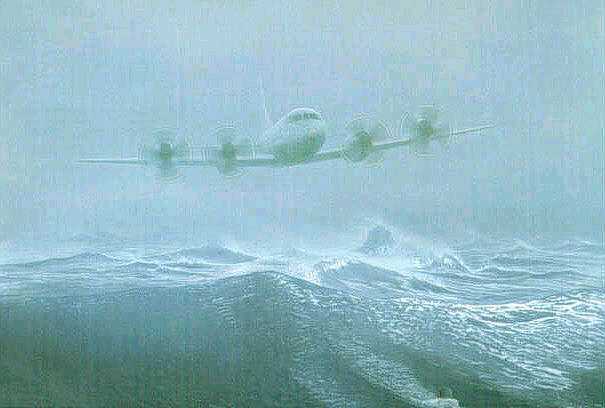
Among the most significant aspects of twentieth century military affairs has been how naval and land-based air power have transformed maritime operations. Today, much of the maritime arena is controlled, monitored, or exploited by aerospace systems. The capital ships of the modern era are the aircraft carrier and the missile-armed submarine, both weapons of three-dimensional warfare. The world's sea lanes are monitored by aircraft and helicopters flown from the decks of aircraft carriers and other vessels, and, especially, by long-range [land-based] maritime patrol aircraft operated by the world's navies and air forces. The primary weapon at sea is no longer the projectile hurled by a "big gun" ship, or the torpedo from a submarine; rather, it is the smart [anti-ship] missile, fired from aircraft, helicopters, ships, or submarines. As precision attack has transformed land warfare [EDITOR: BULLSHIT ALERT! PGMs have not "transformed" land warfare, author is wrong; in land warfare platforms do not undergird our presence so ALL types of warfare are still in use, even "low-tech" ones] and the worth of the large fielded army, so, too, has precision attack at sea transformed the nature of naval combat and the relative value of large standing fleets. [BS ALERT! Air Force apologist trying to cut the budget of the rival Navy and Army with a PGM-is-doomsday BS. To defeat ASMs we need MORE ships with aircraft and MORE land armies in tracked armored fighting vehicles not LESS that are easily targeted and destroyed ie; the stupid 11 large aircraft carriers we have now]
The nature of air warfare at sea has radically changed the capabilities and vulnerabilities of conventional naval forces. As the duel between the Monitor and Merrimac transformed naval warfare in the 19th century, and the submarine and the aircraft carrier in the early years of the 20th century, the appearance of the smart anti-shipping bomb in the midst of the Second World War and the precision anti-ship missile in the mid-1960s heralded a new era in naval warfare. In this new era, the large surface vessel is more vulnerable than at any previous time to precision attack by weapons launched from tens or even hundreds of miles away while, at the same time, new applications of aerospace technology for the maritime environment promise to enhance and strengthen traditional naval missions such as littoral warfare, amphibious operations, and maritime transport. [WTFO? if you cannot survive ASMs in the big blue water what in the hell makes you want to go into the restricted brown waters?]
The First Maritime Air War: Precursor to Future Combat
As with the world's more advanced armies, the leading navies of the western world were largely supportive (if not overwhelmingly enthusiastic) about aviation in the years prior to the First World War. Nevertheless, again echoing the experience of the armies, navies little anticipated the radical transformations of tactics and forces that would be forced upon them by the aeronautical revolution; indeed, all initially anticipated that the major--and perhaps only--value of aviation would be in the reconnaissance and observation role. Navies generally underestimated the significance of the submarine as well, considering it primarily a means of coastal defense warfare. Yet the advent of both the [long-range by fuel capacity or help from a carrier ship] airplane and the submarine ushered in the era of large-scale ship sinkings in naval history, for in earlier eras of wooden ship warfare (which dated to antiquity, and extended ultimately through Trafalgar), ships might be disabled, but only rarely sunk, and in the era of the big-gun metal vessels, mass encounters between such vessels (such as Manila Bay or Jutland), while dramatic and attention-getting, were relatively rare.
Unlike the armies, which generally saw their future in terms of heavier-than-air biplanes and monoplanes, the navies opted for the long range and endurance inherent in lighter-than-air dirigibles and small non-rigid "blimp" airships (by 1914, for example, the Zeppelin rigid airship was an intrinsic element of German naval war planning). Supporting these airship forces were small float-equipped seaplanes. With the exception of a few standouts, most of the latter evolved from existing landplane designs. By the war's outbreak, Britain and the United States had already experimented with launching small aircraft from ships, and the first trials were underway of specialized torpedo-carrying strike aircraft. The war rapidly accelerated these trends. By war's end, only a decade after the appearance of the military airplane, aircraft and airships had already been employed for maritime reconnaissance and patrol, and for direct attack upon surface vessels and submarines.
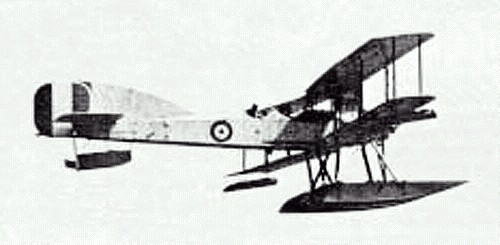
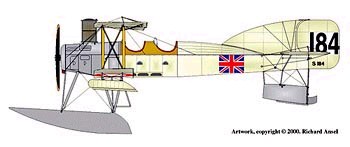
For example, in the Dardanelles campaign, British Short 184 float seaplanes "launched" from a crude seaplane tender, the Ben-my-Chree, torpedoed several Turkish vessels. German reconnaissance Zeppelins furnished tactical information to the High Seas Fleet during the Battle of Jutland and subsequent operations off the British east coast. In the East African campaign, British seaplanes undertook reconnaissance and gunfire spotting missions resulting in the loss of the German cruiser Königsberg. The notorious German commerce raider S.M.S. Wolf owed at least as much of its success to its airmen and spotter biplane (affectionately dubbed the Wolfchen) as it did to its deck crew. During anti-U-boat actions and convoy escort missions, land-based aircraft and blimps markedly reduced sinkings from U-boats by forcing them to submerge and, ultimately, driving them to seek safer operating areas. Indeed, only three merchant ships were sunk by U-boats when escorted by aircraft or airships. The Royal Navy made the first tentative use of aircraft carriers, crude though they may have been; in 1918, for example, six British Sopwith Camel fighter-bombers from the carrier H.M.S. Furious raided the German airship base at Tondern, destroying two Zeppelins in their sheds.
In all these ways and others as well, aircraft and airships contributed to the war at sea. While aviation's impact was far less than it would be in subsequent years, it nevertheless pointed to a future where the surface ship (and submarine as well) would be far less secure. Imperial Germany had even experimented with crude (if ambitious) command-guided anti-shipping missiles. It should not be surprising, then, that no less a personage than Admiral Lord Fisher, whose name was synonymous with the emergence of the dreadnought battleship, remarked after the Armistice that "the prodigious and daily development of aircraft" had "utterly changed" naval warfare.
The Emerging Technology of Maritime Air Warfare
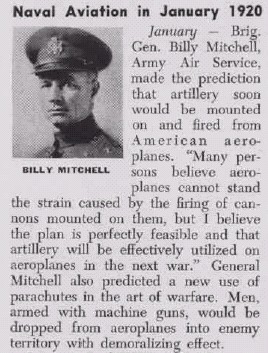
Significant developments during the inter-war years took the airplane from functioning as a mere participant in naval warfare to--together with the submarine--decisively determining the outcome of naval combat. First, the charismatic and controversial American air power prophet, Brigadier General William "Billy" Mitchell, demonstrated the vulnerability of large anchored capital ships to bombing attacks from land-based aircraft, most notably by his sinking of the captured German dreadnought Ostfriesland and the light cruiser Frankfurt. Though critics pointed out that the ships were at anchor and not firing back, the surprising success of these strikes sent a disquieting shiver through big-ship partisans. Fear of air attack was a powerful motivation for four notable naval developments in the leading naval nations after the Mitchell trials: armoring battleships and other surface warfare craft and equipping them with increasingly heavy anti-aircraft batteries; developing dual-purpose anti-aircraft and anti-ship gun systems; designing new classes of anti-aircraft cruisers to protect fleets by barrage anti-aircraft fire; and last, but certainly not least, the development of radar as a means of affording warning of air attack. [EDITOR: author forgot about seaplanes on surface ships to ward off air attacks]
Yet, despite such changes, in the minds of most interwar-year naval analysts, the future of naval combat still remained pretty much as it had in the past: nations threatened by a maritime power would have to rely upon their own fleets as their first line of defense, supported by coastal artillery controlled by the army. As in Nelson's day, the ultimate expression of naval war would continue to be the big gun slugfest between ships at sea. Naval and land-based maritime air forces could be expected to support fleet operations, but not dominate them. Interestingly, one nation that did seriously examine how the aviation revolution might affect its regional security (though it reached the wrong answer, to its peril) was Australia. Australian defense planners considered the security of Singapore as a vital underpinning of Australia's larger security interests. Between 1929 and 1933, the then-chief of air staff of the Royal Australian Air Force, Air Commodore Richard Williams, argued that the range and growing effectiveness of torpedo-carrying aircraft had supplanted the heavy cannon as the best defense against a seaborne invasion force. Unfortunately, his Army and Navy counterparts, the chiefs of naval staff and general staff, disagreed strongly, arguing that aircraft could not deter capital ships, particularly because they lacked continuous presence in the air. Security for Singapore remained rooted in large cannon looking out to sea, and a fleet in readiness in harbor. (The rest of the story is, of course, well-known; Japanese air power sank or otherwise dominated the fleet, and the guns remained pointed out to sea even as Japanese troops [WHO INVADED BY LAND FROM THE NORTH] seized control of the city. Not until Allied maritime air power had won the Battle of Coral Sea was the threat to Australia's sea lanes overcome).
The aircraft carrier emerged as a major element of the world's leading navies in the inter-war period. By the late 1930's, the carrier had developed "generic" features typified by a flight deck surmounting a hangar deck, large elevators to transport aircraft from the hangar deck to the flight deck, an offset bridge "island" and stack system (varying from the gargantuan as exemplified by the USS Lexington and Saratoga, to the minuscule as found on Japanese carriers such as the Akagi and Kaga), and a landing area crossed by arresting landing wires [for tail-hook equipped aircraft to snag them].
Likewise, navies that operated aircraft carriers operated generally similar types of aircraft from them: fighters to protect the fleet, dive bombers to attack enemy ships as precisely as possible, and torpedo planes to attack from just over the surface of the water. These aircraft tended to have features tailored for carrier operations, such as long-stroke rugged landing gear struts and wheels, an arresting hook "stinger" lowered during final approach, and folding wings for reduced storage space requirements aboard ship. With space on ships at a premium, all were single-engine designs, even those with over two crewmen. As a general rule, the increased weight (and multiple crew requirements) of naval aircraft, coupled with their single-engine layout, gave them inferior performance when compared to their lighter land-based contemporaries. But a notable exception to this was the Japanese Mitsubishi A-6M2 Type 0 (the infamous "Zero," accorded the Allied recognition name Zeke) which was, at the time of its appearance in 1940, the finest fighter airplane in service use [EDITOR: at cost of armor protection]. Besides aircraft carriers, cruisers and battleships (and some destroyers) carried light observation floatplanes for gunnery spotting, anti-submarine patrol, and reconnaissance.
Air power at sea involved far more than aircraft carriers, however. By the end of the First World War, long-range land-based aircraft and seaplanes had clearly proven their potential if not always their value. In 1919, two such aircraft crossed the Atlantic: the American Curtiss NC-4 seaplane, and a British Vickers Vimy bomber; so, too, did a British rigid dirigible airship, the R.34. The technological mastery of the long-range all-metal (or nearly all-metal) multi-engine monoplane for both military and commercial purposes, which characterized the so-called "Golden Age" of aviation in the 1920's and 1930's, set the stage for the emergence of aircraft that would profoundly influence war at sea.
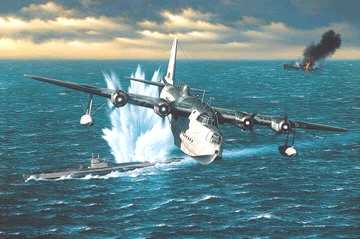
By the late-1930's, for example, the American, British, and Japanese already had in service the three great long-range seaplanes that they would use for wartime maritime patrol: the Consolidated-Vultee PBY Catalina, the Short Sunderland, and the Kawanishi H-6K (Allied name Mavis). All were multi-engine designs that drew from the technology base established by long-range commercial seaplanes. They featured exceptional range; the Catalina and Sunderland could reach over 2,500 miles, and the Mavis over 4,200 miles. Finally, if needed, they could attack submarines and shipping with bombs and torpedoes. But their primary role was that of reconnaissance--to literally act as the "eyes of a fleet" and thus to extend a battle fleet commander's awareness and control.
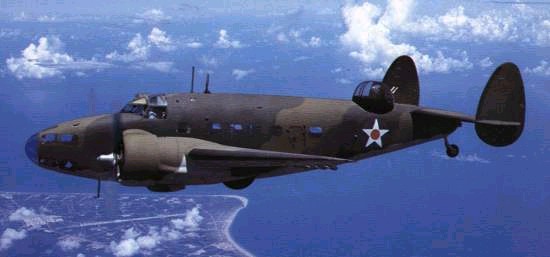
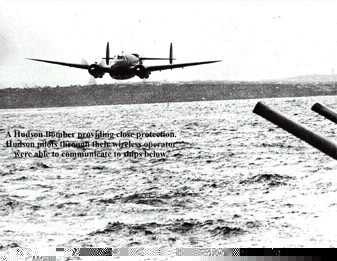
Commercial transport aircraft soon to be modified as maritime patrol aircraft were likewise in service--notably the Lockheed Lodestar (soon to reappear in military guise as the Hudson), and the Focke-Wulf FW-200 Kurier (the soon-to-be Condor). So, too, were conventional long-range land-based bombers such as the British Armstrong-Whitworth Whitley and the Vickers Wellington, the German Heinkel He-111 and Junkers Ju-88, the Japanese Mitsubishi G-3M (Nell) and G4M (Betty), and the American Boeing B-17 Flying Fortress and Consolidated-Vultee B-24 Liberator. Each of these latter types would be modified for maritime patrol, anti-submarine, and attack operations, with greater or lesser success. Already, in the Spanish Civil War, land-based aircraft had attacked and sunk ships underway; while this was hardly a major lesson of that tortuous conflict, it was, nevertheless, a reminder that the earlier fears triggered by Mitchell's trials had not, in fact, been without foundation. Though not yet at war, the U.S. Army Air Forces had demonstrated its own ability to seek out and find ships well out to sea, overflying the Italian liner Rex with a formation of three Boeing B-17 bombers while it was hundreds of miles at sea. It took little imagination for the observers to realize that a plane overflying a ship today could just as easily attack it under different political circumstances tomorrow.
Maritime Air Power and the Outbreak of World War II
When war erupted in 1939, the clashing powers clearly had visions of using air power at sea both for defensive and offensive purposes. Having the machines and technology for such warfare, however, was not the same as having operational doctrines to properly use such power. Thus, there was--as with other aspects of the air war--a lengthy period of learning what worked and what didn't. The three major European combatants (prior to American entry in the war) all had remarkably similar battles between and within their services over the value and role of air power, so much so, that at times one could be forgiven for believing their histories to be largely interchangeable. As is often the case, services of one nation were often far more critical of their own performance than their enemies', damning their own performance even as they overestimated that of their opponents. For example, the Nazi leadership bitterly criticized the Luftwaffe for a perceived general unwillingness to support the Kriegsmarine, as well as the German Navy's own lack of emphasis upon using aircraft in conjunction with surface and submarine warfare forces, while, at the same time, German naval and commercial shipping suffered the depredations of the Royal Air Force's Coastal Command. [EDITOR: the German's inability to prevent their supply ships from being sunk was THE main reason for Rommel's defeat in North Africa] Yet, at the same time, British naval authorities saw an opponent that seemingly artfully used long-range landplanes and seaplanes to furnish reconnaissance information, direct U-boat attacks, and directly attack [their] merchant and naval shipping, with potentially devastating effects upon the Battle of the Atlantic and (in particular) the Russian convoys, even as the Royal Navy and the Royal Air Force bickered over air support for naval operations and whether Coastal Command should be an Air Force or a Navy asset! In truth, then, the partnerships of both the Luftwaffe-Kriegsmarine and the Royal Air Force-Royal Navy were at once more productive than each believed of itself, while less effective than their opponents believed.
British Coastal Command 1939-1945
www.youtube.com/watch?v=SipcsvXcnbU&feature=related
www.youtube.com/watch?v=N0fj6dlj3CU
www.youtube.com/watch?v=OTHdb5DEM3g
Both viewpoints likewise reflect the general tendency seen through twentieth century air-land warfare: namely, that surface warfare proponents (in this case navies) fear an enemy's air forces far more than they respect their own. [EDITOR: WRONG. Its the opposite in the U.S. Navy] Again as in air-land warfare, the freedom of maneuver and execution that they envy in an enemy's air operations are qualities they seek to restrict in their own air forces, out of a misplaced fear that the air forces abandon them to the depredations of an enemy air force if they are granted an equivalent freedom of maneuver and freedom of execution. {EDITOR: author is pontificating from his air force triumphalist world-view]
Before Pearl Harbor and the opening of the great Pacific war, maritime air operations profoundly influenced both European and Mediterranean sea-land warfare, foreshadowing the far more extensive naval air war that would occur subsequently halfway around the world. Indeed, as John Keegan has written, "Hostile aircraft terrified the seamen of the Atlantic battle, those of the convoys as much as the U-boat crews who were their enemy." A far from complete list of naval actions having subsequent influence on other events would have to include:
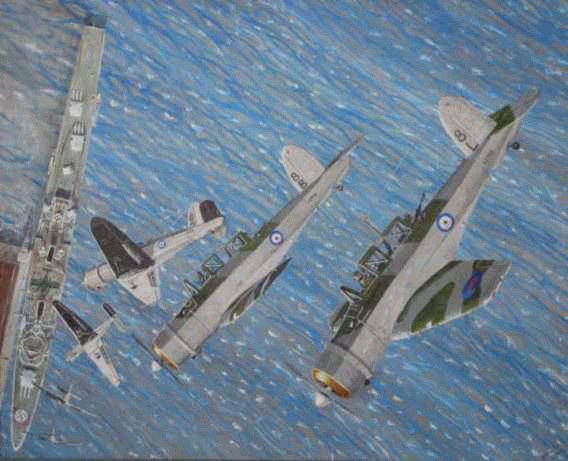
Superb painting by John Dell
--The sinking of the German cruiser Königsberg by Fleet Air Arm dive bombers;
--Germany's use of medium and dive bombers to thwart British [Navy] efforts to stem the German assault in Norway;
--The Royal Air Force's use of land-based bombers to disrupt German naval forces assembling for Operation Sea Lion, the projected invasion of Great Britain;
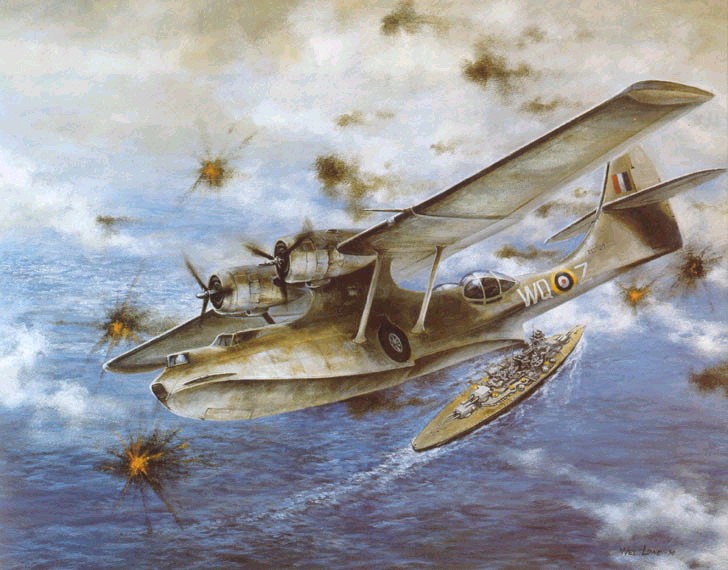
--Maritime reconnaissance that both detected the breakout of the Bismarck and subsequently relocated it after the tragic sinking of HMS Hood permitting an air strike from the carrier HMS Ark Royal that crippled its steering and rendered it vulnerable to surface attack;
--The savaging of the Royal Navy around Crete by Luftwaffe air attacks;
--The continuous sinkings of German coastal traffic off Scandinavia by RAF Coastal Command Beaufighters;
--The terrible toll air attack took of convoys, forcing development of the escort carrier;
--The destruction of German and Italian convoys supplying Rommel's forces in Africa;
--The imaginative attack upon the Italian battle fleet in harbor at Taranto;
--Anti-submarine patrols around the British isles, the Bay of Biscay, and off the American coast by long-range landplanes and seaplanes; -- Convoy protection and U-boat hunter-killer operations by escort carriers working with aircraft and destroyers; coastal operations by strike aircraft and mining aircraft against German harbors, supply routes, and the Kiel canal;
--Allied use of air-dropped anti-submarine homing torpedoes that executed a circular search pattern while using an acoustic seeker head to detect and then home on the propeller cavitation of U-boats, resulting in the sinking or damaging of 71 submarines;
--Attacks against Allied shipping and military vessels by German medium bombers launching first-generation air-to-surface command-guided precision-guided missiles and glide bombs, which, among other results, sank the Italian battleship Roma and damaged the British battleship HMS Warspite and the American cruiser USS Savannah;
--Finally, the bombing campaign (by carrier-based and land-based aircraft) against the battleship Tirpitz that eventually resulted in its capsizing at anchor at Trömso, Norway.
These are but a few of the more notable ways in which air power played in the sea war in Europe and the Mediterranean.
The key to many of these uses was the marriage of good signals intelligence with sea and air operations. Early in the war--through the Norwegian campaign, in fact--Germany had been reading up to 30% of British message traffic before the British wisely changed their cyphers. But it was the Allied success with ULTRA that constitutes the pinnacle of wartime intelligence exploitation. ULTRA's significance, generally appreciated only since coming to light in the 1970's, can only rarely be overstated. It played a profound role in many of the actions and incidents mentioned above, clearly offsetting occasional advantages that the Germans and Italians possessed in strength or initiative. Most notably ULTRA doomed the U-boats and commerce raiders, and, in the Mediterranean, set the stage for the destruction of Rommel's convoys. This partnership of intelligence and air warfare--and intelligence and submarine warfare, for that matter--proved decisive. In the Pacific, it would be no less decisive in the war against Japan. {EDITOR: what if we don't have an ULTRA capability to read enemy plans to cheat with when we fight?]
The Maturation of Maritime Air Attack
Overall, European and Mediterranean operations confirmed the emergence of three-dimensional attack--attack from above and below the ocean's surface--as the greatest threat to ships at sea. The airplane and the submarine in concert produced a fearsome synergy of effects: the airplane with its speed and quick reach, and the submarine by its stealthiness. Off Norway, German submarines and aircraft nearly triumphed over Allied attempts to resupply the Soviet Union by sea. Convoy PQ-17, for example, lost thirteen ships (of 35 that began the journey) sunk from air attack (the Luftwaffe lost but six aircraft out of 202 in exchange), and a further ten sunk by U-boats. Thus, for a loss of 3% of its force, the Luftwaffe claimed fully 37% of PQ-17, with U-boats claiming another 29% of the convoy for no losses of their own. The sunken ships carried, among other cargo, 430 tanks, 210 aircraft, and 3,350 vehicles. In the Mediterranean, British submarines and aircraft destroyed effective commerce between Italy and North Africa, though here, the constrained waters and often clear visibility into the ocean limited somewhat the effectiveness of submarine operations.
For those raised in an era where the surface ship had been dominant, the newly revealed power of aircraft as a means of attacking enemy shipping was nothing short of remarkable. In the Mediterranean theater, Italy lost 1,324 ships (totaling 2,106,521 tons) to Allied action. Of these, only 59 (4%) were lost to surface ships. The vast majority were lost to submarines and aircraft. Submarines sunk 324 (24%), but air attack destroyed 489, 37% of those lost. Accordingly, one Italian naval historian has written:
"In the final analysis--and such an affirmation does not seem to be an overstatement--the really decisive struggle in the Mediterranean War was fought out between the Italian Navy and the Anglo-American air forces. No matter how bitter the naval war itself was, the Italian naval forces would still have been able to carry it on properly and for a long time, if the Navy had not been both directly and indirectly overcome by the overwhelming enemy power in the air." Indeed, as Admiral Friedrich Ruge, the former German Senior Naval Officer in Italy, recollected:
"The mere presence of enemy aircraft was itself sufficient to scare the Italian convoy traffic into making wide diversions from the direct route. This caused them and their escorts to consume more fuel and to be exposed for longer periods to attacks by submarines and surface craft. The latter received such accurate reports from their Malta-based air reconnaissance about the convoys' positions, courses, and speeds that they had no difficulty in locating them. . . Time and again the island's striking forces caused shortages in fuel, ammunition, weapons, and equipment at a critical stage of the Axis operations in Africa."
Air attack worked both ways; Axis air attacks against shipping were also disturbingly productive. Despite training, logistical, organizational, and doctrinal problems, and despite not having sufficient numbers to adequately pursue a naval air war, the Luftwaffe scored notable successes forcing Allied countermeasures. In March, April, and May 1941, for example, Luftwaffe crews sank 179 ships totaling 545,000 tons. The shock of air attack at least matched the lurking menace of the submarine, and far exceeded that of surface threats.
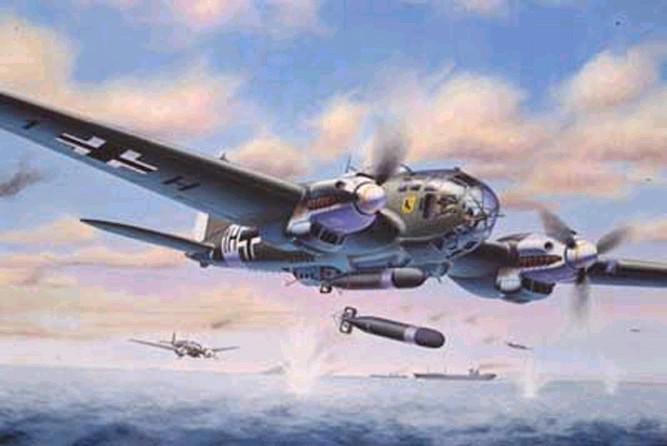
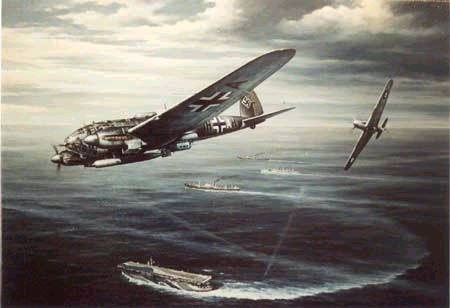
For example, in one notable attack on Convoy PQ-18 northwest of Bear Island, fifty-five German Heinkel He-111 bombers, each armed with two torpedoes, executed a massive line-abreast attack at low altitude, simultaneously dropping all their "torps" and sinking no less than eight freighters virtually immediately. Unarmed ships were most vulnerable, but even heavily armed warships were not immune to destruction, whether underway or in harbor.
The terribly costly evacuation of British forces from Crete in May 1941 under punishing German air attacks [EDITOR: dude! you forgot to mention THE GERMAN PARATROOPS LANDING ON CRETE AND PUSHING THE COMMONWEALTH TROOPS OFF THE ISLAND. Can you stop the airpower egotism or is it compulsive despite the facts?] demonstrated that--even with up-to-date intelligence as to an enemy's intentions--a naval force lacking adequate air cover could not expect to survive without (at least) extensive losses. As Lord Tedder of the RAF recollected in his landmark Lees Knowles lectures at Cambridge after the war:
"The price in surface ships was three cruisers and six destroyers sunk; one battleship, one aircraft carrier, three cruisers and one destroyer seriously damaged; and one battleship, four cruisers and six destroyers in need of extensive repairs. Against these material losses there was on the credit side a record of wonderful gallantry and determination. Once again, magnificent, but not war."
It should be noted that one of the cruisers sunk was, in fact, a special "anti-aircraft cruiser" extensively armed with anti-aircraft guns and light cannon and thus, foolishly, ordered to steam "in harm's way" sans friendly air cover.
The Leverage of Land-based Maritime Patrol Aircraft
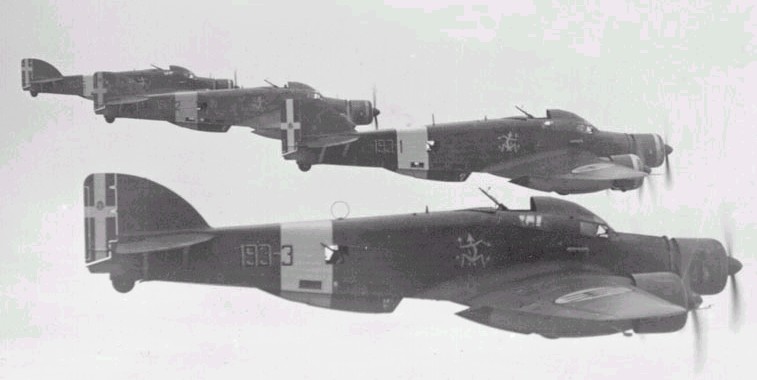
Because maritime operations did not typically involve the risk of encountering enemy high-performance fighters (except directly along an enemy coastline or--for the Germans--after the emergence of the Anglo-American escort carrier) that deep-penetration missions into an enemy's heartland did, single or multi-engine aircraft of modest performance could often make contributions all out of proportion to their true abilities. [EDITOR: why every battleship/cruiser/destroyer should have a seaplane fighter to ward off maritime patrol bombers!]
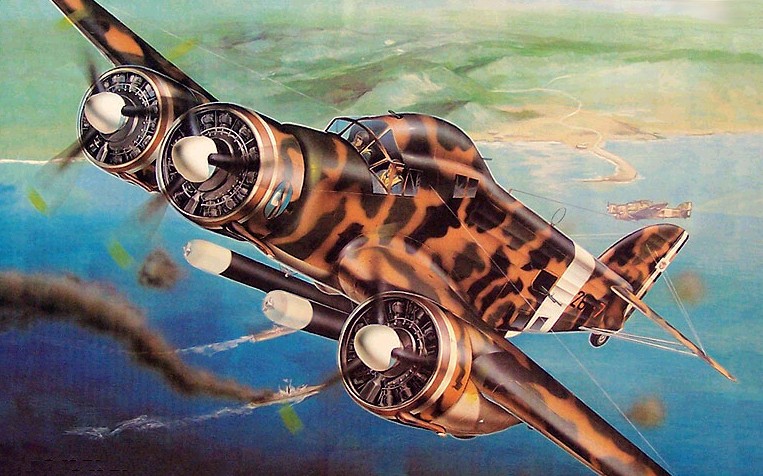
The Savoia-Marchetti S.M.79-II Sparviero ("Sparrow") torpedo bomber, an Italian tri-motor that enjoyed surprising success against Allied shipping in the Mediterranean, exemplified this. Armed with two torpedoes, it was largely responsible for the 63 x Royal Navy ships lost to Italian air attack in the Mediterranean; indeed, in the words of one British aeronautical historian, "the exploits of Italy's torpedo-bombing squadrons equipped with this type, the Aerosiluranti, were almost legendary." The German Junkers Ju-87 Stuka dive bomber and the Heinkel He-111 torpedo bomber, and the British Bristol Beaufort and Vickers Wellington constitute other examples of less-than-fully successful airplanes that nevertheless exerted significant influence within the maritime arena, particularly against merchant convoys.
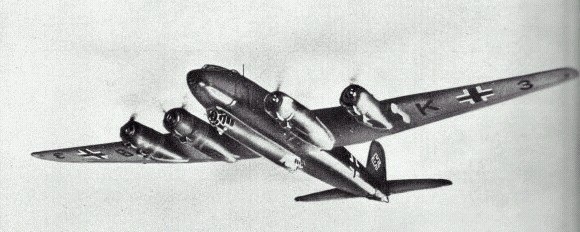
The Focke-Wulf FW-200 Condor is perhaps the best case. Focke-Wulf first explored a maritime reconnaissance-bomber variant of this somewhat mediocre (if reasonably attractive) four-engine airliner at the request of the Japanese government; the outbreak of the war prevented further work on the FW-200 for Japan, but accelerated German interest in the plane. Though it had numerous deficiencies (including serious structural weaknesses) that hampered its effectiveness, in the absence of Allied fighters, the FW-200 preyed upon Allied shipping, drawing the personal attention of no less than British Prime Minister Winston S. Churchill himself, who dubbed it the "Scourge of the Atlantic."
Typically, Condors flew long missions between France and Norway; a flight would take off from Bordeaux-Merignac on the French coast, loop far out into the Atlantic until well west of Ireland, and then turn north and east before landing at Trondheim-Vaernes in Norway; a fresh crew would fly a return the next day. Though a Luftwaffe asset, the Condors functioned under the operational control of the U-boat command, locating and radioing the position of convoys to lurking submarines, and then undertaking their own attacks as well. (Occasionally, in a turnabout, U-boats would locate a convoy, report its position, and then shadow it for subsequent air and sub attacks). In one six-month period, the Condors of one maritime patrol bomber wing, Kampfgeschwader 40, assisted by some smaller He-111's, destroyed 85 ships totaling 363,000 tons. As a rule, Condors were highly successful "ship-busters;" in one attack against a 16-ship convoy off England in February 1941, five FW-200's singled out five merchant ships and sank all of them, thus sending fully 31% of the entire convoy to the bottom in no more than a few minutes. By cooperating (however imperfectly) with surface craft and U-boats, they added an important force-enhancing factor in Nazi sea control operations.
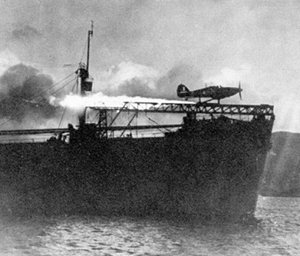
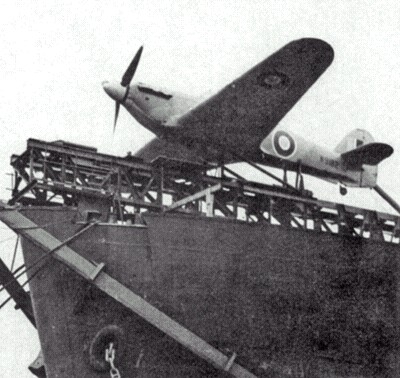
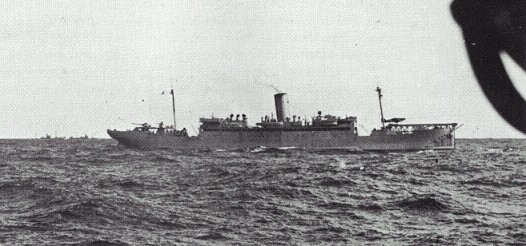
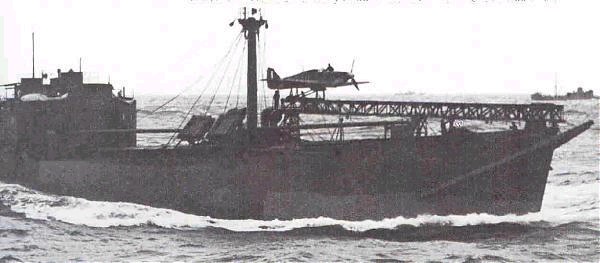
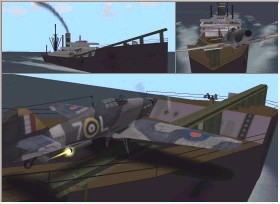
Nothing so illustrates the desperate mind-set of planners confronting the threat posed by the Condor than the development of catapult-equipped merchant ships carrying a single war-weary Hawker Hurricane fighter, an interim (and near-suicidal) solution pending the conversion of ships into small escort carriers. Flown by remarkably brave pilots, these planes were husbanded for the moment a Condor appeared near a convoy. A "Hurricat" would then launch, intercept the "bandit" and, with luck and skill, shoot it down. With no deck to return to, the fighter pilot had to bail out or ditch in the foreboding and frigid Atlantic, to be (hopefully) rescued by a passing ship!
Why didn't We Supply CAM Ships with N-3PB Seaplanes?
Once WW2 began, heavy supply ship losses to German U-Boats forces the RN to re-learn WW1 lessons of moving supply ships by ASW destroyer and long-range maritime patrol aircraft guarded convoys and desperately place "Hurricat" fighters that cannot land on water to be recovered on merchant ships to ward off FW-200 Condor patrol/reconnaissance bombers. The Americans provide blimps and mass-produce small escort aircraft carriers to get AAW/ASW protection for convoys to get through German Condors and U-boats.
Why did we buy the 175 mph, 2 x 7.62mm medium machine gun, 900 mile range Kingfisher in 1937 and not the 1400 mile range. faster, better armed N-3PB? Open-sea landing single floats were possible. Wings could have been made to fold. Why were N-3PBs not supplied to British CAM ships to ward off Fw-200 patrol bombers since they could land and be reused unlike Hurricats that ditched? N-3PBs could also do ASW! Or was this yet another case of the aircraft carrier "mafia" trying to sabotage the seaplane community and keep it in its "place"?
In short, the Condor--like the first fighters of the Great War, or the cruise missile of later times--was the perfect example of a low-cost threat forcing a high-cost and complicated defense [CVE, escort aircraft carriers made from supply ships]. The success of the Condor directly drove both the rapid development of the small escort carrier, and the purchase, by the Royal Navy, of far more capable shipboard fighter aircraft, notably the American Grumman Martlet (the famed Wildcat, in U.S. Navy service), the later Grumman Hellcat, and the powerful Vought Corsair. Once carrier-based fighters appeared, the Condor, quoting Churchill, "gradually became the hunted rather than the hunter" after mid-February 1944, the Condor threat passed into history. [EDITOR: so if Hurricats worked so well against Condors it could have worked even better for the Japanese, the Brits and our own supply ships! using seaplane fighters]
Maritime Air Power's Record against Nazi Germany and Fascist Italy
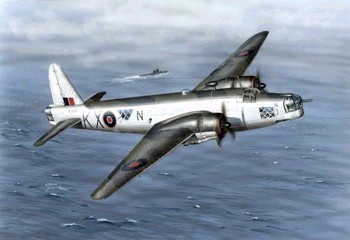
The statistical record of Allied air operations against Nazi Germany and Fascist Italy bears out the significance of Allied air power at sea. A post-war investigation of sinkings of German coastal traffic from the Bay of Biscay to the North Cape over the time period September 1939-January 1945 concluded that of 920 sinkings, submarines and surface vessels were responsible for 22.7% of this total, while direct air attack and mining claimed the remaining 77.3%. The official history of the Royal Navy attributes 60 sinkings of 149 Nazi warships of minelayer size or larger to direct air attack, a total of 40%; this does not include those that were destroyed by air-dropped mines, nor does it include submarines.
As the curators of one major international exhibition of twentieth-century naval power concluded, "During World War II, aircraft became the submarine's deadliest foe." Of the 785 submarines Germany lost in the Second World War, 368 were sunk exclusively by air attack--fully 47%. A further 48 x U-boats (6%) fell to combined air and surface ship attack. Thus 416 U-boats--53% of those sunk--fell before air or combined air-and-sea attack. Of these, 323--41% of those sunk--fell before long-range landplanes. The landplane total rose dramatically through the war; of the 140 x U-boats destroyed by air attack in the last year of the war, land-based aircraft were responsible for 132 destructions--over 94%, both a testament of the significance of the long-range landplane in Second World War maritime operations, and an indication of its importance in the present day as well. [EDITOR: which is way the large aircraft carrier USN is letting our ASW maritime patrol plane fleet die off] The appearance of long-range maritime patrol aircraft over the mid-Atlantic gap doomed the U-boat campaign, and was recognized as such by the German naval leadership, which wrote, in August 1942, that:
"This development must have the consequences of the loss of a large number of U-boats and a reduction in our successes. There are now no prospects for the successful conclusion of the U-boat war."
Beyond direct destruction of U-boats, one of air power's most significant attributes was simply in forcing U-boats to remain submerged, hindering their mobility and time at sea. [EDITOR: this is not a handicap with today's submarines but embraced as a desirable place to be]
The record of the Royal Air Force in Northern European and Atlantic maritime operations is noteworthy. A total of 1,475 enemy surface vessels (representing 1,654,670 tons of shipping) sank at sea or were destroyed in port by RAF attack, constituting 51% of the total enemy losses of 2,885 ships (totaling 4,693,836 tons) destroyed by Allied sea and air action, captured, or scuttled from 1939 through 1945. A total of 437 of these ships (186 of which were warships) sank from direct air attack at sea, while 279 others (of which 152 were warships) were bombed and destroyed in port. Mines laid by Coastal Command and Bomber Command claimed an additional 759 ships, of which 215 were warships. These 759 represented fully 51% of all ships lost to RAF air attack. Indeed, mining was over five times more productive than other forms of air attack; for approximately every 26 mine-dropping sorties flown, the RAF could claim an enemy ship sunk, while it took approximately 148 sorties to generate a sinking by direct air attack. [EDITOR: anti-naval operations directed at a VEHICLE exposed on the water providing clear contrast are more successful than trying to strategic bomb civilian populations embedded into the earth into submission...yeeehaa! let's go sink an enemy ship!]
In no small measure, the mining campaign's success stemmed from strong and constant support by the chief of RAF Bomber Command, Air Chief Marshal Arthur T. "Bomber" Harris. In fact, before the war, as an Air Ministry staff officer, he had successfully pressed for the production of air-dropped magnetic sea mines. Thus, when war broke out, the RAF already possessed a leader and a weapon suitable for sea denial operations. As early as the dark days of the Norwegian campaign, mine sorties by Handley Page Hampden bombers resulted in no less than twelve sinkings. In 1940, Bomber Command and Coastal Command combined laid an average of only 100 mines per month; but even so, this small effort generated the loss of 82 German ships sunk, and another 55 damaged, by the end of the year.
So fearful were German shipping authorities of the mining campaign that they immediately clamored for strengthened German nightfighter forces operating along threatened coasts. Consequently, mining loss rates were much higher than losses on direct attacks though, to its dismay, the Luftwaffe found it could only harass and not prevent British mining sorties. Overall, the RAF lost one mining aircraft for every 38 sorties, while the service lost one strike aircraft for every 56 direct-attack sorties.
In conjunction with direct bombing and torpedo attacks, RAF mining operations seriously constrained the movement of German capital ships, minimizing their value to the Reich. Indeed, cognizant of this, the Royal Navy made increasingly heavy demands upon Bomber Command throughout the conflict up through the sinking of the Tirpitz for raids against German harbor, shipbuilding, and repair facilities, as well as on specific ships themselves. As a result, Germany's surface naval forces were effectively held in-check throughout the war by air action. In one notable case, the threat posed by the RAF to the battlecruisers Scharnhorst and Gneisenau, and the heavy cruiser Prinz Eugen, then bottled up by air attack in Brest, France, forced the Nazi naval leadership to order the three ships on a risky dash through the English Channel to safety in German ports.
Even then, both the Scharnhorst and Gneisenau struck magnetic mines dropped previously by Bomber Command that forced repairs, fatally in the case of Gneisenau. Though this escape constituted a public relations coup for the Nazis, all three ships subsequently had little influence on the war. Scharnhorst lay in port for a year before returning to Norway in 1943. Aside from a brief sortie with Tirpitz to bombard Spitzbergen, it remained primarily fjord-bound. Then, at the end of the year, the German naval command ordered it to attack a Russian convoy; thanks to intelligence warning, it was trapped off North Cape and sunk by British surface forces. As for Gneisenau, laid-up in drydock in Kiel undergoing repairs for the mind damage sustained on its escape, three subsequent British air raids broke her back and destroyed her upperworks. A shattered hulk, Gneisenau ignominiously ended her days as a blockship after being towed to Gdynia. Prinz Eugen impotently finished its days in the Baltic before serving as an atomic bomb target in the Bikini atoll postwar tests.
Mining made other important contributions that further fragmented the Nazi war effort. Much as the bomber offensive against Germany forced the production of defensive weapons (such as interceptors and anti-aircraft artillery) at the expense of offensive weapons (such as bombers, tanks, and submarines), the mining campaign forced the German Navy to use up to 40% of its personnel on mine clearance operations. Likewise, it forced planners to divert ever-larger portions of the German maritime effort to building replacement ships and repairing others damaged by mine attack.
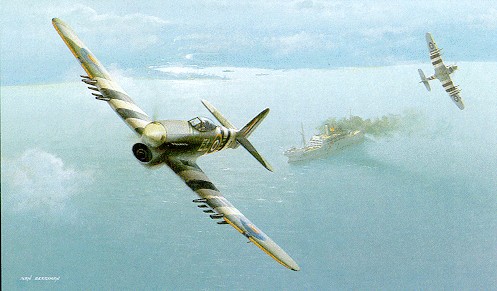
Direct air attacks and mining together sapped the German maritime war effort, delayed and disrupted logistical flow, and dis-heartened the German military leadership. For example, between 1943 and 1944, transit times to German ports from Trondheim, Norway, more than doubled, from 14 to 31 days. Northerly voyages in 1944 took an additional 24 days on average over 1943 figures. In the Baltic, minelaying so discouraged the German naval liaison officer assigned to the Luftwaffe's operations branch that he wrote to his naval superiors in September 1944:
"Without training in the Baltic, and safe escort through coastal waters and the routes to and from operations in mid-ocean, there can be no U-boat war. Without seaborne supplies, it is impossible to hold Norway. Without freedom of movement in the Baltic, we cannot use transport in German coastal waters. . . . But already we no longer command the sea routes within our own sphere of influence, as is shown by the day and week long blocking of shipping routes in the Baltic approaches."
The experience of other countries makes for interesting comparisons. Russian airmen sank at sea or destroyed in port 159 of 328 German warships or merchant vessels sunk, destroyed, or captured by Soviet forces in the Second World War. This represented over 48% of the Soviet total; mines claimed an additional 25%, submarines 14%, and "coastal" [surface, but not including shore artillery-ed.] forces but 5%. (The remaining 8% came from miscellaneous causes such as shore artillery, scuttling, capture, or unknown events).
Overall, German (and Japanese) air operations were far less productive than Allied ones, once those nations were forced on the defensive. Throughout the Second World War (and in all theaters, including the Pacific), German and Japanese military action resulted in the sinking of 5,150 Allied merchant ships totaling 21,570,720 tons. Of these, 820 merchant ships, totaling 2,889,883 tons, sank under air attack, representing nearly 16% of all Allied merchant vessel losses. (Of the rest, German and Japanese submarines claimed nearly 55%, surface attackers nearly 7%, mines over 10%, and unknown or other causes over 12%).
What does this imply? Why were Axis aerial attackers so less effective overall than Allied ones?
In part, it reflects the rapid evolution of the war, in that German and Japanese air operations, which were so effective at the war's outset, were overtaken after 1942 by Allied counters that forced these countries into a defensive war in which their previous strong maritime air presence withered, leaving only the submarine as a significant means to prosecute their war. The Russian-bound convoy experience of 1941-l945 illustrates this. During these convoys, 100 Allied ships were sunk. Of these, 38 were destroyed by air attack, and 42 fell to U-boats, representing, respectively 38% and 42% of the total. But 1942 was the peak year of German convoy depredations off Norway; in that year, 37 of the 38 air losses occurred. After that time, only 1 other ship sank under German air attack.
The Pacific Theater: Maritime Air Warfare on a Global Scale
To a degree far greater than even the war in Europe and the Mediterranean, the Pacific theater was a theater characterized by air power. More specifically, it was a war characterized by the projection of three-dimensional power--the power of the submarine and the power of the airplane against the Japanese navy and Japanese shipping. As the United States Strategic Bombing Survey concluded, "The war against shipping was perhaps the most decisive single factor in the collapse of the Japanese economy and the logistic support of Japanese military and naval power." Both the submarine and the airplane thus played dominant roles in the destruction of Japan's imperial ambitions; as elsewhere, the operations of submarines and airplanes exhibited strong synergistic effects and benefits. So dominant had air power become that one American naval planner plaintively wrote in the midst of the war "The danger is obvious of our amphibious campaign being turned into one that is auxiliary support to permit the AAF [the United States Army Air Forces--ed.] to get into a position to win the war." [EDITOR: boo-hoo you naval narcissist]
That air power came to dominate the Pacific theater is no longer as controversial a view as it once might have been; one recent essayist noted that:
"By the spring of 1945, American army and naval aviators had demolished Japan's civilian and military industries, sunk most of the Japanese fleet, and established a virtual blockade of the Japanese islands (with the aid of American submarines). Ground and purely naval forces had served mainly to seize and hold forward bases for the projection of air power."
Early Experiences in Pacific Combat
The Pacific conflict is commonly thought to have begun with the attack upon Pearl Harbor on December 7, 1941. In fact, of course, Asia had been in an on-and-off war with Japan since 1931 and, particularly, since 1937. In operations against China, Japanese airmen had flown from carriers operating off the China coast in much the same fashion that American and Commonwealth forces operated against North Korea, or in the way in which Americans fought against North Vietnam and, more recently, in the Mediterranean against Libya and in the Gulf against Iran and Iraq. Here the carrier was not a sinker of fleets but, rather, a mobile airfield operating in relatively close proximity to hostile shores. Its time as a sacker of fleets, however, was about to come, beginning on December 7, 1941 at Pearl Harbor.
There is great irony in the Pearl Harbor attack, for it represented at once both the apogee of Japanese naval aviation capabilities (no less than six carriers struck in well-planned simultaneous attacks) and the perigee of Japanese strategic thought. The attack was inspired in great measure by the British raid on Taranto, and directed at the perceived naval "center of gravity" (the American battle fleet, which was put out of action if not totally destroyed), but the real "center" were the American aircraft carriers that were providentially at sea. [EDITOR! BULLSHIT!!!! the American center of gravity was its GROUND AND AIR FORCES MARCHING UP FROM NEW GUINEA! And before then her SUBMARINES] In short, the planners who planned the Pearl Harbor attack thus targeted an outdated [EDITOR: more BS] weapon system (the battleship) using the normative naval weapon system of the future (the carrier-based airplane) while, at the same time, deliberately ignoring the grave threat posed to their own futures by the instrument of their own victory (the aircraft carrier). [EDITOR: WRONG! its the submarine, stupid!]
As shocking as Pearl Harbor had been, worse followed, with the sinking of large numbers of Allied vessels--but most notably HMS Prince of Wales, Repulse, and Hermes--by air attack at sea. The former two--heavily armed battleships, one new and one old--fell before land-based twin-engine torpedo bombers, mixed formations of Japanese Nells and Betties operating from Indochinese bases. These two ships had intemperately sortied from Singapore to attack Japanese invasion forces then coming ashore in northern Malaya. Astonishingly, continuing a pattern displayed earlier in this misguided mission of failing to inform friendly air forces of their intentions, even while under attack, the force commander, Admiral Sir Tom Phillips, did not request air support. Lost with them were 840 crewmen, including Phillips who, in tragic irony, had once confided to a junior officer that the man should not join Britain's Fleet Air Arm because aviation was "poppycock" and he would "ruin his career." [EDITOR: feel good aviator narcissist?]
So, within days, Japanese airmen had emulated the success of their European contemporaries, though on a much grander scale. They had amply if tragically demonstrated the woeful vulnerability of unprotected ships both in harbor and at sea to both carrier-based and land-based air attackers using bombs and torpedoes. Within months, these lessons would be revisited manyfold upon the Japanese themselves with a remorselessness that would characterize the remainder of the Pacific War. First, highlighting the aerial holocaust that would engulf Japan within three years, came the Doolittle raid in April 1942: a surprisingly effective joint operation whereby sixteen U.S. Army Air Forces B-25's embarked on the carrier USS Hornet and then raided Tokyo and other Japanese targets on a one-way mission to China. Second, in May, was the Battle of Coral Sea, the first naval engagement in history in which the participants dueled by air attack alone. Third, in June, was the dramatic Battle of Midway, which shattered Japanese naval aviation, resulting in the sinking of four of the six Japanese carriers that had raided Pearl Harbor as well as a cruiser, and the loss of an American carrier and a destroyer. It would be over two years before the Japanese Navy would again openly contest the U.S. Navy for control of the seas, and when it did so, American fighter pilots would utterly destroy the painstakingly rebuilt naval aviation forces Japan had husbanded for the attack in an action known to history as the "Marianas Turkey Shoot."
With the conclusion of major fleet actions by mid-summer 1942, not to resume until the Battle of the Philippine Sea, the naval war in the Pacific settled into a series of actions accompanying the tenacious struggle to liberate islands and territories that Japan had seized, or which it had acquired after the First World War. The island campaign began in earnest with the opening of the Guadalcanal operation in August 1942, which triggered a wider struggle for the Solomons that would last into 1944. Here, imaginative joint and combined control arrangements developed in the face of intensive and bitter Japanese attacks set a pattern for subsequent Pacific operations. Here, too, a generalized pattern emerged of land-based aircraft attempting to destroy enemy shipping as well as their land-based opponents. In the case of the Japanese (now largely bereft of carriers), this often involved air operations against Allied carrier forces around the Solomons. For the Allies, it involved both carrier operations against land and sea targets, and operations by land- based dive bombers, torpedo aircraft, low-level attack bombers, and long-range landplanes and seaplanes against naval vessels and shipping at sea, as well as against harbor facilities.
So ingrained was fear of air attack against naval vessels by the beginning of the Solomons campaign that the U.S. Navy actually withdrew its fleet out of range of Japanese land-based bombers only two days into the Guadalcanal operation, to the discomfiture of the marines deployed ashore. Air support was furnished from the New Hebrides for the better part of two weeks, until, later in August, operations could begin from Henderson Field on Guadalcanal itself.
Such fears were well-founded, as were fears of the vulnerability of ships to submarines. At Coral Sea, the United States had lost the carrier Lexington to air attack, and at Midway, Yorktown had followed from both air and submarine assault. Saratoga had been torpedoed by a submarine and removed from combat, repaired, sent to Guadalcanal, and promptly torpedoed and damaged again. And Hornet succumbed to air attack in fighting around the Solomons. The Japanese would learn to their dismay the vulnerability of their own naval combatants and transports as they attempted to supply and reinforce their beleaguered Guadalcanal garrison. By late summer 1942, then, one significant lesson of Pacific combat was already clear to all combatants: ships required powerful defensive forces to remain as viable weapons themselves. This need resulted in a transformation of the battleship; no longer the means whereby a nation would secure its victory upon the ocean, it now served as a mobile anti-aircraft gun platform to help protect the vessel that would secure that victory: the aircraft carrier. [EDITOR: NOT! victory comes by securing land and battleships render bombardment more helpful than carrier attacks] Thus, throughout the Second World War, the most valuable weapons on American battleships were not their imposing 14 inch and 16 inch cannon; rather it was their massed batteries of 5 inch, 40mm, and 20mm cannon. [EDITOR: horseshit! author is an idiot who forgets all about troop landings for ground maneuver to get the air bases he lusts for]
Specialized Attackers for Specialized Roles
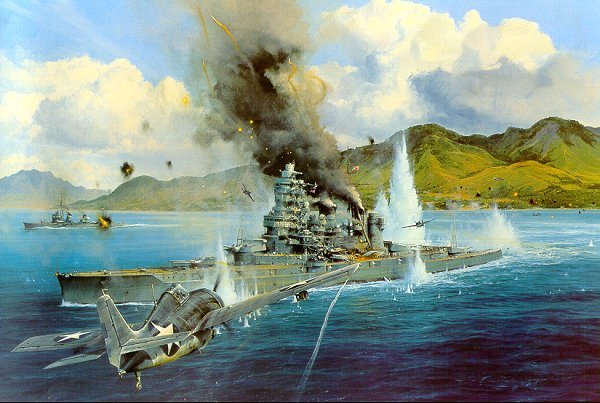
Three categories of aerial attackers participated in the Pacific sea war. First were naval aircraft operated from aircraft carriers or (by the Japanese, the U.S. marine corps, and, occasionally, the U.S. Navy) from shore bases: fighters, dive bombers, and torpedo bombers. Fighters such as the American Grumman F-4F Wildcat and F-6F Hellcat, the Vought F-4U Corsair, and the Japanese Mitsubishi A-6M (Zeke) fought to secure local air superiority so that other, more vulnerable aircraft such as dive bombers and torpedo bombers could survive.
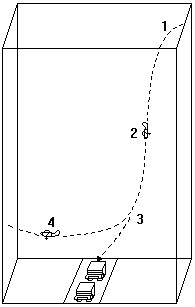
Dive bombers such as the American Douglas SBD Dauntless (and the later Curtiss SB-2C Helldiver) and the Japanese Aichi D-3A (Val) and the Aichi D-4Y2 (Judy) constituted, in the pre-precision weapon era, an imperfect but nevertheless occasionally spectacular means of achieving accurate and devastating results by pin-point bombing in diving attacks.
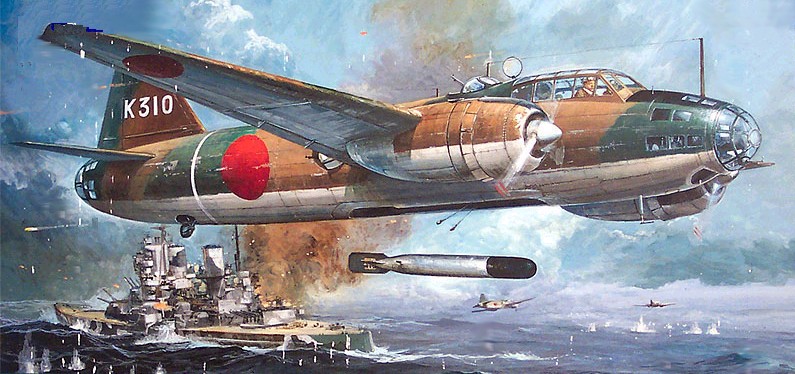
Torpedo bombers such as the Grumman/General Motors TBF/TBM Avenger and the Japanese Nakajima B-5N (Kate) and B-6N (Jill) undertook horizontal attacks at almost wavetop height to emulate the deadliness of the submarine [by gaining line-of-sight aiming].
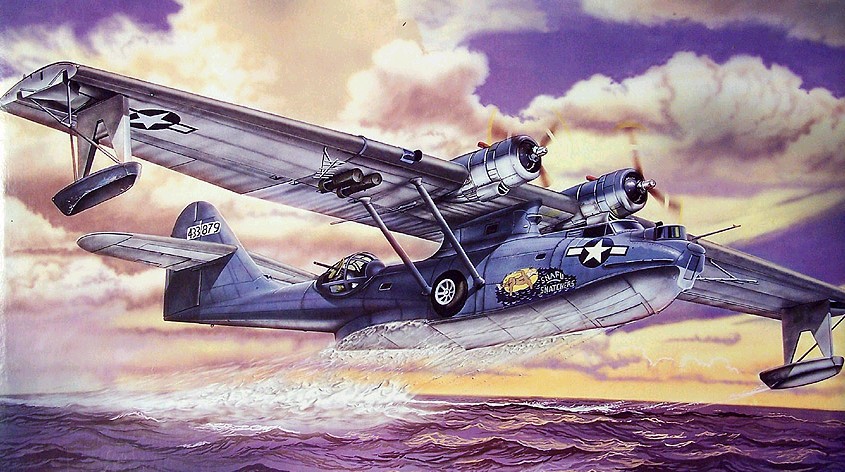
Second were naval seaplanes, operated from harbors and anchorages, or from seaplane tenders, such as the American Consolidated-Vultee PBY Catalina and the later Martin PBM Mariner, and the Japanese Kawanishi H6K (Mavis) and H8K (Emily). These flew long maritime patrols and, occasionally, night attack missions against surface vessels, as well as daytime anti-submarine patrols.
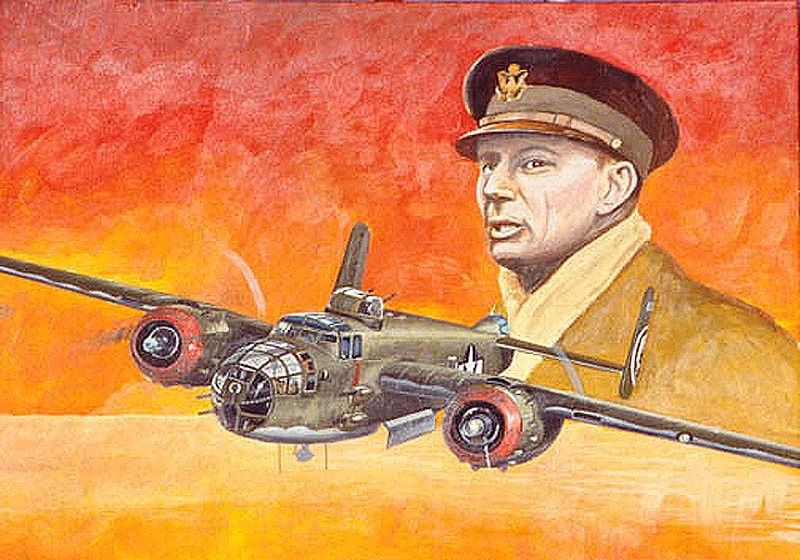
Third were land-based aircraft not originally intended to operate from ships at sea, for example fighters such as the American Lockheed P-38 Lightning and Republic P-47 Thunderbolt, and the Japanese Nakajima Ki-43 (Oscar) and Kawasaki Ki-61 (Tony); long-range patrol bombers (of which the United States had a virtually unique monopoly) exemplified by the Consolidated-Vultee B-24 Liberator (and its naval variant, the PB4Y Privateer); medium bombers such as the American North American B-25 Mitchell (the marine PBJ), and the Japanese G-4M (Betty); and specialized light attack aircraft such as the American Douglas A-20 Havoc and Lockheed PV Harpoon, and the Australian Bristol Beaufighter.
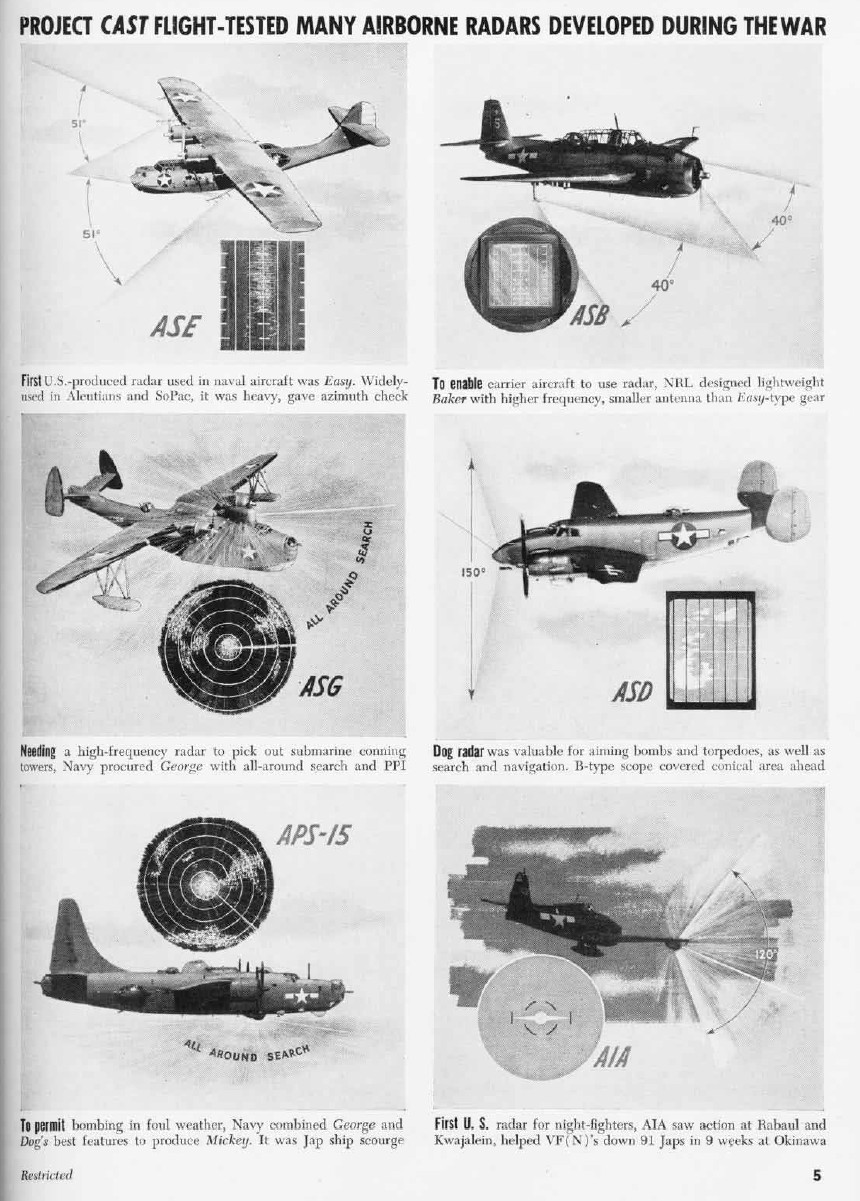
Reliable, Timely Intelligence: The Vital Nexus
As with the war in Europe, the actions of these aircraft and the men who flew them must be understood within the context of a strong nexus between intelligence and operations. The Allied dominance of Axis communications in Europe was matched by the Allied dominance of Japanese communications in the Pacific; MAGIC had targeted Japanese diplomatic codes, while ULTRA, a code word for euphemistically named "special intelligence," gave the Allied leadership transcribed copies of Japanese military communications. As a result, for virtually the entire Pacific War, Japanese intentions were known to the Allies, permitting comprehensive understanding of the Japanese order of battle, military resources available to the Empire, and strategic and tactical planning. (Indeed, so complete was signals intelligence on Japanese air forces that the intelligence staff of the USAAF's Fifth Air Force actually maintained and updated a 4,000 card index file on Japanese aircraft in the New Guinea-East Indies-New Britain region). As in Europe, the importance of this intelligence to the Allies' winning of the war can hardly be overestimated.
Just a sampling of examples indicates the impact that Pacific ULTRA had upon the maritime air war; it:
--Gave insight into Japanese intentions at the Coral Sea;
--Set the stage for the Allies to confront the Japanese fleet at Midway;
--Gave warning of the sailing of the Bismarck Sea convoy that Australian-American air attacks subsequently devastated;
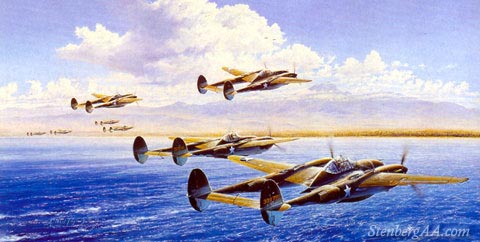
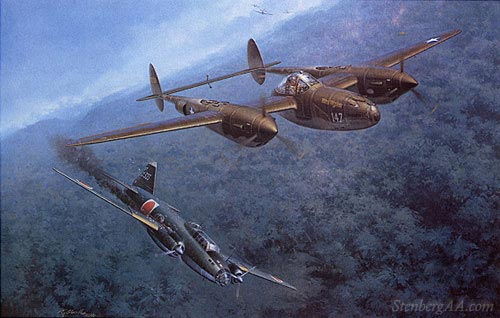
--Alerted the Allies to the inspection trip of Admiral Isoroku Yamamoto, leading to the aerial ambushing of his Betty bomber-transport by a squadron of P-38's over Bougainville, and his subsequent death;
--Set the stage for other successful aerial ambushes, including that of Admiral Seigo Yamagata, over China nearly two years later;
--Furnished intelligence enabling the airmen of General George Kenney and Admiral William Halsey to devastate Japanese naval and air power at Rabaul; and
--Gave continuous information regarding Japanese shipping so that the United States could better manage both its submarine and maritime air campaign.
Particularly useful in the air war against Japanese shipping was a joint AAF-U.S. Navy intelligence operation blending the intelligence staff of Claire Chennault's 14th Air Force and Commodore Milton E. Miles' Naval Group China. This team relied in large measure upon radar and visual reconnaissance, "humint" reports from the coast watchers of the Sino-American Cooperative Organization (an intelligence and guerrilla unit organized within occupied China by Miles), and signals intelligence. This joint team used appropriate intelligence (including Ultra) to send far-ranging B-25 strikers against Japanese convoys, forcing them to operate far off shore, and, not coincidentally, in waters infested by American submarines. So effective were intelligence-cued bomber operations against Japanese sea commerce lines that they were the major reason Japanese ground commanders launched the so-called Ichi-go offensive in 1944 to drive the 14th Air Force from its bases.
Japan's Failure From Within
The Pacific maritime air war likewise must be evaluated in light of Japan's serious misuse of its air power and aviation industrial base, so that, by the end of 1942, it found itself everywhere on the defensive, and in 1944-45, destroyed. First, Japanese industry was incapable of meeting the demands of a far-flung Pacific air war. In 1941, Japan produced only 5,088 aircraft, while the United States produced 19,433; in 1944, Japan produced 28,180 aircraft, while the United States that year produced 100,752. Like Germany, rivalries among design bureaus and companies hindered production, as did labor shortages, and a defensive posture that understandably skewed acquisition towards fighters and away from the many and varied kinds of aircraft needed to win a war.
www.youtube.com/watch?v=Vevezq_x180
Secondly, Japanese military officials made some critically poor choices in the years prior to the Second World War that came back to haunt them. Among these were (in common with all-too-many other naval surface warfare officers worldwide) an overemphasis upon the battleship as the principal means whereby a maritime nation would achieve victory in war; this prejudice continued well after Pearl Harbor, and might best be described as a "it-takes-a-battleship-to- sink-a-battleship" philosophy. Hand-in-hand with this was an almost theological belief in the quest for "the decisive battle." As historian John Prados has written:
"This fixed idea, which almost had the force of cargo cults in some traditional societies, had adverse effects on aviation, on submarine tactics, and on the use of fleet forces for sea control...Decisive Battle meant Yamatos [battleships--ed.] not Shinanos [aircraft carriers--ed.], range finders not radars, small-scale rather than mass aircrew training. Research and development of advanced aircraft, exotic weapons, and the like were affected adversely."
After the war, Japanese military officials acknowledged some of these poor choices, particularly, as Mitsuo Fuchida and Masatake Okumiya noted, the "Myth of the Almighty Battleship," and a mistaken aircrew selection and training process that produced far too few replacements for those lost in the war, particularly in the destruction of Japan's carrier forces at Midway. (Indeed, at Midway, Japan had to operate with four as opposed to five carriers because it had insufficient pilots to man a fifth carrier--Zuikaku--that was otherwise ready to put to sea. Others include:
--The failure to pursue radar so that the Japanese military, essentially throughout the war, operated in a largely "visual only" detection mode (as Fuchida and Okumiya dolefully noted, "night glasses were no match for radar");
--The failure to develop and widely produce successors to the Zeke and Betty with which Japan started the war, and which were out-classed by the Allies by 1943 (a failure Japan shared with the Luftwaffe);
--A strategic philosophy--Richard Pelvin has rightly termed it a "strategic obduracy"--that stressed defending all territory seized from the Allies, at the risk of destroying forces that could have been better husbanded for the defense of the Home Islands;
--A lack of foresight so that the Japanese were, in the words of the United States Strategic Bombing Survey "peculiarly and astonishingly unprepared to convoy and protect their merchant marine against attack whether by sea or air;" and, finally,
--A military culture that accepted, as a given, that Japanese forces would win under virtually all circumstances, and which "cooked-the-books" in military exercises that implied (correctly in the case of Midway) the opposite. [EDITOR: sounds like U.S. military today!]
Editor: we add:
--Failure to protect supply ships with their own seaplanes and adequate ASW surface escorts
The Accomplishments of Allied Maritime Air Power
In the air war against Japanese naval vessels and shipping, Allied attackers developed a deserved reputation for creative use of tactics and weapons to inflict the maximum amount of destruction of the ships they hit. This was particularly evident in:
--USAAF-RAAF operations around New Guinea in 1943;
--Naval long-range land-based operations against Japanese shipping;
--USAAF operations against Japanese convoys in the South China Sea in 1944-45; and
--The mining campaign against the Home Islands in 1944-45.
The New Guinea air campaign is a classic of joint and combined operations that has, unfortunately, been too long neglected. In August 1942, the Japanese attempted to seize Milne Bay, a strategic hold on the New Guinea coast. Tenacious resistance by a combined Australian-American force repulsed this assault, with Australian and American air attacks proving critical to the success of the defenders. In particular, Australian Curtiss Kittyhawks (the P-40 Warhawk in American service) strafed Japanese landing barges, inflicting heavy losses, and prevented Japanese surface vessels from rescuing trapped troops from outlying islands. Unsupported, Japanese forces ashore withered, in one of the few cases where air attack has been directly responsible for preventing a seaborne assault. Had air attack not succeeded in this case, New Guinea likely would have eventually been lost to the Japanese. [EDITOR: this is a questionable biased conclusion]
But it is justifiably the Battle of the Bismarck Sea in March 1943 that has come to symbolize the maritime air war around New Guinea. Here, combined American and Australian air attacks devastated a Japanese supply convoy, sinking all eight transports and four of eight escorting destroyers. One Japanese naval officer, Tameichi Hara, termed the battle "shocking," adding "Japan's defeat there was unbelievable. Never was there such a debacle." The Bismarck Sea victory stemmed from several factors: ULTRA special intelligence; a strong and aggressive air commander (the charismatic Major General George C. Kenney, commander of the Fifth Air Force and General Douglas MacArthur's air component commander); two superb operational planners (Australia's Group Captain William "Bull" Garing--a veteran of the Battle of the Atlantic and the commander of Australian air forces at Milne Bay--and Kenney's deputy Brigadier General Ennis C. Whitehead); hard and realistic training; and appropriate attack aircraft and tactics. This latter point is a significant one, for Kenney's creative engineering and maintenance chief, Major Paul I. "Pappy" Gunn, had modified B-25 bombers into powerful commerce destroyers by giving them up to 10 x forward-firing .50 cal. [heavy] machine guns, complementing the heavily armed Bristol Beaufighters of the RAAF. Further, at Kenney's instigation, another officer, Major William Benn, had pioneered the development of so-called "skip-bombing" tactics (first used by B-17's raiding Rabaul harbor at night) whereby a low-flying bomber could drop a bomb which would then skip like a stone across a pond, hitting a ship at or just below the waterline. All of these came together at the Bismarck Sea, which was to the Japanese even worse than what Convoy PQ-17 had been to the Allies. Essentially, after Bismarck Sea, New Guinea was effectively under an Allied air blockade that remorselessly cut off Japanese forces from any hope of meaningful resupply.
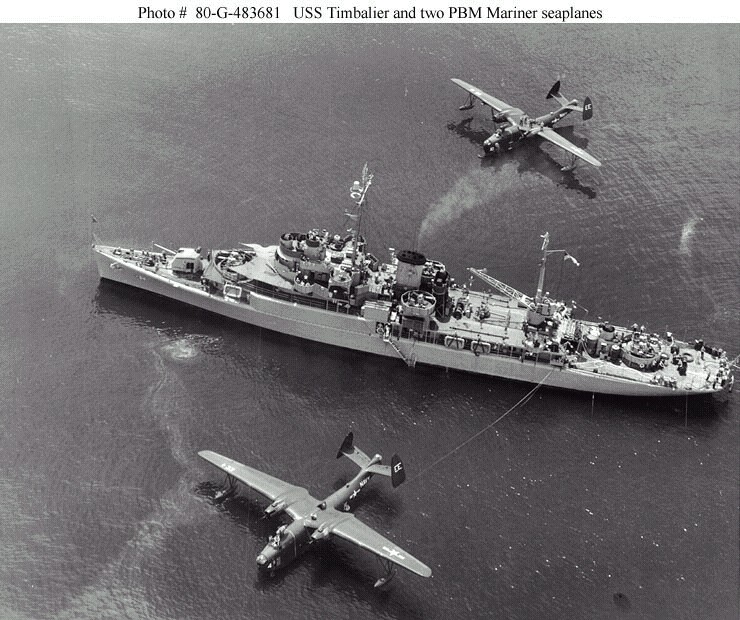
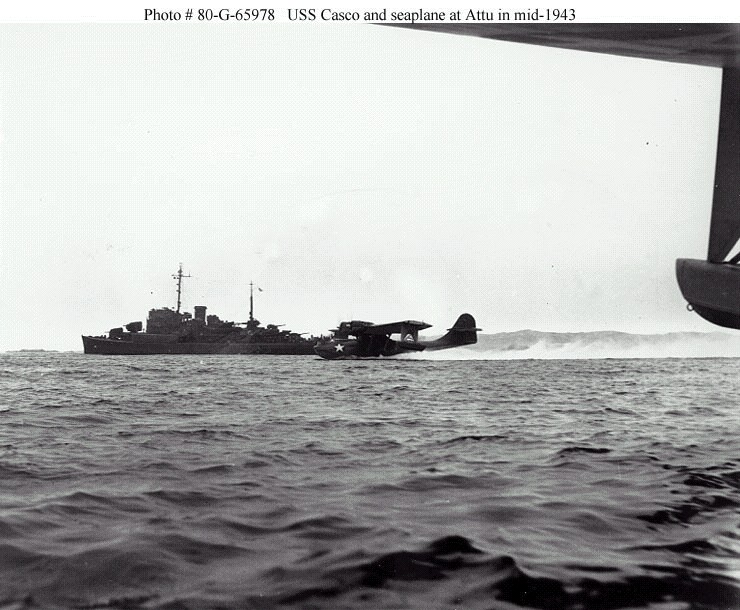
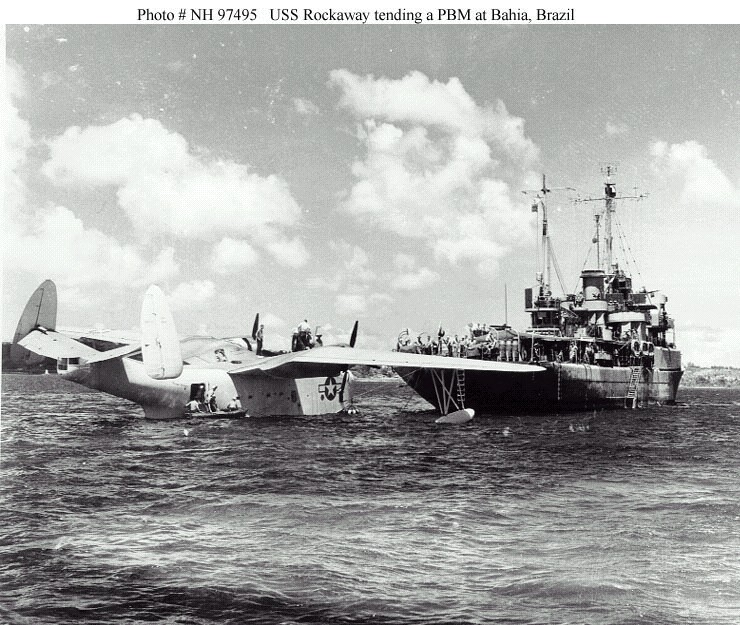
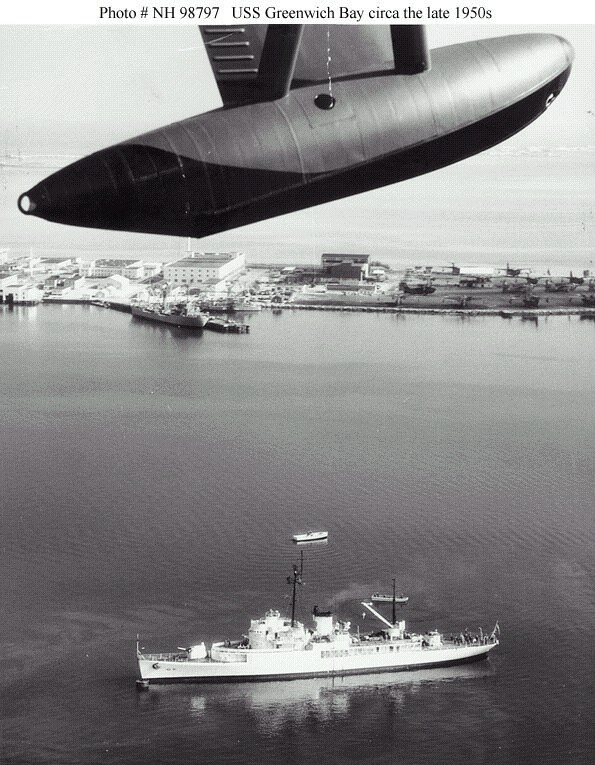
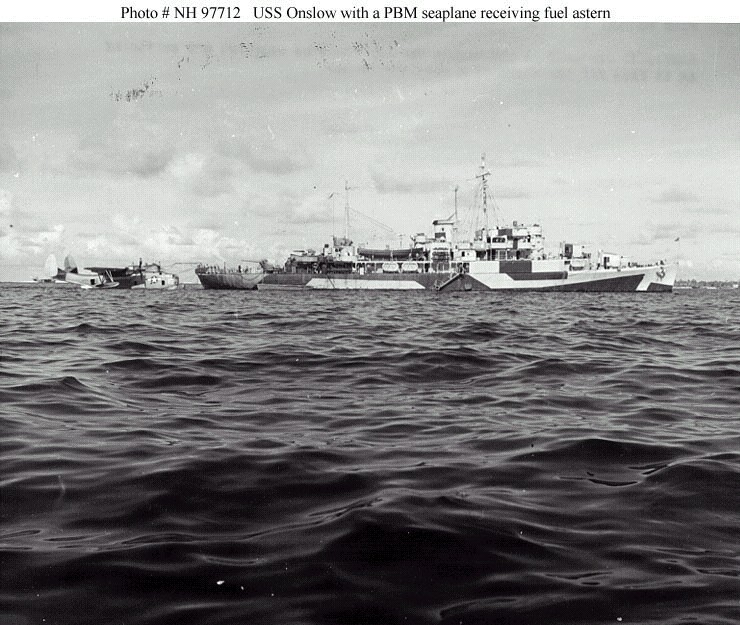
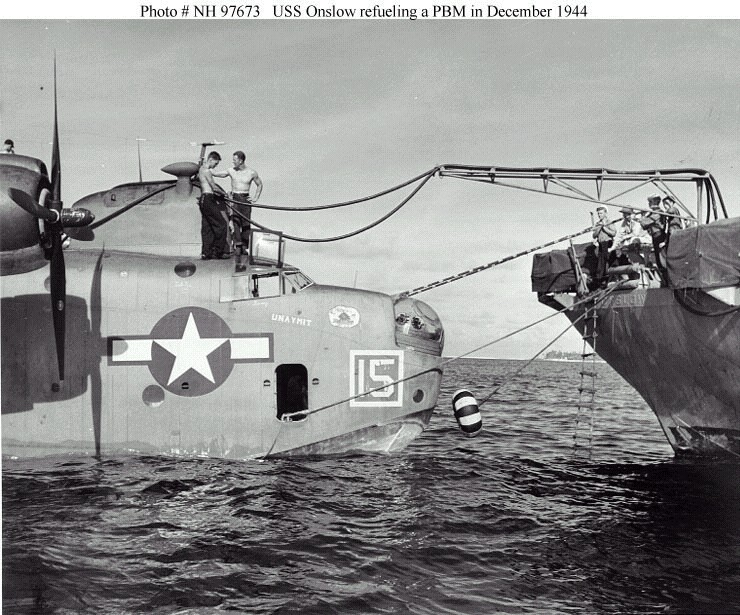
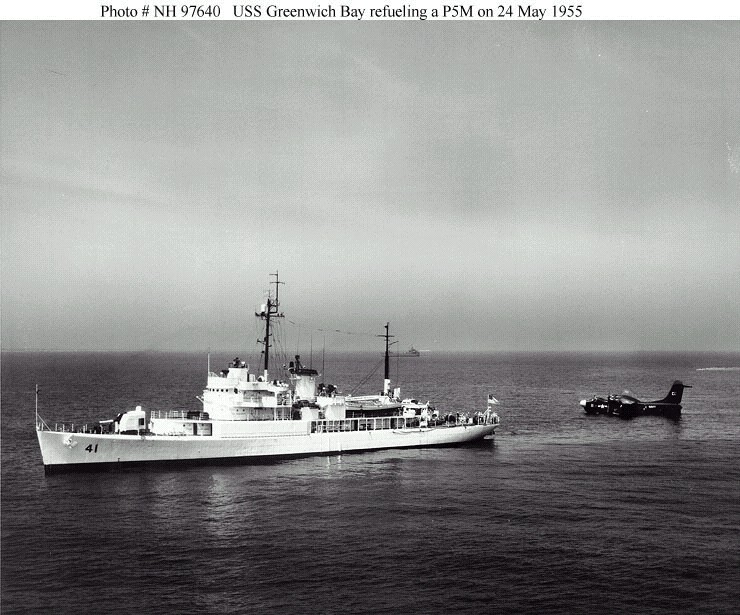
Long-range maritime patrol missions by naval airmen using PBY Catalina and PBM Mariner seaplanes and landplanes such as the PB-4Y Privateer, the PV Harpoon, and the PBJ Mitchell (the latter a B-25 for the USMC) were very productive, as were equivalent "Snooper" operations by radar-equipped B-24's of the Thirteenth, and later the Fifth and Fourteenth, Air Forces. Particularly useful were the Catalina seaplane (which, in its PBY-5A amphibious variant, could operate from both land or sea), and the four-engine Privateer. The somewhat ungainly PBY, truly a "maid-of-all-work," flew maritime reconnaissance, antisubmarine, search-and-rescue, electronic warfare, and night surface strike missions. Catalina night attacks around the Solomons and the Philippines, undertaken by torpedo and bomb-armed PBY's dubbed "Black Cats," were very productive. One Navy patrol bombing squadron, VPB-33, destroyed 43 ships totaling 103,500 tons and damaged a further 20 totaling another 53,500 tons in just one month. In the first four nights of operations, they sank four ships; on another occasion, a single PBY sank two destroyer escorts and capsized a seaplane tender, all in a single sortie.
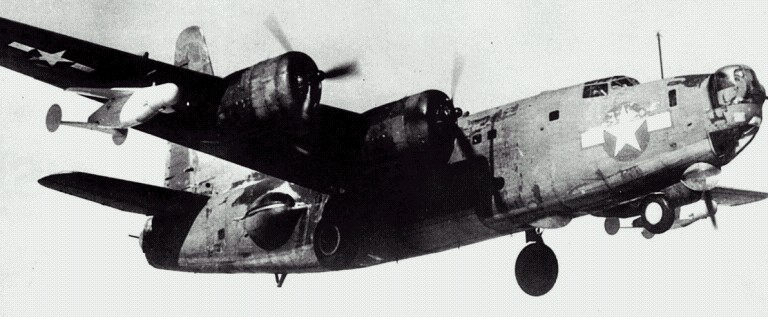
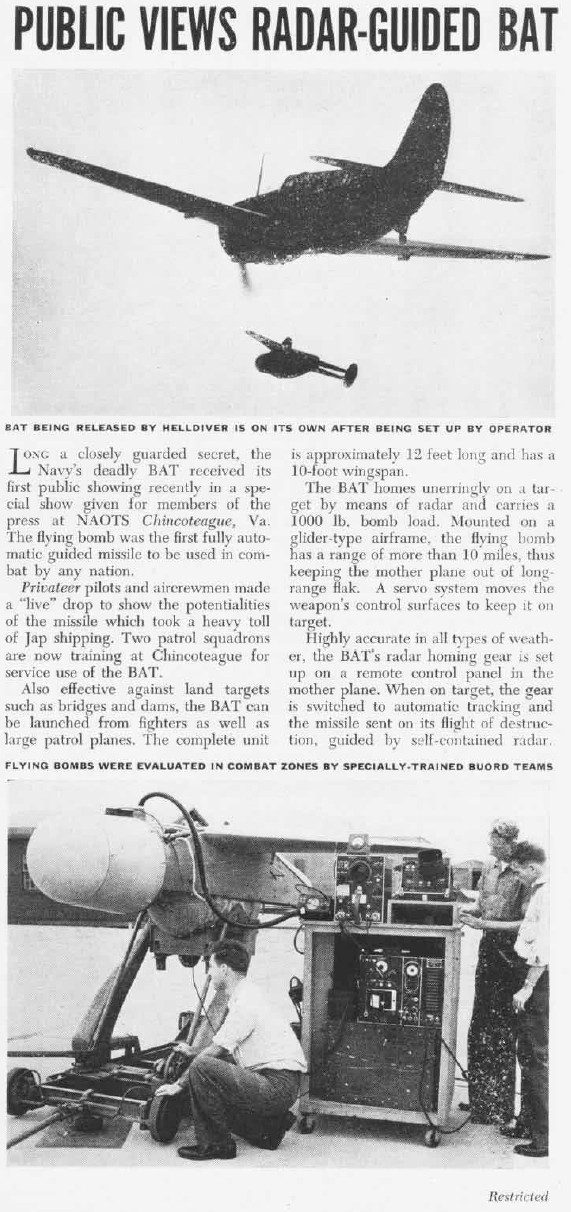
From: U.S. Naval Aviation News, 1 December 1946, page 26
www.history.navy.mil/nan/backissues/1940s/1946/1dec46.pdf
Some info on Bat:
Self-homing anti-ship missile and the first to have an Army/Navy missile designation. Its genesis lay in Dragon, begun in January 1941 by RCA who used their TV expertise to devise a TV-guided aerial torpedo for use against surface ships, with airframe by NBS (National Bureau of Standards). By late 1942, when the airframe had flown, the U-boat menace caused a change in direction. Dragon became Pelican and the payload a depth charge steered by semi-active radar homing, the radar being in the launch aircraft. By mid-1943 the U-boats had been defeated, and Pelican was again reorientated as an anti-ship misssile, enlarged to carry a 2,000 lb (907 kg) general purpose bomb and RHB radar homing.
In 1944 the fourth and final fresh start resulted in Bat like a bat it sent out pulses and listened to the reflections. Using the same NBS airframe Bat carried a Western Electric pulsed radar in the nose and homed on the reflections from the target ship. Like Gorgon it had four small windmill-driven generators, and the autopilot servos drove the tailplane ( with fixed fins ) arid wing elevons. In the centre was a 1,000 lb (454 kg) GP bomb. Bat was developed at the Navy Bureau of Ordnance in close collaboration with MIT whose Hugh L. Dryden won the Presidential Certificate of Merit for it. The PB4Y-2 Privateer carried two Bats on outer-wing racks, and from May 1945 off Borneo took in increasing toll of Japanese ships, including a destroyer sunk at the extreme range of 20 miles (32 kin) - range being a function of release altitude. With modified radar several Bats successfully homed on bridges in Burma and other Japanese-held areas.
* Length: 11 ft, 11 in (3.63 m)
* Span: 10 ft, 0 in (3.05 m)
* Launch Weight: 1,880 lb (852.7 kg)
* Warhead: 1,000 lb (454 kg) HE
* Range: Depends on launch altitude with 20 miles (32 km) being
maximum
* Flying Speed: 300 mph (483 km/h)
* Guidance: self homing using on board radar
* Radar: Western Electric pulsed radar
And the other operational U.S. guided bomb in WW2 U.S. service
ATSC VB-1/VB-2 Azon and VB-3/VB-4 Razon Guided Bombs
The Azon series were the first U.S. guided bombs to be used operationally. The VB-1 Azon - short for 'Azimuth Only' - was a radio command link controlled tailkit attached to a standard M44 and later AN-M65 1,000 lb bomb body. The Azon entered production in 1943, after earlier development by USAAC's Air Technical Service Command.
The Azon used an annular tail assembly like the Fritz-X, was roll-stabilised like the Fritz-X, but could only be steered in azimuth and thus it range error on delivery was similar to a dumb bomb. The Azon guidance package was limited to five preset radio channels, limiting the number of concurrent drops during a raid.
The Azon kit was produced until November, 1944, by which time 15,000 units were built. It was deployed in the ETO from February, 1994, and used extensively in Burma for bridge dropping strikes. The 15th AF in the Mediterranean is credited with Azon attacks on the Danube river locks, and the Avisio viaduct. In Burma, Azons were used to destroy 27 bridges using 493 rounds, including the famous Kwai River bridge.
The Privateers, adopting the skip-bombing tactic of Kenney's airmen, had their own notable successes. During one patrol mission off Truk, a single Privateer sank four ships, possibly a fifth, and damaged a sixth, at the cost of losing an engine to anti-aircraft fire. Another, on a single sortie, sank a small freighter, shot down a Japanese floatplane, and then, acting on ULTRA intelligence, ambushed Admiral Seigo Yamagata's H-8K Emily--the real purpose of the mission--sending him to his death. In the summer of 1945, an advanced Privateer model, the PB-4Y2, distinguished by a large single vertical fin, revised turret layout, and numerous radar antennae, entered service. This model could also carry the Navy's Bat glide bomb. While troublesome, this primitive air-to-surface radar-guided missile did score some successes against Japanese shipping (including sinking a destroyer and several freighters) and bridges, marking the first American use of guided anti-shipping weapons, and one of the first attempts to deploy a genuine precision-guided munition against land targets.
As with the German experience off Norway or the Allied experience in the Mediterranean, the symbiotic partnership between carrier planes, landplanes and submarines was a significant one. In February 1944, for example, submarine attack had bottled up Japanese shipping in Truk harbor, permitting two days of carrier raids to sink 186,000 tons of shipping. Navy Privateers reconnoitered Singapore harbor, monitoring the progress of repairs on damaged Japanese ships; when the moment was right and the ships left port, submarines promptly sank them. Off the China coast, subs and aircraft worked well together. Marauding submarines forced convoys to sail closer to the China coast; then, cued by ULTRA, and radar-equipped Liberators, Privateers, and Catalinas, air attacks by ship-busters took a heavy toll. On March 29, 1945, for example, 31 x B-25's of the Fifth Air Force's famed Air Apaches claimed eight ships and a patrol craft.
Operations such as these dramatically curtailed the attempts that Japan did made to run convoys throughout the beleaguered empire, and it was clearly air attack that Japan's transportation leaders feared most. Of Japan's 47 separate convoy routes, only 9 (19%) were functioning at the end of the war. The rest had been shut down from a variety of causes, such as fear of losing or the actual seizure of territory by the Allies, the threat of air attack, and the threat of submarines. Of the 38 routes shut down, 13 (28%) were closed due to air threats; interestingly, only 4 (9%) were closed due to submarine threat.
Perhaps no combat action of the Pacific war so exemplifies the synergistic partnership of intelligence and air power, the dominance of air attack at sea, and the futility of Japanese actions near the war's end than the strange last sortie of the battleship Yamato. In early April 1945, together with some consorts (a light cruiser and eight destroyers), the monstrous Yamato, ostensibly the world's most formidable battleship, left Tokuyama in a vain attempt to destroy American fleet elements off Okinawa. Long before they left port, ULTRA revealed Japanese intentions. With ULTRA forewarning, the Navy sent out search aircraft. Because of the USAAF's Boeing B-29 Superfortress aerial mining campaign, the Yamato force was limited to using the Bungo straits, further simplifying the search problem. First, the Japanese were sighted by a plane from the carrier USS Essex. Next, two long-range PBM Mariner patrol bombers took up the watch; somewhat pathetically, the band of ships "made frequent radical changes of course and evasive maneuvering," but to no avail. With dismal predictability, a number of strike aircraft from Navy carriers arrived on the scene and, in short order, sent Yamato, together with the light cruiser and four of the eight destroyers, to a watery grave amid a furious assault of bombs and torpedoes. In the words of historian Paul S. Dull, "With the sinking of the great battleship Yamato, the once-formidable Imperial Japanese Navy had ceased to exist." And with it, it might have been added, died 2,500 years of surface warfare ship supremacy. [EDITOR: anyone tell this to the U.S. Navy?]
The Kamikaze: Japan's Desperate Attempt at National Salvation
Japan's response to the growing threat posed by the Allied coalition was to launch the infamous Kamikaze anti-shipping campaign. Though virtually all types of Japanese aircraft were employed at one time or another on Kamikaze missions, the Kamikaze was most often a manned fighter, dive bomber, or torpedo plane. Further, though Japanese Army Air Force pilots occasionally flew on such one-way suicide missions, the overwhelming majority of Kamikazes were Japanese naval attackers. In today's parlance, the Kamikaze was in effect a cruise missile with a sophisticated adaptive flight control system--the pilot--able to provide precise terminal guidance in the end-game encounter.
The threat of the Kamikaze was the greatest aerial anti-shipping threat faced by Allied surface warfare forces in the war. Despite cueing of attacks by ULTRA signals intelligence intercepts, radar tracking, and airborne interception, approximately 2,800 Kamikaze attackers sunk 34 x U.S. Navy ships, damaged 368 others, killed 4,900 Sailors, and wounded over 4,800. While most Kamikazes were single-engine aircraft flown with a bomb or torpedo, a few were multi-engine, and a far smaller number were special-purpose rocket-boosted Ohka ("Cherry Blossom") flying bombs air-launched from twin-engine motherships. Despite extensive defenses--early warning radar, attrition by patrolling fighters, and concentrated, close-in anti-aircraft barrages of proximity-fuzed 5 inch and 40mm cannon fire-fully 14% of Kamikazes nevertheless survived to score a hit on a ship, and nearly 8.5% of all ships hit by Kamikazes sank.
Kamikazes first appeared off the Philippines in the fall of 1944, at a time when Admiral Thomas C. Kinkaid, commander of the Seventh Fleet, and his amphibious assault planners were already concerned that Japanese land-based airplanes could launch potentially devastating air attacks against landing forces during the anticipated invasion of Mindanao, scheduled for early December. Then, on November 25, Kamikaze attackers damaged four of nine fleet carriers in Leyte Gulf; alarmed, Admiral William F. Halsey ordered the bulk of his Task Force 38 back to Ulithi atoll, echoing the withdrawal of naval forces from Guadalcanal in the face of Japanese land-based air attacks in 1942. [EDITOR: this is EXACTLY what's going to happen again when today's 11 carriers are overwhelmed by ASMs and submarine attacks] In the face of naval estimates that further Kamikaze attacks could, at the least, damage aproximately 25% of Kinkaid's transports and landing craft, Kinkaid pressed for a delay in the planned Mindanao landing. After a series of protracted and sharp meetings between Kinkaid and Southwest Pacific commander General Douglas MacArthur, the feisty admiral won his point. The planned invasion of Mindanao was slipped ten days, until friendly air power, both naval and land-based was strengthened to confront the Kamikaze menace.
As soon as they appeared, then, the Kamikazes revealed their power to force significant changes in Allied naval planning and operations, despite their relatively small numbers compared to their adversaries. Later in the year, the threat of Kamikaze attackers based on Formosa and Luzon forced routing changes for American convoys steaming to Lingayan Gulf. Nevertheless, despite such changes, Kamikazes took a heavy toll of ships and sailors. Admiral Jesse Oldendorf's amphibious support group underwent sustained attacks between January 4 and January 6, resulting in one small escort carrier and a destroyer-minesweeper sunk, and multiple hits to other ships, including another carrier, two battleships, five cruisers, and twelve lighters, resulting in urgent calls for greater friendly air cover. Despite prompt response by American naval and land-based fighters, attacks continued over the next several days, claiming two more minesweepers; on January 8, Japanese attackers heavily damaged six ships, including two on an Australian cruiser (already hit previously by three Kamikazes), and one each on two escort carriers. The Kamikaze anticipated the post-1960's-era anti-shipping missile [ASM], for it forced planners to take extraordinary measures to confront what was a basically straight-forward threat, but a threat that could profoundly influence events out of proportion to its strength.
With some justification, the Okinawa campaign is considered the apogee of Kamikaze operations against the American fleet. In particular, Kamikazes took a terrible toll of radar picket destroyers and other small craft off Okinawa, but larger ships were not invulnerable to attack. Overall, no less than 36 hits were recorded by Kamikazes on aircraft carriers, and three small carriers were sunk (including the unfortunately named USS Bismarck Sea). Larger ones--such as the USS Enterprise and Bunker Hill, while not sunk, were often so badly damaged as to be knocked out of the war. (And of course there is the USS Franklin, which, while not a victim of a Kamikaze, was nevertheless lost to the war effort by a conventional dive bombing attack). The threat of the Kamikaze was thus considerable, and the most that can be said is that the combination of intelligence, shipboard early warning radars, aerial interception, and close-in defenses enabled the Allies to endure the threat, not triumph over it. Had an invasion of Japan been attempted, the Japanese were confident they could inflict at least 50,000 casualties by Kamikaze attack alone. Since they had, at war's end, 6,374 operational fighters and bombers, with several thousand other aircraft available for attack as well, such an estimate is completely acceptable, and yet another reason why servicemen in the Pacific theater have reason to be thankful for the dropping of the atomic bomb.
Aerial Mining Bottles Up the Home Islands
As aerial mining by long-range land-based aircraft played a leading role in the defeat of Nazi Germany's naval ambitions, so, too, did it play a leading role in the defeat of Japan. By the end of 1944, air power (both by land-based and sea-based aircraft) was dominant. In the words of one submariner skipper, "we had passed the high-water mark of submarine activity. It had become an aviator's, not a submariner's war." In the summer of 1945, air attacks dominated Japanese ship sinkings; in July 1945, U.S. submarines accounted for 14 ships. But that same month, aircraft attacks accounted for 129 ships.
Not surprisingly, aerial mines were a deadly weapon that seriously constrained the Japanese. Mine attacks took place in an "Outer Zone" (consisting of the South Pacific, Southwest Pacific, Central Pacific, and the China-Burma-India theater), and an "Inner Zone" which consisted of Japan's home waters. A grand total of 24,876 mines were laid in Japanese waters by Allied aircraft, ships, and submarines. Of this total, aircraft accounted for 21,389 mines, representing 86% of all mines deployed against Japan. (Ships accounted for 11%--2,829 mines deployed--and submarines for but 3%--658 mines deployed). Overall, the Allied air forces flew 4,323 mining sorties against Japan, 67% of these seeding 108 fields in the Outer Zone, and 57% seeding 26 fields in the Inner Zone. Land-based aircraft of the USAAF were responsible for dropping 14,969 mines, representing 70% of the total of 21,389 mines dropped against Japan. Of the total mines air-dropped against Japan, 9,254 (43%) were mines deployed in Outer Zone attacks, and 12,135 (57%) were mines dropped in the Inner Zone. The density differences of Outer and Inner fields are clearly evident; Outer Zone fields averaged 86 mines each, while Inner Zone fields averaged 467 mines each.
Of these Outer and Inner Zone aerial mine seedings, the USAAF flew 2,078 sorties (48%), the RAAF 1,128 sorties (26%), the RAF 631 sorties (15%), and the US Navy 486 sorties (11%). Of the 2,078 USAAF sorties, 1,424 were Inner Zone seedings by long-range Boeing B-29 Superfortress bombers carrying between 7 and 12 mines. B-29's accounted for 69% of all AAF sorties, 33% of all Allied mining sorties against Japan, and (in part because of their high capacity) dropped all 12,135 mines deployed in Inner Zone attacks. B-29's were thus responsible for laying 57% of the total of 21,389 mines air-dropped against Japan in both Inner and Outer Zone attacks.
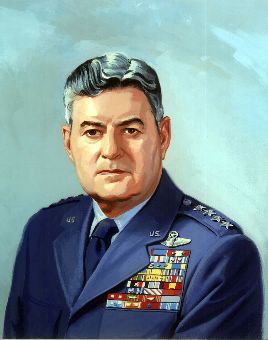
While it might have been expected that B-29 commanders--particularly General Curtis E. LeMay--would have resented the "distraction" that mining offered away from attacks against the Japanese mainland, Dr. Ellis Johnson, a Navy mine expert who played a major role in the campaign, concluded that "It was the firm belief in and support of the mining effort by General LeMay himself that made the successful campaign possible at all." Indeed it is striking that LeMay--like the RAF's Harris before him--intuitively recognized the importance and value of the mining campaign as an integral part of his comprehensive strategic air effort against the enemy.
Overall, based on a post-war Naval Ordnance Laboratory assessment of Japanese records, Allied mining accounted for a total of 961 ships sunk or damaged, representing 2,027,516 tons. Of these, mines sunk 484 ships (representing 649,736 tons), damaged 139 others so severely as to be lost to the war effort (378,827 tons), and damaged 338 ships less seriously (998,953 tons). Of 606 ships mined in the so-called "Inner Zone" attacks undertaken by the B-29's of the XXI Bomber Command, 283 ships (representing 396,371 tons) were sunk, 137 (376,004 tons) were damaged too severely to return to service, and 186 (478,881 tons) were less seriously damaged. B-29 mining of the Shimonoseki straits, for example, effectively closed it to large warships as well as other craft; eighteen sunken ships and four sunken destroyers attested to futile Japanese attempts to run the Shimonoseki aerial mine blockade. Ship passage through the Shimonoseki strait decreased from 70,000 tons per day in March, to 35,000 tons in April, plunged to 7,500 tons in May, to 1,750 tons in June, staggered up to 8,000 tons in July, and dropped to 1,500 tons in August. In their study of the Pacific mine campaign, naval analysts Ellis Johnson and David Katcher concluded that B-29 mining sorties caused fully 60 percent of Japanese shipping losses between March and August 1945. Further, 19 of 22 repair yards--fully 86%-- were rendered useless by mine blockade, inhibiting the ability of the Japanese to repair their damaged vessels.
Indeed, B-29 attacks were approximately twice as effective per unit of time as submarine attacks in strangling Japan. Only counting sinkings, B-29 Inner Zone mining cost Japan 283 vessels lost over 4 1/2 months, a monthly average of 63 ships. By comparison, submarine attacks cost Japan 1,314 vessels over 44 1/2 months, a monthly average of 30 ships. The force that did this, in terms of national investment, was remarkably small. The post-war Joint Army-Navy Assessment Committee credits 190 American submarines with sinking 1,314 ships, thus averaging 6.92 ships sunk per submarine. But the B-29 mining force deployed against Japan was only approximately 40 aircraft, producing an average of 7.08 ships sunk per B-29.
Thus, a $639,188 B-29 with a crew of 11 men achieved slightly better results than an approximately $3.6 million submarine with a crew of 85 men. Further, it cost the United States government only $90,281 in B-29 aircraft costs per Japanese ship sunk versus $520,23l in submarine costs per Japanese ship sunk. The overall force economic costs--just looking at the costs of the aircraft and submarines involved--makes for its own interesting comparison: $25,567,520 for the B-29 mining force vs. $684,000,000 for the submarine force. The cost differential in human lives is even more sobering. For every airman lost on the Inner Zone mining campaign (a total of 103 men), Japan lost 2.75 ships; for every sailor lost in the submarine campaign (approximately 3,300), Japan only lost 0.40 ships. Additionally, the aircraft dropped a relatively "stupid" and reasonably cheap weapon--the mine. The submarine fired a far more expensive miniature submersible, the self-propelled torpedo. Although fewer torpedoes were expended per sunken Japanese ship than mines (11.22 torpedoes vs. 42.88 mines), mines clearly were a cheaper alternative and, more importantly, did not require the characteristically close and dangerous approach to enemy shipping and heavily armed escort vessels necessitated by the torpedo.
In sum, then, aerial mining risked fewer lives, used fewer resources, and, proportionally, achieved far more with less than the much-heralded submarine campaign. Further, it is likely that submarine pickings of Japanese shipping over the spring and summer of 1945 were as lean as they were not because so many ships had already been sunk (as submarine adherents have traditionally claimed), but, rather, because so many were bottled up in port by the aerial mining campaign. And, finally, it must be remembered that, in the case of the B-29's, mining was incidental to the fundamental purpose of the airplanes--strategic bombing--whereas, for submarines, torpedo attacks on shipping were their raison d'etre. Indeed, one can understand the conclusion of the analysts of the postwar United States Strategic Bombing Survey when they wrote, after examining the mining campaign against Japan, that:
"It is believed that this campaign, begun earlier and laid on with greater weight, would have reduced effective shipping nearly to the vanishing point. It would have produced a condition of crisis in Japan sooner than actually occurred."
Maritime Air Attack's Record in the Pacific War
What judgments can one reach about the efficacy of maritime air operations in the Pacific?
For a start, both the Japanese and the Allies had notable successes. But as in European waters, once the Allies had secured air superiority, the Japanese were unable to pursue the kind of maritime air war that they needed to win the war; their reconnaissance aircraft were shot down, and their strike aircraft mauled on the way to their targets. The Kamikaze experience, while dreadful, could not bring victory--only delay. For the Allies, the value of air power against Japan's maritime forces was profound. The post-war JANAC study by a joint U.S. Army and U.S. Navy assessment committee of the maritime war against Japan offers a remarkable look at what air power did in the naval war context, even allowing for its conservative approach to mine casualties:
Total Japanese ships sunk (and tonnage) 2,728 (9,736,068)
sunk by submarines 1,314 (5,320,094)
sunk by surface craft 123 (321,166)
sunk by direct and indirect air attack 1,232 (3,816,653)
sunk by combined air-sea/other attack 46 (249,727)
sunk by mines laid by ships or subs 7 (22,353)
sunk by shore batteries 2 (2,770)
sunk by unknown causes 4 (3,305)
What is not so readily apparent, but which can be extracted from the data in the JANAC study, is the following: By JANAC's figures, while submarines were responsible for sinking 48% (1,314) of the total ships lost by Japan, aircraft were responsible for sinking by direct attack or with mines 45% (1,232). Further, in concert with other attackers, they sank an additional 2% (46 ships). Therefore, air power forces, directly, indirectly, or partnered with other attackers, was responsible for sinking 47% of Japan's maritime losses, a tonnage value of 4,066,380 tons.
JANAC indicates that of the 1,232 ships (3,816,653 tons) sunk by air attack:
--259 (21%) (587,302 tons) were sunk by aerial mines;
--973 (79%) (3,229,351 tons) were sunk by direct USAAF, USN, or USMC attack;
Of this total:
--688 (56%) (1,592,482 tons) were sunk by land-based aviation forces in direct attack or by air-dropped mines.
--520 (42%) (2,101,477 tons) were sunk by carrier-based aircraft.
(Note: combinations of land-and-sea-based air power forces account for the 2% "missing" ships).
Perhaps most surprisingly, JANAC data indicates of the ships sunk by air attack, land-based Army Air Forces aircraft sank fully 46%--567 ships representing 1,282,192 tons. This is a powerful commentary on the role that land-based air forces played in maritime warfare even in an era of non-precision munitions, and an indication of the even greater abilities land-based air has to challenge a maritime attacker or nation in the present day era of precision weapons.
Maritime Air Power After the Second World War
The Second World War was the last great war at sea. [EDITOR: WHO THE FUCK IS THIS GUY TO DECLARE THIS WILL BE THE LAST OF ANYTHING? IS HE GOD?] During the long years of the Cold War, which witnessed the rise (if for only a brief period) of the Soviet Union as a global naval power, both the Western and Soviet alliance systems devoted considerable attention to the anticipated problems of maritime air warfare. Both the Soviet Union and Western blocs produced large numbers of maritime patrol aircraft derived from long-range bombers (such as the Soviet Myasischev Bison, Tupolev Bear, Tupolev Badger, and Tupolev Backfire), airliners (notably the American Lockheed Electra---->P-3 Orion, the British Bristol Britannia---->Canadian Argus and the De Havilland Comet---->British Aerospace Nimrod, and Soviet Ilyushin Il-18 Coot--->Il-38 May), or, in some cases as special "designed-to-task" maritime patrol airplanes (as with the American Martin P-5M Marlin and Lockheed P-2V Neptune, the French Breguet Atlantic, the Soviet Berev Be-6 Madge and Be-12 Mail, and the British Avro Shackleton).
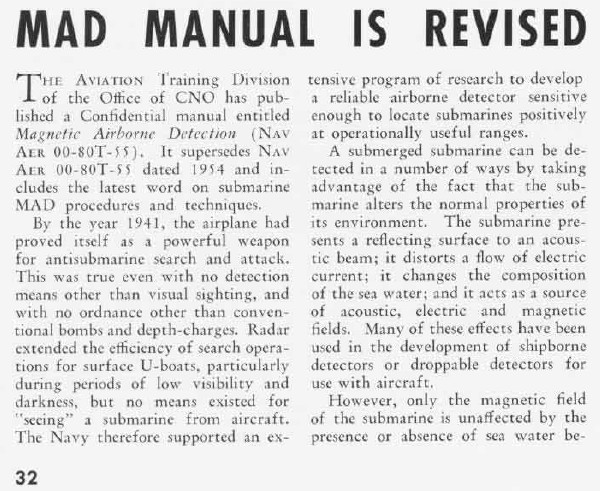
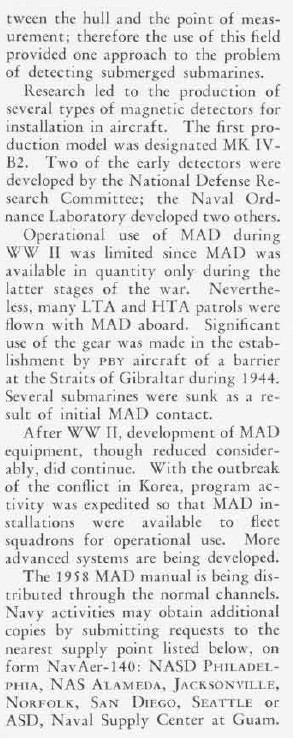
Today the USN doesn't have ANY ASW planes like this operating from her supercarriers, stupid, huh?
As the threat of the new generations of sophisticated submarines carrying advanced weapons including homing torpedoes and missiles gradually emerged, more and more of these systems were designed for the anti-submarine role as opposed to attack of surface ships. The clear danger submarines posed to aircraft carriers spurred creation of specialized ship-based anti-submarine aircraft such as the French Breguet Alize and American Grumman S-2F Tracker, leading eventually to a turbojet-powered successor, the contemporary Lockheed S-3 Viking [EDITOR: now retired with no replacement], as well as a proliferation of anti-submarine helicopters. In the case of the Soviet Union, the large numbers [11? this is a "large" number? Says who?] of American aircraft carriers (and, to a far lesser extent, British, French, and other carrier forces) created its own difficulties resulting in Soviet naval aviation forces emphasizing missile attack against carrier task forces using increasingly sophisticated missiles launched from long-range bombers. In turn, with the Kamikaze experience clearly in mind, carrier nations, particularly the United States, emphasized long-range fleet air defense with increasingly sophisticated interceptors, command and control, and airborne warning, eventually culminating in the Phoenix-armed Grumman F-14 Tomcat of the 1970's and beyond [EDITOR: beyond my ass, its retired!].
The size of American aircraft carriers dramatically rose after the early-1950's (with the first of the "super" carriers, the USS Forrestal, constituting a departure point), reflecting the demands of the jet age. (Nations with smaller financial resources, such as Great Britain and France, continued with smaller vessels; after two decades of operating smaller helicopter carriers with V/STOL fighters--first pioneered by Great Britain--the Soviet Union finally embarked on large carrier development in the 1980's, but the breakup of the Soviet Union into a federation of independent republics put such plans on hold). Together with size came three significant innovations (adapted from British experience) that transformed American naval aviation and dramatically improved its efficiency and safety: the introduction of the angled flight deck, installation of the mirror landing system, and the introduction of the steam catapult. Ironically, as these changes improved efficiencies and safety, and as the size of aircraft carriers and their crews increased dramatically (as did the need for specialized surface escort forces guarding the carrier) the actual size of deployed carrier air forces aboard ship declined. First termed Carrier Air Groups in World War II and Korea, and then Carrier Air Wings afterwards, these forces decreased from approximately 100 aircraft (virtually all of which were "shooters") per large carrier in the Second World War to approximately 75 airplanes per carrier by the time of the Gulf War, the majority of which were support or purely fleet air defense airplanes.
With the size limitations imposed on naval aircraft (no matter how large the carrier), this meant that, by the late 1980's, American naval carrier forces were increasingly dependent upon long-range land-based air forces in order to prosecute their mission--particularly in their need for aerial tanking--but also for reconnaissance, airborne warning and control, electronic warfare, global deployment and sustainability, and suppression of enemy air defenses as well. Without Air Force tanker support in the Gulf War, for example, two-thirds of the U.S. Navy's strike sorties in the Gulf War would have had to be cancelled.
Ominously, the long-range and precision weapon revolutions were rendering land-based aircraft, submarines, and missile-armed small combatants increasingly dominant and effective in the maritime warfare role, as various conflicts would soon prove. The danger of these weapons increasingly forced carrier battle groups to operate further and further away from shore, degrading their traditional value as a means of projecting global presence (for presence unseen is presence unheeded) and, worse, exacerbating the already serious range problem increasingly afflicting naval aircraft operations against deep inland targets. By the mid-1990's, in response to such changes, as well as the end of the Cold War, maritime strategic thinking increasingly emphasized littoral, insular, and coastal warfare over deep strike power projection.
Fortunately, the United States and its allies never had to [yet] confront the Soviet bloc in a "hot" maritime war. But in the many conflicts and crises that have occurred since the Second World War--and particularly in the Korean, Southeast Asian, Falklands, and Gulf conflicts--maritime air warfare has played a significant role. In Korea, the last major war in which air refueling was not an option for military planners, the early and continuous presence of American and British Commonwealth carriers greatly assisted in the air campaign against Communist forces. But aside from maritime patrol operations against small coastal craft and for counter-mining operations, there was little in the way of an anti-shipping war.
During the Cuban Missile Crisis of 1962, maritime air power played a significant role in ensuring the success of the blockade the Kennedy administration placed around Castro's Cuba. Naval P-2 and P-3 patrol planes located and photographed Soviet-bloc vessels heading towards Cuba so that intelligence analysts could assess what they were carrying (a science known to intelligence analysts as "crateology") and, where appropriate, direct naval vessels to intercept them. Less well-known is the role played by the U.S. Air Force's Strategic Air Command which, at U.S. Navy request, located and identified Soviet ships in mid-Atlantic. As the crisis began, SAC employed KC-97 and KC-135 tankers, together with B-52 strategic bombers, in the sea surveillance role, before standardizing on the excellent Boeing RB-47 Stratojet reconnaissance aircraft for the Cuban missions. The six-engine radar-equipped RB-47's eventually made a total of 374 sightings. Two cases recollected the Rex mission of the late 1930's. In the first, the Navy asked SAC for help in locating the freighter Odessa, known to be on the high seas and believed carrying nuclear warheads for the Soviet SS-4 missiles then being installed in Cuba. A SAC B-52 located it, whereupon the Odessa immediately stopped, "never came any closer to Cuba, and eventually turned around and returned to the Soviet Union." In the second, SAC successfully responded to another urgent request by the Navy to locate and photograph the Soviet tanker Grozny, believed transporting missile fuel; an RB-47 locating, photographing, and subsequently circling this ship until a destroyer intercepted it. Grozny also turned back, though it carried liquid ammonia, not fuel for the SS-4's. Altogether, SAC flew over 5,000 sea surveillance sorties during the month-long crisis, demonstrating the enduring value of land-based strategic bombers employed in maritime roles.
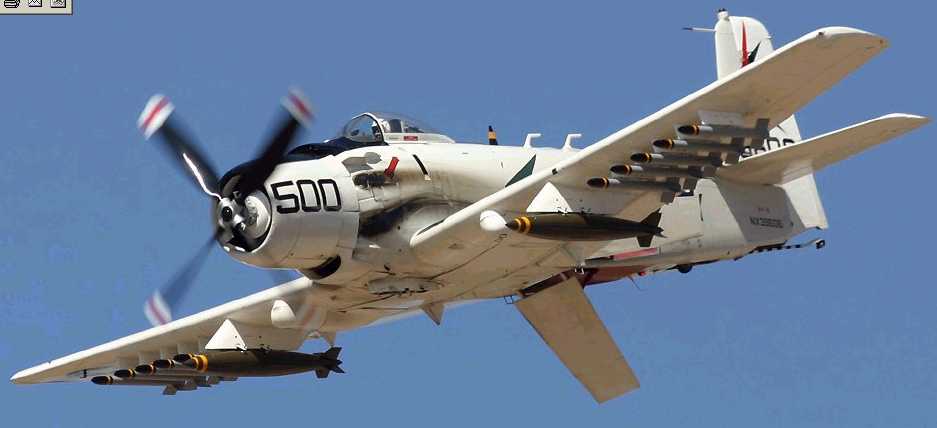
The Vietnam experience largely mirrored that of Korea, and witnessed a lengthy sea patrol activity, Operation Market Time, involving both shore and ship-based aircraft (typically P-2, P-3, and P-5 patrol planes, and, briefly, carrier-based A-1 Skyraiders) operating in concert with surface patrol craft. Thousands of sorties helped minimize Communist use of the sea to supply their forces. Of far more significance, however, was the growing importance and relative ease of using the so-called Ho Chi Minh trail running inland from North Vietnam through Laos and Cambodia into the South. For the most part, anti-shipping operations were but a much smaller portion of a naval air war concerned largely with air strikes against land targets.
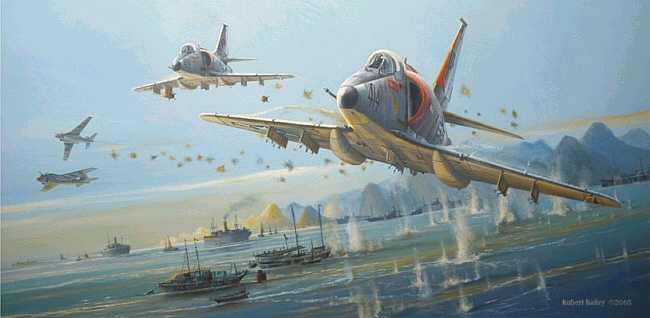
A-4 SkyHawks and A-6 Intruders air-mine Haiphong harbor
However, in May 1972, the United States resorted to mining of seven North Vietnamese ports as one aspect of the air pressure campaign forcing North Vietnam to the peace table. Mines dropped by carrier-based Grumman A-6E Intruder attack aircraft brought all maritime commerce to a halt, and stranded 27 ships in Haiphong harbor; the U.S. Navy's Seventh Fleet commander, Vice Admiral William P. Mack, subsequently recollected that "The North Vietnamese ran out of ammunition, just as we always said they would."
Maritime air operations did not play prominently in any of the Arab-Israeli wars, or in the India-Pakistani ones, though there were some attention-getting attacks. Most notably, in the 1967 Arab-Israeli conflict, Israeli aircraft and small combatants launched a series of air and sea attacks on the intelligence vessel USS Liberty (then cruising off the Egyptian coast) that nearly sank the ship and, tragically, killed or wounded 205 American Sailors and intelligence personnel. After the war, the Israeli destroyer Eilat, patrolling 15 miles off Port Said, was sunk by four Soviet-made Styx anti-shipping missiles fired from an anchored Egyptian missile boat in harbor, killing or wounding 99 of its crew. Likewise, the two India-Pakistani wars featured some maritime air operations (including anti-submarine sorties and carrier air strikes by Indian Breguet Alize and Hawker Seahawk aircraft), though these were but a sideshow to the larger conflicts being waged ashore.
Of all of these events, it was the sinking of the Eilat that had the greatest impact; one surface warfare officer remarked that "it was reveille" to the surface Navy, and a Center for Naval Analyses study concluded "The threat is so great to all combatant ships of the Navy that a revolution in naval tactics may be required." Rumors that the Soviets had supplied Styx missiles to North Vietnam seriously constrained naval operations off the Vietnamese coast, particularly shore bombardment missions, and the then-commander of Cruiser-Destroyer Flotilla 7, Rear Admiral Elmo Zumwalt, (later the Chief of Naval Operations in the Carter administration), called the potential Styx threat his "worst nightmare."
The Soviet Union's alarming investment in increasingly sophisticated air-, surface-, and submarine-launched anti-shipping missiles (some with nuclear warheads), together with rapid expansion of the Soviet fleet under Admiral Sergei Gorshkov, stimulated a tremendous effort by the U.S. Navy to develop counters. Early Soviet anti-shipping missiles tended to be relatively large transonic weapons, but subsequent missiles increasingly emphasized high supersonic speed and more precise targeting capabilities than their predecessors, as well as longer range that enabled them to be launched well beyond the defensive screen of a carrier battle group. This threat directly influenced the purchase of the Grumman F-14A Tomcat, armed with six long-range Phoenix air-to-air missiles, as well as more advanced airborne and surface early warning radars and fire control systems. Chief among these was the remarkable Aegis electronically steered radar which, coupled with a new surface-to-air missile (the General Dynamics Standard), and a fast-response launcher, promised some relief from the anti-missile threat. Complementing Aegis was creation of new shipboard gun and missile defenses (notably the Phalanx and Sea Sparrow), accelerated development of new anti-submarine warfare weapons and techniques, and likewise accelerated development of the McDonnell-Douglas Harpoon, an American antishipping missile. Clearly, then, the example of the Eilat, and the new aggressive posture of the growing Soviet fleet--which would often pointedly follow American fleet units with its own missile-armed warships--profoundly unsettled the Navy. But despite corrective measures, the problems posed by newer classes of weapons such as France's sea-hugging Exocet, or the Chinese-manufactured Silkworm, continue to confront naval planners in the present day.
The Falklands War
The Falklands war of 1982 was a notable exception to the general post-war pattern of indecisive naval combat. Here maritime air power had a profound effect upon surface vessel operations. Land-based Argentinean strike aircraft sank six ships (two destroyers, two frigates, a container ship functioning as an aircraft carrier, and a fleet auxiliary) and damaged a further thirteen (four destroyers, six frigates, and three fleet auxiliaries); British carrier-ship-based aircraft and helicopters sank or forced the abandonment of six vessels (a submarine, two patrol boats, a trawler, and two freighters), and damaged another patrol boat. British maritime air superiority, gained by carrier-launched V/STOL strike fighters, enabled all other British naval and amphibious operations to occur. Air-launched missiles (the French-made Exocet used by Argentina and the British Sea Skua), fired from aircraft and helicopters, proved deadly, but so, too, did conventional bombs.
The Falklands campaign was notable for dramatically highlighting the value of anti-shipping missiles such as the Exocet and the Sea Skua, shipboard surface-to-air missiles, and (for the British) the leverage offered by the British Aerospace Sea Harrier armed with advanced air-to-air missiles (the American AIM-9L).
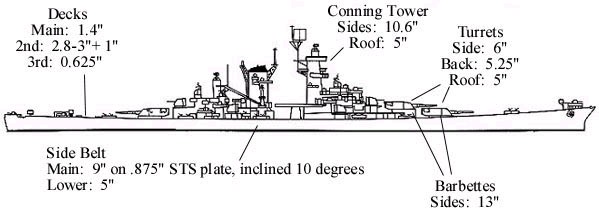
It likewise recalled the continued vulnerability of large capital ships to submarine attack, the latter shockingly highlighted by the sinking of the Argentinean cruiser Belgrano by the nuclear submarine HMS Conqueror, with disturbingly high casualties. In particular, however, it illuminated the increasing threat to ships by maritime air attack and, especially, to the vulnerabilities of many newer vessels (less well armored than their predecessors of the Second World War, in part because of their having heavier topsides for carrying extensive electronic equipment) to even unsophisticated and, indeed, obsolescent attackers dropping conventional non- precision "iron" bombs. These newer ships were heavily damaged or sunk even when weapons did not explode; for example, the British destroyer HMS Sheffield, hit by an Exocet that failed to explode, succumbed to a fire triggered by the missile's unspent fuel. (This ominous event "demonstrated the powerful sea denial capabilities still possessed by Argentine maritime air forces."). Likewise, the British destroyer HMS Glamorgan was seriously damaged by a shore-launched Exocet that hit the ship, though without detonating.
Indeed, it is often missed is that the British victory owed as much to the operational inexperience of Argentinean airmen and bomb fuzing problems as it did to the skill and technological advantages of its own force, and the tremendous logistical accomplishment of equipping and moving such a force so far in a relatively brief period of time. For example, of the approximately 22 bombs which struck British ships, 12 failed to detonate and one detonated late. Only 9 were released high enough to arm and then detonate upon impacting a ship: but those nine were responsible for sinking two frigates, a destroyer (hit by three of the nine) and a fleet auxiliary. Thus, fully 55% of Argentinean bombs failed to explode even though they hit their targets. Had they done so, it is likely at least six of the other thirteen vessels damaged would have been lost--particularly two frigates hit by a total of six 1,000 lb. bombs. Such destruction and damage would inevitably have so weakened the task force that it is doubtful the British task force could have continued to operate in the waters around the islands, a necessary precondition to retaking them. And that, of course, would have spelled disaster for the entire expedition.
It is intriguing to speculate what such a defeat in the Falklands might have had on the subsequent history of the 1980's, particularly as the European governments confronted a Soviet Union seeking to compromise the North Atlantic Treaty Organization and the Western alliance. Concern over the success the Argentineans were having in attacking British fleet units is clearly evident in the memoirs of key British decision makers. The Thatcher government likely would have fallen, perhaps fatally weakening the characteristically strong alliance of the United States and Great Britain that did much to bolster European resistance as NATO faced the Soviet Union in the latter--and most serious--years of the Cold War. Thanks to a few more bombs exploding, the loss of a sea war thousands of miles from Europe might thus have resulted in a dramatically different end--if indeed it did end--to the Cold War. (Such potentially profound outcomes continue to be possible risks of far-flung regional contingencies should naval forces lacking robust friendly air power come under modern air attack).
Since the Falklands
The lessons of the Falklands war were not lost on the world's navies [EDITOR: did you tell the U.S. Navy, this?], particularly as the conflict demonstrated the leverage that newer weapons could offer even a small opponent confronting a naval power. Accordingly, naval planners increasingly emphasized reliance upon a diverse means of defensive measures, including the application of stealthy "low observable" technologies in shaping and materials to reduce the radar signature return of surface vessels; long-range early warning coupled with (if possible) long-range engagement of air and missile threats; and, finally, close-in gun and rapidly blooming chaff deployment defenses to defeat aircraft and missiles in terminal "end-game" engagements. [EDITOR: no armor! no seaplane or V/TOL fighters!]
Despite such efforts, subsequent encounters in the Mediterranean, the Persian Gulf, and, finally, the Gulf War of 1991 itself, have reaffirmed the continued vulnerability of surface forces to precision air and missile attack. [EDITOR: yet the USN does nothing!] As the modern day main battle tank offers little protection against the sophisticated aerial attacker armed with a precision munition, so, too, is the ship likewise held hostage. [EDITOR: NOT TRUE! the tank can HIDE, the ship cannot. The Serbs if they read this boast by the airpower disciple would laugh as their tanks easily evaded our precision guided aircraft in Kosovo] In March 1986, in the Gulf of Sidra, Navy carrier-based attack aircraft firing Harpoon air-to-surface missiles and dropping cluster bomb munitions sank three Libyan missile boats that threatened an on-going Sixth Fleet exercise. The next year, two Exocet missiles fired by an Iraqi Dassault Mirage F-1 fighter hit the frigate USS Stark, on patrol in the Persian Gulf, killing 37 American seamen and so damaging the ship that only the heroism and extraordinary professionalism of its crew prevented its sinking. A year later, following a series of Iranian escalations, including vicious air and sea attacks against civilian tankers in the Persian Gulf, and the near-sinking of the frigate USS Samuel B. Roberts by an Iranian mine, U.S. naval aviation and surface forces attacked Iranian oil platforms and ships. In a single day they sank over half the Iranian navy, thanks, in large measure, to the leverage offered by naval aviation forces armed with laser-guided bombs and anti-shipping missiles.
The Gulf War of 1991 left memorable images of bombs flying through doors and elevator shafts, and cruise missiles literally cruising down streets; while, to most observers, the war consisted of the air campaign against Iraqi leadership targets and Iraq's fielded military forces, there was a strong maritime warfare component to the Gulf crisis and subsequent war as well. From the onset of the crisis, long-range maritime patrol aircraft worked with surface vessels to impose a tight blockade over Iraqi merchant traffic attempting to transit the Straits of Hormuz. Then, during the war itself, there were sporadic actions by coalition attackers against Iraqi fleet elements.
During the Battle of Khafji, a coastal town in Saudi Arabia where Saddam Hussein attempted a premature triggering of the ground war in hopes of inflicting heavy Coalition losses, British land-based Jaguar strike fighters sunk or damaged fifteen small Iraqi boats by unguided air-to-ground CVR-7 rocket fire. On January 29, 1991, U.S. naval aircraft detected four Iraqi missile boats and other combatants fleeing to Iran. A Grumman A-6E Intruder sank two of the boats with laser-guided bombs, and then "buddy lased" for a McDonnell-Douglas F/A-18 Hornet which sank a third; the fourth was strafed and damaged by a Canadian CF-18 Hornet, though it made an Iranian port. On January 30, during over twenty separate encounters subsequently dubbed the "Bubiyan Turkey Shoot," naval aircraft and helicopters from the coalition nations savaged the Iraqi navy, destroying or damaging 19 Iraqi vessels, including seven missile boats, three amphibious ships, and a minesweeper. Thanks to this air action, the Iraqi navy played no further useful role in the war. Altogether, throughout the conflict, Iraq suffered 143 naval vessels lost or damaged, including 11 missile boats sunk (and 2 damaged), 3 Polocny-class amphibious ships destroyed, 1 Ibn Khaldun-class frigate sunk, 1 Bogomol-class patrol boat destroyed, 9 minelayers destroyed, and 116 other small patrol boats and fleet auxiliaries destroyed or damaged, the vast majority by air attack.
Iraq's most successful naval weapon was the [sea] mine, dropped in the Persian Gulf from [trucks at the water's edge] small boats and seized pleasure craft. Here, too, there was a synergy between mine attack and air warfare. Fearing mines, the coalition naval forces deployed minesweepers to clear them. But the minesweepers were regarded as so vulnerable to possible Iraqi air attack that the U.S. Navy responded by sending missile-armed Aegis-equipped vessels to protect them. The result was ironic if nearly tragic: one Aegis-class cruiser, the USS Princeton, was severely damaged by a mine, as was the helicopter carrier USS Tripoli. This partnership of the mine and the threat of air attack in constraining naval operations may be expected as a future element of littoral warfare as well.
Iraq nevertheless had one possible trump card remaining: shore-launched Chinese-built Silkworm anti-shipping missiles. Fears of these weapons--which previously Iran had used against Persian Gulf shipping during the Iran-Iraq war--compelled a lengthy anti-Silkworm strike effort reminiscent, in some respects, to the "Great Scud Hunt" ashore. (Iraq, in fact, did launch two Silkworms at coalition naval units operating in the Persian Gulf; one crashed into the sea, presumably from electronic countermeasures, and the other was shot down by two surface-to-air missiles fired from a British ship). The concerns over the Silkworm, coupled with lingering fears that the Iraqi air force might possibly attempt to emulate its earlier success against the USS Stark, resulted in the diversion of considerable coalition air effort simply to ensure the security of coalition naval forces. This was, of course, effort thus diverted away from more significant Iraqi target sets.
Towards the Future
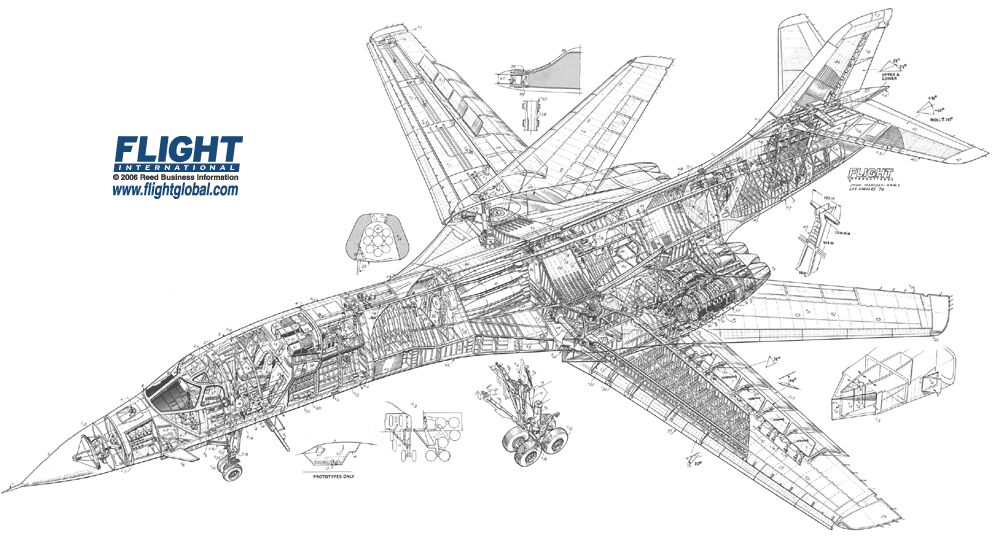
Because of the twin revolutions of the submarine and the airplane, it is impossible for surface naval forces today to operate with the assurance and the confidence that they are masters of their own fate as was true in previous centuries. Such has been particularly true since the advent of maritime aviation. Contemporary post-Falklands British maritime doctrine, for example, frankly states that:
"The minimal requirement for a successful [maritime] operation is a favourable air situation. Air superiority will be a requirement for sea control where a robust challenge from the air is possible. Air supremacy is a necessary precondition of command of the sea." [emphasis in original text]
On the eve of the next millennium, it is worth noting that as the first millennium of the common era was one of predominant land power (typified by Rome), and the second one of predominant sea power (typified by Great Britain), the third millennium is increasingly one characterized by the dominance of air and space warfare. Indeed, it has already come to pass: the dominant form of power projection for not only air forces but for those of armies and navies is already the air weapon, for example the ship-launched cruise missile, helicopter, or strike airplane, or the army battlefield missile system or attack helicopter (the latter which has essentially supplanted the tank as arbiter of the modern battlefield) [EDITOR: Ooops! Another fuck-up by the author worshipping aircraft, Afghanistan and Iraq fell to TANKS not aircraft], or the submarine with a long-range strategic ballistic missile or shorter-range cruise missile. All services thus necessarily have a piece of the air power equation, though only a genuine air force has the combination of doctrine, technology, and undivided focus to use air power broadly and to its greatest effect. [EDITOR: more air force egotism]
Air power at sea has made its mark on naval warfare since the time of the First World War. While currently the United States is the only truly global naval power--as it is the only truly global air power--the proliferation of increasingly sophisticated weapons among smaller nations in unstable regions offers no confidence to those who would blithely assume that American maritime supremacy--and that of friendly nations--will remain unchallenged, particularly in far-flung regional contingency operations. As the Second World War clearly showed the vulnerability of surface ships to attackers armed with "dumb" weapons, the wars since the mid-1960's have increasingly highlighted how even more vulnerable surface vessels are to attack by precision missiles and bombs. In the case of the Falklands, for example, only the narrowest of margins separated victory from defeat for Great Britain. In fighting in the Gulf before and during the Gulf War of 1991, hostile action severely damaged four U.S. Navy ships: two frigates, a small aircraft carrier, and a sophisticated Aegis-class cruiser, all of which required lengthy and costly repairs. The weapons that accomplished this were two Exocet missiles and three mines. For the present, concern over such weapons and their more advanced successors threatens to constrain both the traditional freedom of maneuver of surface naval forces and options regarding their use. For the future, maintaining maritime supremacy, particularly on the regional level, without being compromised by such cheap and readily available means obviously constitutes a major challenge to defense planners. [EDITOR: "challenge" to planners? Planning isn't going to solve this fatal weakness]
Various forecasters and historians have attempted to predict the future of maritime warfare in light of the challenges posed by modern anti-shipping technology and weaponry. Historian John Keegen has boldly ventured that the future of naval warfare rests with submarines, stating that:
"It is with the submarine that the initiative and full freedom of the seas rests. The aircraft carrier, whatever realistic scenario of action is drawn--that of operations in great waters or of amphibious support close to shore--will be exposed to a wider range of threat than the submarine must face. In a shoreward context it risks attack not only by carrier-borne but also by land-based aircraft, land-based missiles and the submarine itself. . . . The era of the submarine as the predominant weapon of power at sea must therefore be recognized as having begun."
This view, a vision of a future populated by "new navies of submarine warships, great and small," is also promulgated to some degree by defense analyst Michael G. Vickers, who envisions advanced nations employing largely submersible navies, including submersible fleet replenishment ships, maritime prepositioning ships, and assault landing submarines, as well as the traditional attack submarine. But, in Vickers' scenario, complementing these vessels would be a new class of nuclear powered "arsenal ships," incorporating anti-radar "stealth" technology, armed with up to 500 missile launch tubes, lasers, electromagnetic rail guns firing 5 inch projectiles (perhaps as many as 200,000 per ship), and sophisticated unmanned air vehicles to conduct maritime reconnaissance.
It is likely that some portions of both of these visions will indeed become true. It is often missed that the submarine itself has been a projector of forms of air power, and that virtually all major nations have, at one time or another, experimented with "operating aircraft from submarines.
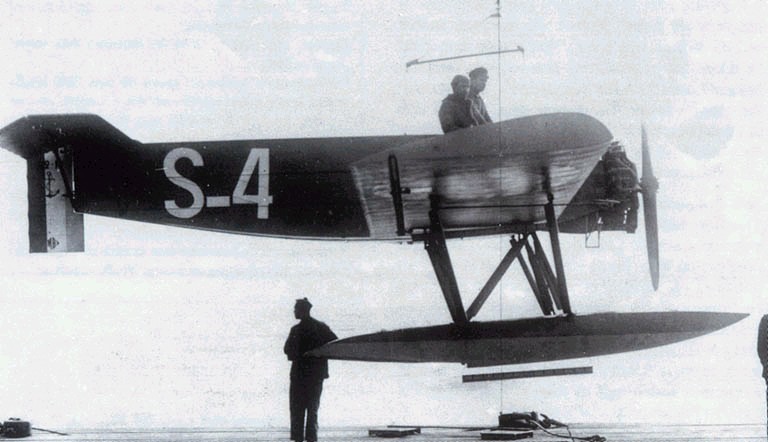
The French, in the years prior to the Second World War, produced a series of small submarine-launched floatplanes designed by Marcel Besson to be carried and flown by a large "submarine cruiser," the Surcouf. Indeed, in the Second World War, a small Yokosuka E-14Y1 [Glenn] scouting floatplane launched from the Japanese submarine I-7 conducted a reconnaissance flight over Pearl Harbor after the attack to assess damage. Later, off Oregon, the I-25 launched another E-14Y1 that, in two attacks, dropped four phosphorous bombs triggering small forest fires; other Japanese submarines used these airplanes to conduct reconnaissance flights over the Aleutians, Australia, New Zealand, Madagascar, and Africa. Japan had even more ambitious plans to bomb the Panama Canal with larger Aichi M-6A1 attack planes launched from the huge (for their day) I-400 class submarines, as well as other I-boats. The end of the Second World War likewise brought an end to actual attempts to build submarine-launched airplanes, but marked the beginning of efforts to incorporate both cruise and ballistic missiles in the armament suites of newer submarines. As a result, the international submarine community fully embraced the missile revolution, starting with early generation cruise missiles (typified by the American experience with the Republic Loon and the Chance Vought Regulus I and II), next with nuclear-armed ballistic missiles (exemplified by the Polaris, Poseidon, and Trident), and finally with nuclear and conventionally armed advanced cruise missiles (such as the Harpoon and Tomahawk). It is virtually a certainty that, at some point, submarines will serve as launching platforms for sophisticated unmanned air vehicles. For that matter, it is not inconceivable that submarines might some day operate small specialized piloted craft as well.
As for the arsenal ship, it may well make an appearance in some less- elaborate form (for cost alone would be a serious constraint on its development), and its weaponry may pose a serious danger to the contemporary attacker. But the attacker's own abilities will transform as well: it is hard to imagine how an arsenal ship, however well-armed, could defeat a plethora of air-launched or submarine-launched weapons (or even mines), unless its size was so great that, short of a nuclear weapon, a single weapon could not harm it. But even in this latter case, history is not encouraging, for what of multiple attackers smothering such a vessel?
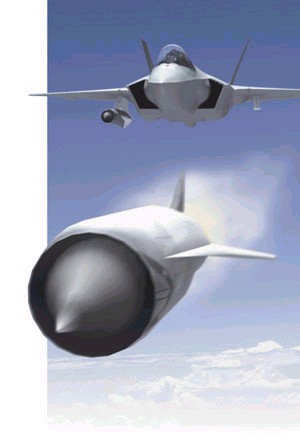
Here, it is instructive to remember the case of earlier "arsenal ships" such as the Bismarck, disabled by a single air-dropped torpedo and condemned to circle aimlessly, so that surface forces could pound it into oblivion, and the gargantuan Yamato, Mushashi, and Shinano, the first two of which were mercilessly sunk by air attack, while the latter fell victim to a submarine. It is difficult envisioning the arsenal ship being so much larger than these vessels that merely having a double-hull design and large size (and hence compartmentalization) would save it. Advocates already recognize that such a vessel would still require the massive escort protection of anti-aircraft and anti-submarine cruisers and destroyers for such a concept to be viable (though they seemingly ignore the irony of a "stealth" ship protected by decidedly "non-stealthy" consorts).
The decline of the surface vessel as a predominant means of exerting naval power is undoubtedly underway. [EDITOR: DID YOU TELL THE U.S. NAVY THIS?THEY ARE BUILDING MORE SHIPS PACKED WITH SAILORS/MARINES IN THEM THAN EVER BEFORE] That decline may be slowed somewhat by new advances in shipboard defenses, but it is unlikely to be reversed. Recently the United States Navy has imaginatively data-linked airborne sensors to surface warfare combatants to generate a "cooperative engagement capability" (CEC) whereby a ship may engage a target illuminated by remote sensors even if the vessel's own sensor suite has not yet detected it. Complementing this is an intensive effort to improve the anti-air capabilities of older and less sophisticated naval vessels via integrating a ship's existing detection and tracking sensors to the surface-to-air weaponry the ship possesses. Key to this is sensor-and-weapons fusion via local area computer networks that reduce response time to permit faster engagement of missile and aircraft threats. Further enhancing ship survivability may come via reducing dependency on radars (which are limited close-in to land by background clutter problem, as well as the need to establish a "track" on a target) and, instead, complementing them with infrared search and track sensors that could detect a threat virtually immediately by its heat signature as soon as it clears the horizon. These are all useful and necessary, but they do not represent confounding solutions against which the future air attacker will be helpless, or even greatly inconvenienced.
So, then, what is to be done? What avenues are open to the naval enthusiast seeking to maintain the relative viability of naval forces at a time when their traditional form of power projection--the surface vessel and the amphibious assault force or carrier battle group--is so challenged? Many avenues are open. In the interim, as a result of shortfalls in its performance in the Gulf War, the United States Navy has undertaken to equip more of its aircraft to employ smart weapons, including one catagory of aircraft--the Grumman F-14 Tomcat fleet air defense interceptor--previously used exclusively for air superiority missions. Now equipped with LANTIRN targeting pods and laser-guided bombs, the F-14 "Bombcat" is a more worthy reflection of its namesake than it once was. Beyond this, many other avenues beckon. [EDITOR: F-14s are gone, dude] One long-term possibility is that, increasingly, the world's advanced navies will turn away from the carrier and carrier-launched aircraft in favor of reliance on land-based maritime air power and ship or submarine launched missiles. This would require a change of mindset as profound as that which accompanied the supplanting of the battleship by the aircraft carrier, and is, frankly, unlikely in the near term, though more of a possibility in the more distant future.
Possible Alternative Naval Futures
Every crisis and challenge offers its own set of opportunities, and it is not too much to state that in the present situation, naval power can be transformed without losing its position of relative significance in national security affairs. But that transformation will involve adapting technologies and approaches that have either not been realized in the past, or have not been exploited to their best potential. Several that stand out include stealth ship design, incorporation of wing-in-ground-effect (WIG) technology, high-speed ship and hovercraft concepts, and advanced submarine concepts perhaps including refined hydrodynamic design or even submersible aircraft.
A ship at sea has a profoundly large radar signature and strong visual, acoustic, and wake signatures as well. Dramatic reduction of these could give a surface craft the ability to remain unobserved from most maritime patrol aircraft until the aircraft were so close to it that they themselves could be engaged and destroyed by defensive weaponry. Interestingly, the low observable "stealth" revolution really began at sea, when the Kriegsmarine attempted to counter Allied radar-equipped patrol aircraft by cladding the schnorkel breathing tubes of U-boats with radar-absorbent material. During the Falklands war, the Royal Navy made some use of radar-absorbent screens to foil anti-ship missiles, and since the war, sporadically, ships have appeared with faceted (angled) upperworks and other attempts to minimize their signature. Such efforts are really "add-ons," and, as with aircraft, the only truly stealth ship is one designed from the keel up for the purpose. There has already been one notable attempt to build a genuine "stealth" ship: the Lockheed Sea Shadow which, in effect, consisted of a catamaran hull covered by a faceted body shape made of radar absorbent materials reminiscent of the F-117A stealth fighter. The Sea Shadow, intended as a testbed of a proposed antiaircraft vessel designed to operate on the periphery of a carrier battle group, demonstrated during trials in the early and mid-1980's that it was extraordinarily difficult to detect; search aircraft could only find it when operating within 1 1/2 miles of the vessel, well within lethal missile range had it been armed with surface-to-air missiles. While the full story of its demise is not known, its developer, the flamboyant Ben Rich of Lockheed's famed "Skunk Works" bluntly hinted of traditionalism winning out over innovation when he wrote that:
"There were sexier ways of spending naval appropriations than on a small secret ship that would win few political brownie points for any admiral who pushed for it. Although the Navy did apply our technology to lower the cross section of submarine periscopes and reduce the radar cross section of their new class of destroyers [the Arleigh Burke class vessels-ed.], we were drydocked before we had really got launched."
A stealth vessel has much to commend it, but the design of a true stealth ship is profoundly difficult and certain to generate configurations more reminiscent of the Monitor and Merrimac than HMS Dreadnought or the USS Nimitz. Any such vessel needs not only to be difficult to detect electronically, visually, and acoustically, but must also be indistinguishable from its background--the wave-tossed ocean. Conventional hull design is inappropriate for such craft, which should have, instead, a catamaran-like hull and some sort of propulsion system that leaves a minimal surface wake. Such suggests a semi-awash approach and, for that matter, raises the issue if an investment in a stealth ship might not better be put into genuine submarine technology. In any case, sea stealth is certain to be a widely pursued field of technical endeavor in the years ahead.
Another technology already explored by one maritime nation is the wing-in-ground-effect (WIG) aircraft. This concept takes advantage of three well-known but surprisingly little appreciated principles of aerodynamics. First, the aerodynamic efficiency of a wing, and particularly its lifting capacity, improves dramatically when that wing is operated within approximately one-half of its span above ground or water, in what is termed "ground effect;" this benefit increases even more dramatically if the wing is within 1/10 of its span above the surface. Second is the so-called Coanda effect, whereby a fast-moving fluid tends to "adhere" or follow the curve of a surface, being capable of being deflected downwards over the deployed surface of a lift-enhancing wing flap and thus used to further augment the wing's lift via deflected propulsive lift; third, if the wing's natural accelerated flow passing over it is further accelerated by the high-velocity exhaust of a turbojet engine, the lifting capacity of the wing is even more greatly enhanced. Thus, by a combination of deflected engine thrust, traditional aerodynamic lift, and augmented propulsive lift, it is possible to design a large flying vehicle which, while resembling an airplane to a great degree, is, nevertheless, quite a different beast. While such an approach is difficult to envision being used over the earth's surface (though it does benefit the takeoff and landing performance of conventional airplanes), the possibility of using this principle to make more efficient low-altitude aircraft operating at or just over the ocean's surface is obvious.
Ground effect has been recognized for decades, from the earliest years of powered flight. Indeed, it was ambitious though imperfect exploitation of this principle that made Claude Dornier's experimental (if awkward) Do-X transatlantic airliner of 1929 a qualified success. However, it was not until the mid-1960's that attempts were made to exploit it for maritime purposes. Three major figures share the responsibility for bringing WIG technology to fruition: the German emigre engineer Alexander Lippisch (best known for his advocacy of the tailless and delta planforms during the 1930's` and 1940's), and two Russian engineers who, working separately, made intriguing advances in the field, Rostislav Alekseev and Robert L. Bartini. Bartini, an Italian communist, abandoned his homeland for the pleasures of Stalinist Russia, earning a ten-year stint in a gulag for his pains before being released by Nikita Khrushchev.
Lippisch's WIG craft
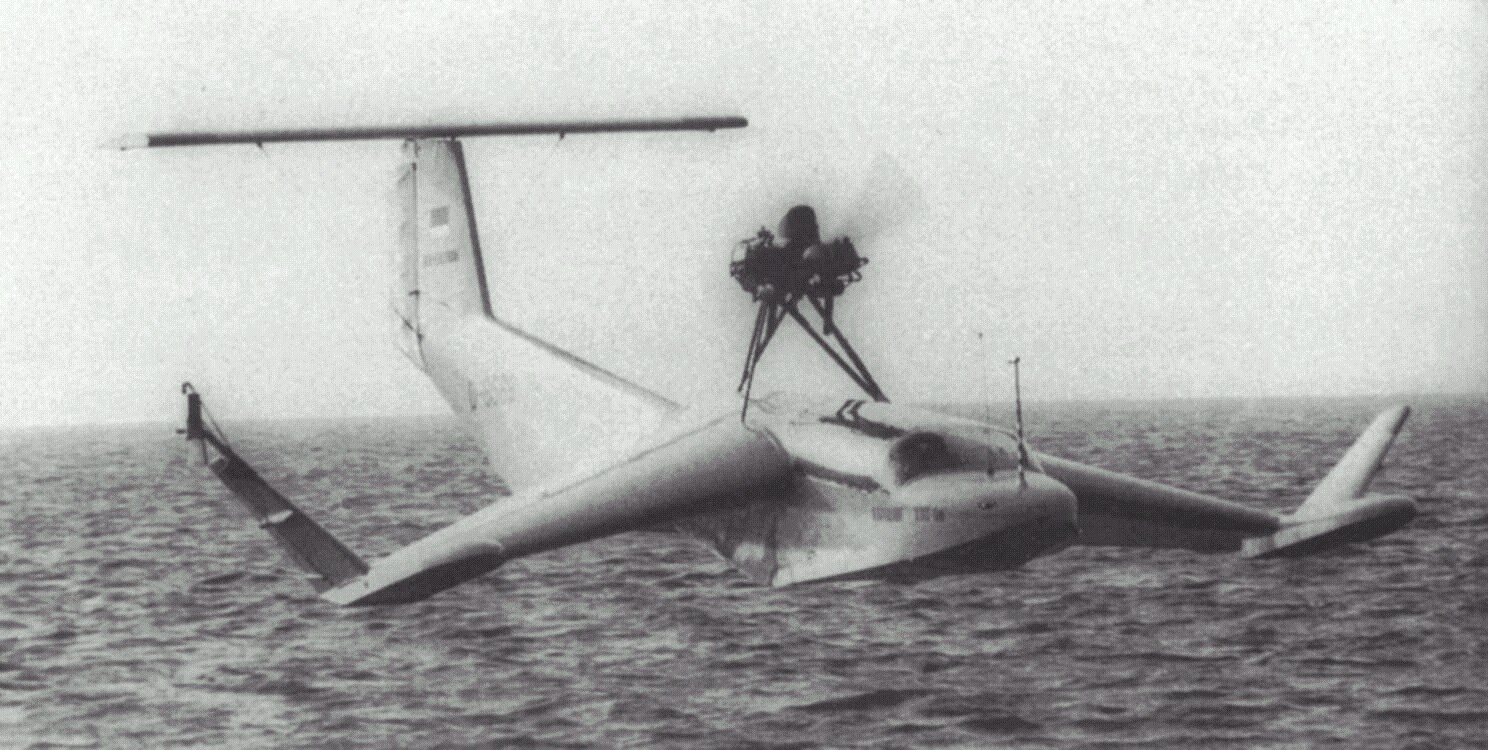
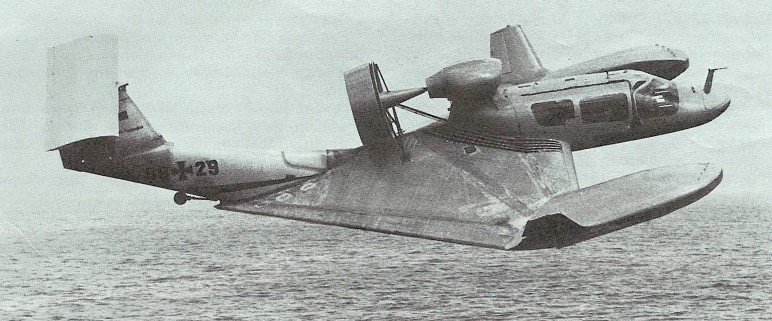
In 1963, Lippisch built a small "ramwing" WIG demonstrator, the X-112, and flew it in the United States. Encouraged, he next embarked on a larger "aerofoil boat" (as he termed it), the X-113A, built in Germany by the Rheinflugzeugbau company and flown off Lake Constance and the North Sea in 1966. Despite ambitious plans, Lippisch's work did not progress further, and he died in 1976.
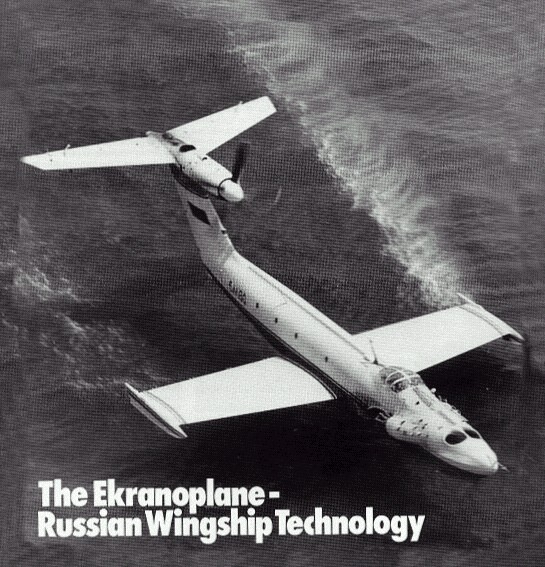
www.youtube.com/watch?v=nOtSfb-P1C8
The torch of WIG advocacy passed to the Soviet Union where, in the early 1960's, Alekseev turned from development high-speed hovercraft to large WIG machines. It is difficult to assess whether he was influenced by Lippisch's earlier work, though it is likely he would have learned of it. In any case, in 1966, his Central Hydrofoil Design Bureau produced a truly gargantuan ekranoplan ("surface plane") that combined the smooth hull form of a ship with stub wings, an immense vertical fin and horizontal tail, and no less than ten engines: eight mounted in two clusters of four immediately behind the cockpit to provide augmented lift, and two on the vertical fin to provide cruise power. This WIG machine, which American intelligence organizations dubbed (not without reason) the Caspian Sea Monster, could lift 540 tons and cruise at over 300 mph at an altitude of over 10 feet. The Caspian Sea Monster encouraged further work, and Alekseev developed a smaller military WIG, the Lun ("Dove"), armed with six large anti-shipping cruise missiles perched unaerodynamically on its back. This in turn spawned the jet-and-turboprop-powered Orlyonok ("Little Eagle," NATO name Orlan), intended as an amphibious assault craft. The apparent success of these machines hid some very real problems, not least of which were serious stability and control deficiencies, as well as tremendous power requirements to get off the water. Bartini took a different path, emphasizing not so much a boat-hull approach as a large broad wing and tail joined to a catamaran-type hull, with the wing large enough so that the vehicle could, if necessary, climb out of ground effect and operate as a conventional airplane. Unfortunately, he did not have an opportunity to actually develop and test such a craft, and obsessive secrecy within the Soviet Union kept the Alekseev team unaware of his work until after both Bartini was dead, and the Alekseev approach discredited.
Today, in the era of fly-by-wire flight control technology, stability difficulties can be more readily addressed, and the advent of highly efficient high-bypass-ratio turbofan engines has largely removed the propulsion problems as well. Advanced construction techniques involving composite materials could further enhance performance. A WIG capability could give a navy a greater chance of survivability against the traditional threats that have held conventional surface vessels hostage, namely the submarine, mine, and the airplane. The aircraft (though it is more an "air-ship craft") itself offers the promise of great flexibility, much faster speeds--by a factor of at least ten--over conventional high-speed fast sealift ships (or, for that matter, over surface and sub-surface combatants alike), payloads of up to 5 million pounds (equivalent to 40 x fully-loaded C-141's, for 15 x C-5's) and the ability to literally operate up to and on the beach.
A multi-purpose combatant WIG, armed with advanced weapons and sensors (such as antiship missiles, antisubmarine torpedoes, advanced sensors, and even air-to-air--though they would function more as surface-to-air--missiles) could be a formidable asset and opponent. It could traverse the sea and intervene for control of sea lanes at a speed just less than that of contemporary patrol aircraft, but with greater endurance, the ability to set down on the ocean surface in an emergency or for a specific purpose (such as search-and-rescue), a far greater weapons and sensor suite than is carried by aircraft (or even most ships), and less vulnerability to detection and interception largely because of its ability to move at speed in close proximity to the earth's surface.
Against this are, however, is one major deficit: emphasis on WIG performance means that in high sea states, a WIG aircraft might have to alight on the sea surface because it could literally not be expected to fly at high speed through pounding wave-tops. One possibility is that designers should ensure that, even at the expense of having the best possible low-altitude performance, the WIG aircraft have an ability to climb to heights (however inefficiently) where, in an emergency, it could fly well above water level--essentially a validation of the Bartini approach but with much more modern and appropriate technological approaches. Another, of course, is simply to build the WIG more as a ship (to, for example ship-type hull thickness rather than aircraft-type fuselage thickness), and to accept the penalty of having, on occasion, to operate on the surface of the sea in some form of high-speed surface craft mode. Thus, while WIG technology is far from perfect, it does represent one avenue of advanced research that is worth further study, as a recent Air Force long-range technological forecasting effort itself concluded. The WIG "ship," then, could be an ideal future "air and sea" craft for both the surface and "air" navy.
One of the major constraints on maritime operations is the slow rate of movement of naval vessels. Since approximately 1900, ships have operated at essentially a "thirty knot barrier," analogous, in some respects, to the "sound barrier" that has (with the single exception of the Anglo-French Concorde supersonic transport) effectively limited commercial aircraft to the subsonic environment, or, for that matter, to the limitations experienced by surface vehicles moving across terrain. Advances in naval propulsion, from the era of the steam turbine to the gas turbine and high pressure water jet, together with advanced hull concepts and emphasis on what might be termed wave-riding technologies, offer some hope that this barrier might be raised, if not broadly overcome. A surface ship operates at the boundary between two fluid mediums of radically different densities--air and water. On one hand, its upperworks can be designed with relatively little concern for any penalty in aerodynamic drag. On the other hand, the design of the hull is of the most profound importance. Indeed, the hydrodynamic flow field around a ship's hull is remarkably like the flow field around a supersonic airplane. The ship's hull produces a shockwave (the bow wave), and elements of classic transonic and supersonic aerodynamic theory, such as area ruling, can profitably be applied to ship design. For example, the hull itself has to have a fineness ratio approximating that of a supersonic aircraft: a long streamlined body shape of narrow width. A ship's propeller bears a close resemblance to the kind of "prop-fan" or "scimitar fan" propeller designs offered as possibilities for transonic aircraft operating above Mach 0.8. It should not be surprising that there are other comparisons as well: the fuel burn per passenger per transatlantic voyage on the Concorde and the liner Queen Elizabeth 2 is approximately the same; further, it takes approximately as much power to propel the QE 2 to its maximum speed as it does to propel a Lockheed SR-71 to Mach 3.
There is one kind of vessel, however, that operates completely within the hydrodynamic medium, aside from very brief excursions to the surface: the modern submarine. It is ironic, then, that the submarine, sharing so much with the airplane in terms of its operational environment, form of attack, and influence upon surface forces, remains, surprisingly, largely unchanged in basic design to the early streamlined "guppy" submarines of the late 1940's. In many ways, the submarine is analogous to the dirigible airship, as opposed to an aircraft. As an airship operates on the principles of aerostatics--using an enclosed gas of less density than the surrounding medium to produce lift--a submarine operates on the principles of hydrostatics--displacing water with air and thus rising or descending as desired. A transformation of the design of the submarine could offer intriguing possibilities of "flying" hydrodynamically. One approach could involve replacing the submarine's traditional "body of revolution with fins and a conning tower" configuration with a delta wing blended into a relatively high fineness ratio hull. There would still, of course, be a requirement for hydrostatic lift, for, unlike an airplane, a submarine in deep waters cannot descend to a benign environment.
But developing "flying" submarines would take fullest advantage of the three-dimensional environment in which the submarine operates, permit the design of more efficient vessels, and give to them a flexibility unknown even in the modern era of relatively sophisticated underwater design. Finally, it might even be possible to design a fully three-dimensional vehicle that could take advantage of both the underwater and the aerodynamic environment, operating as a submarine and then, instead of cruising the surface, functioning as a WIG sea-skimmer or, even, a fully fledged aircraft. While the operating rationale for such craft would have to be well-thought-out, the tremendous flexibility possible with such craft might well warrant their development in the next century.
Maritime Control: The Enduring Need for Joint Solutions
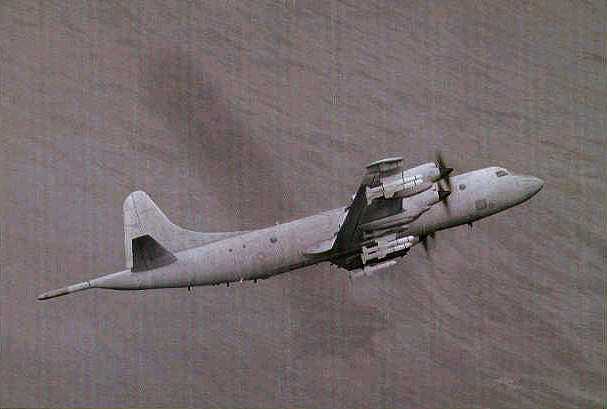
Despite whatever naval future one postulates, fully appreciating the lessons of eight decades of maritime air warfare inevitably reaffirms the recognition that maritime supremacy requires a joint-service approach to maritime warfare, an approach more appreciative of the role of land-based air power. Historically, the partnership between sea-based air and submarine forces, and land-based aviation has been the most productive means of thwarting an enemy's attempts to seize local control of the sea. Indeed, virtually all significant naval actions of this century have taken place within reach--and with the involvement--of land-based aviation forces. Today, in a post-Cold War cost-conscious environment, the advantages of having land-based aviation forces assume a greater role in maritime control operations is increasingly attractive to defense planners, particularly as the acquisition and operating costs of naval aviation are correspondingly increasingly expensive.
A number of circumstances have led to this. First, operating costs for carrier-based aircraft, as a rule of thumb, run three to four times as much as a land-based aircraft. Then, there are the lag times between deployment to a crisis region of naval aviation forces (which traditionally deploy at the speed of their surface vessels) and land-based air: in the Gulf war, for example, aircraft carriers took up to a month to reach the theater from the United States, while Air Force airplanes deployed in non-stop 15 hour air-refueled journeys. Also, on-station times of naval task forces on "presence" operations are at best sporadic, as they are driven by the need to replenish and resupply vessels; in contrast, as operations in the Persian Gulf region since the Gulf War and in the Adriatic during the Bosnian crisis have clearly indicated, land-based air power offers virtually 100% presence. (Sortie rates for American forces in Operation Southern Watch (Southern Iraq) and Operation Deny Flight (Bosnia) reflect the persistency of land-based air power; in each operation, approximately 70% of all sorties have been by the Air Force, with naval forces--the USN and USMC--responsible for the remaining 30%). Finally, there are the relatively large "tooth-to-tail" ratios for naval forces, wherein a large number of ships and personnel are required to maintain a relatively small number of deployable strike aircraft.
Fortunately, land-based air power projection forces can be readily employed in most crisis and regional contingency situations, off-setting such traditional problems and, indeed, acting as effective substitutes for the traditional carrier on missions of presence. In October 1995, the Air Force established an important precedent when it deployed an Air Expeditionary Force (AEF) to the Persian Gulf to fill a void left when an aircraft carrier had to depart from the Gulf; its replacement was not scheduled to arrive for over two months. Eighteen Lockheed-Martin F-16 jet fighters deployed from the continental United States with live munitions, and were flying sorties twelve hours after landing in Bahrain, in concert with other Air Force aircraft already in theater. Twelve of these eighteen mounted sophisticated LANTIRN targeting and navigation pods enabling them to use precision munitions, while the other six were configured for firing HARM anti-radiation missiles for air defense suppression. The subsequent experience of this AEF validated the concept of using land-based aircraft as a quick, flexible, responsive, and effective means to project global presence and influence.
As experience has shown, it is vitally important that air forces and navies to work together in partnership (particularly for the United States) for the teaming of land-based aviation forces and traditional naval forces can synergistically and dramatically improve the operating efficiencies of both. Land-based aviation can work to help defeat two of the greatest threats confronting modern surface forces: the mine and the submarine. The view and awareness available from Air Force-operated space-based systems and from long- range land-based intelligence and command and control aircraft offer tremendous leverage to naval forces. Further, explicit capabilities inherent in the modern Air Force--long-range air surveillance and control, high-volume aerial tanking, and long-range maritime patrol by strategic bombers (such as B-52's carrying mines and Harpoon anti-shipping missiles) are particularly well suited for supporting sea control and access denial missions. (Many of these attributes are found in smaller air forces as well, exemplified by the Norwegians employing Penguin antishipping missiles on their F-16 strike aircraft, or the Australians who have successfully married the Harpoon antishipping missile to the F-111C).
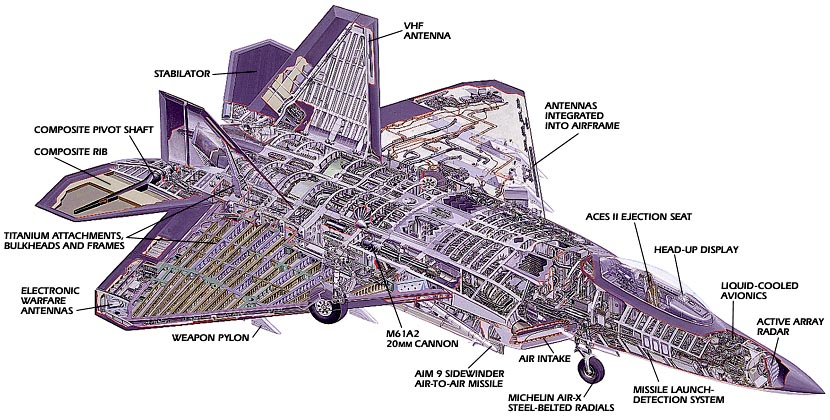
The tremendous investment in low observable "stealth" technology, manifested in the Lockheed F-117, Northrop-Grumman B-2, and the upcoming Lockheed-Martin F-22 can both ensure greater survivability of friendly naval forces and can hold hostile naval forces hostage. This is particularly true for air superiority operations in constrained waters where an exclusively naval force may be unable to operate freely, or where an enemy's anticipated air defenses may pose grave dangers to conventional (i.e.: non-stealthy) naval attackers, necessitating stealth strikes to clear the way. Greater inter-operability of traditionally land-based systems from naval platforms offers yet another potential synergistic benefit of joint activity.
In sum, then, the pace and impact of aviation in the twentieth century has been extraordinary, and nowhere more so than in military affairs. Less than forty years after the Wright brothers flew at Kitty Hawk, the airplane--both land- and sea-based--had evolved from threatening to dominating the ship. That dominance has been extended even more forcefully into the modern era in spite of intensive and creative efforts to improve shipboard defenses. In today's world, the threat posed to the ship by the airplane or the aircraft-deployed missile or mine is at its greatest. If for no other reason than this, strengthening the traditional partnership of air forces and navies working together to ensure the defeat of their common enemies is no less important today than at any time earlier in this century.
FEEDBACK!
A retired Army officer writes:
"So we need to built small, cheap, robustly armored/protected carriers and place INEXPENSIVE combat aircraft on them.
OK, we take the LHA assault ships (Guadalcanal et al) and make them mini-carriers, until the commercial hull based carriers are ready. Can do. Need to place a lot of radar/optical tracking guns of several calibers on them to ward off Anti-Ship Missiles. Some cheapie things like fire and forget TOW sized missiles, 70mm rockets with 25# of steel cubes and 1# of C4 behind a heat/optical sensor that get focused on an incoming missile and lets it meet a wall of steel. Need short range (2km) light torpedoes (Hedgehogs) in underwater housings (unmanned subs) that listen for incoming torps and get vectors from sonobouys that fly around ships like unmanned helicopters with GPS, land, listen and take off again (I Call it a Dragonfly). Need PSP/Chain link fencing that descends 20m below the keel 100m from hull in all directions on pontoons to get any leaker torps.
What aircraft will we place on them for AAW, ASuW, ASM and LA? The Navy won't built F-4-type multi-role aircraft that can do small decks. You don't like F/A-18s, the F35s won't be available in decent numbers for the foreseeable future, there won't be any SeaMasters or Catalinas. RIGHT NOW, what can we use?"
A former Navy Sailor writes:
"We probably didn't take the Kuril Islands because FDR didn't want to piss off his good buddy "Uncle Joe" Stalin. The Russians and Japs have a long-running dispute over the southern Kuril Islands. Also, FDR's 'Europe first' policy dictated that the majority of our military resources were sent to the ETO and in Lend-Lease to Britain and Russia, this while our GI's were dying in the Phillippines without relief or resupply. Remember the Bataan Death March? FDR abandoned those guys.
I agree with your basic premise. I think it would have been a better strategy if we had followed the plan you suggested, but that's politics. And I agree that the Navy and especially the marines didn't want the Army to get all the glory for winning the war. That's why we need military reform, to keep the different services from stabbing each other in the back. We're all in this together, that needs to be our motto."
EDITOR: it raises the question that really the American Army and marines in the Phillipines could be resupplied, the U.S. Navy just didn't want to do its job because it couldn't be done in a comfortable way.
A retired officer writes on how the PRC Sub Stalked a U.S. Carrier Battle Group:
"This sort of cat-and-mouse game is normal at sea. It used to be the U.S. and Soviet navies, now it is the USN and PLAN. The shadowing should not be a surprise, and isn't a problem (let's be honest, the U.S. Navy and several others do the same thing -- it is one of the reasons why nations buy submarines). The PRC is NOT an ally, a friend, or a 'partner' of the U.S. -- it is the up-and-coming rival challenging the U.S.' hegemony in the east/southeast Asia/Pacific area -- so such shadowing for purposes of intelligence collection, operational training, and 'showing the flag' should be expected. Unfortunately, successive U.S. Pacific Command and Pacific Fleet commanders have refused to acknowledge that the PRC is a rival and the PLA/PLAN/PLAAF a potentially hostile force -- they prefer to believe that their 'constructive engagement' of the PRC and their "confidence-building military-to-military exchanges" are building Sino-American peace, friendship, and cooperation. This is self-deluding diplo-babble that one might expect to emit from Foggy Bottom or some U.S. embassies, but should NOT be the attitude of U.S. combatant commanders or their component commanders. Nevertheless, so long as the activities are occuring in international waters and are not endangering maritime safety/violating the 'rules of the road,' this should not be treated as unusual or a problem.
But there ARE real problems revealed by this incident:
(1) The psychological refusal to accept geopolitical reality about the PRC as a rival and threat is crippling U.S. readiness;
(2) If true, the allegation that the PLAN sub hadn't been detected until it surfaced within torpedo range of USN combatants is VERY worrisome.
Either of these problems would be VERY dangerous liabilities for a Navy that has repeatedly been interposed to serve as a shield between Taiwan and the PRC and could also be engaged in a rapidly escalating war over the future of the Korean peninsula and Japanese sovereignty.
Some defense analysts (myself included) have expressed concern over the decline in Navy ASW capabilities as the result of a tendency by OSD and Congress to take 'blue water' (open ocean 'conventional' naval operations) superiority for granted and refocusing the Navy's shrinking resources on power-projection ashore in support of Co-In operations and 'show-the-flag' military diplomacy exercises. The USN needs a more robust and more responsive carrier-based ASW aircraft to replace the S-3 Viking. H-60 SeaHawk helicopters and LAMPS-III are capable systems, but they don't provide enough "keep out" area to protect battle groups against longer-ranged post-Cold War sub-launched torpedoes and anti-ship missiles. The S-3 needs to be replaced, preferably with a SC-2 or OA-10B 'SeaHog' that can cover nearly double the area of an H-60-class helo, has more unrefueled loiter time plus being air-refuelable, can employ either sonobuoys or dipping sonar to detect subs, and can carry a useful payload of ASW torpedoes and depth charges. Congress, OSD, and the Navy need to provide plus-up funding to buy this S-3 replacement as well as keeping the P-8 Maritime Multi-Mission Aircraft program moving at the most expeditious rate to provide replacements for the aging, shrinking P-3C Orion land-based ASW fleet. Last but not least, work needs to continue in the area of upgrading counter-torpedo defenses for surface ships of all classes (not just combatants but "gators," MPFs, and auxiliaries as well) and for improving and expanding deployment of the latest anti-missile defenses (e.g., Ship Self Defense System (SSDS) plus Enhanced Sea Sparrow Missile (ESSM) and SeaRAM close-in missile defense systems to replace obsolescent Phalanx CIWS, modern Electronic Attack capabilities to replace the hard-to-maintain/sustain AN/SLQ-32(V), Mk54/NULKA expendable anti-missile countermeasures systems, etc.).
I hope this will be taken as a wake-up call by Congress, the Administration, and OSD. 'Guns-and-butter' and 'perpetual peace dividend' are not sustainable postures for a nation that insists upon viewing itself and acting as the 'sole superpower.' The government must either substantially increase both the budget and force structure allocations of the Services to enable them to sustain necessary "conventional" deterrent and global presence capabilities and modernize and sustain our aging nuclear deterrent and space infrastructure while continuing Co-In/CT operations across the '10-30 band' under attack by Islamism, OR redirect and reduce U.S. global military commitments to restore necessary RD&A and infrastructure funding to rebuild U.S. 'conventional forces' which are largely Reagan-era legacies and are increasingly due for either major service-life extension programs or replacement with new, more capable systems. Failure to chose one or the other option is going to substantially increase national security risk posed by known threats while reducing flexibility and reserve capacity to respond to the unexpected threat."